fall inside a hole
Plarail Thomas the Tank Engine (1992)
First written November 17, 2023Expanded July 2024, February 2025
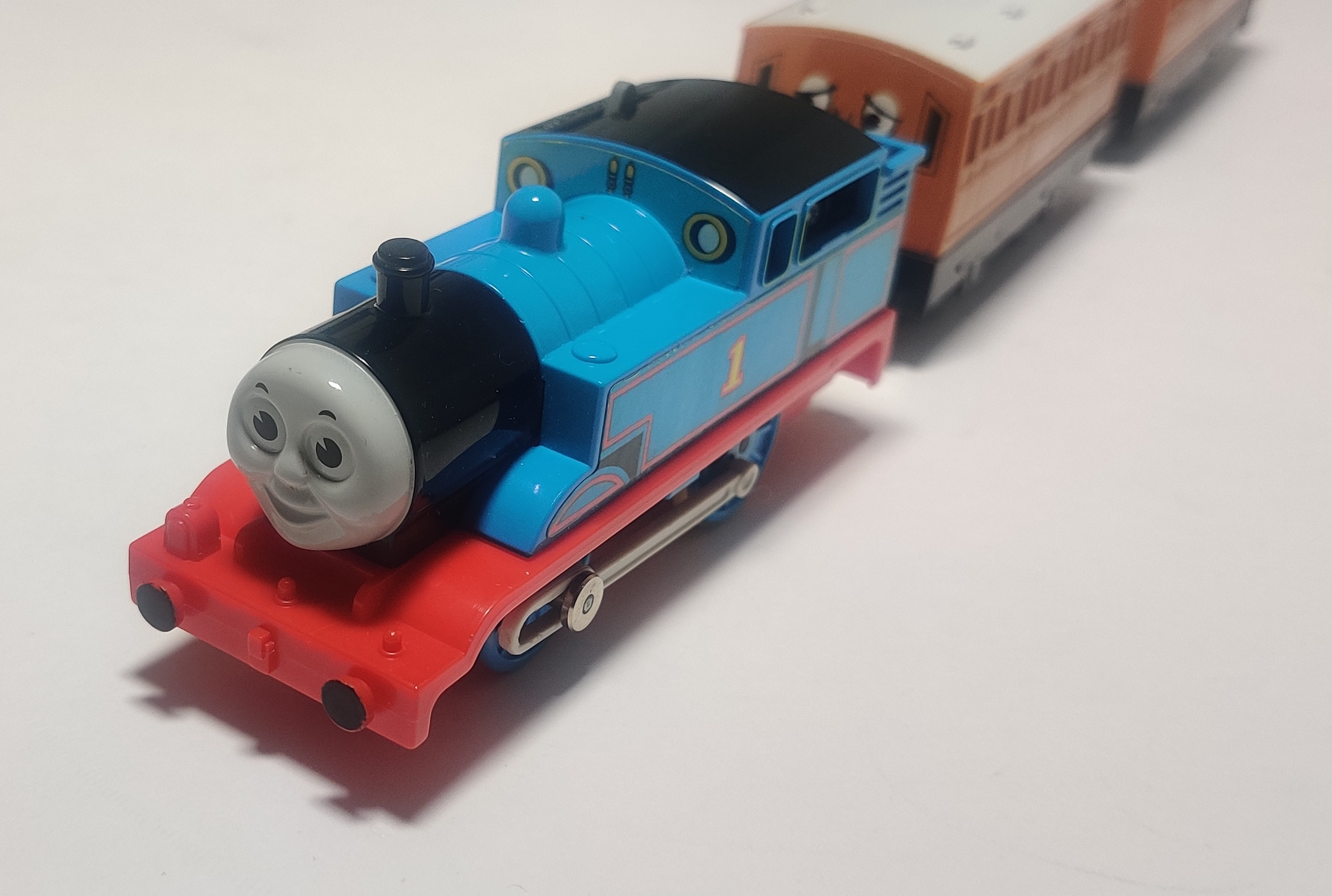
Thomas the Tank Engine is the titular character of the Thomas the Tank Engine and Friends T.V. show as well as a main character in the Railway Series books it is based on. Thomas is a small tank engine with six wheels that lives and works with other engines as a station pilot and later branch line engine on the fictional Island of Sodor. Initially airing throughout the fall of 1990 in Japan, the first season of Thomas the Tank Engine and Friends was an immediate success and popular toy manufacturers like Bandai and Tomy both began working on Thomas toys. An obvious move for Tomy was to release licensed Thomas the Tank Engine characters for their already well-established Plarail system. Prior to this, Tomy had rarely licensed characters for Plarail, with a handful of Disney licensed products before but several "character trains" appearing in the later 1990s and even more Disney-licensed trains in the 2000s.

Plarail Thomas development most likely began in 1991. As the Plarail Thomas 25th Anniversary Book reveals, some early Plarail Thomas prototypes had more accurate moving siderods instead of the looped-front siderods the final toy has. The blurb to the left of Thomas reads, approximately: Development Secret Story. In order to reproduce a small Thomas, we made a new mechanical gearbox (moving parts), but the design was difficult, with the body being longer than the actual animation. Also, at the beginning of development, we tried to attach rods to the front and rear wheels. just like in the live-action version, but it turned out that the front wheels would not turn due to the dead center wheels, so we changed to the current shape where the rods stick out from the center of the front wheels only. These coupling rods were a new design for Tomy as previous steam locomotives like the D51 and C12 as well as the Mickey Poppo all have side rods that extend to ride in molded driving cylinders like Henry or Gordon. Early Thomases have different front axle caps to retain them. (There is a rumor that the design of the coupling rods was influenced by Bandai's Departing Now system, but the looped coupling rod design is not a particularly novel solution to the problem of making coupling rods for a child's toy. Bandai would have previously seen a similar system on the early Nylint toys they were importing into Japan before releasing their own Departing Now range as well.)
Early Thomas prototypes likely used a C battery. Up to this point, virtually every Plarail train had been powered by a C battery, and every accessory and track piece was molded around the idea that all the engines would have a similar distribution of similar weight. Some accessories used rim-driven mechanisms that needed the engines to have good traction with the rollers that picked up power from the wheels. The boxes of Thomas-series engines that do not use a C battery located over the driving wheels are often chock full of added weights and the boxes have lists of accessories that are incompatible listed on them. Tomy was already producing the Plarail C12 with a much larger (scale) boiler than the real locomotive in order to fit a C battery inside, and it is almost certain that they would have begun with a C battery inside Thomas as well. Most likely, the design of the C battery Thomas was not approved for production by Britt Allcroft for not being close enough to the television show design. The final AA battery Thomas had several added weights and early boxes have a section on the front saying that it uses a AA battery, something that was not present on other Plarail boxes.

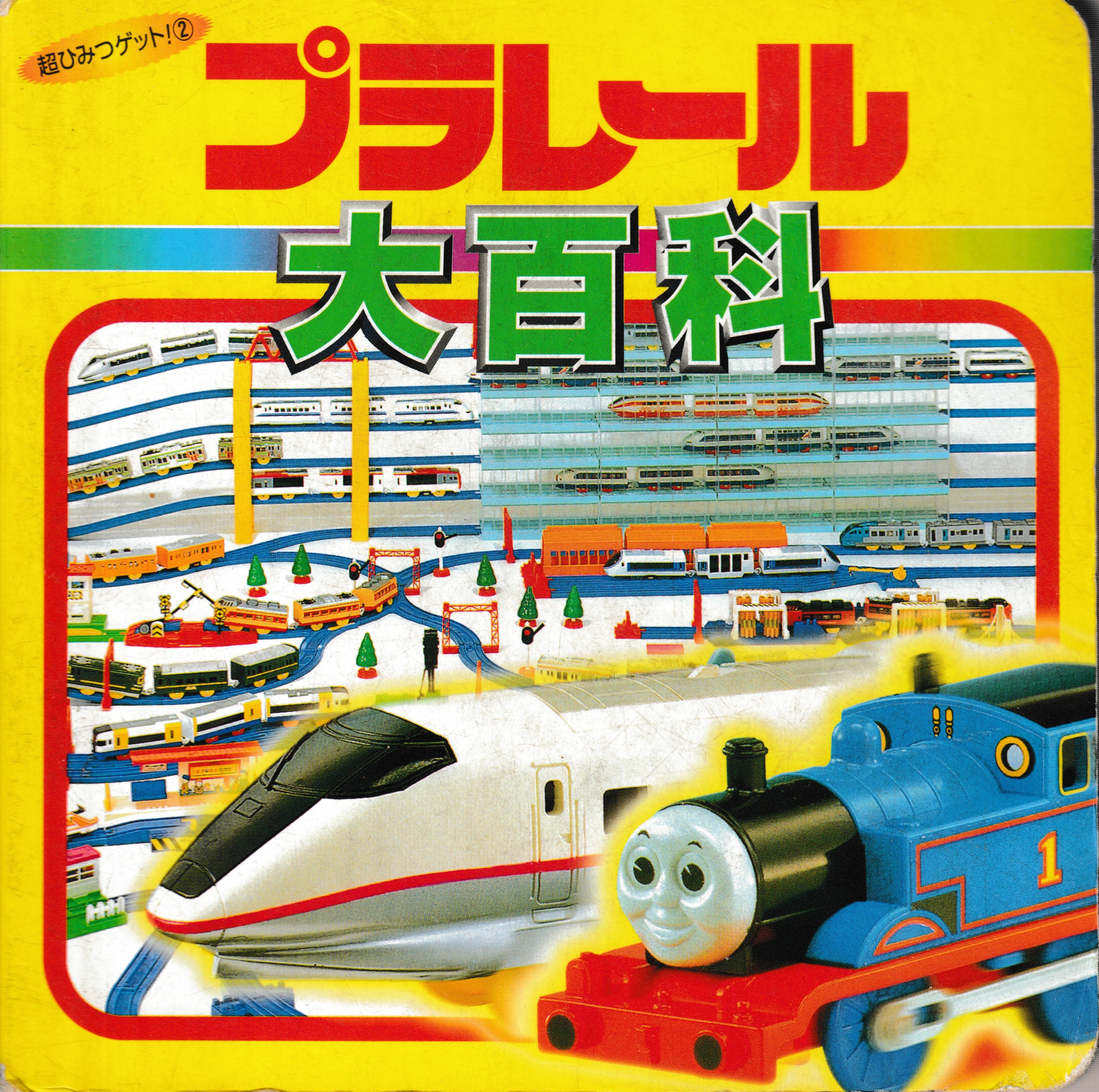
Late stage prototypes circa late 1991 were similar to the final release but with a darker power switch and a slightly different face. This prototype appears on the Thomas the Tank Engine Set box, the 90s Plarail Encyclopedia, and a few other places including the rear of some later boxes. The version shown on the Thomas the Tank Engine Set box seems to have a slightly earlier axle cap design with caps that look like a white plastic instead of the final metal ones.
Thomas the Tank Engine (1992)

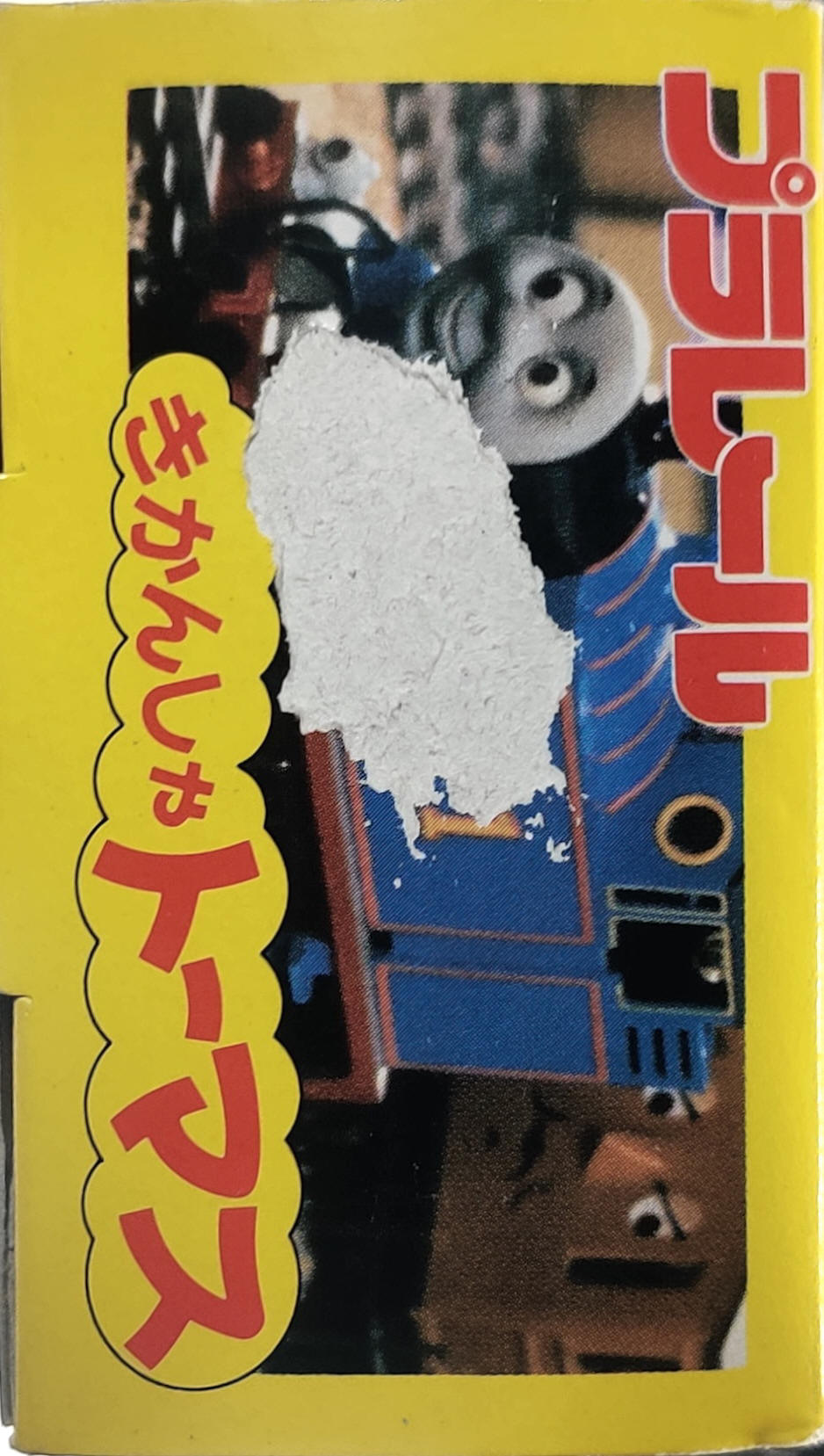

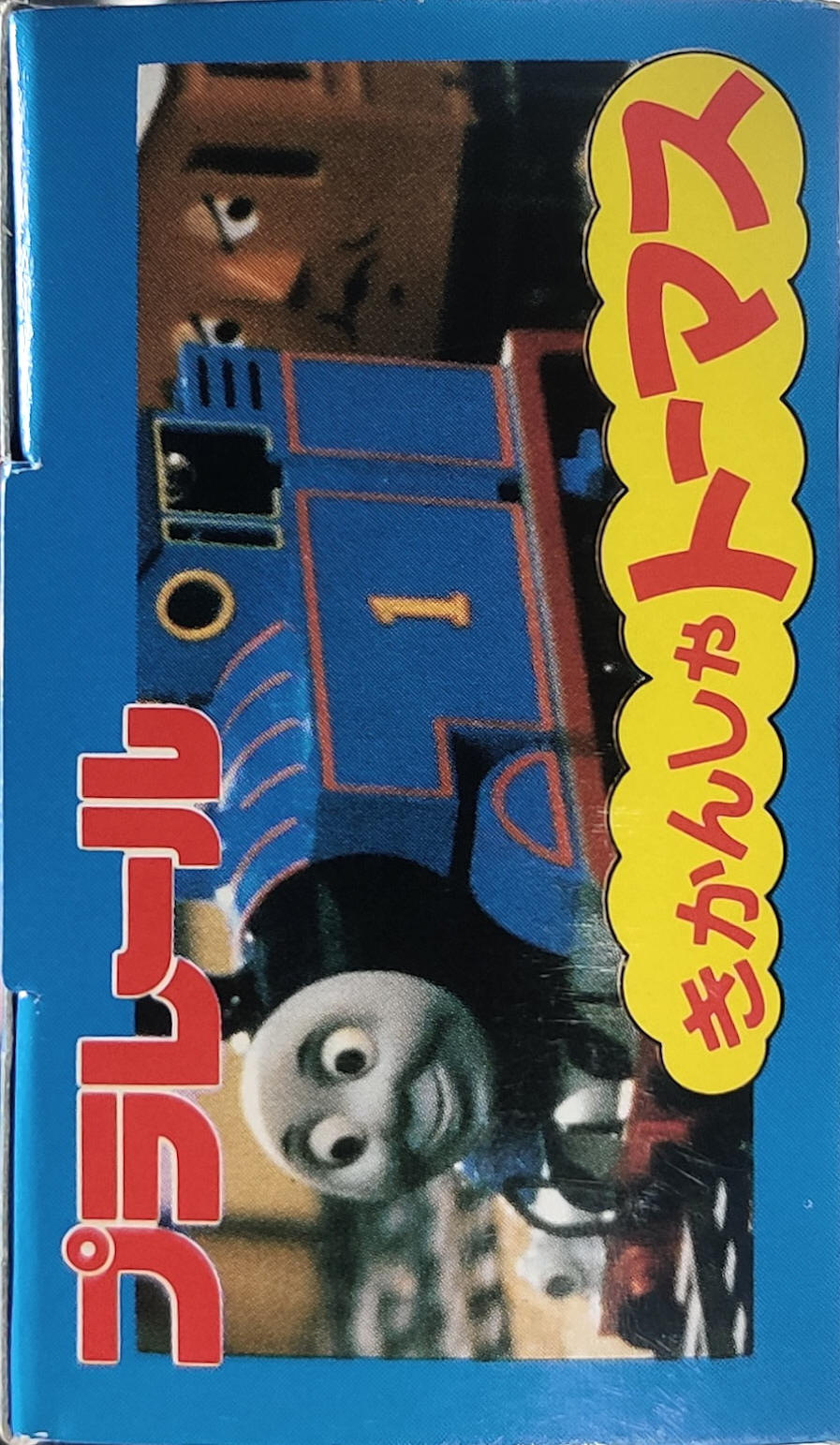


Thomas the Tank Engine (きかんしゃ トーマス, literally "Locomotive Thomas") was released on March 20, 1992 and was the first release in the Thomas series of Plarail sets, trains, and accessories. It features Thomas and his two coaches Annie and Clarabel who were all new moldings at the time. The box shape used for the Thomas series in the 90s is similar to the regular sixth generation Plarail boxes with the first two units of the train visible even after regular Plarail releases transitioned to the seventh generation box with all three cars visible in 1994. The front of the box has the older 1980s "Kaye & Ward" Thomas logo as well as information about the toy using a AA battery. The rear of the box has battery installation information as well as a small blurb about Thomas that says, approximately, Thomas is a popular and energetic character. Thomas's carriages are Annie and Clarabel. Annie carries the passengers, and Clarabel carries the passengers and their luggage. The three cars always run together well. One of the inner rear box flaps has a list of incompatible accessories printed on it.
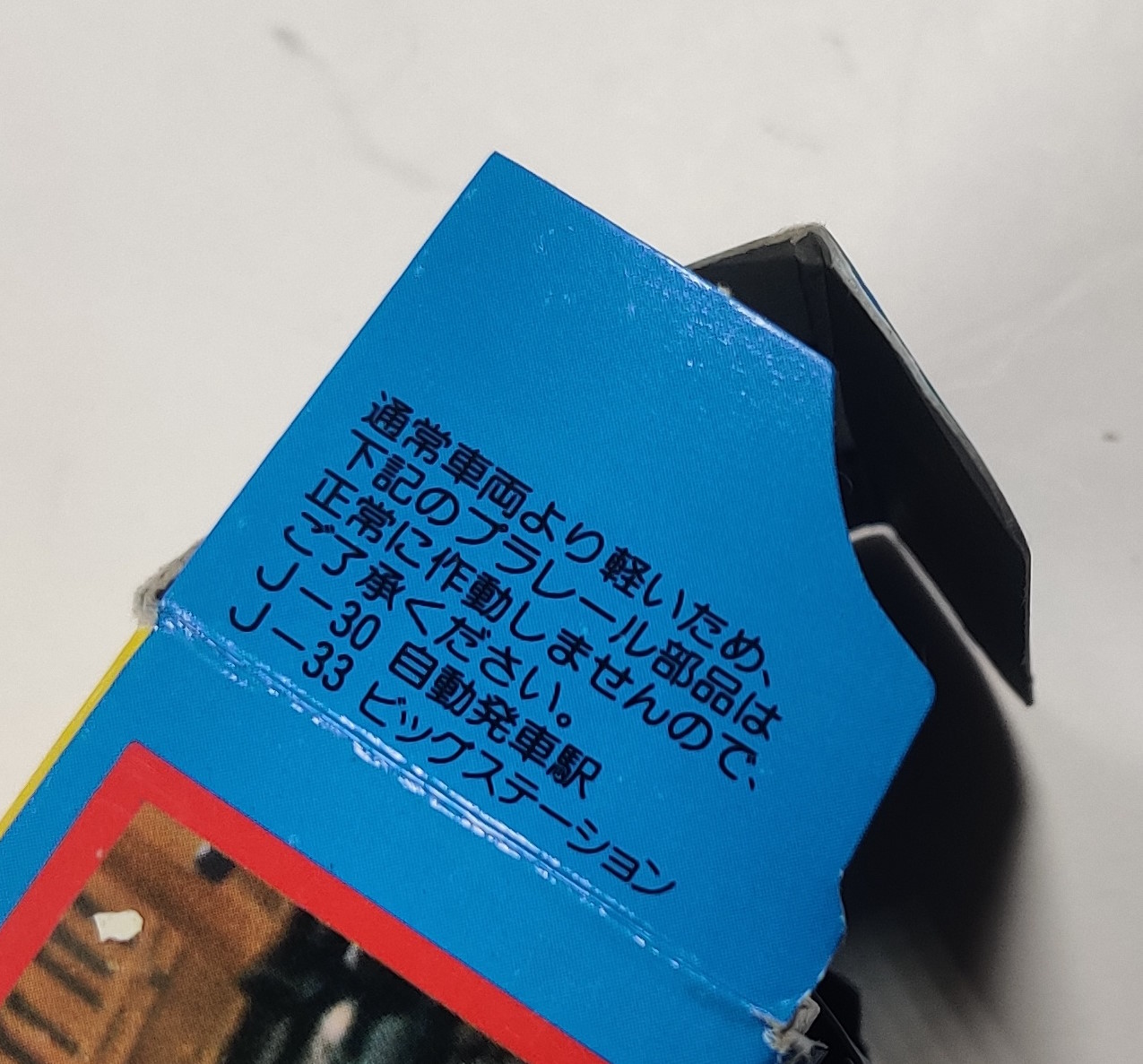
The notice reads, approximately: Please note that the Plarail parts below will not work properly because it is lighter than a regular vehicle. J-30 Automatic Departure Station J-33 Big Station
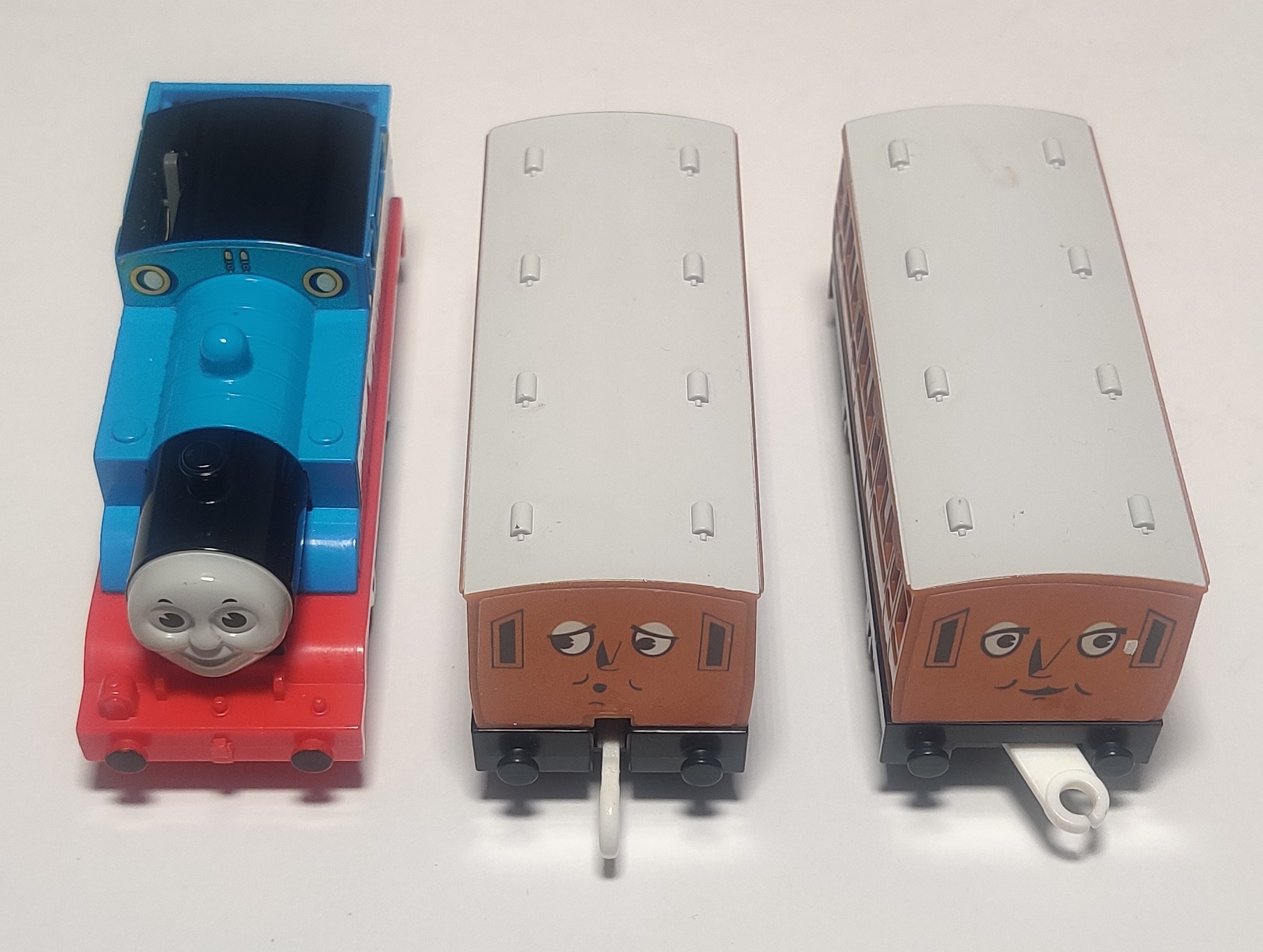
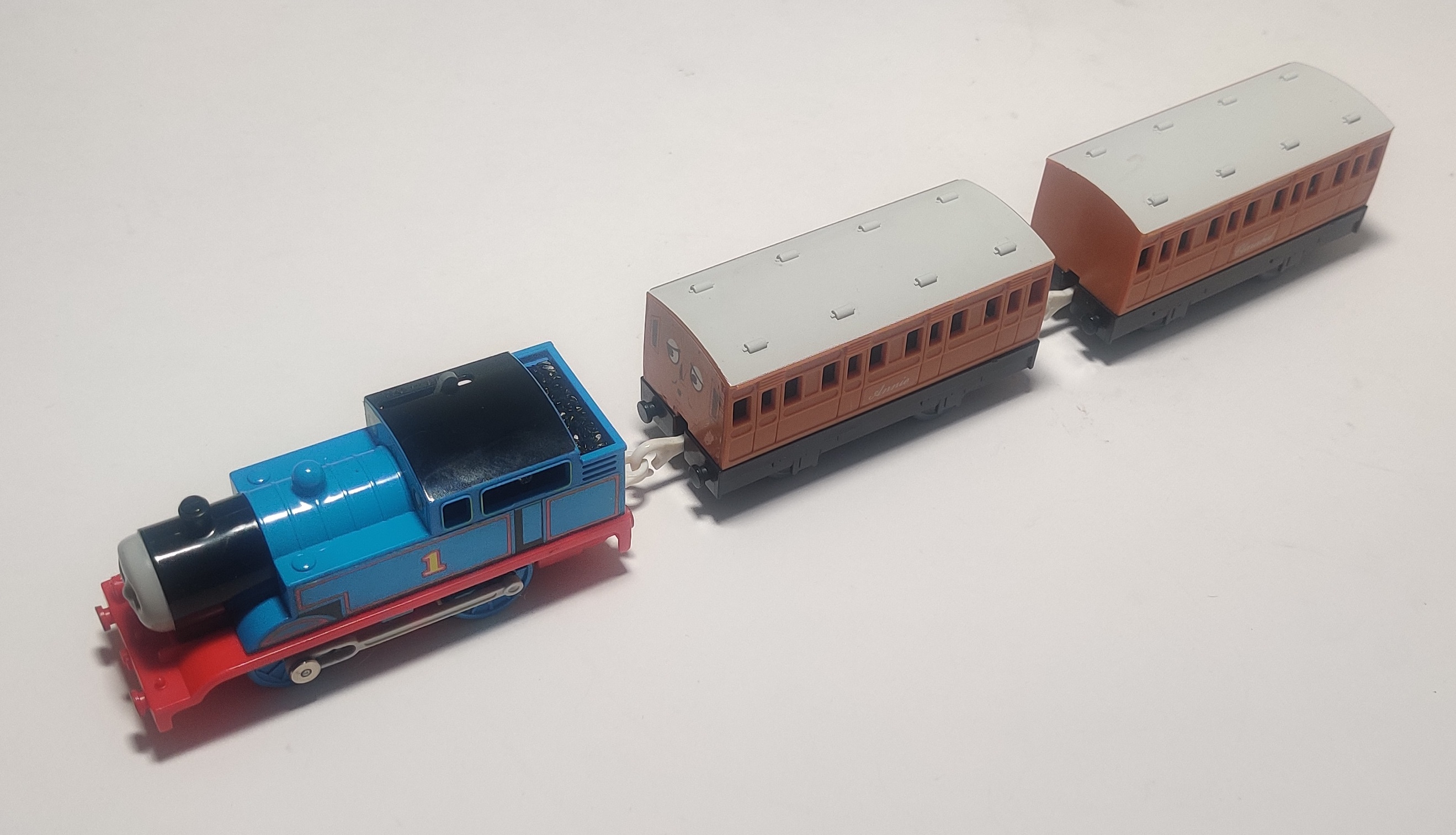
There are two print runs of this style of box. One print run of boxes was done in late 1991 ahead of the 1992 release as shown above, signified by the ST-1 mark on the rear. Thomases sold in these boxes were produced throughout 1992. Of the 1992 production run Thomases I own I have four from March, the first month Thomas went on sale, three from April, one from June, two from July, and two from October 1992. This most likely does not reflect when exactly the engines were first purchased, and some Thomases produced in 1992 were not put on shelves until 1993 (it does not appear that any new Thomases were actually produced in 1993).
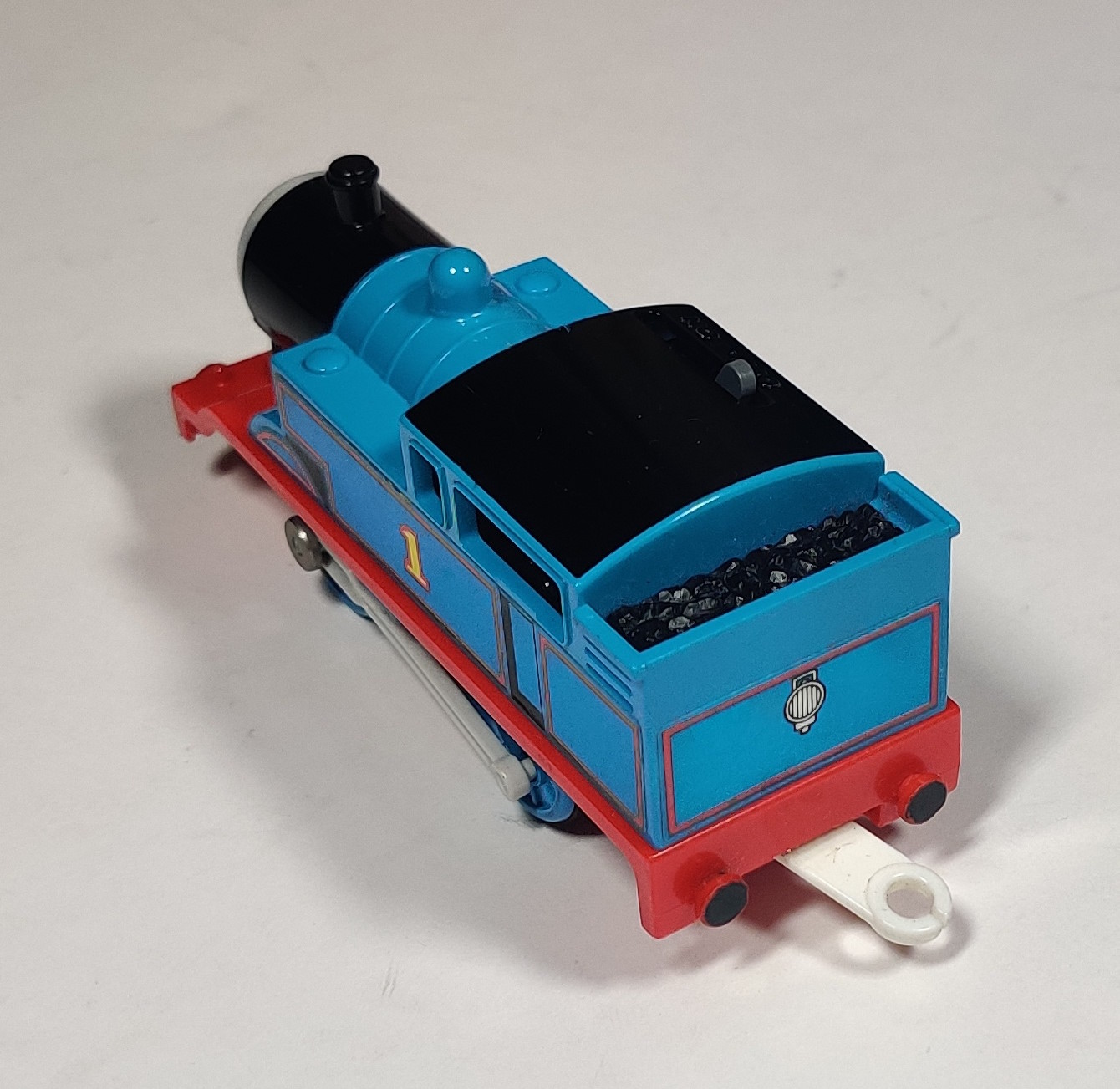
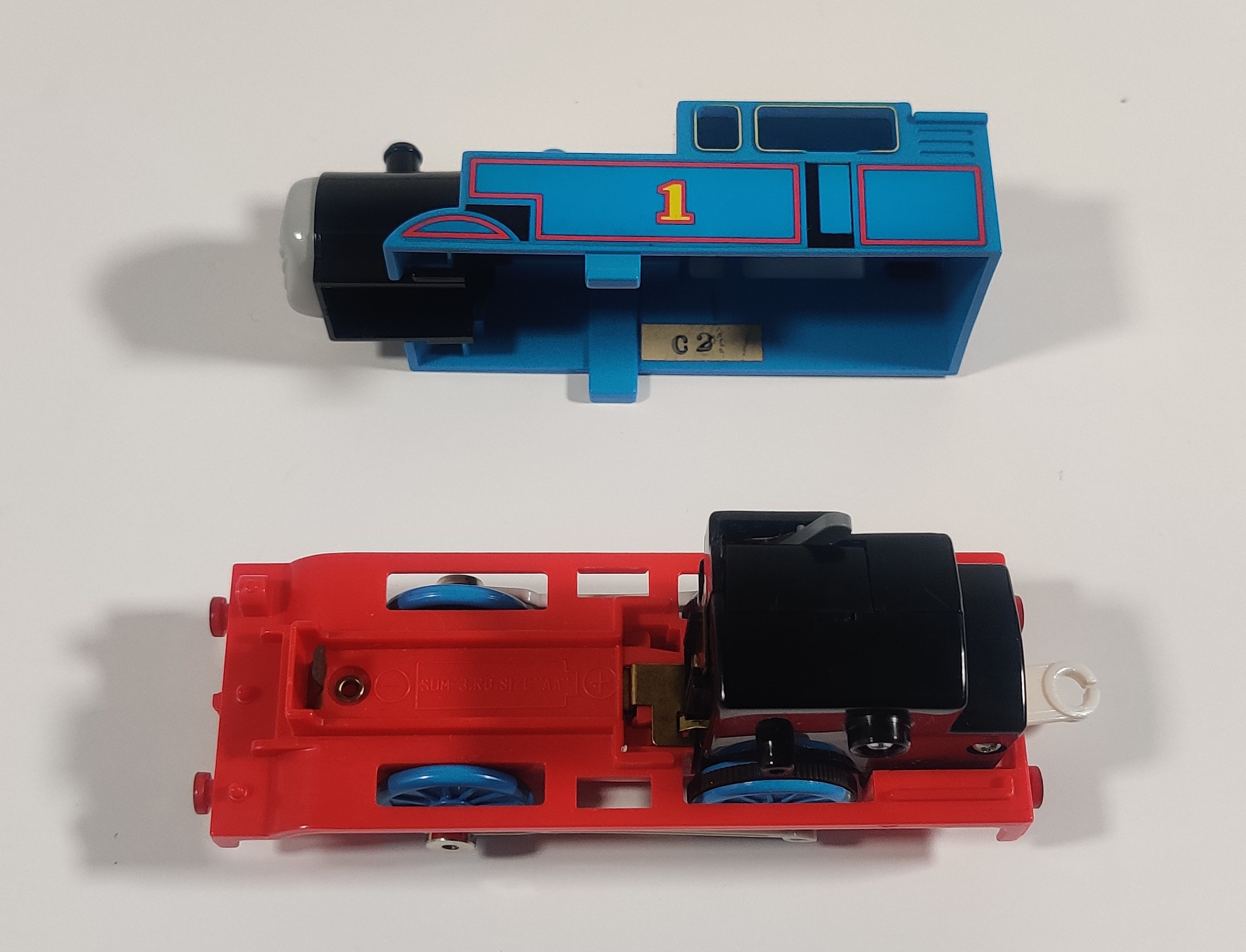
The month a Thomas (or just about any other Plarail train made after 1990 or so) was produced in can be figured out by opening the locomotive and looking for a sticker inside the shell with a production code on it. The letter of the code is the month the toy was produced (A=January, B=February, etc) and the number is the last digit of the year, with years after 1999 often having the last two digits. The style of production sticker is the made in Japan "stamped" type with a wider blank sticker that is stamped with an ink stamper instead of the smaller printed style of sticker used on Thailand produced trains. My 1991 print run box has, to the best of my knowledge, never been opened since leaving the factory some time in 1992, and I do not know what the manufacturing sticker on it reads.
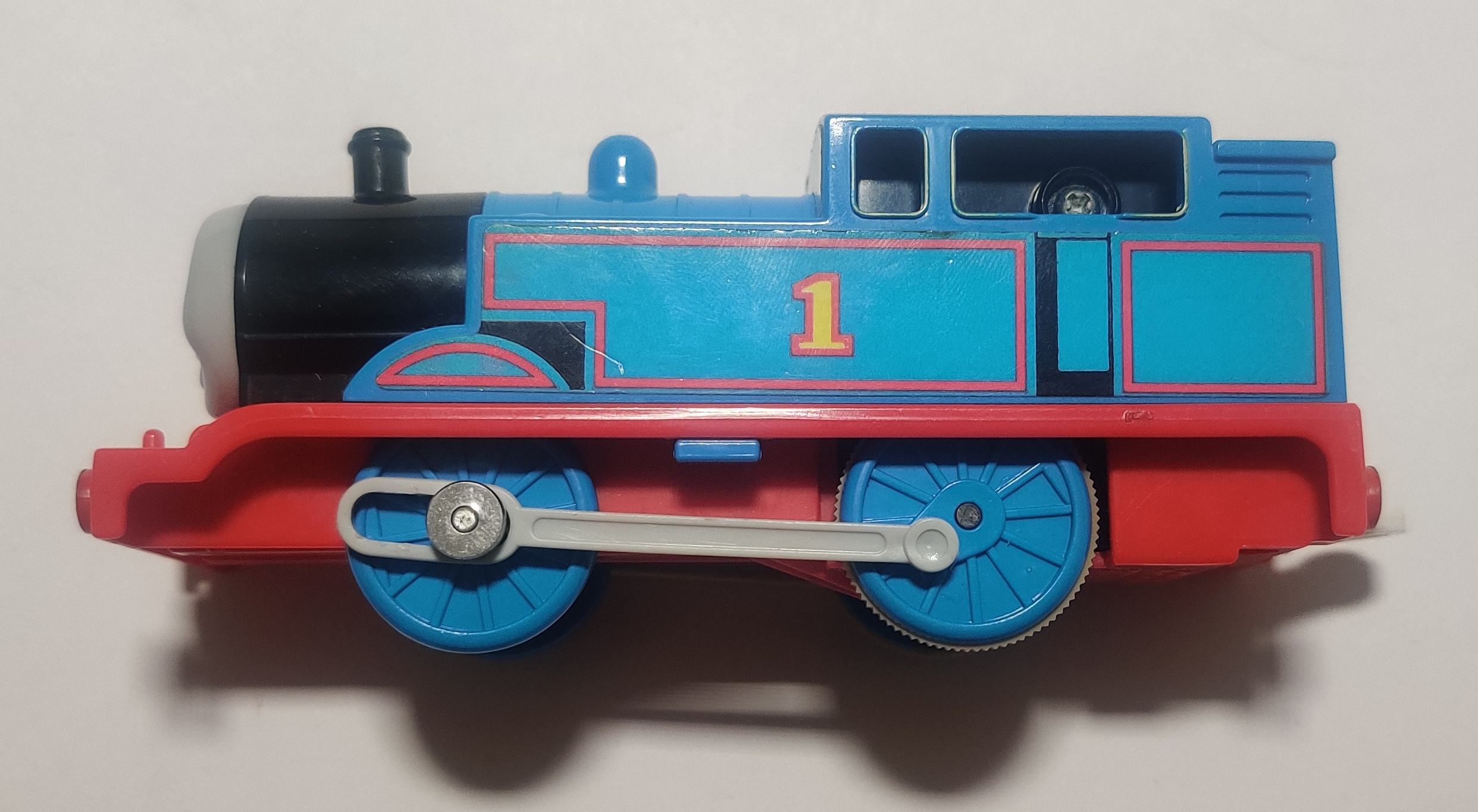
This iteration of Thomas only has paint applied on the rims of the cab windows and to the face, which is actually molded into the same black piece of plastic that forms the smokebox and funnel. The side and rear detailing is all stickered.
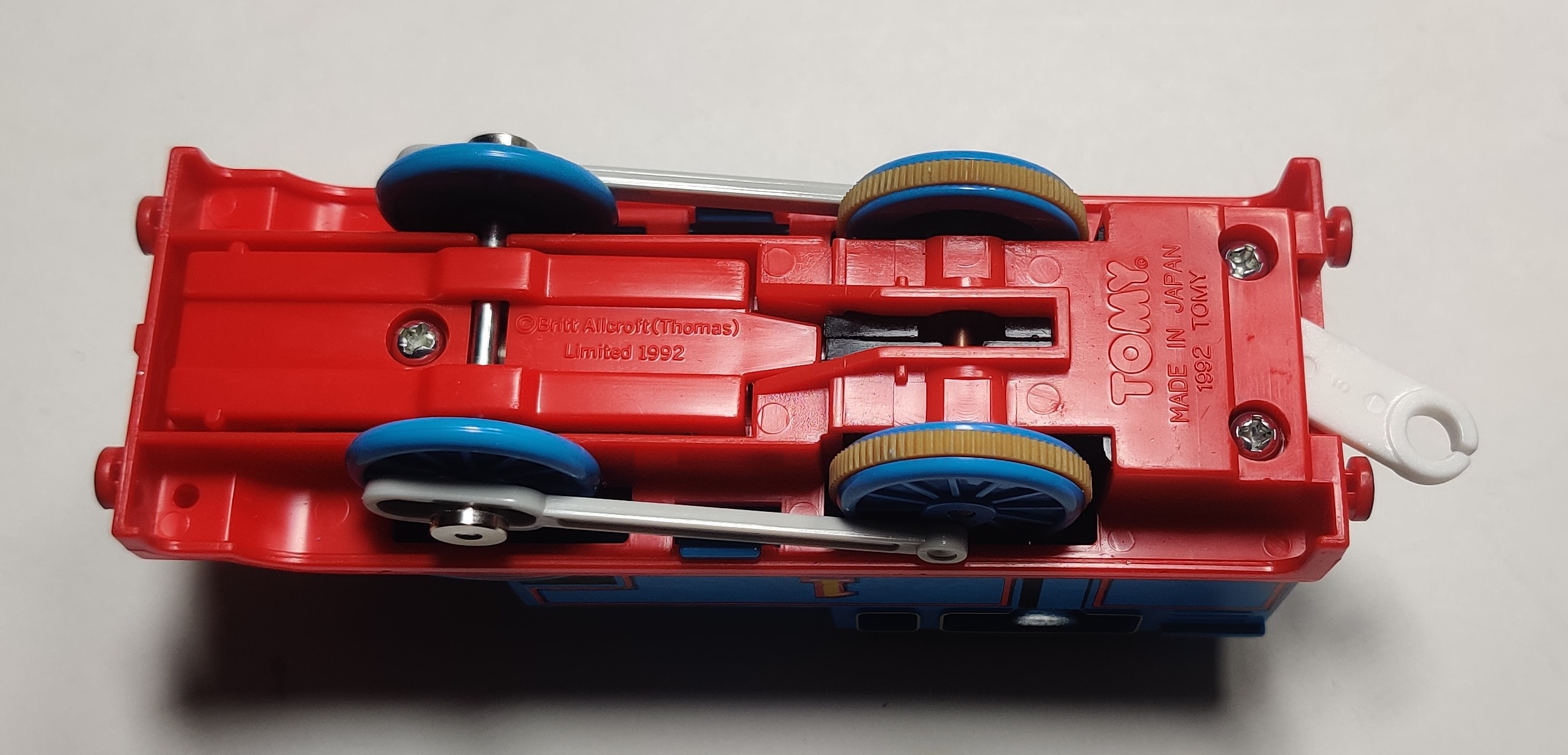
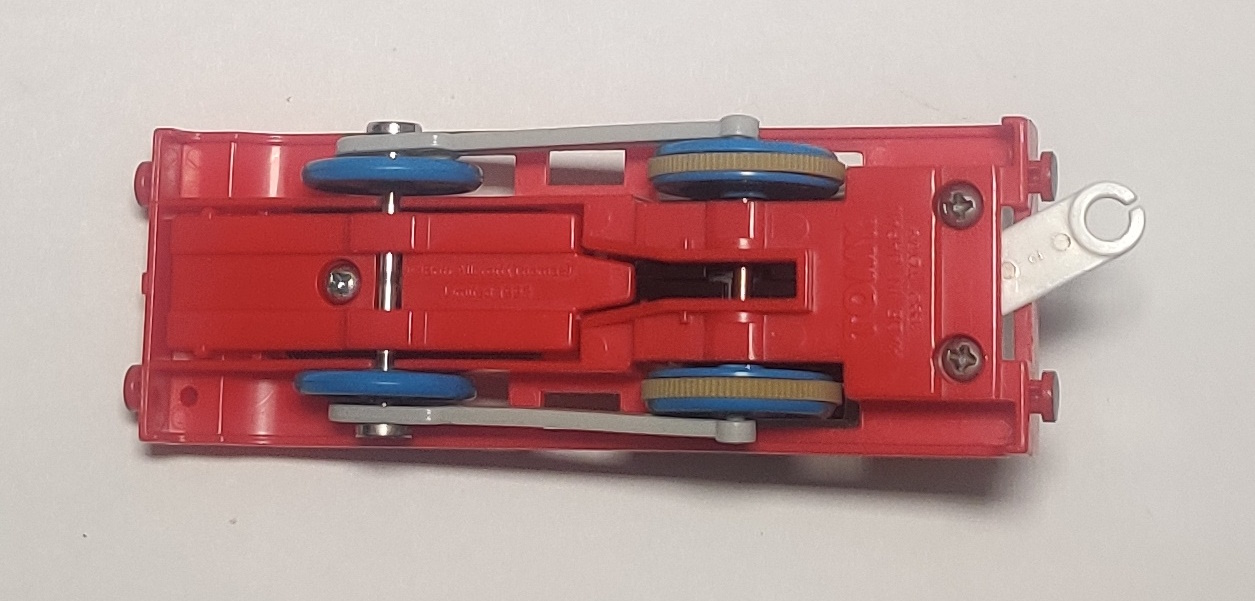
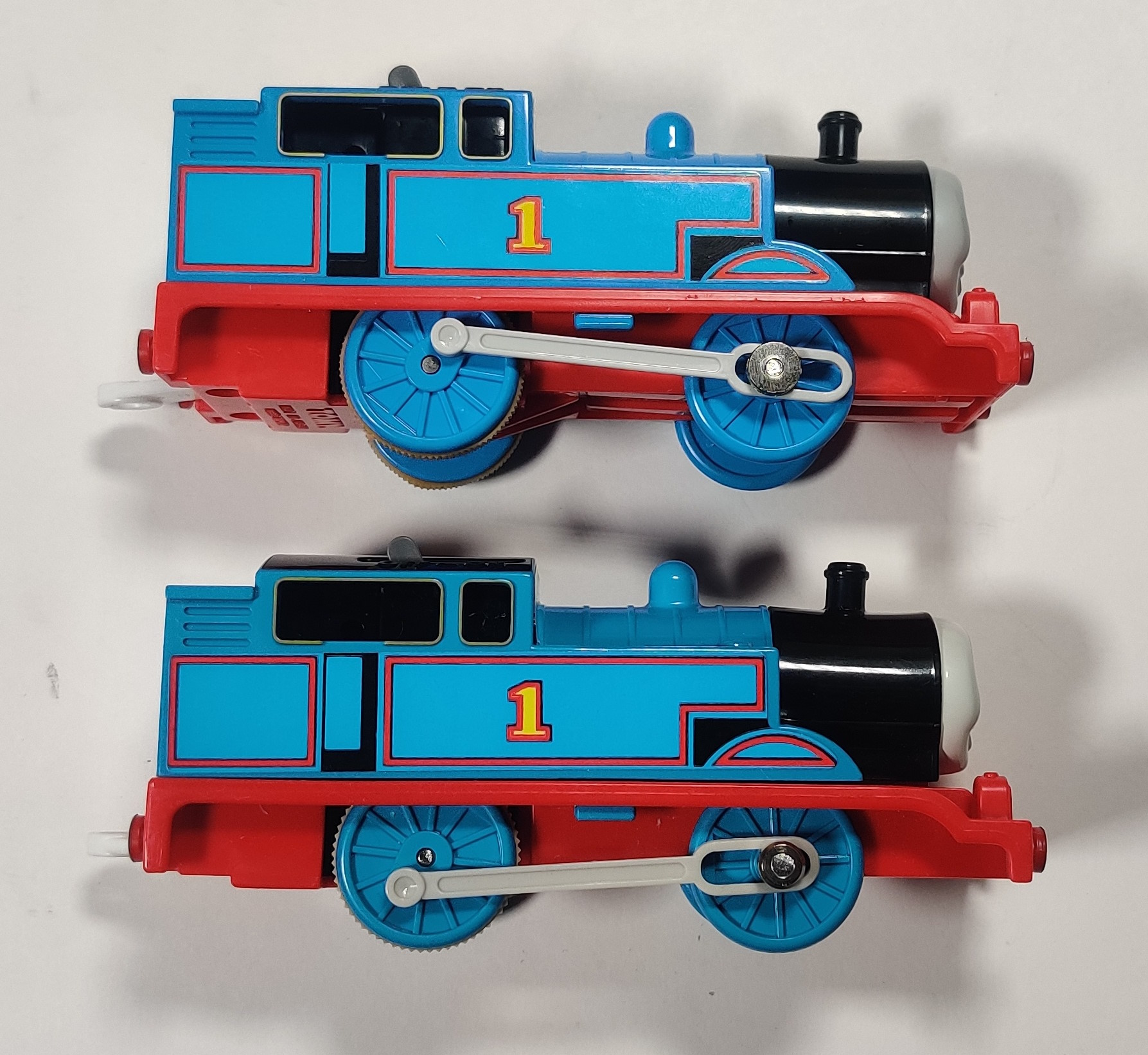
These Thomases are made in Japan and have a few differences from later Thailand-made Thomases. The chassis of Thomas and the shared chassis of the coaches are all marked Japan, as well as the carriage wheel holder inserts. Inside, Thomas has brass battery contacts and the larger stamped production sticker used on early 90s Plarail releases. Gears in the gearboxes are molded in the same grey as the power switch. Thomas's front axle is different from later designs in that it is "capped" on both sides instead of having a flat head on one side and a cap on the other. The cap is slightly larger than the later design and has a smaller visible pin in the heads of the caps, although the axle itself is the same diameter as usual Plarail axles.
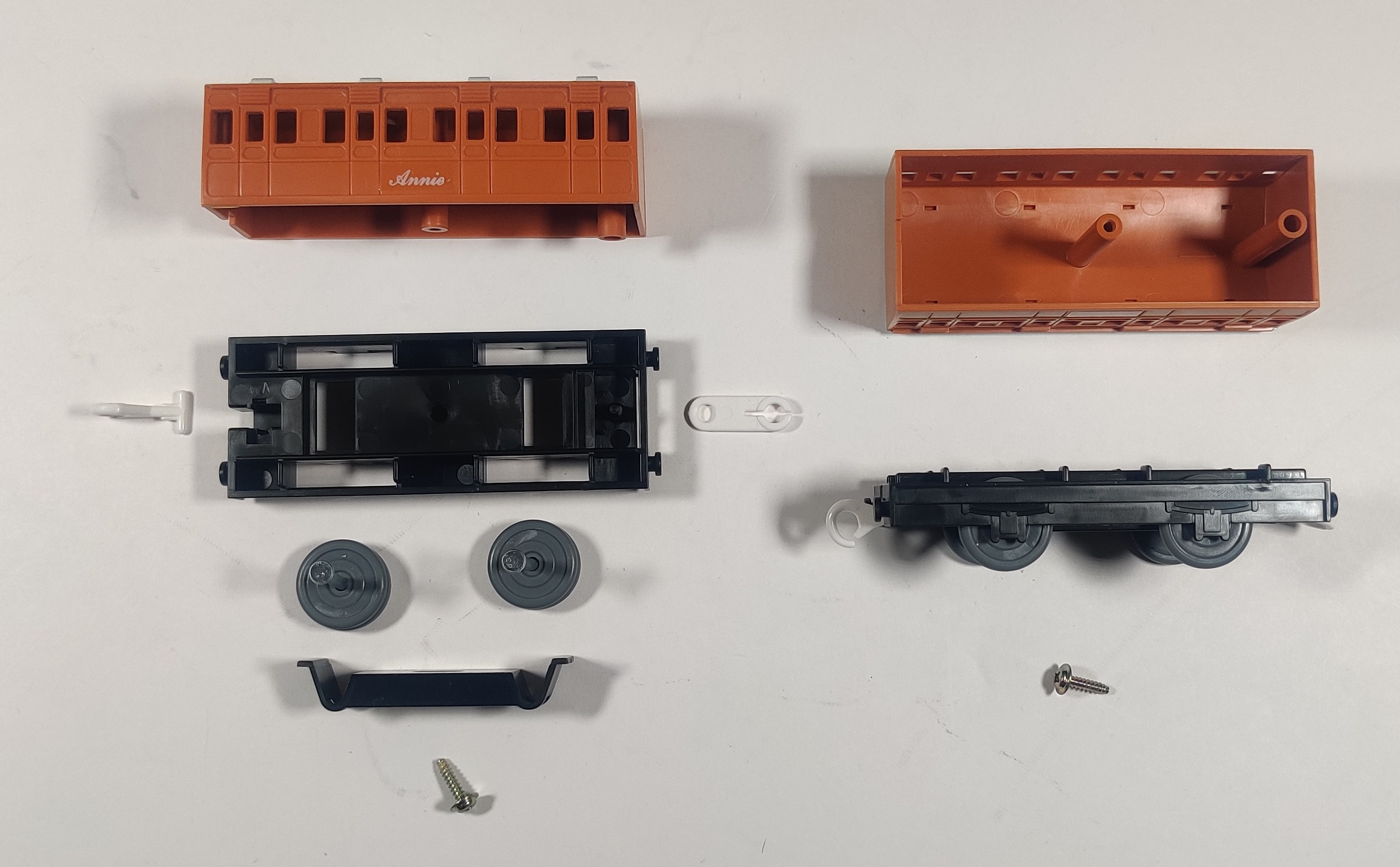
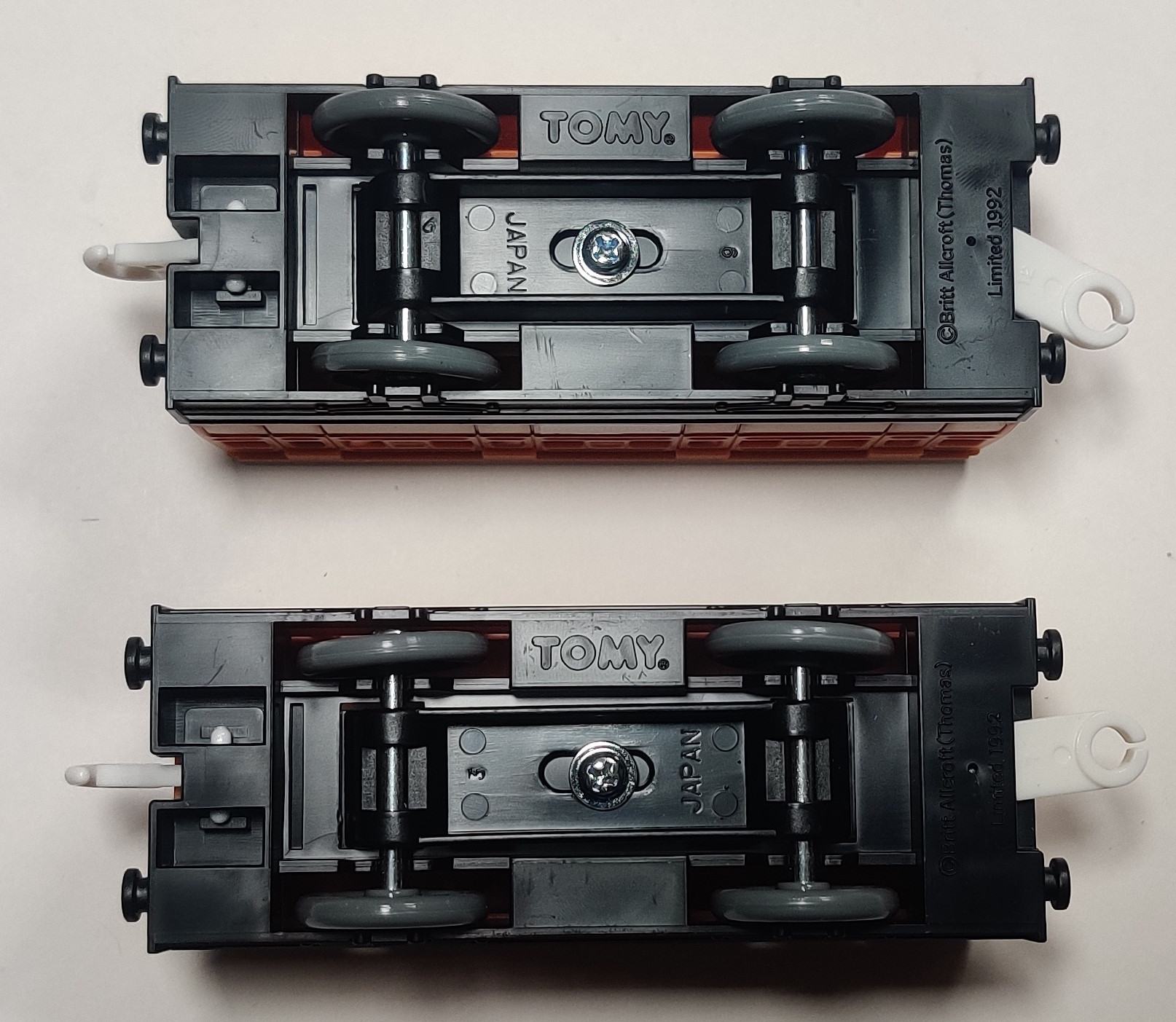
Annie and Clarabel share the same molding and chassis, and there is no attempt to reproduce Clarabel's guard's compartment. I do like that the bodies are hollow with open windows instead of solid like the Tomy Train versions from around the same time, even though there are no interior details. I do think the moldings are very nice and otherwise reproduce the characters pretty well, and I think the stickered faces are pretty good depictions.

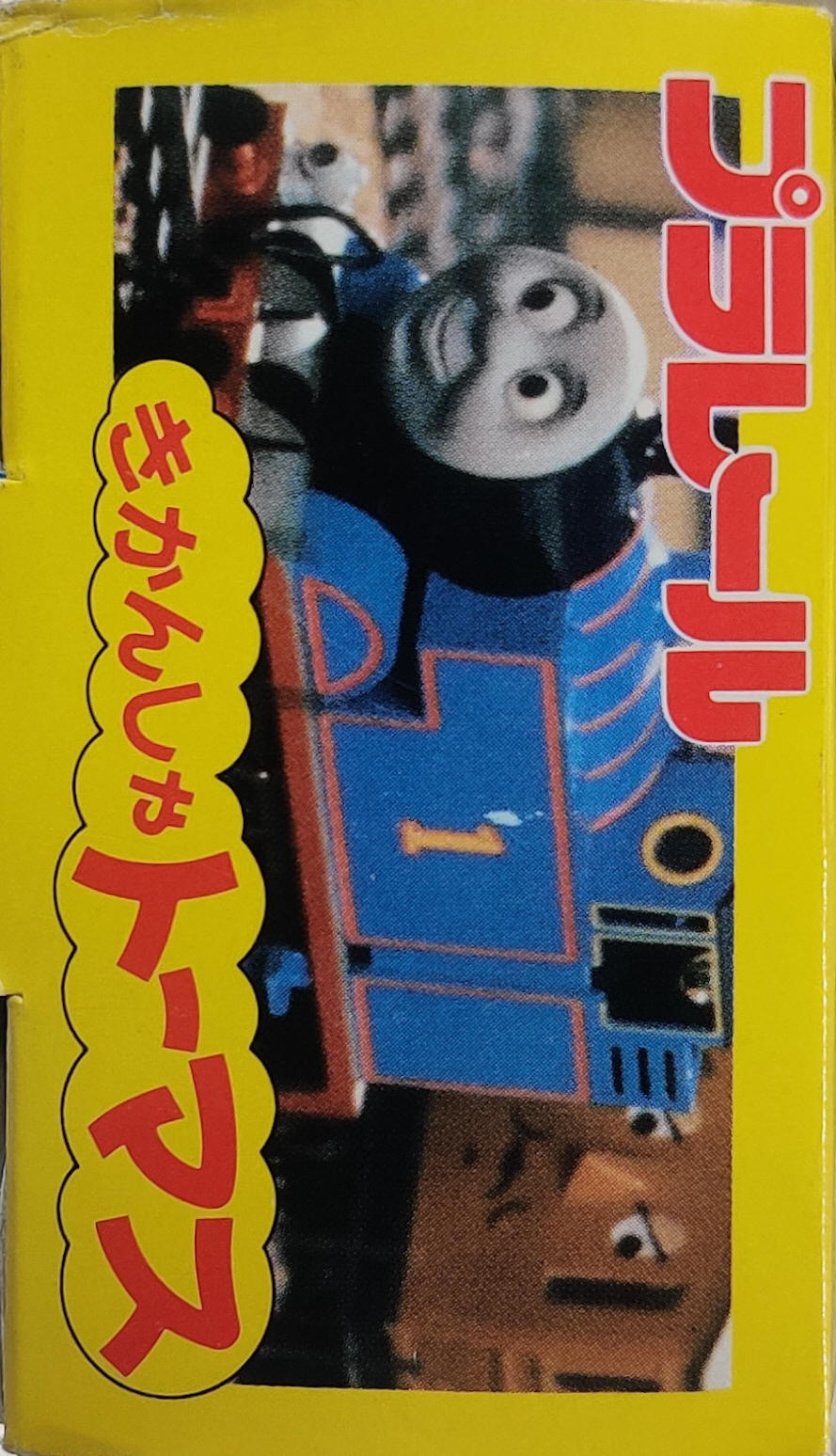

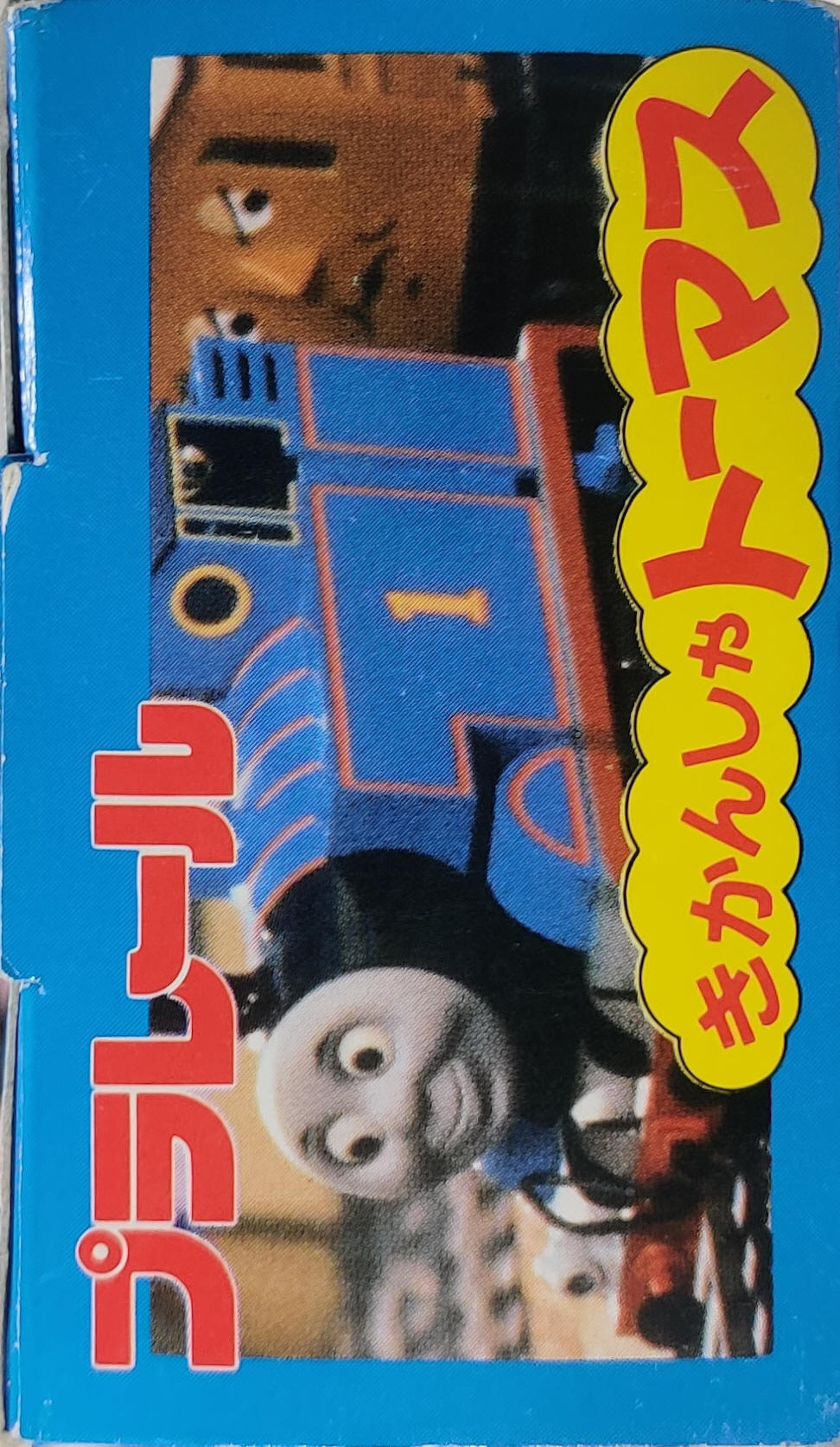


In 1994 before production of Thomas and the other early Thomas-series characters that were released before 1995 shifted to Thailand an additional print run of boxes was done with the ST-4 mark. New Thomases were produced from mid 1994 through to the end of the year. I have seven 1994 production Thomases, two from June, three from September, one from October, and one from December.
Thomas the Tank Engine (Thailand rerelease) (1995)

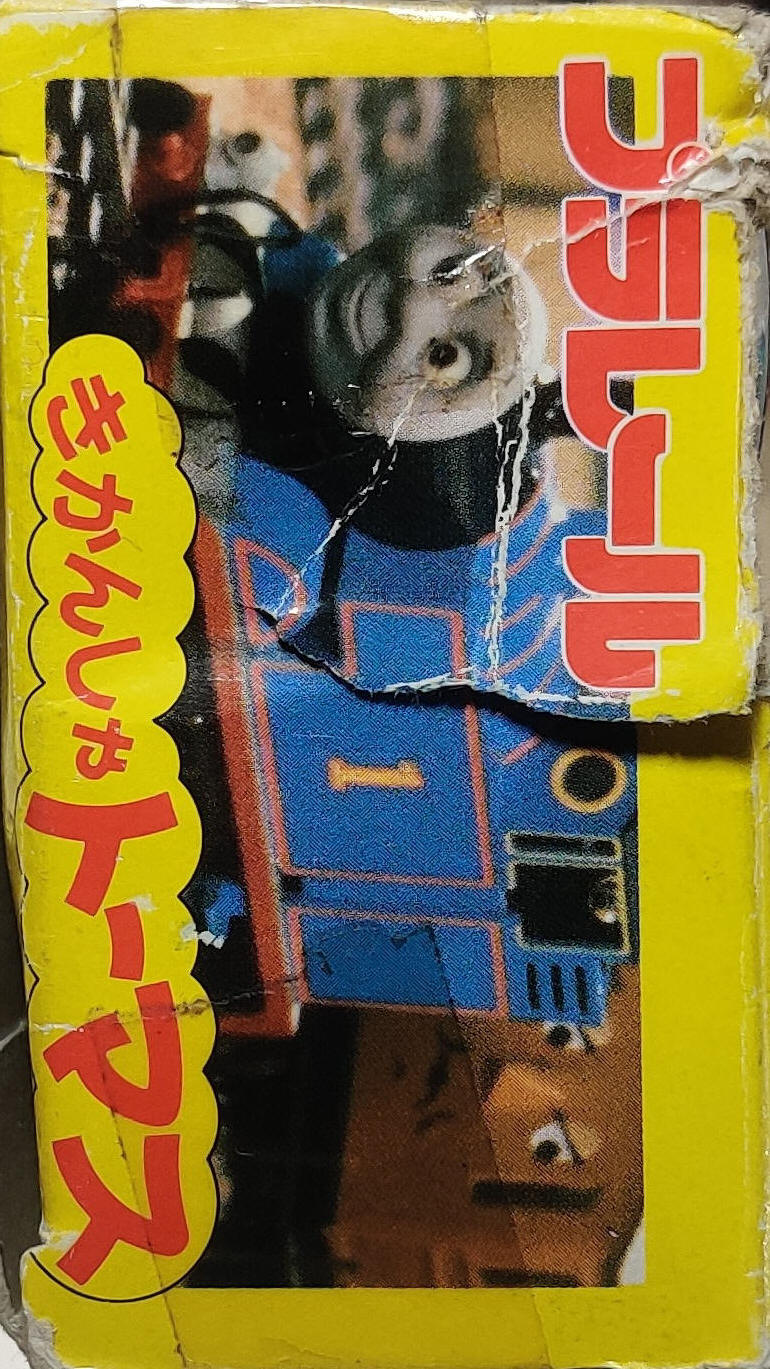

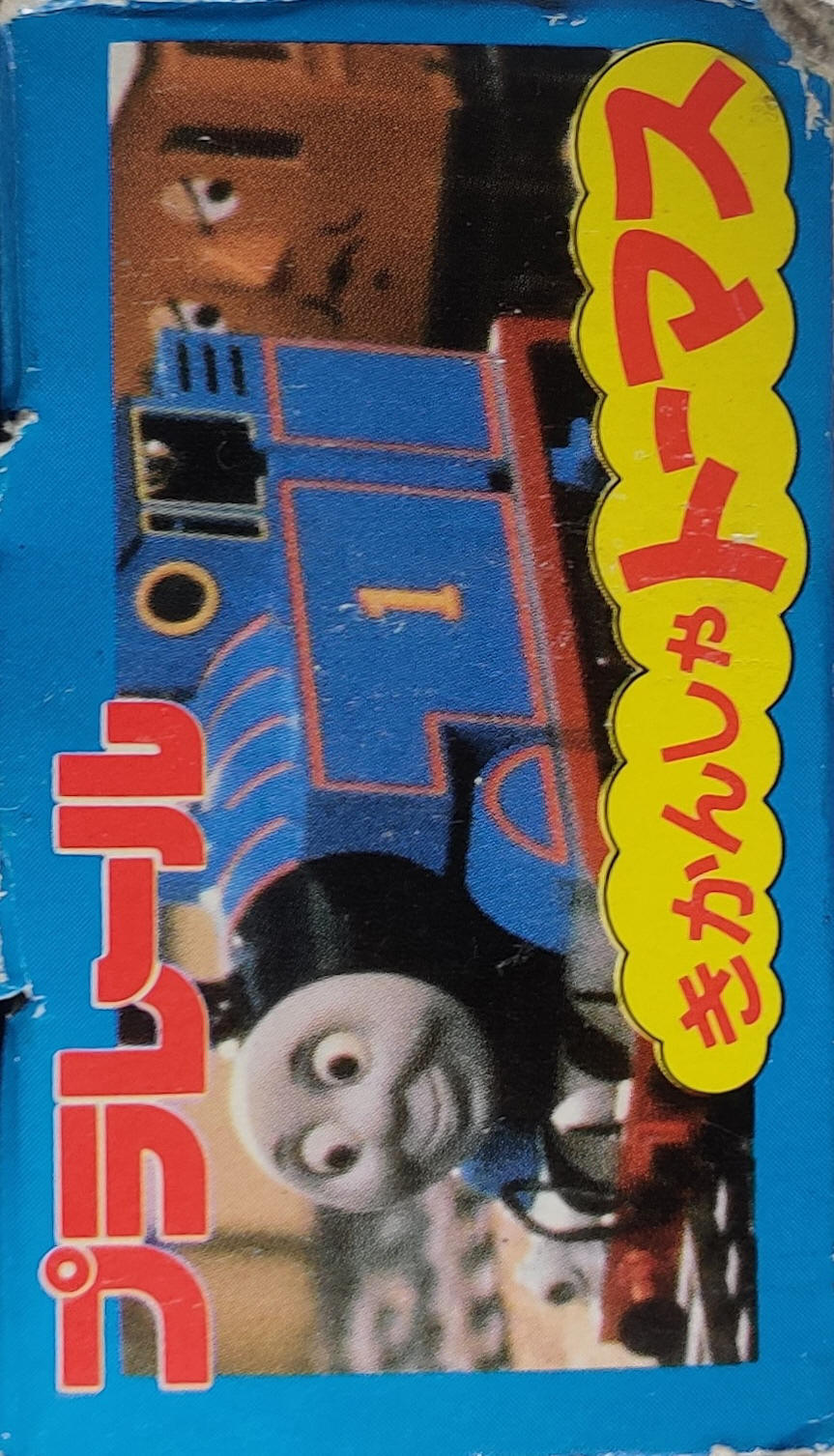


In 1995 new Thomases began being made in Tomy's Thailand factory, which began producing Plarail in 1989. The first print run of boxes for Thailand-produced Thomases was printed in late 1994 and had minor changes like some additional battery information. This style of box also added the pull-out hang tag flap and is slightly shorter than the older designs. The hang tag was introduced on the redesigned three-window seventh generation Plarail boxes, but the slanted sixth generation designed continued to be used for the Thomas series as it allowed for a large character portrait on the front of the box. This box shape was also used for the Tomica World range. These boxes were used for a relatively short period of time in 1995.
Thomas the Tank Engine (Second Thailand box) (late 1995)

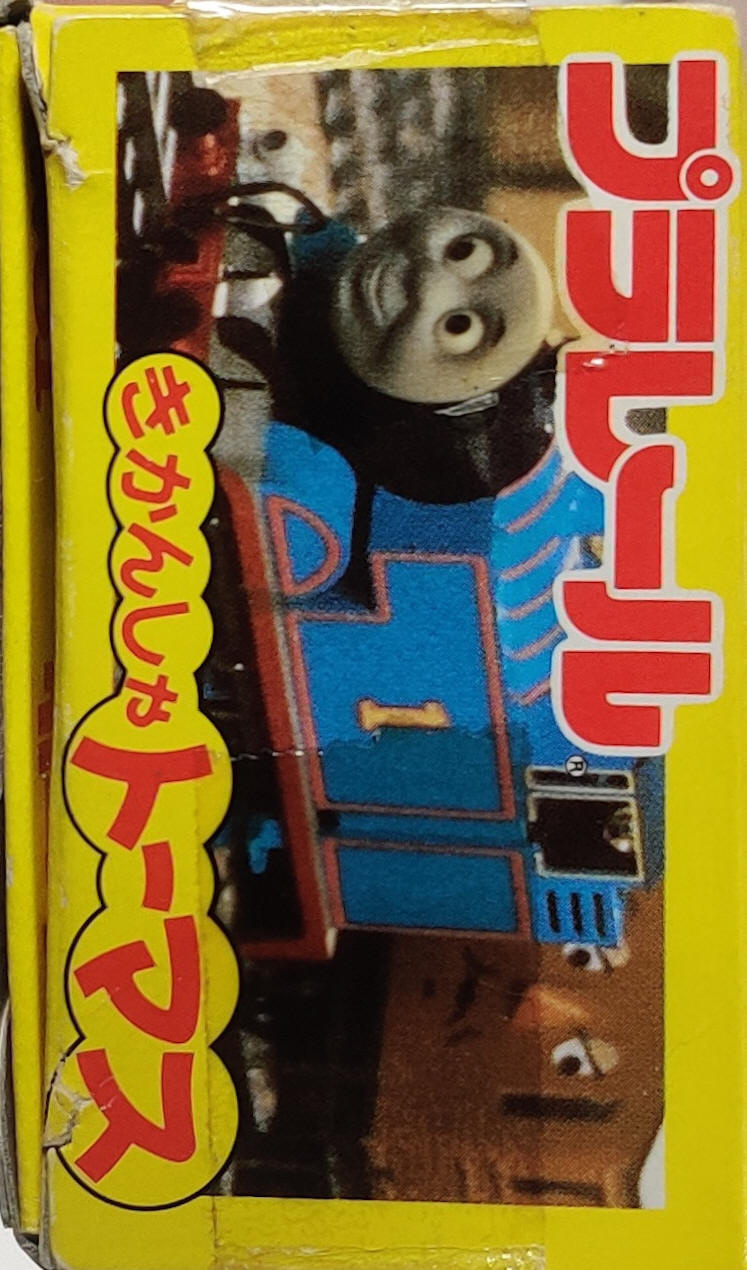

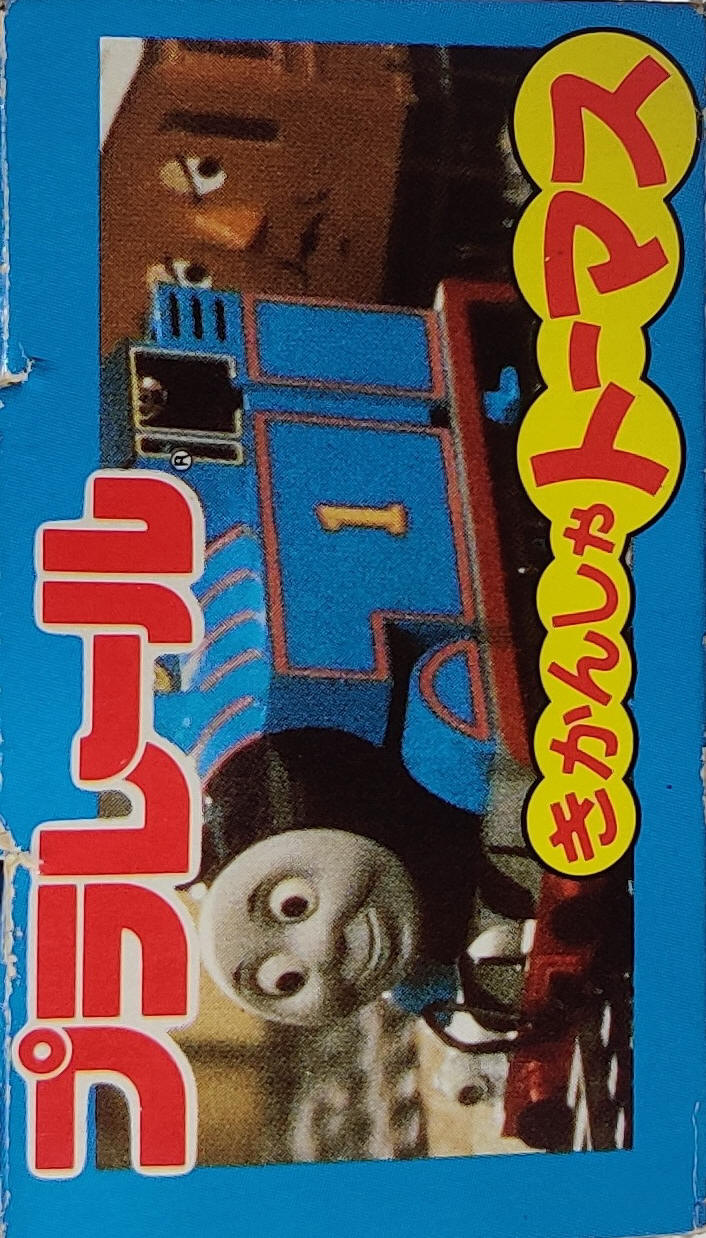


A new updated box that used the new "Britt Allcroft" logo box design first used on James's original box was printed in 1995. This updated box moved the incompatibility list to the rear of the box and added an additional safety warning box on the left side. The Thomas pictured on the back is actually the late stage prototype. Funnily enough, some of the changes to battery installation information seem to have been reverted back to the older Japan-made boxes. Thomases that come out of these two styles of boxes are essentially identical other than the darkening of grey paint application in the later 1990s as noted below.

90s box Thomases I have found with original internal packaging imply they were packaged with three medium foam blocks between the cars and the back of Clarabel and the rear box flap, with a thinner, longer piece at the top of the box in front of Thomas's face.
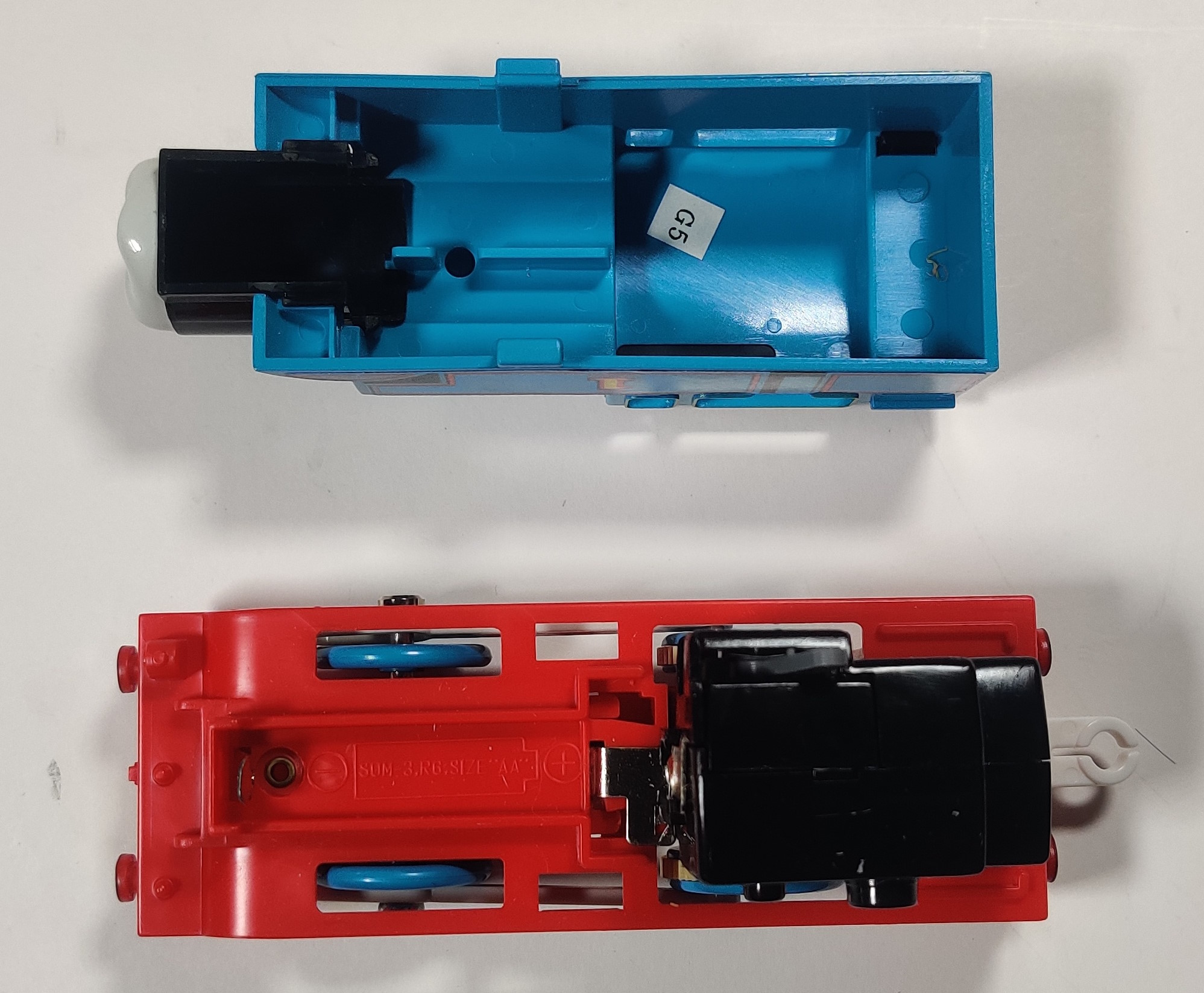
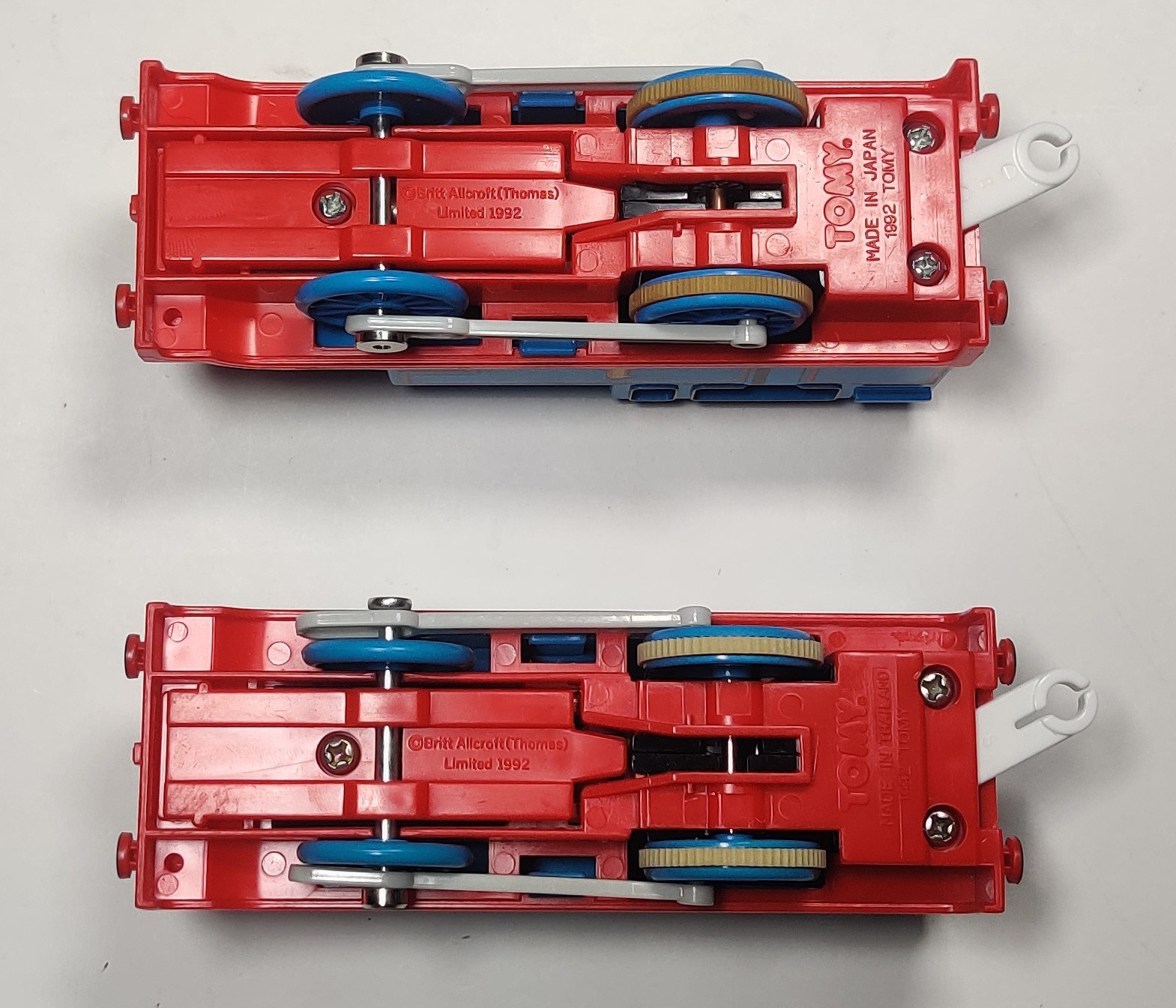
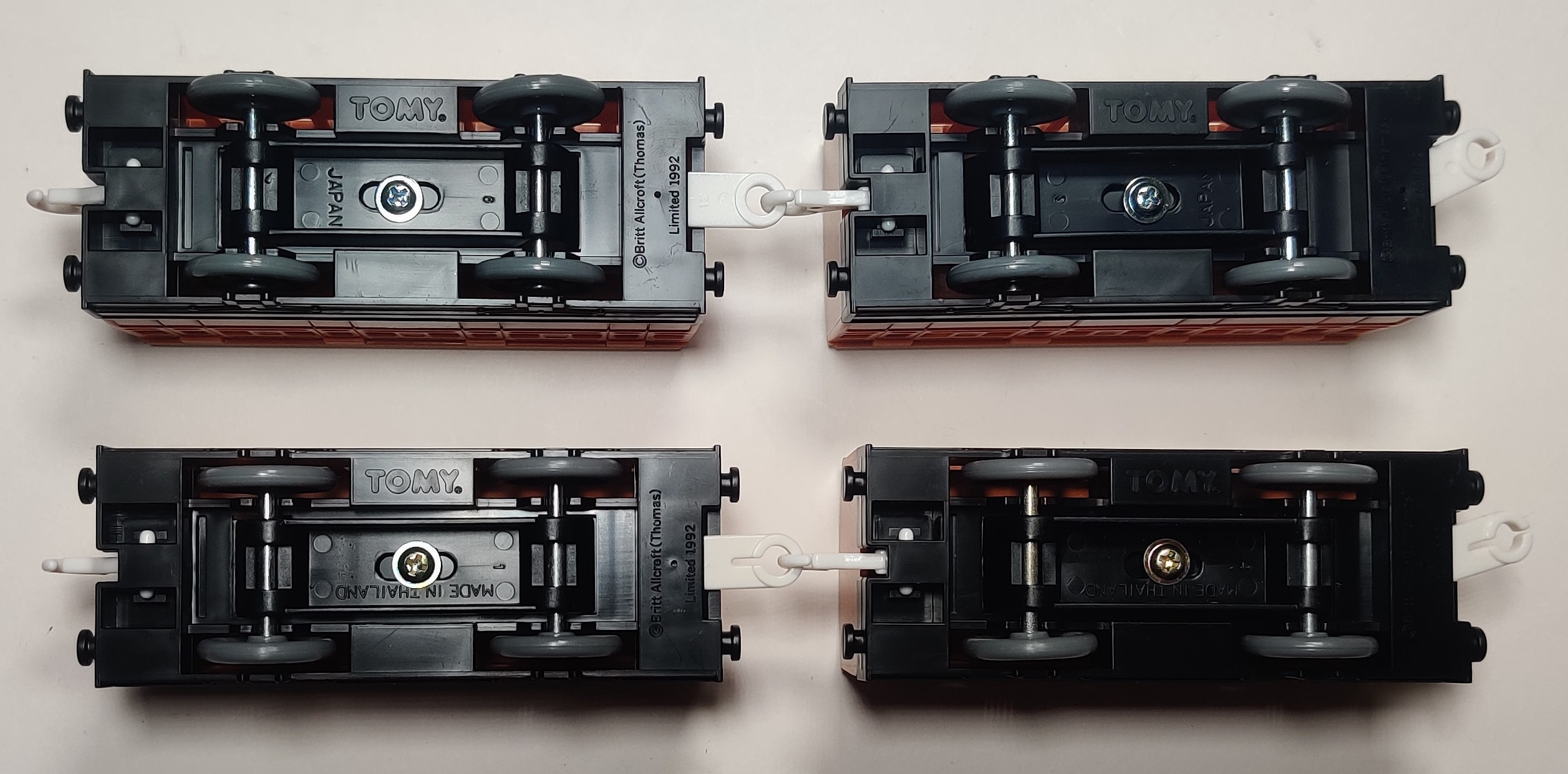
Thailand-produced Thomases have silver battery contacts and the updated front axle design also first used on James. Being made in Thailand, these engines have the smaller printed production stickers inside. Thomas, Annie, and Clarabel were all updated to say made in Thailand. The single split rear couplings were also changed to the modern strain-relief style. In the mid 90s the spacing of slits in the traction tires was also slightly wider than earlier or later tires for whatever reason. I have found mid 90s Thomases dating from July, August, November, and December of 1995 as well as June and September 1996. Later four-wheel Thomases I own date from July and October of 1998
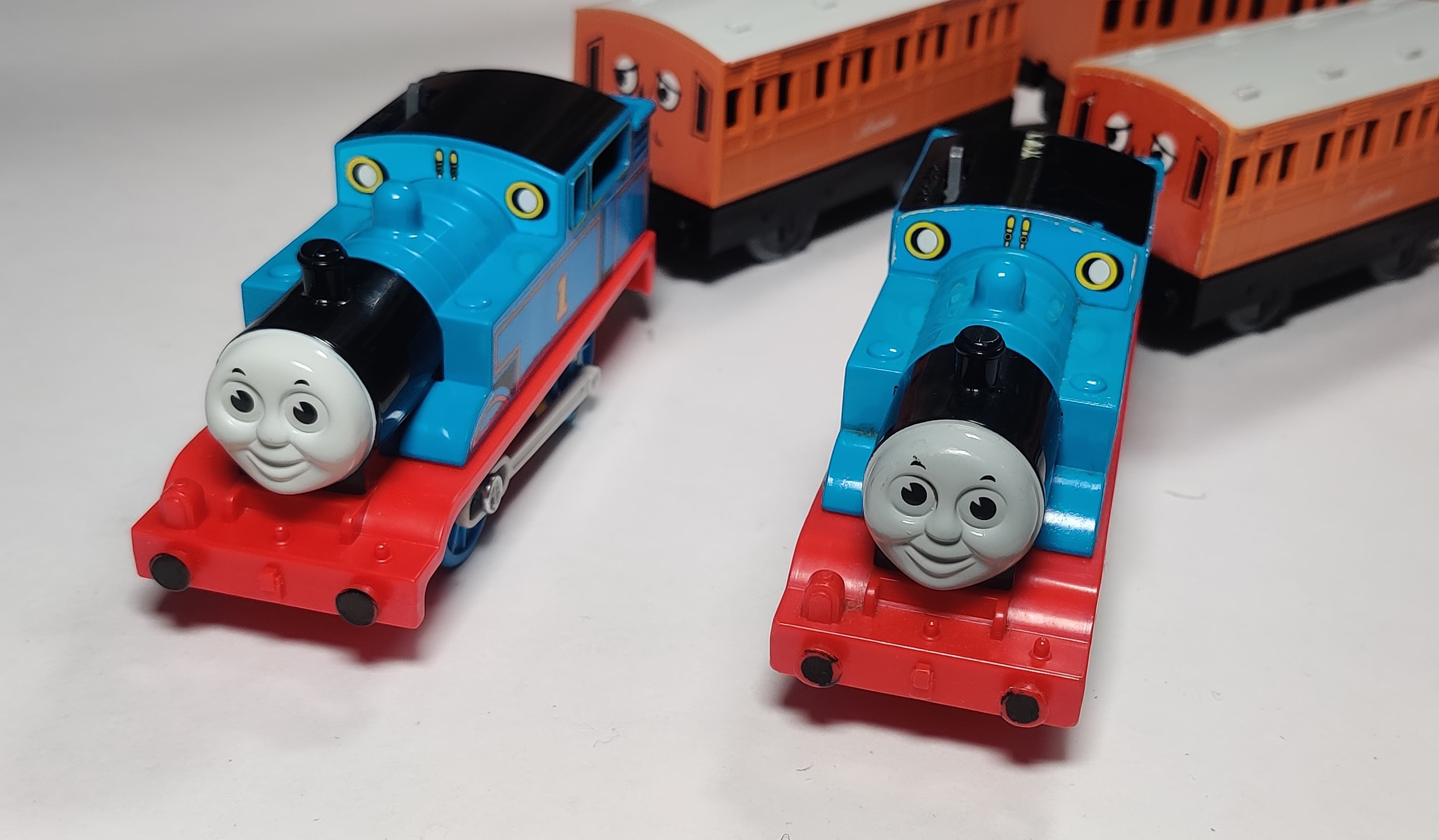
Similar Thomases were produced from 1995 through 1998, and first appeared in exported Battery Operated Rail System sets in 1997 and in Tomica World sets and packs in 1998. There is most likely another updated box from 1997, as some other older characters received new box printings with updated compatibility lists around that time. The grey color used on faces (and the coach's roofs) varied somewhat throughout this era, starting out rather light in 1995 and seemingly getting progressively darker until a period in the early 2000s before the line was revamped when grays across the range were noticeably darker.
7440 Thomas (Tomica World) (1998)
In 1998 Thomas-series Plarail sets and vehicles began being exported as part of the Tomica World range. Individual four-wheel Thomases were sold in the yellow style of Tomica World packaging as 7440 Thomas. Later, the same catalogue number was used for the Tomica World individual six-wheel release which came out in 1999. In 2001 new red and blue Tomica World packaging was introduced for Europe with blue Motorized Road & Rail packaging introduced for the United States.
Candy Dispenser Thomas/Funny GO Rail Set Thomas (1998)
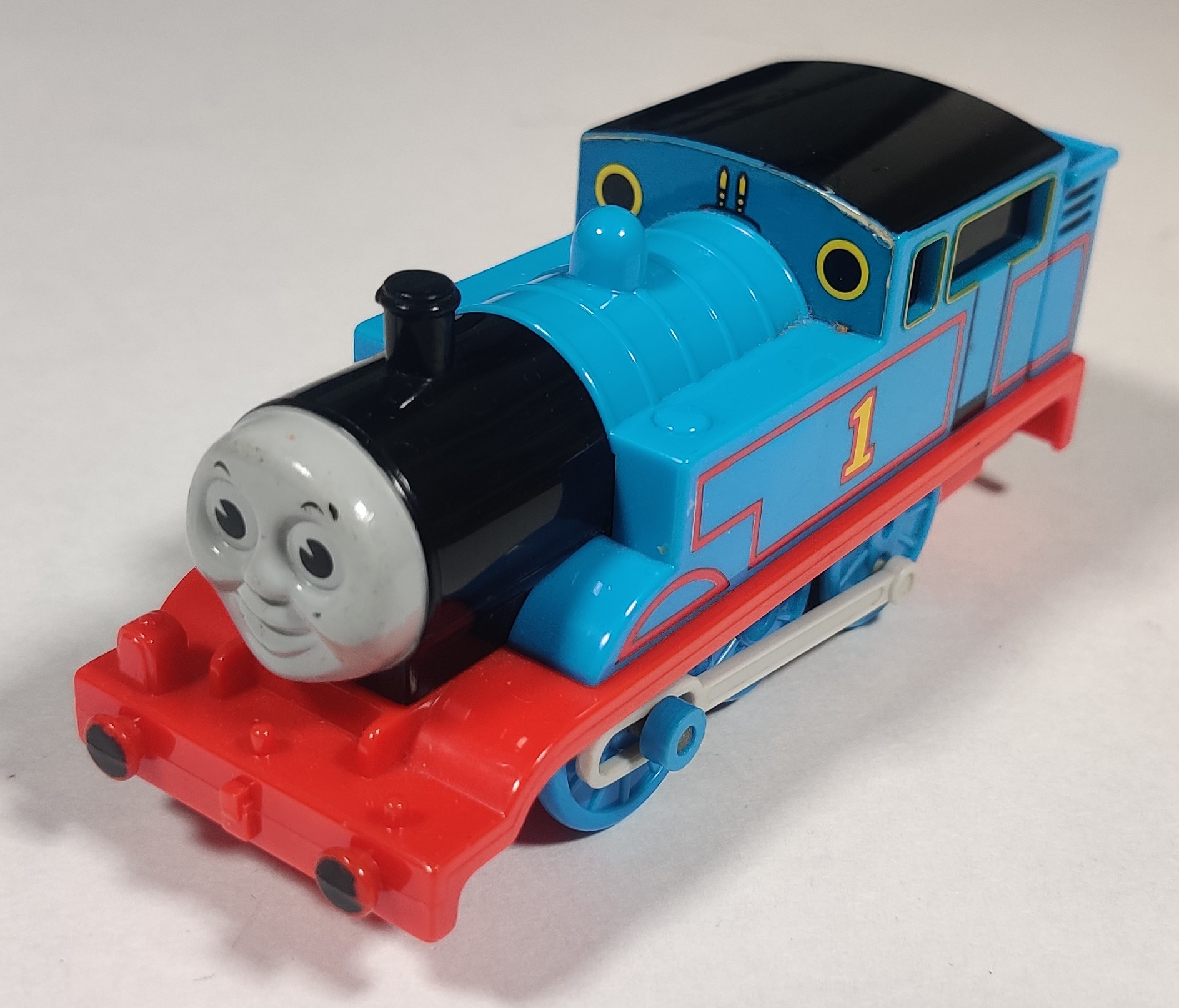
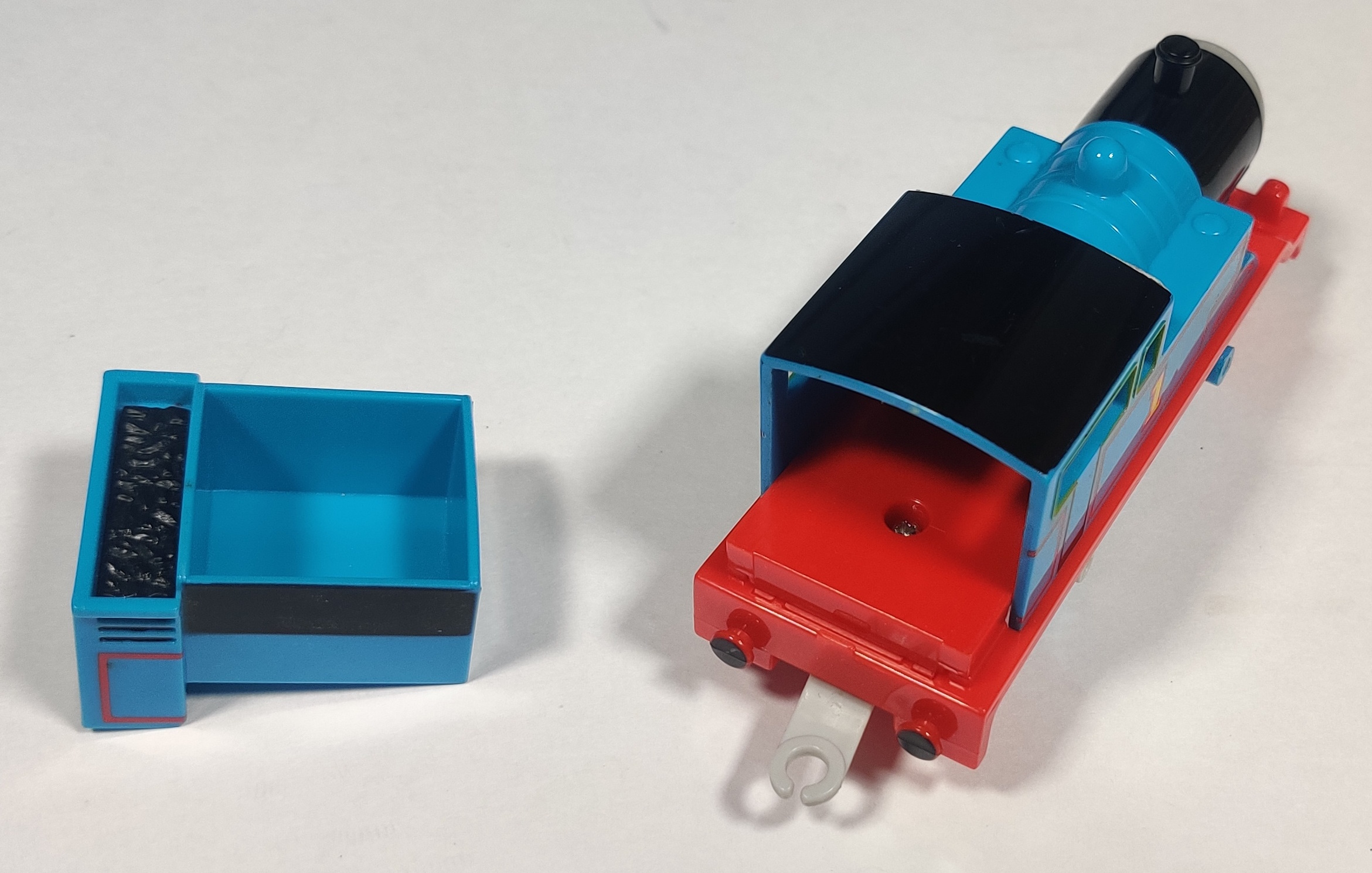
In 1998 Tomy's gachapon and candy toy subsidiary Yujin, later Takara Tomy A.R.T.S., who handle Capsule Plarail distribution, released a pullback Thomas with a removable cab to hold the included ramune candy.
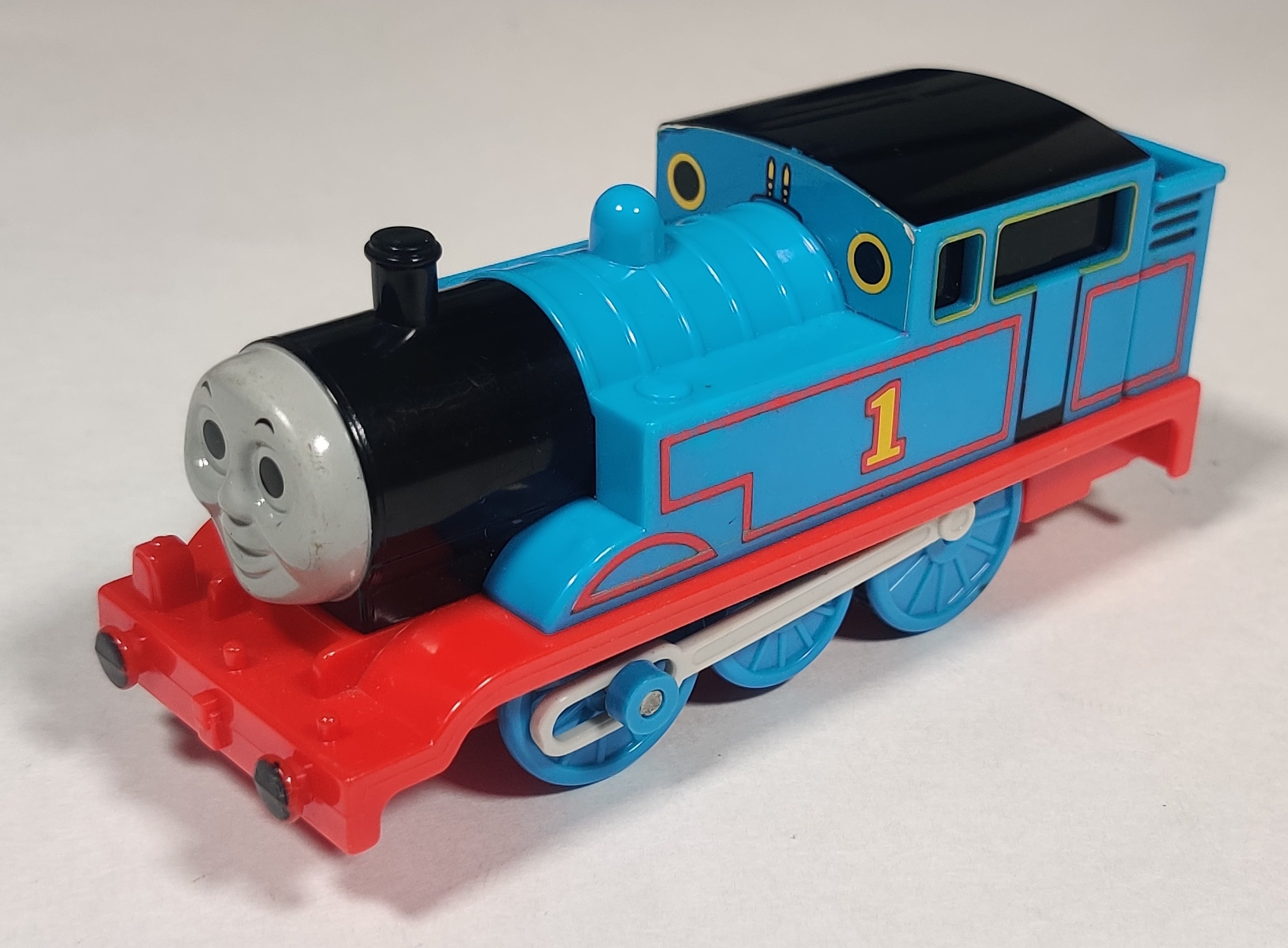
Thomas was sold individually and in a small set - the origins of a particular Thomas can be differentiated by whether he has a "slice of pie" taken out of the pupils (individual release) or full round eyes (Rail Set release). More details can be seen on the Yujin pullbacks page.
Thomas the Tank Engine (Six-wheel version) (1998/1999)
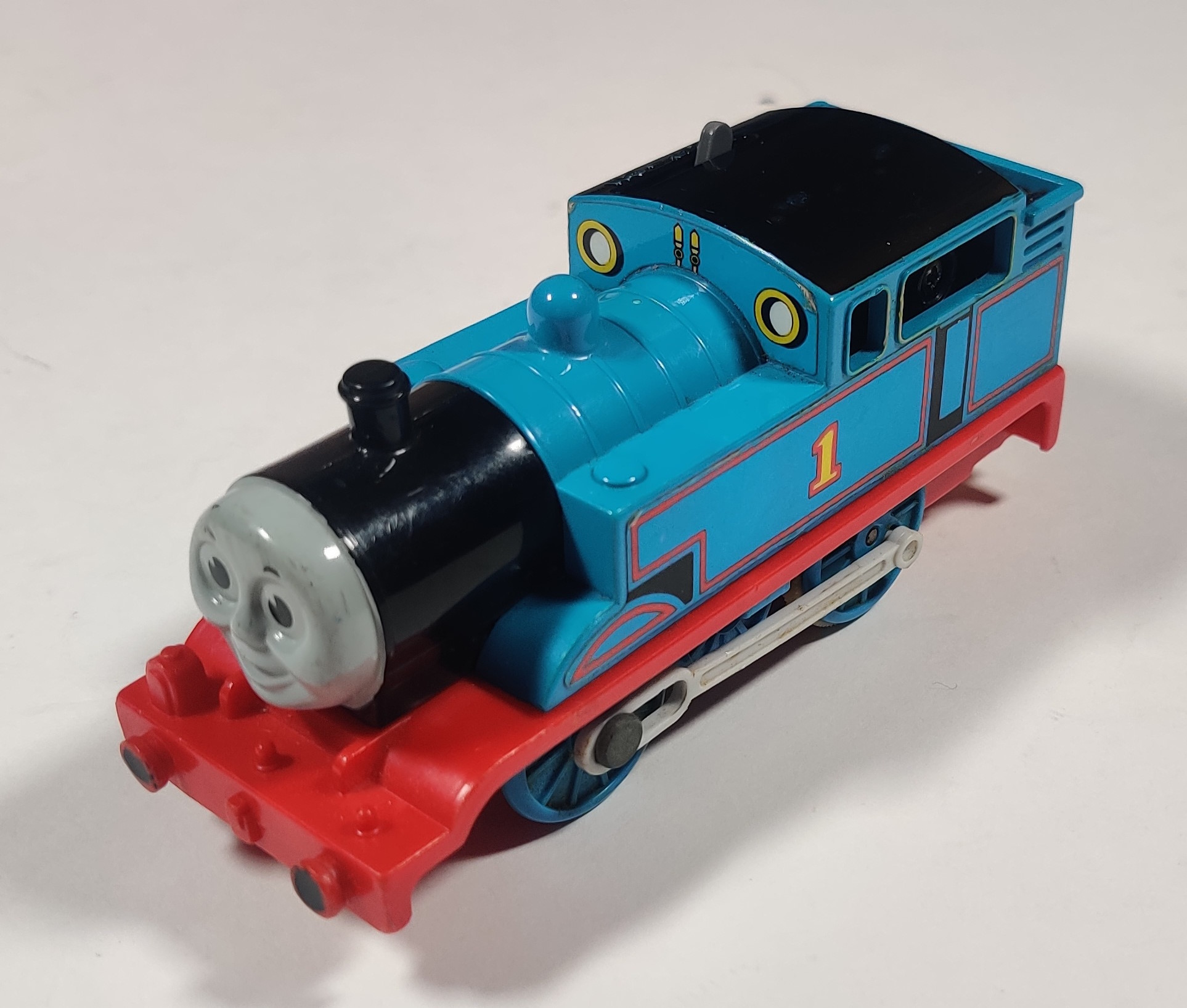
A new six-wheel version of the chassis that incorporates a dummy middle wheelset that is spring-loaded and must be rotated away from the chassis to open the battery compartment was released beginning in late 1998, first in the Thomas the Tank Engine and Harold Flying in the Sky Set.
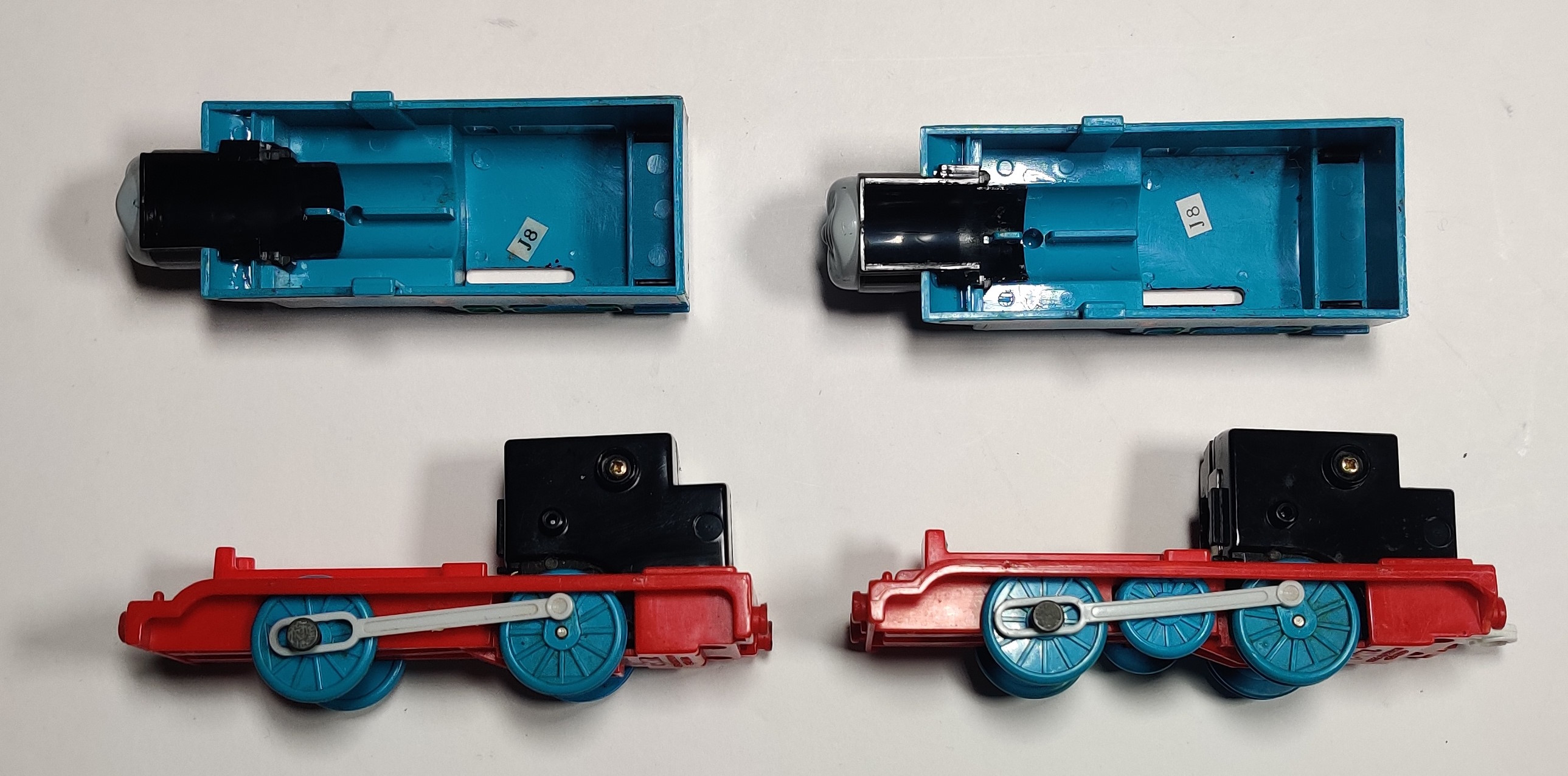
Throughout late 1998 both four and six wheel Thomases were produced. Early examples of the six wheel Thomas I own date to October and December of 1998.

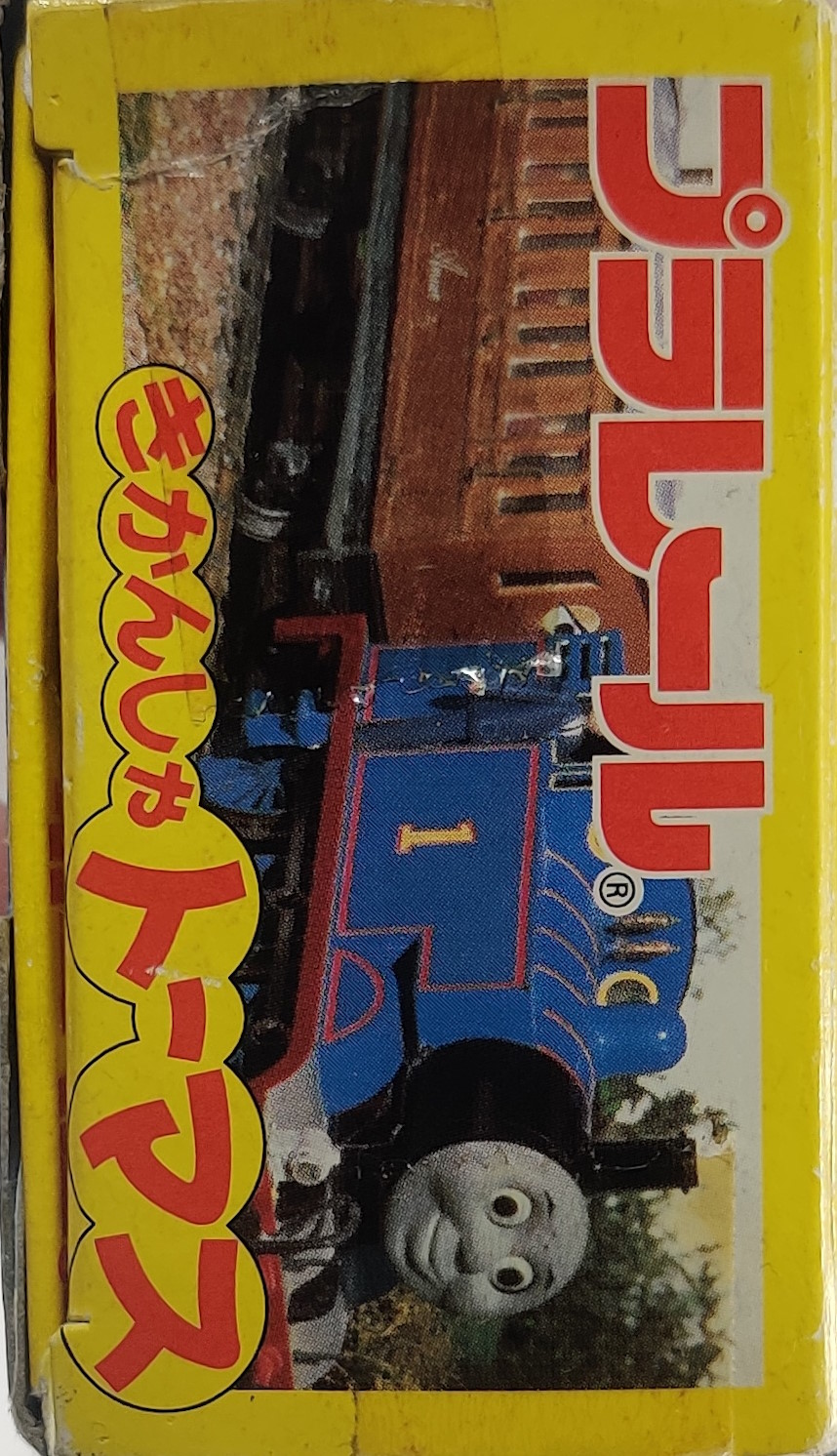

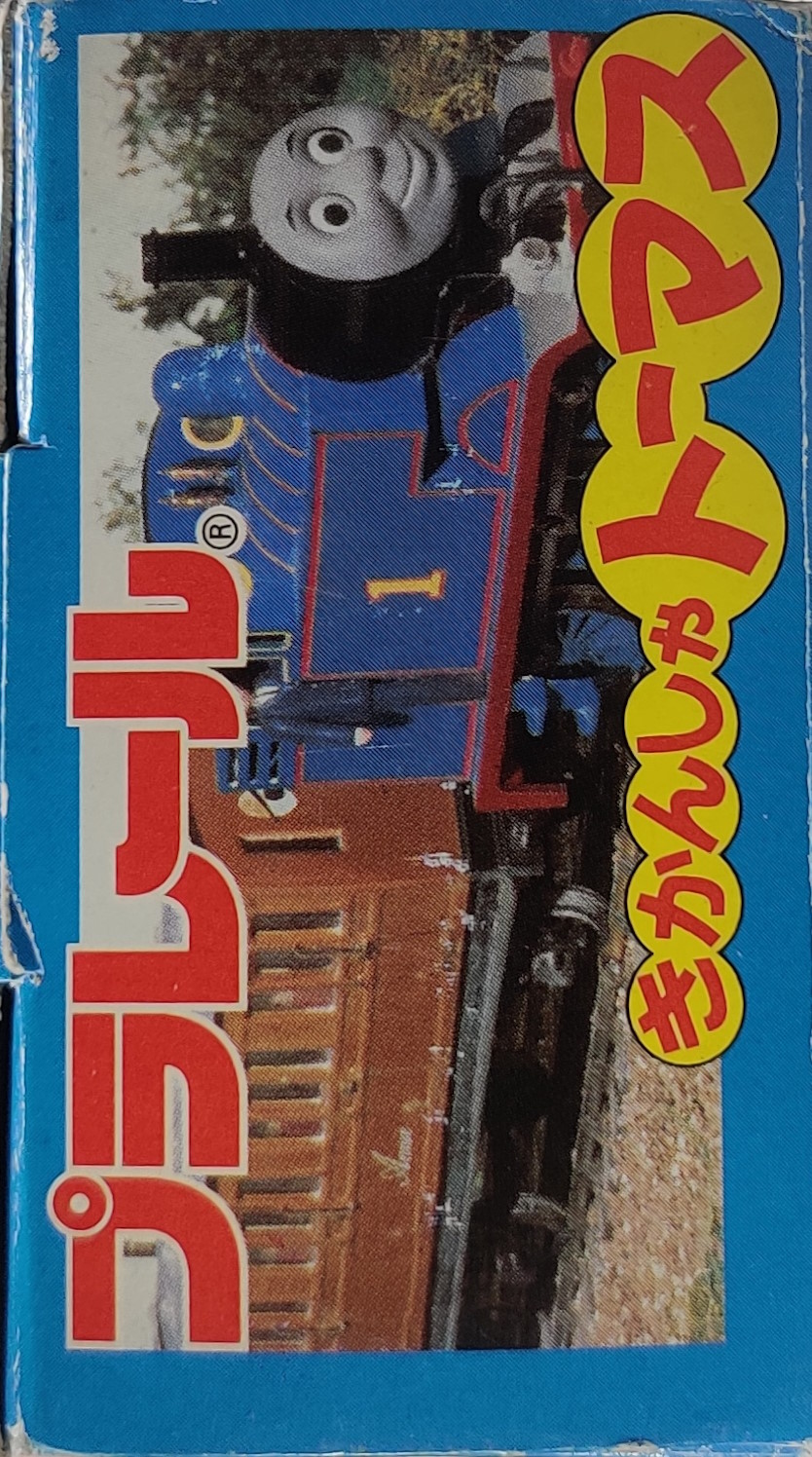


In 1999 the new six wheel Thomas replaced the older four-wheel Thomas in individual releases with a new box with a different still from the television show on the box. The picture on the back of the box was updated to show the new six-wheeled Thomas.

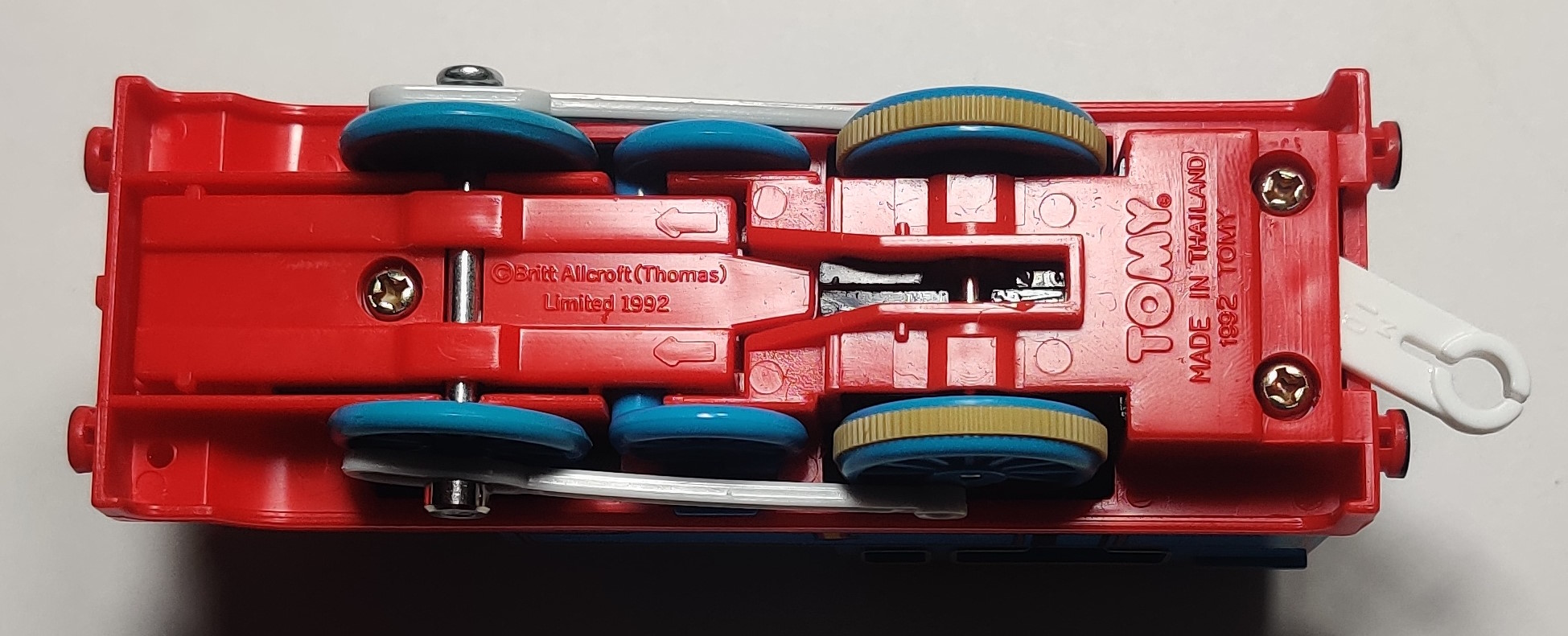
Six-wheel Thomases have a spring-loaded fake middle wheelset that makes it harder to remove the upper body shell from the chassis. Other than the changes necessary to implement the middle wheels, not much has changed from this and the previous releases.
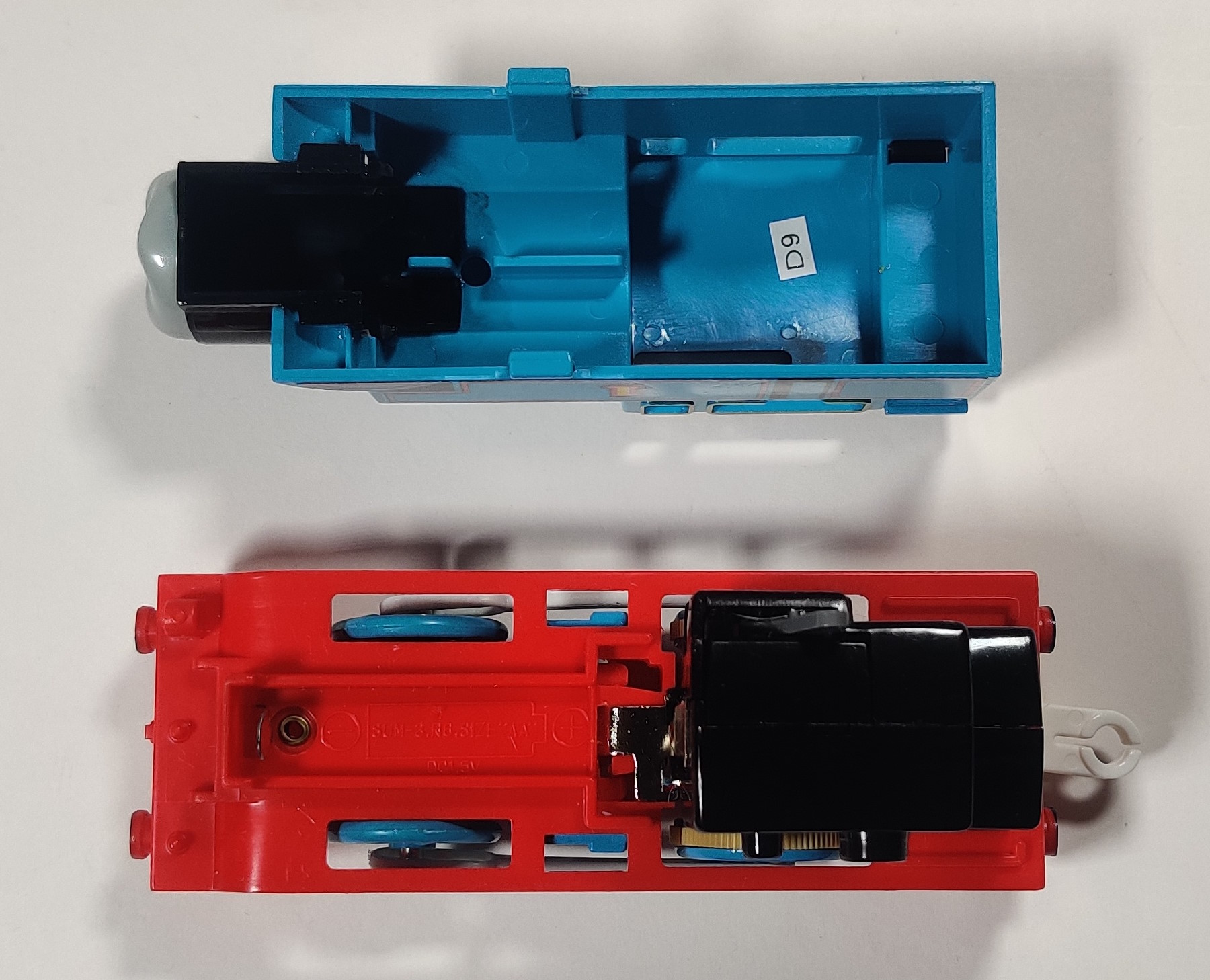
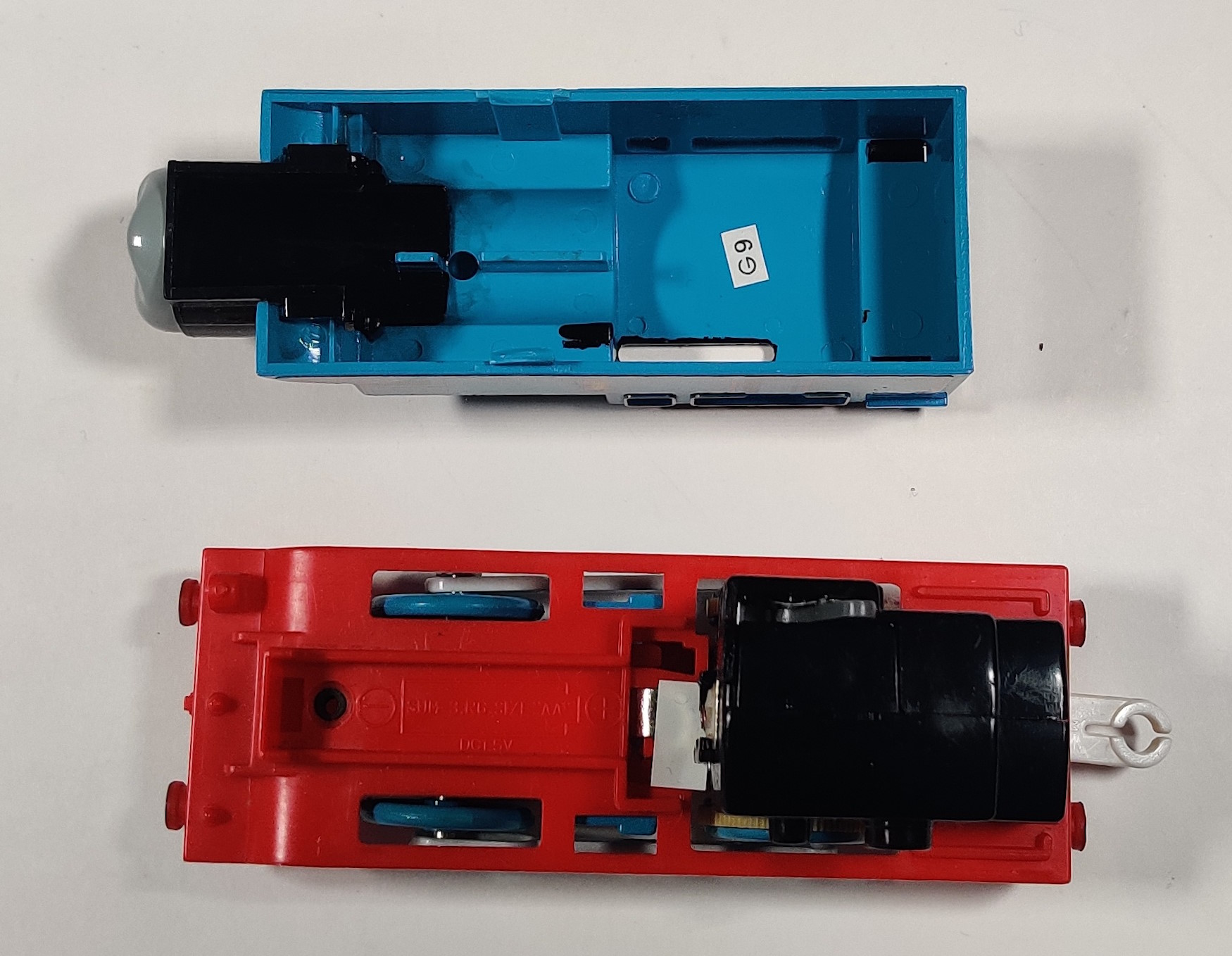
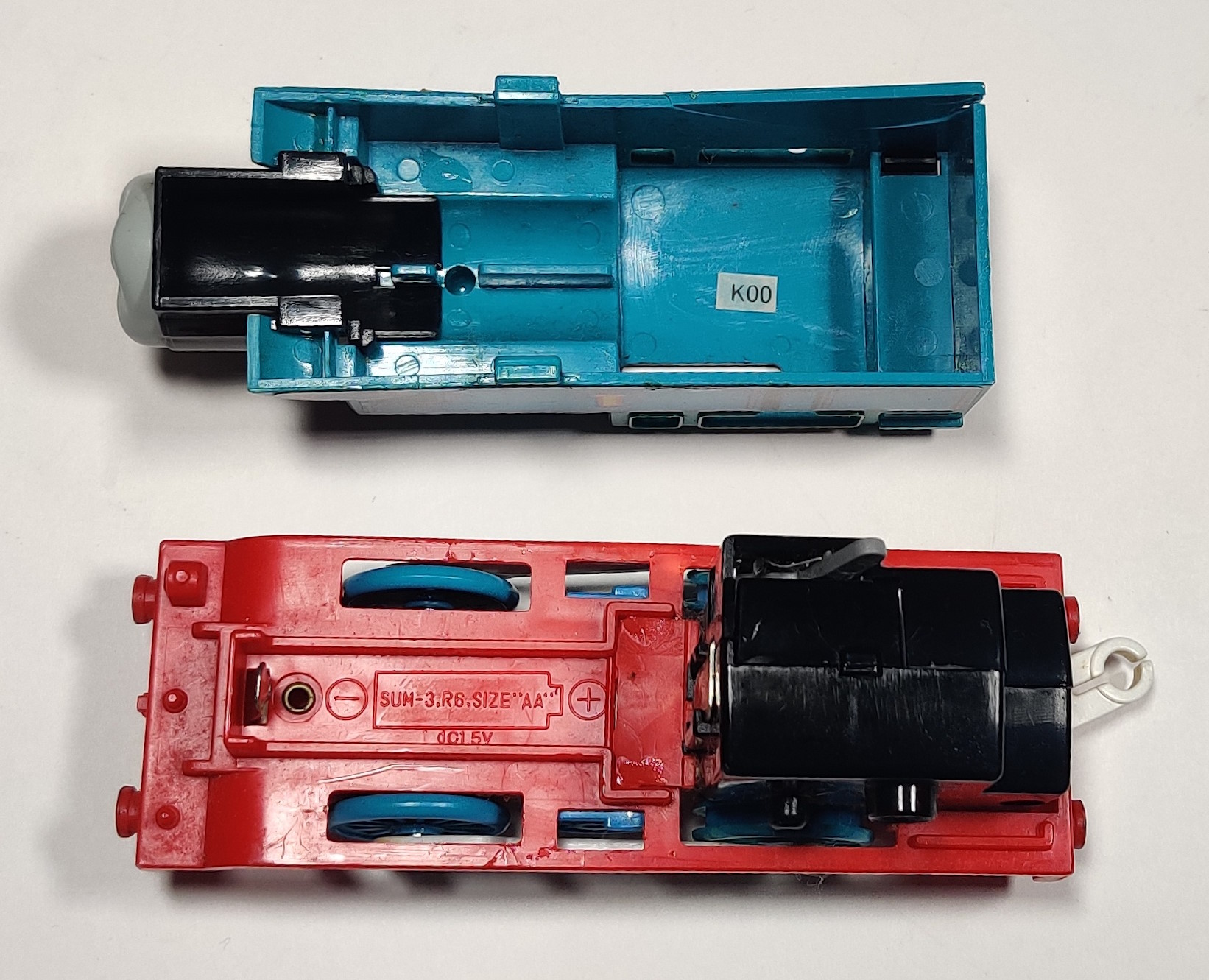
Circa 1999 a paper insert began being added over where the gearbox is inserted into the negative contact strip. In 2000 this was replaced by a glued-in strip of plastic. Later, the molding was changed to accommodate a screw to hold the cover in place instead.
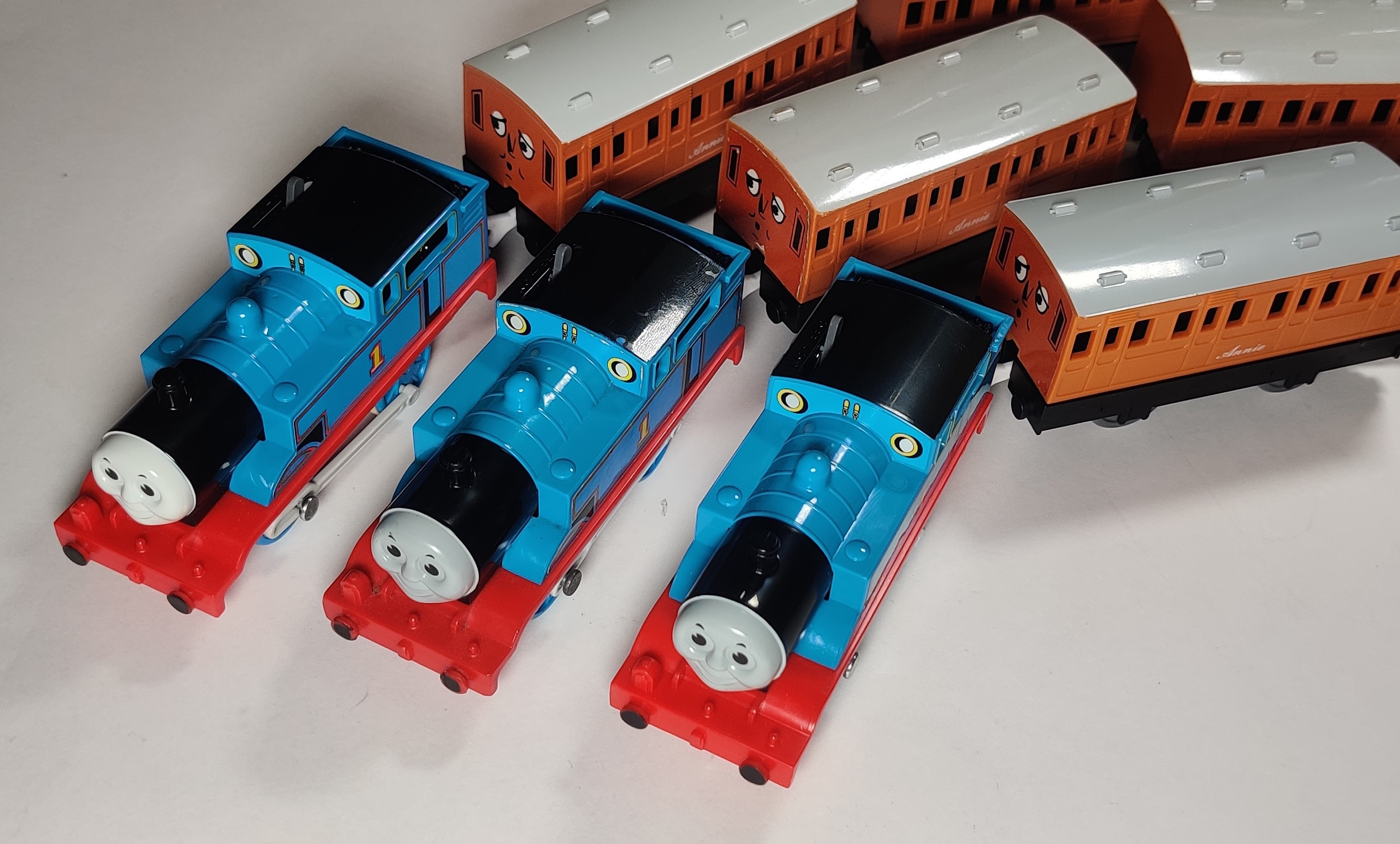
Here you can see the different in greys between a mid 1990s four wheel and later 1990s four and six wheel Thomas with their coaches. Gearboxes remained the larger type used until the early 2000s. This version of Thomas also began being exported for Tomica World in 1999.


As this version of Thomas remained on sale and the exported Tomica World sets began to gain traction, the screw holding Annie and Clarabel together was replaced by a screw with a more standard head and a small plastic retaining ring that acts like a washer similar to the older, larger screw head.
Talking Thomas (2000)
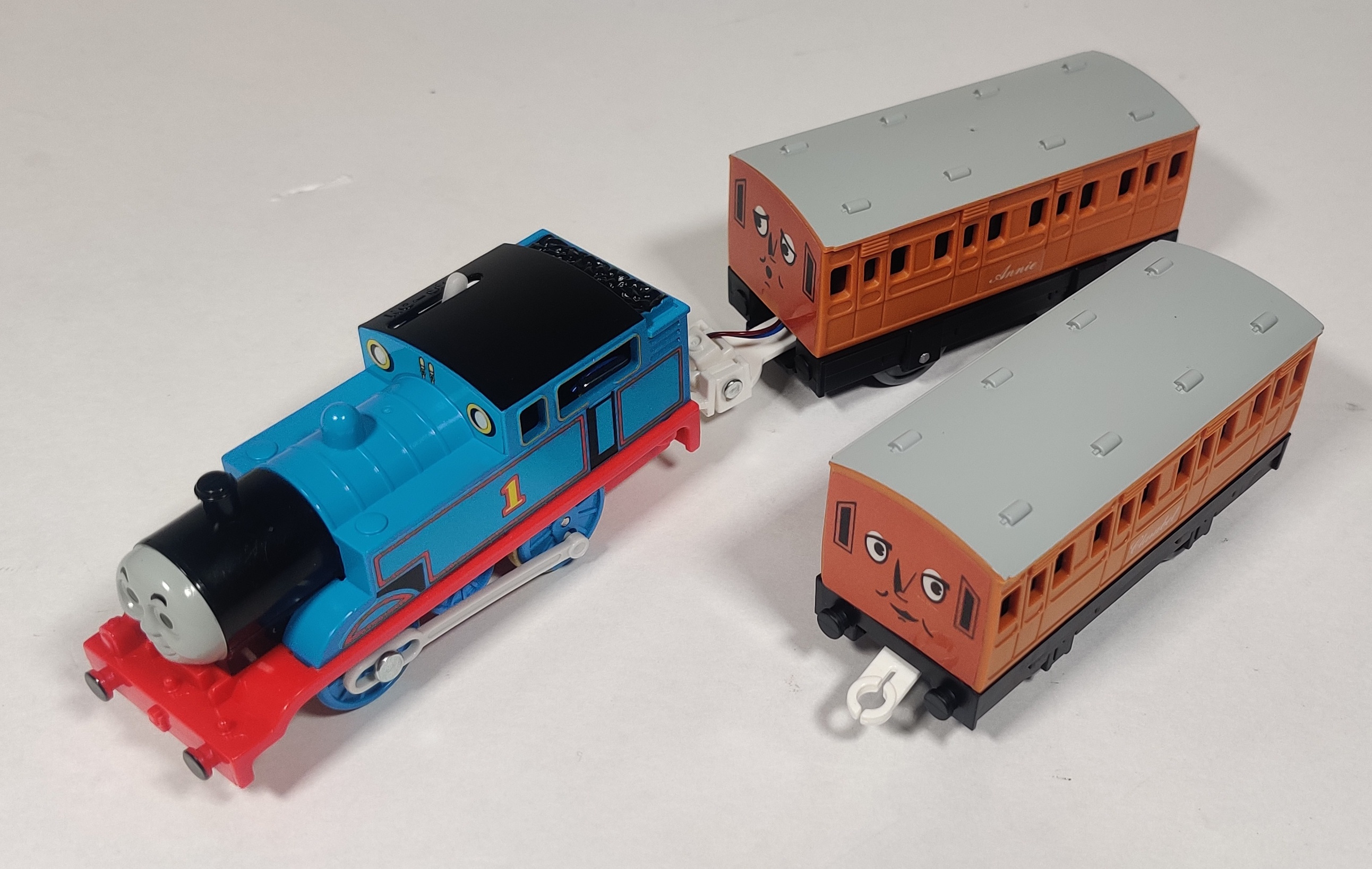
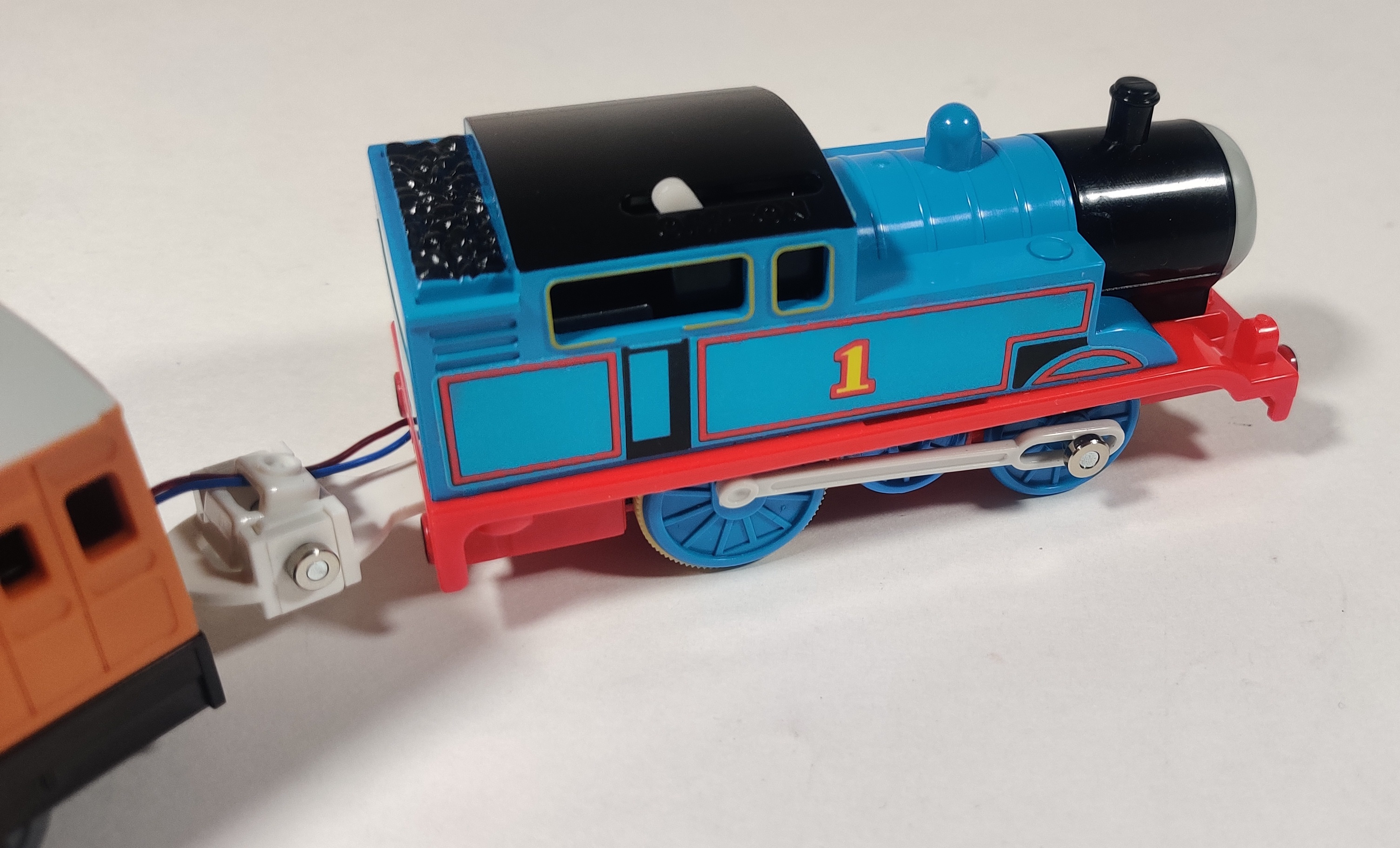
Releasing first in two sets beginning in March 2000 and later individually on October 19th, the Japanese Talking Thomas (おしゃべりトーマス) features an attached Annie and standard Clarabel coach and was part of the first range of talking Plarail Thomas trains. Special green tracks trigger Thomas to speed up, stop at a station, and/or say one of several phrases. It was exported with both American and British English accents beginning in 2001 as part of the Talk 'n Action series.
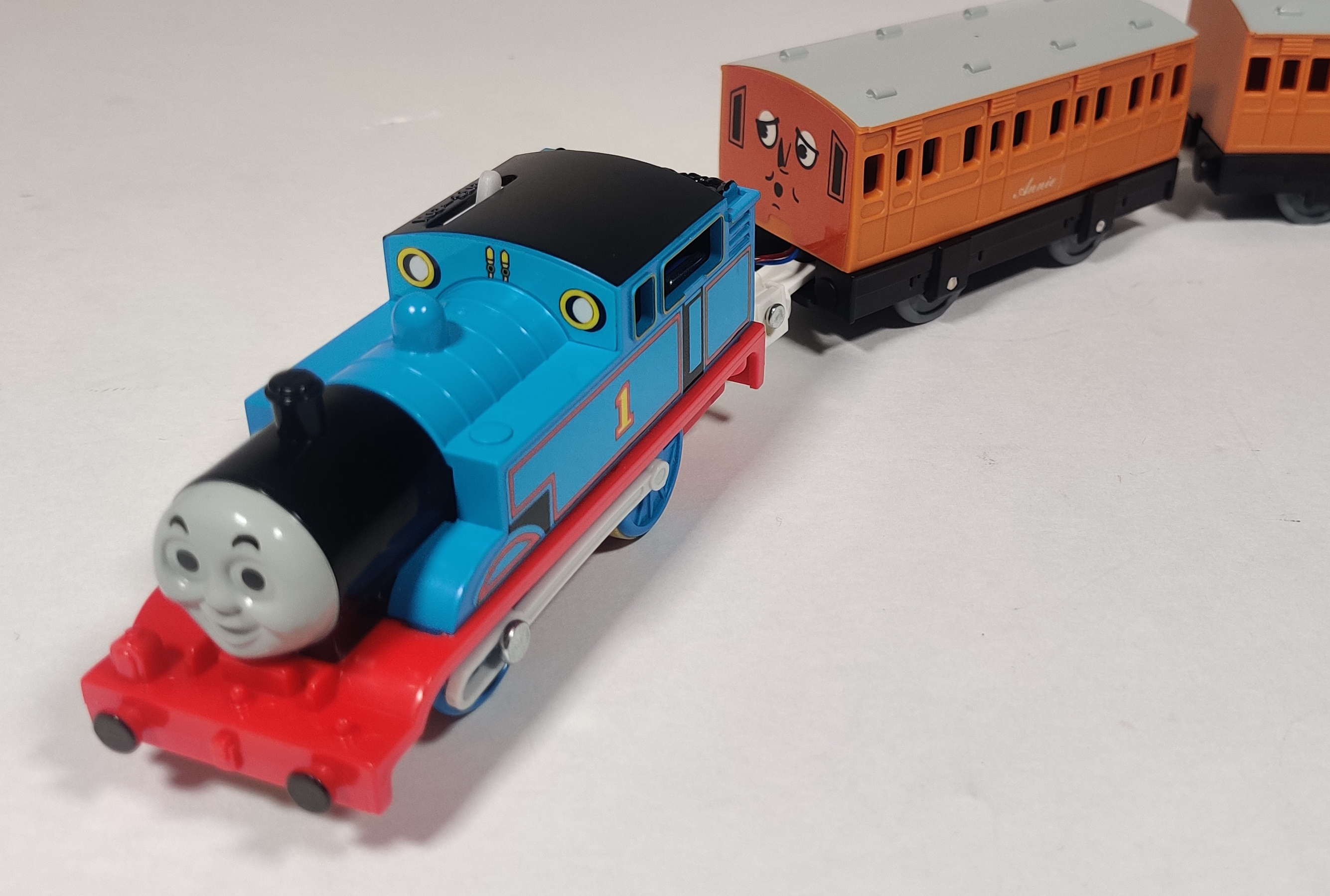
These Thomases have a slightly different face with full round pupils as well as different eyebrows.
Transitional Thomases (Set production) (early 2000s)
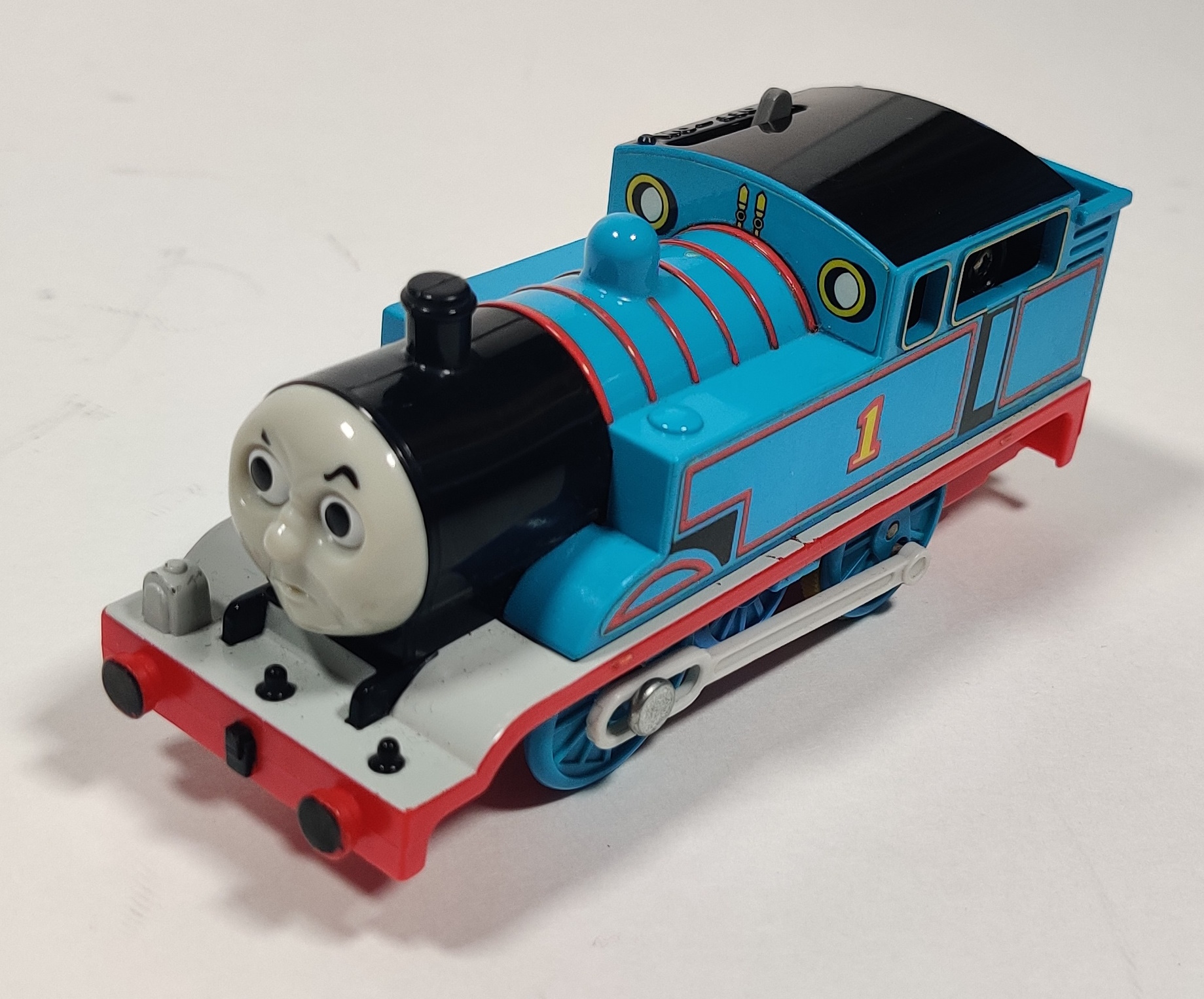
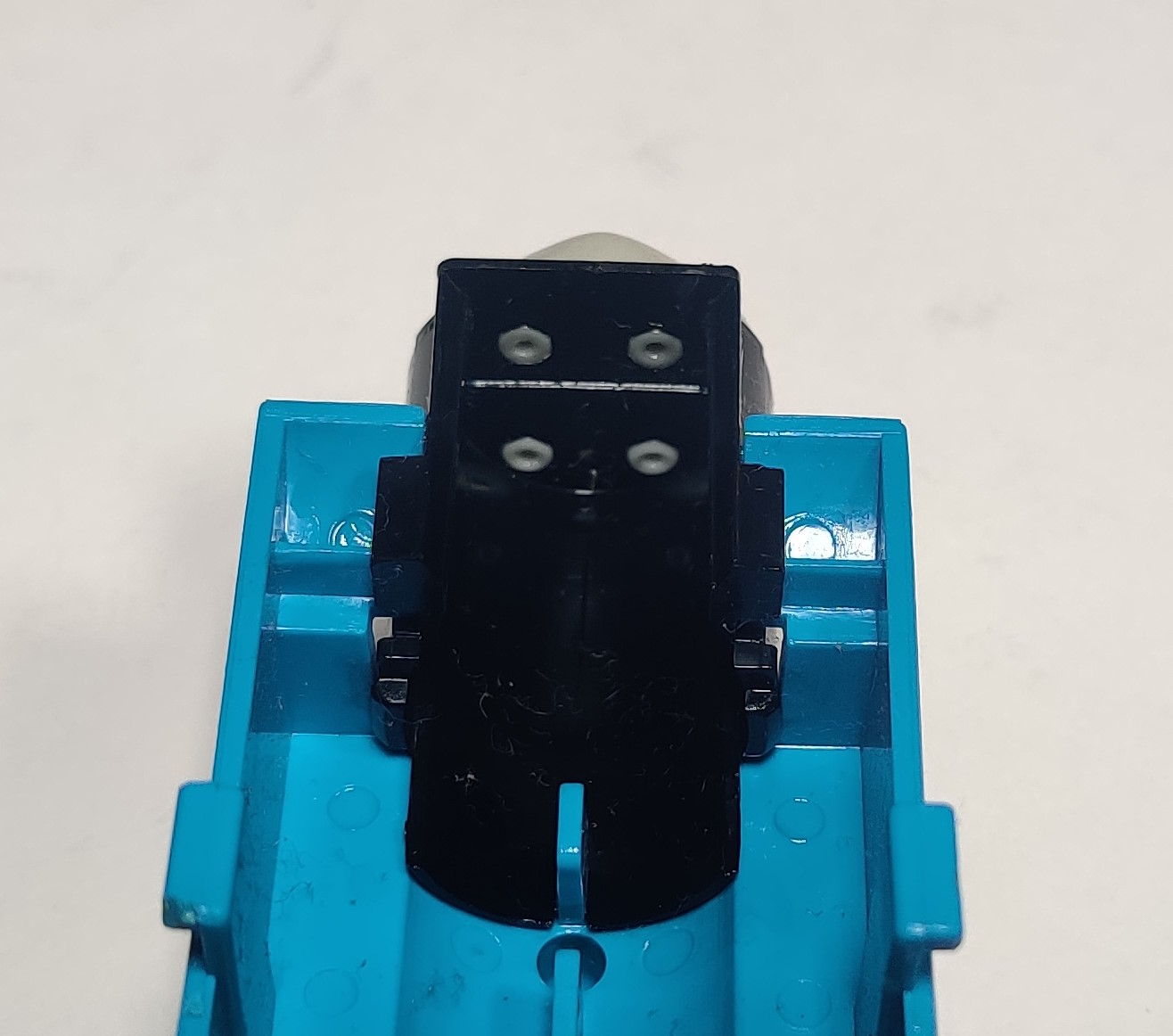
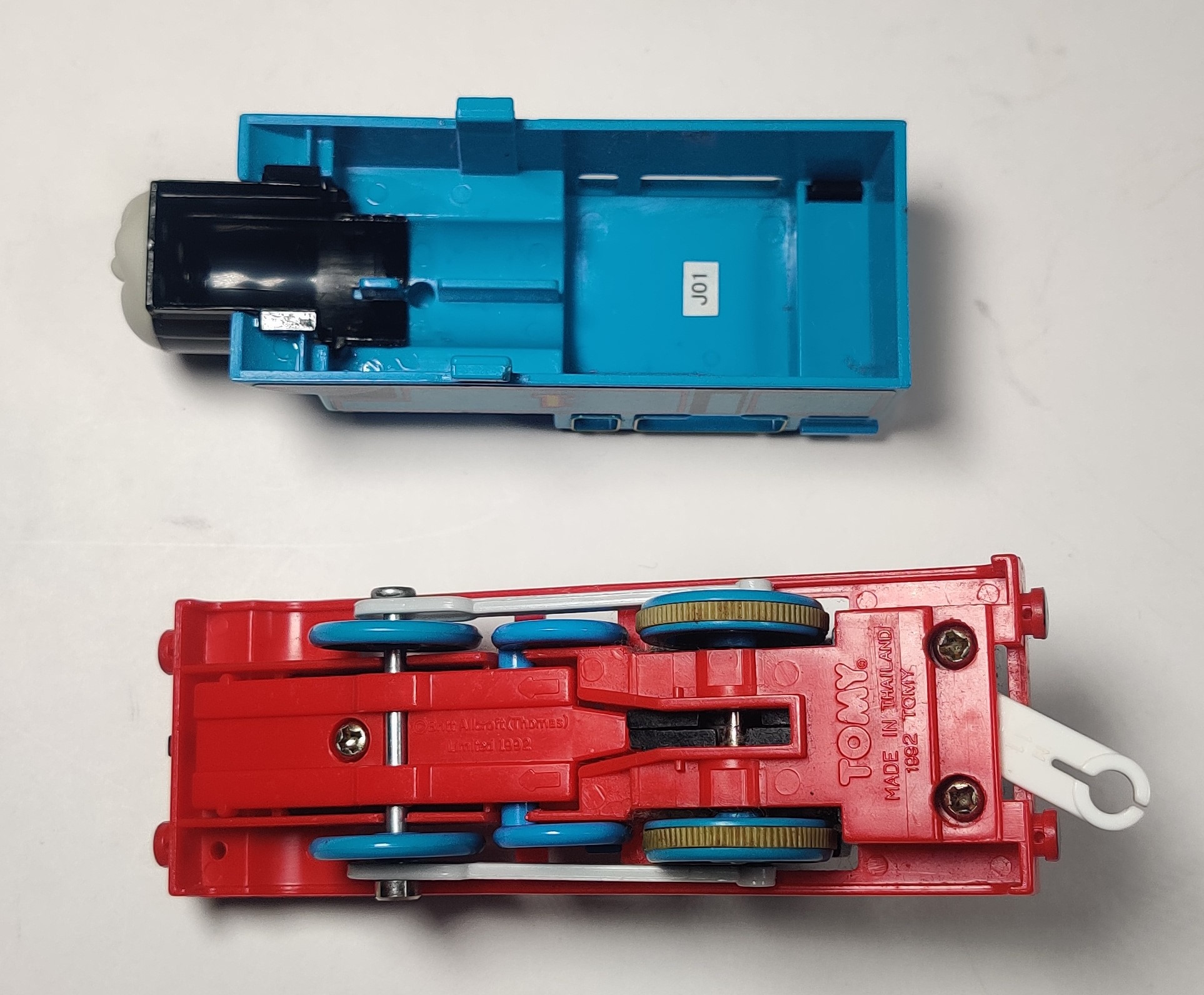
In early 2001 the 1998 six wheel chassis was painted white on top and a new smokebox molding with separately fitted face was used for the annoyed Thomas in early copies of the Thomas and Busy Freight Cars Set like this October 2001 production example.
Later copies of the set used the updated 2002 chassis. This was the first face variation of the "standard" Thomas, with several other expression and eye variations in the 2000s and 2010s.
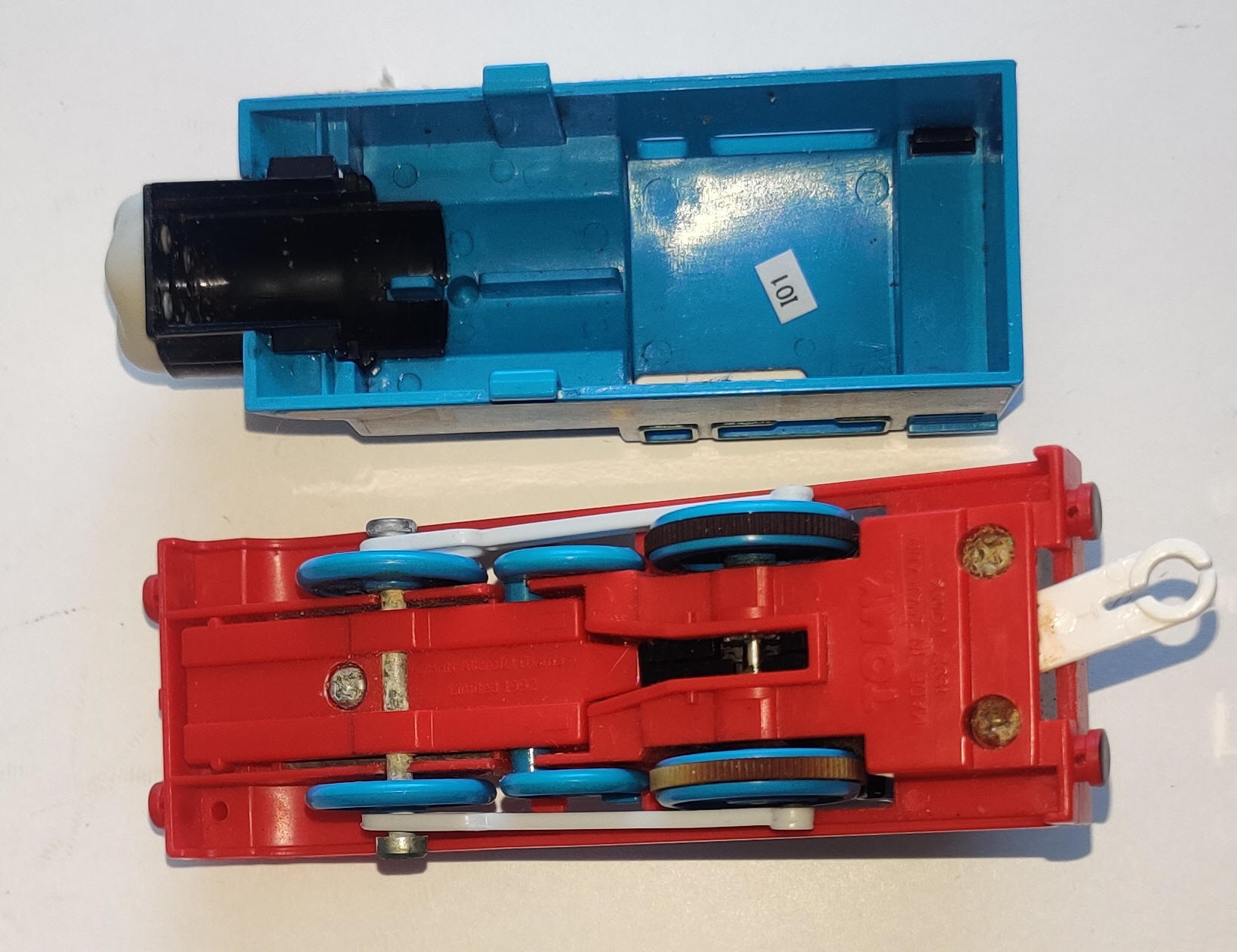
As a result of this production change to separate faces, some other Thomases produced during later 2001 like this export Thomas from a 2001 European Thomas Adventure Set have separate plastic faces and old logo chassis. Early examples of the Japanese Thomas the Tank Engine Go Out 3D Bag Complete Edition also contain old-logo plastic face Thomases.
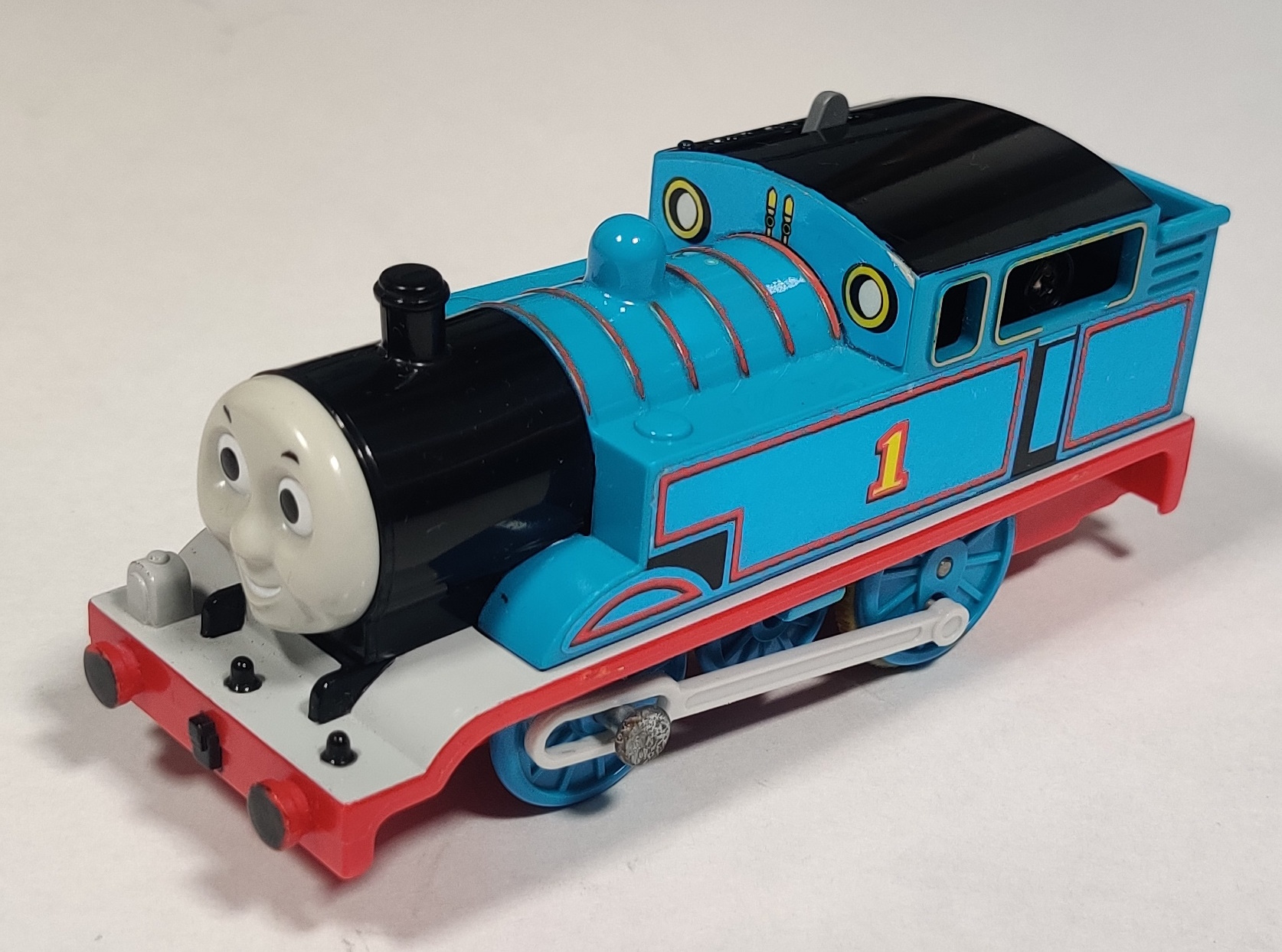
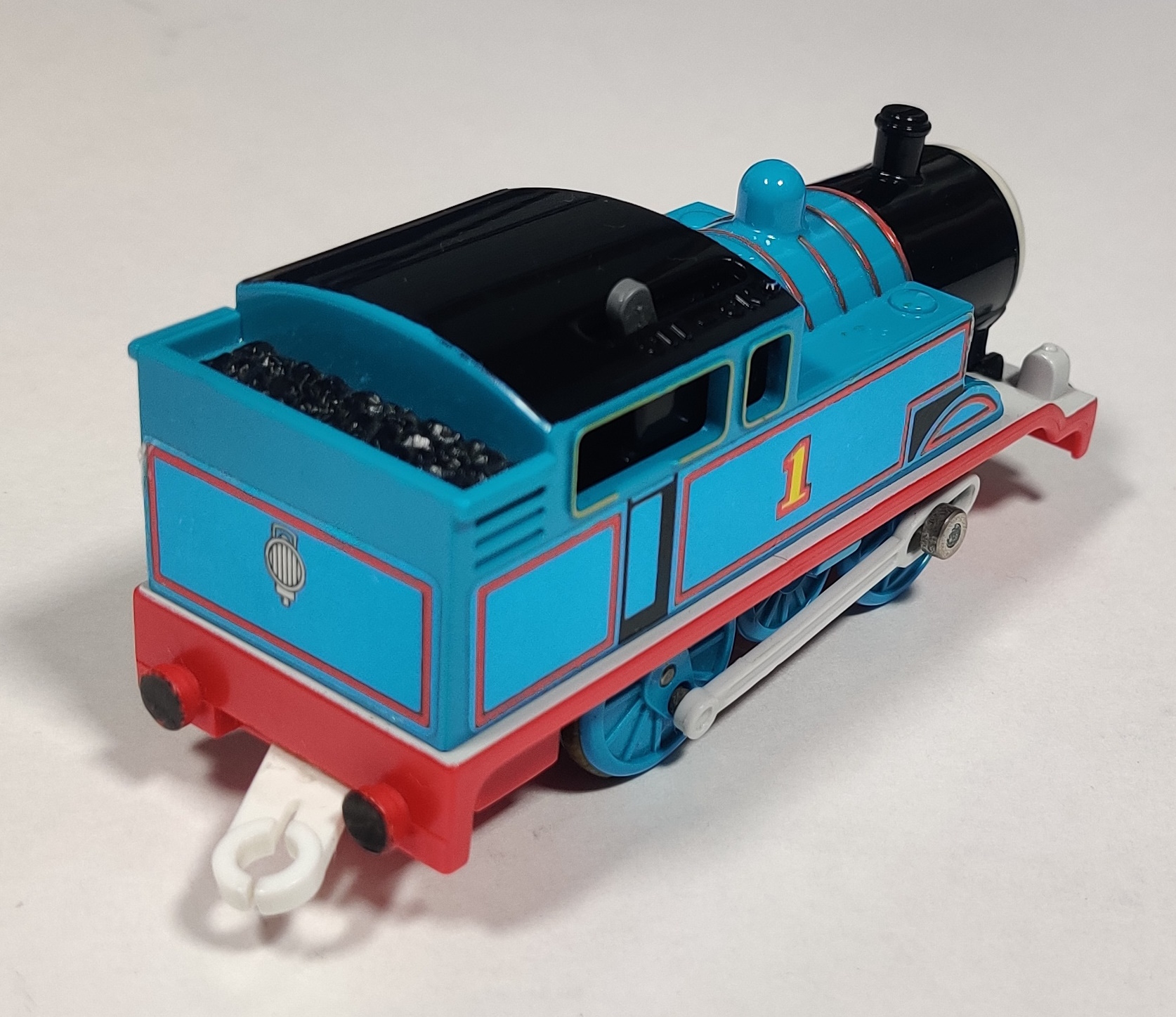
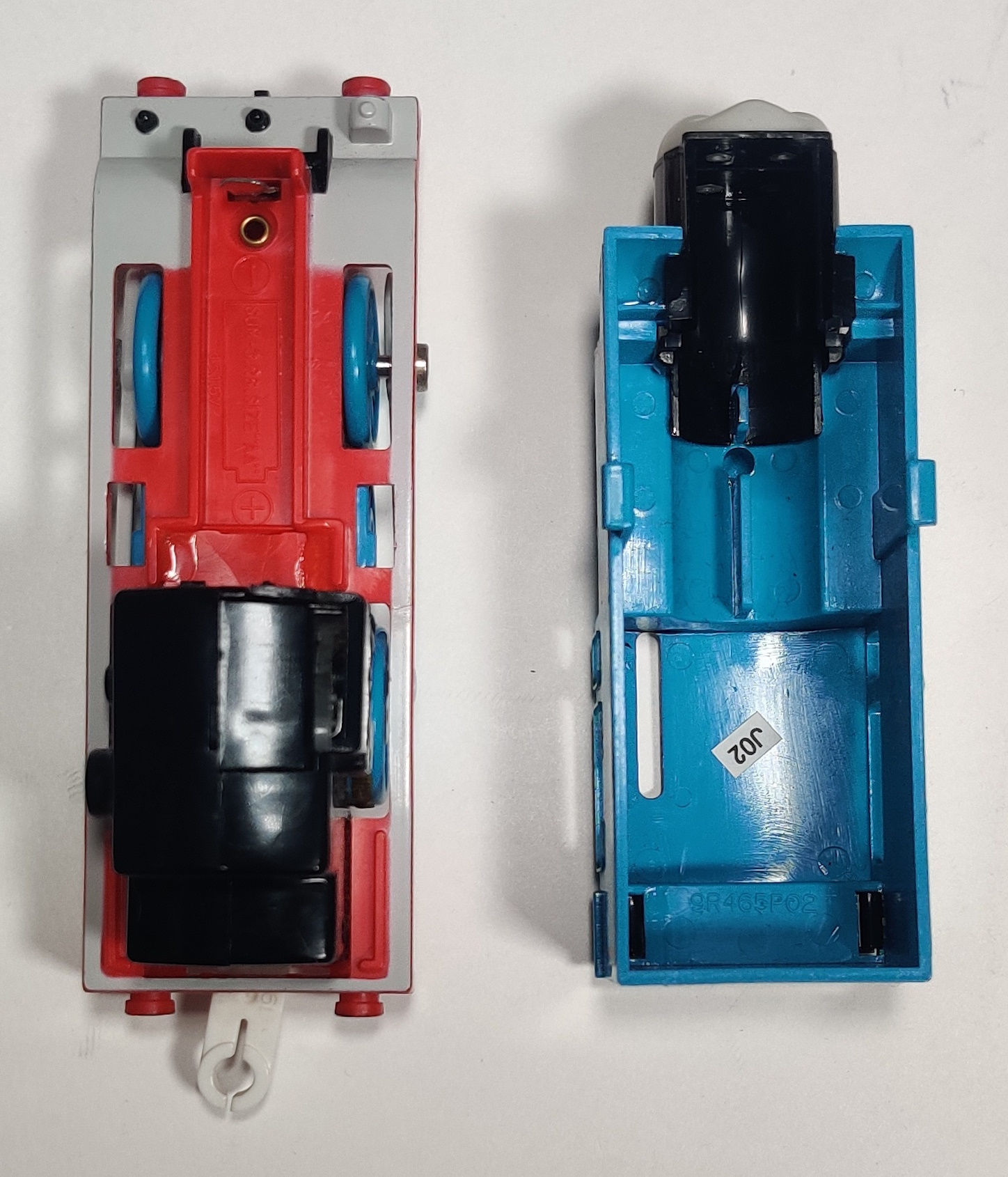
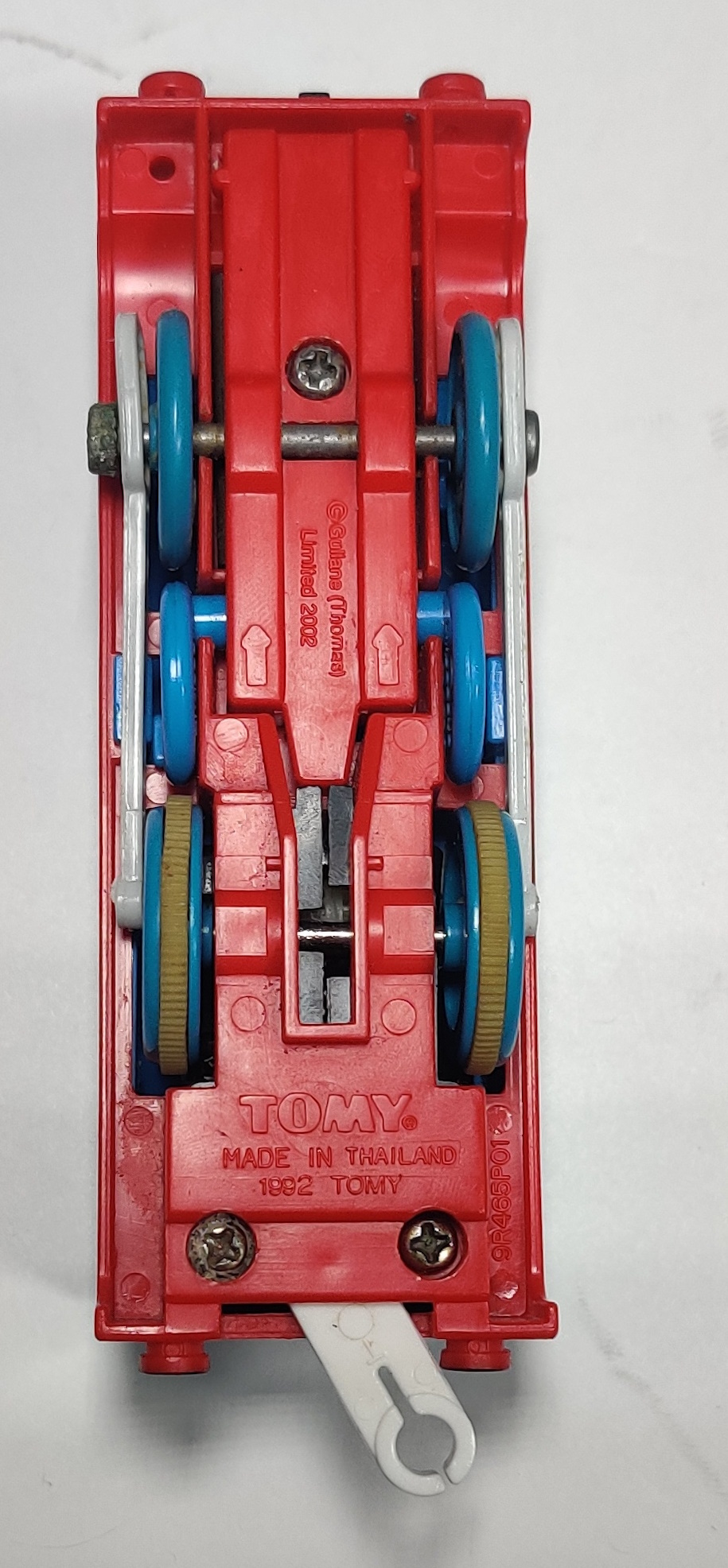
In 2002 the six-wheel chassis was updated with the new Tomy logo and new licensing information. This chassis was used in the Thomas the Tank Engine First Plarail Set and was painted up nicely for the Thomas and Terence Loading and Unloading Set with what would become the standard Thomas face going forward. Notably, this version still uses stickers for Thomas' side details.
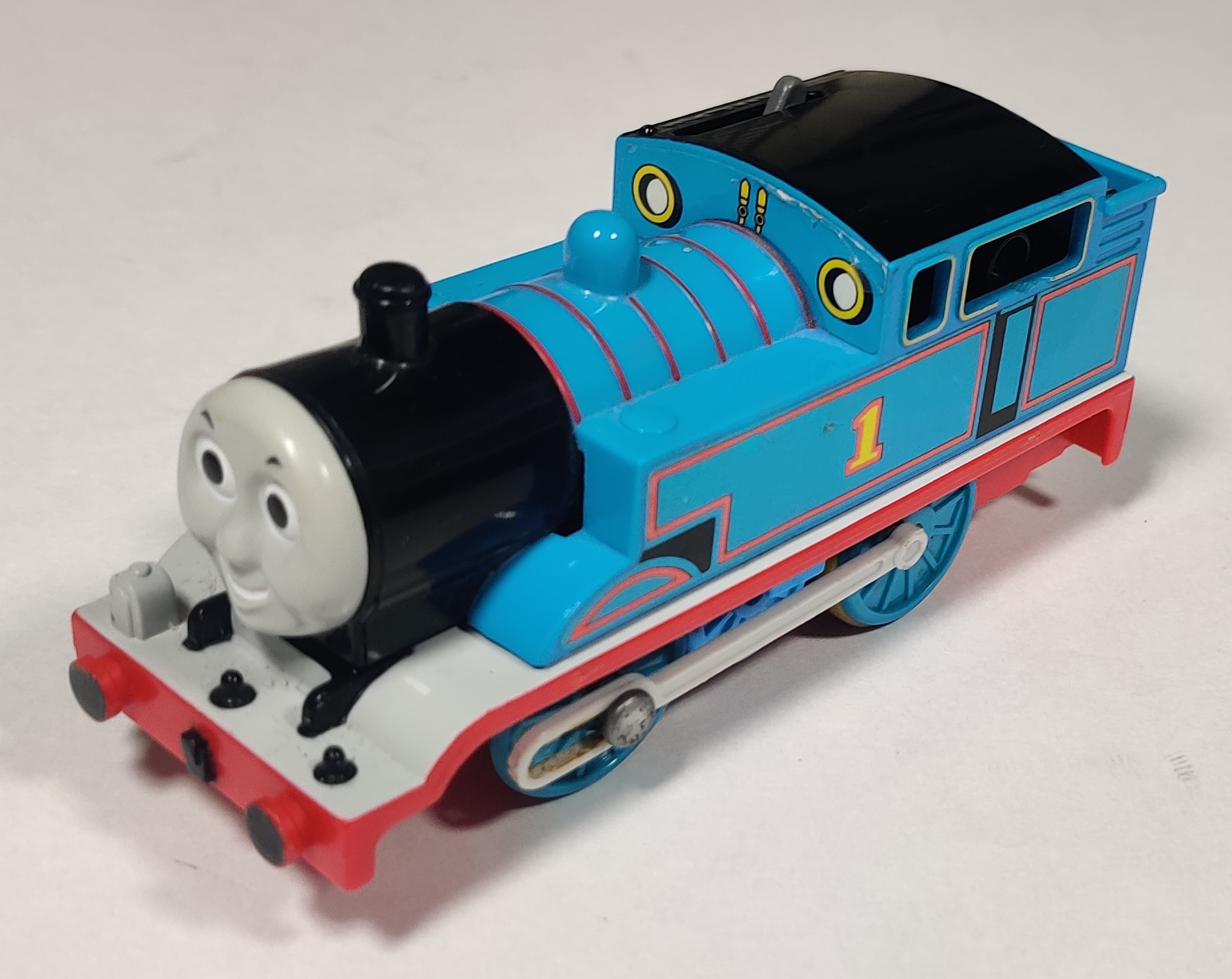

Early examples fall prey to yellowing plastic, but the Terence set version stayed in production alongside the later painted side version and was exported in the international versions of the set as well into the mid 2000s when the plastic mix was changed.
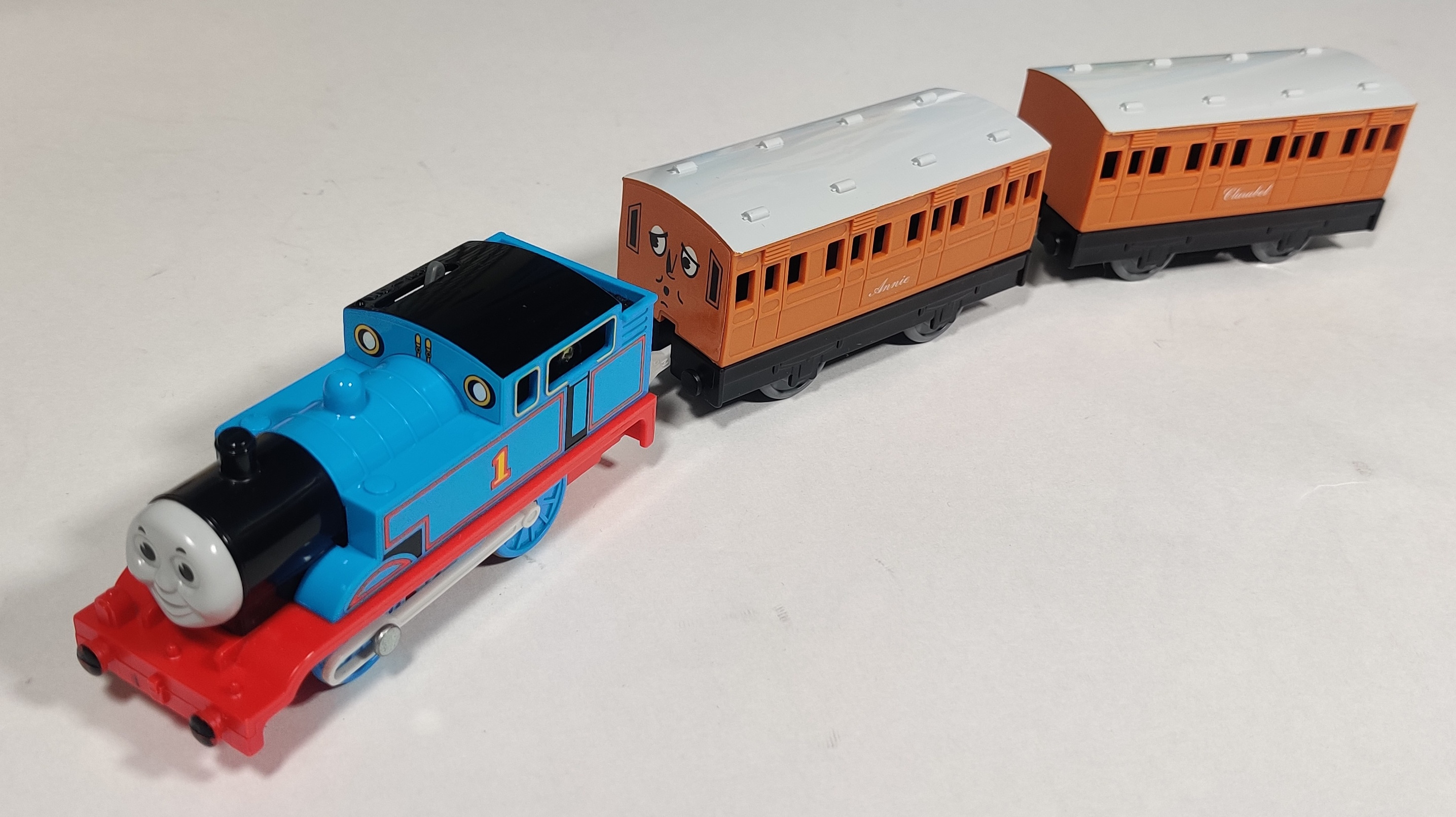
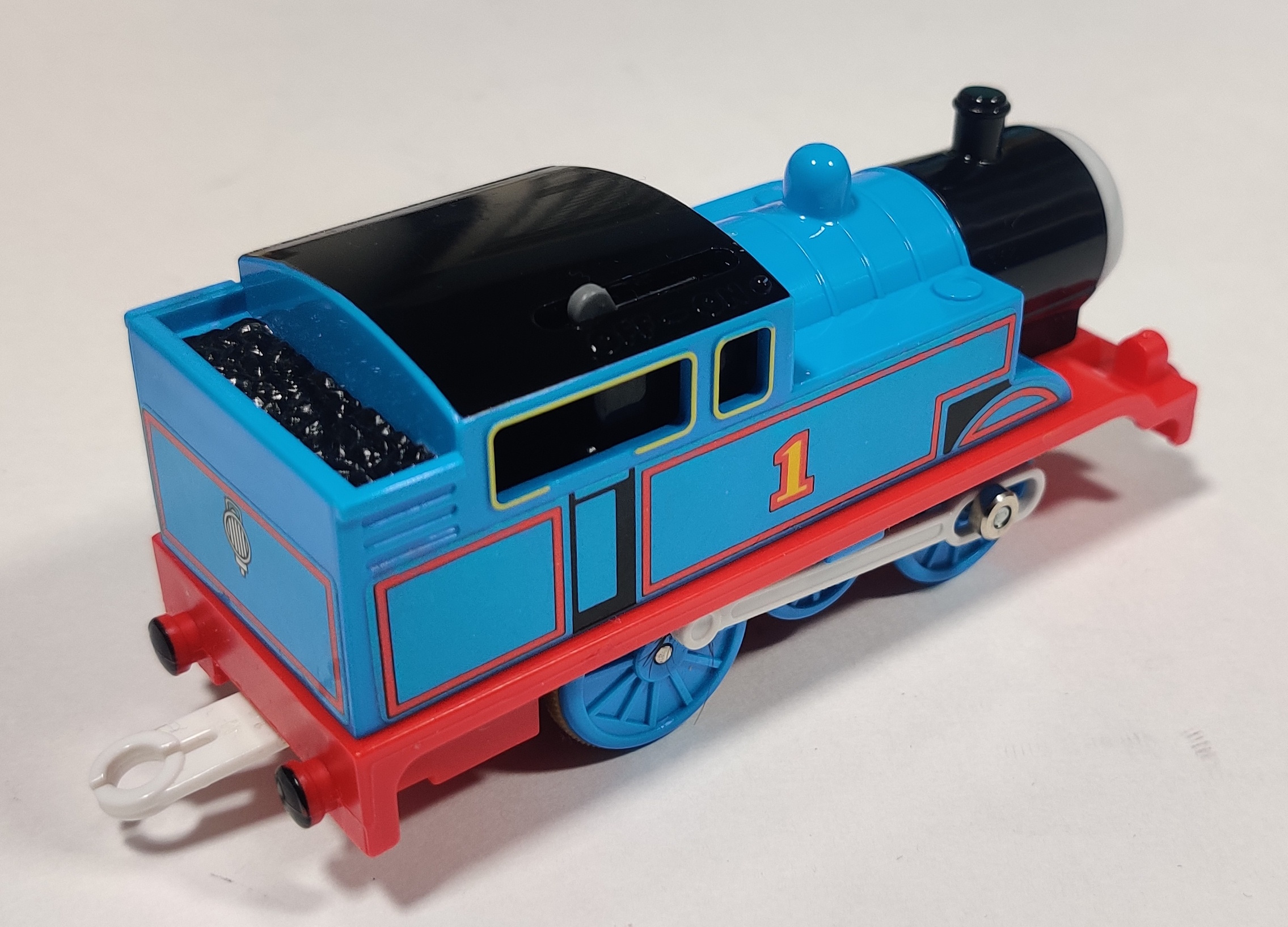
The 2002 First Plarail Set and later copies of the Go Out 3D Bag Complete Edition as well as the 2004 rerelease of the 1999 Freight Cars Set were the only Japanese sets to use the "export" style Thomas with separate face and no white running board or other updated details other than the new licensing text and logo.
T-1 Thomas the Tank Engine (Updated rerelease) (2003)
In 2003 the Thomas Plarail range was revamped and the main cast of characters received new boxes and updated detailing.
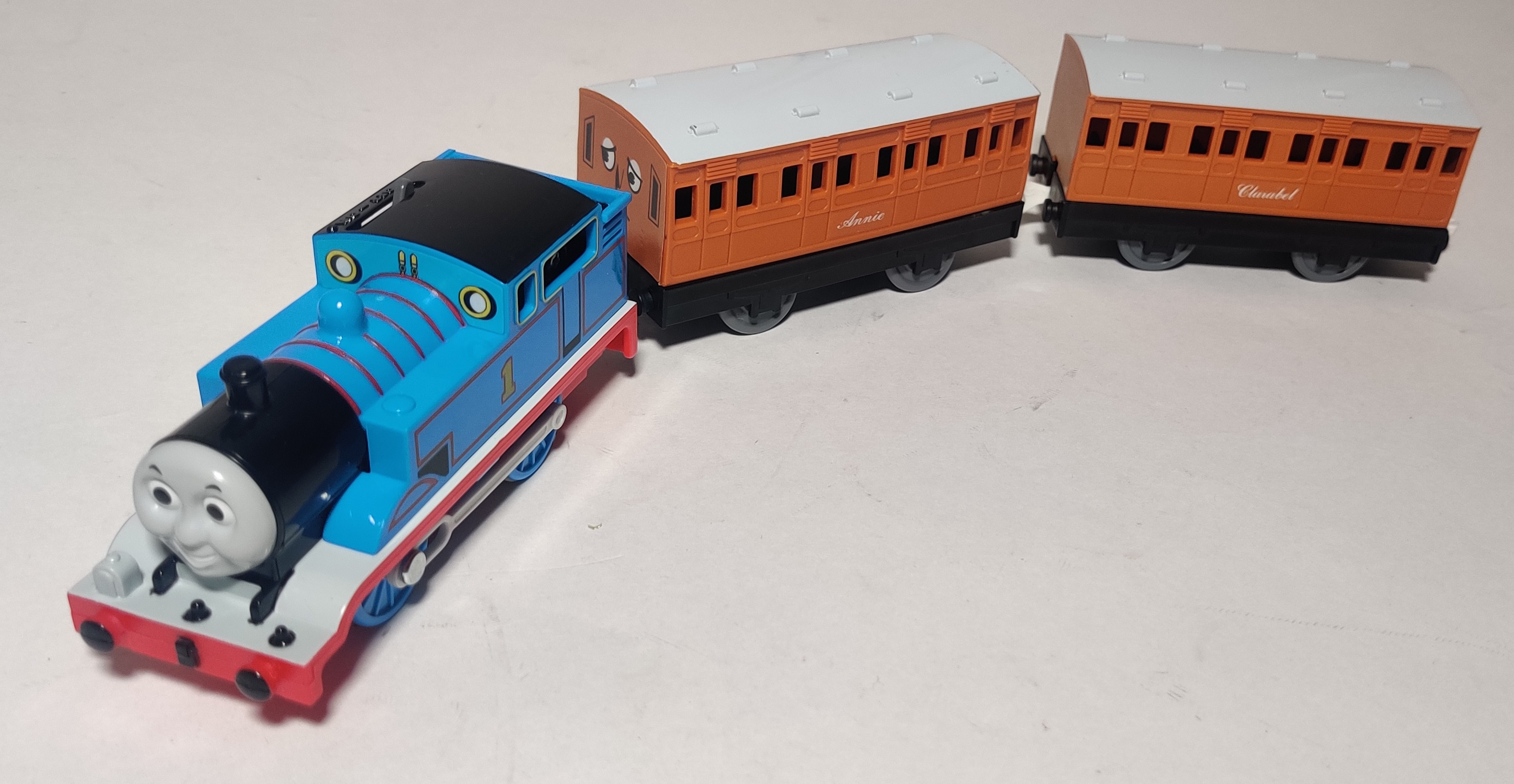
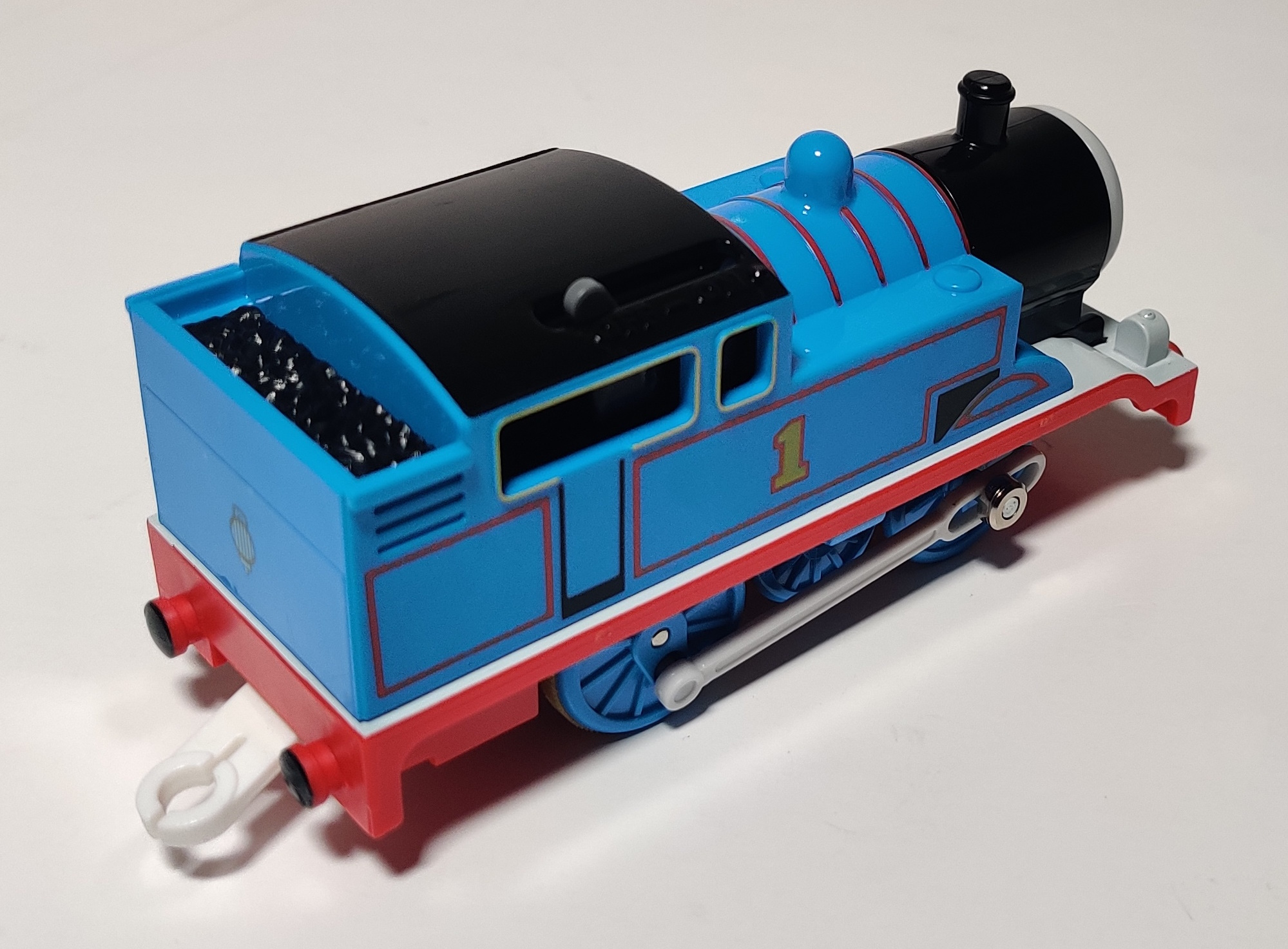
Thomas' separately-fitted face has been updated with painted eyes and mouth details. Running boards were painted in white like in the few early 2000s sets mentioned above and the sticker side details were replaced with printed graphics. The whistle and front cab window sticker remained in use, as well as a large rear sticker that once included Thomas' rear lining but now only holds his lamp. Later on, this sticker was made much smaller (just big enough for the lamp) - this, along with more refined black paint application around the lamp irons, are some ways to identify earlier versus later 2000s Thomases.
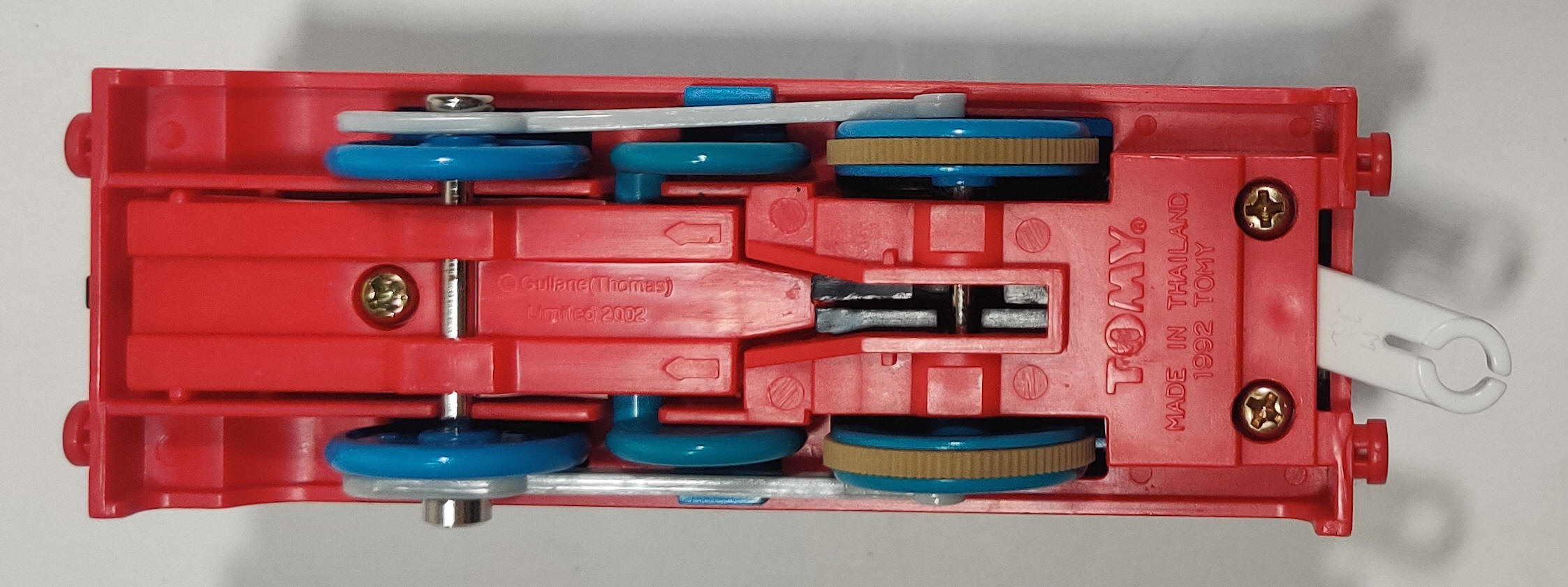
The tooling used for Thomas's chassis has rounded marks near the buffers and does not have a hole going up into the front lamp like previous variations. This hole reappeared in the tooling around 2005.
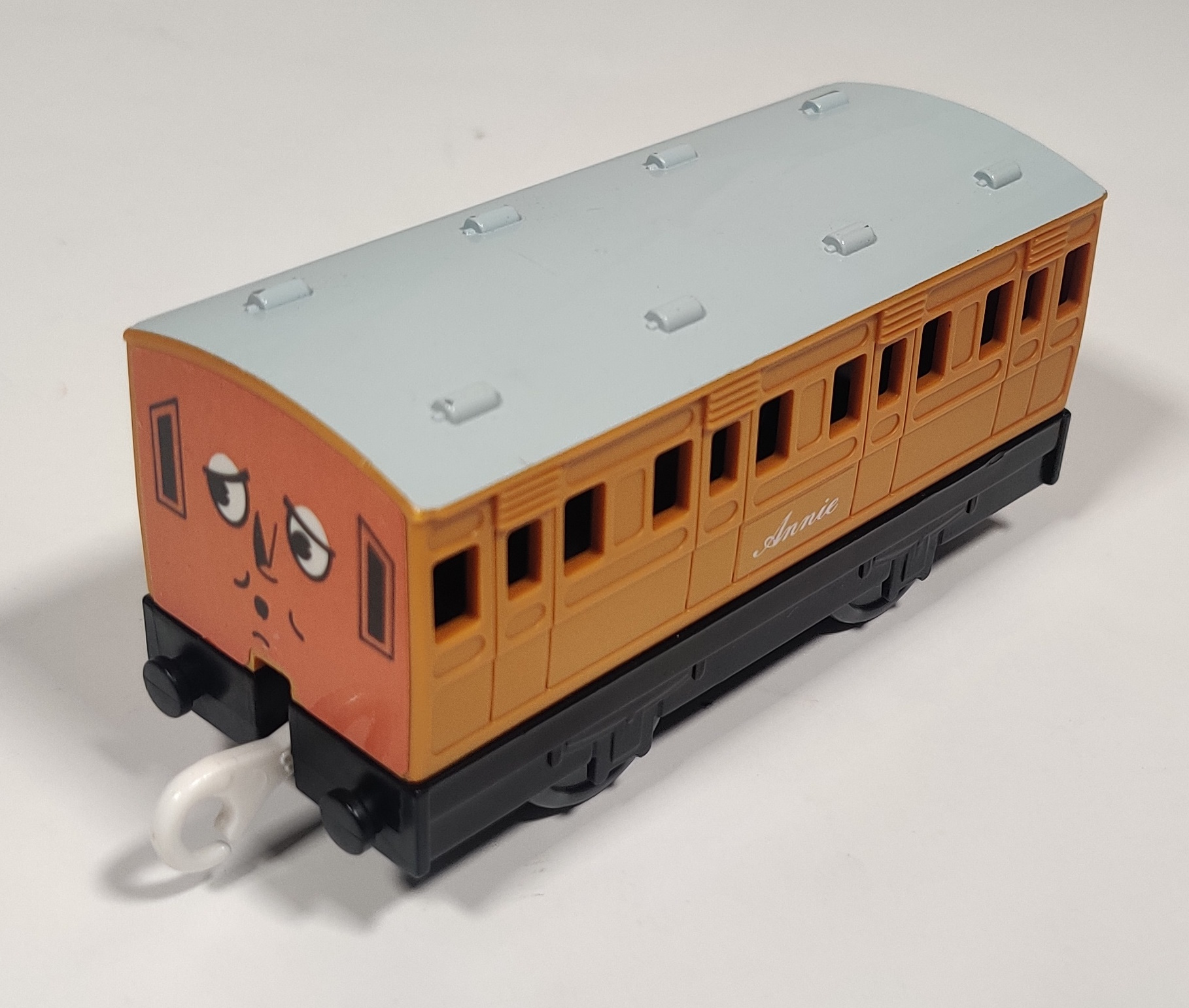
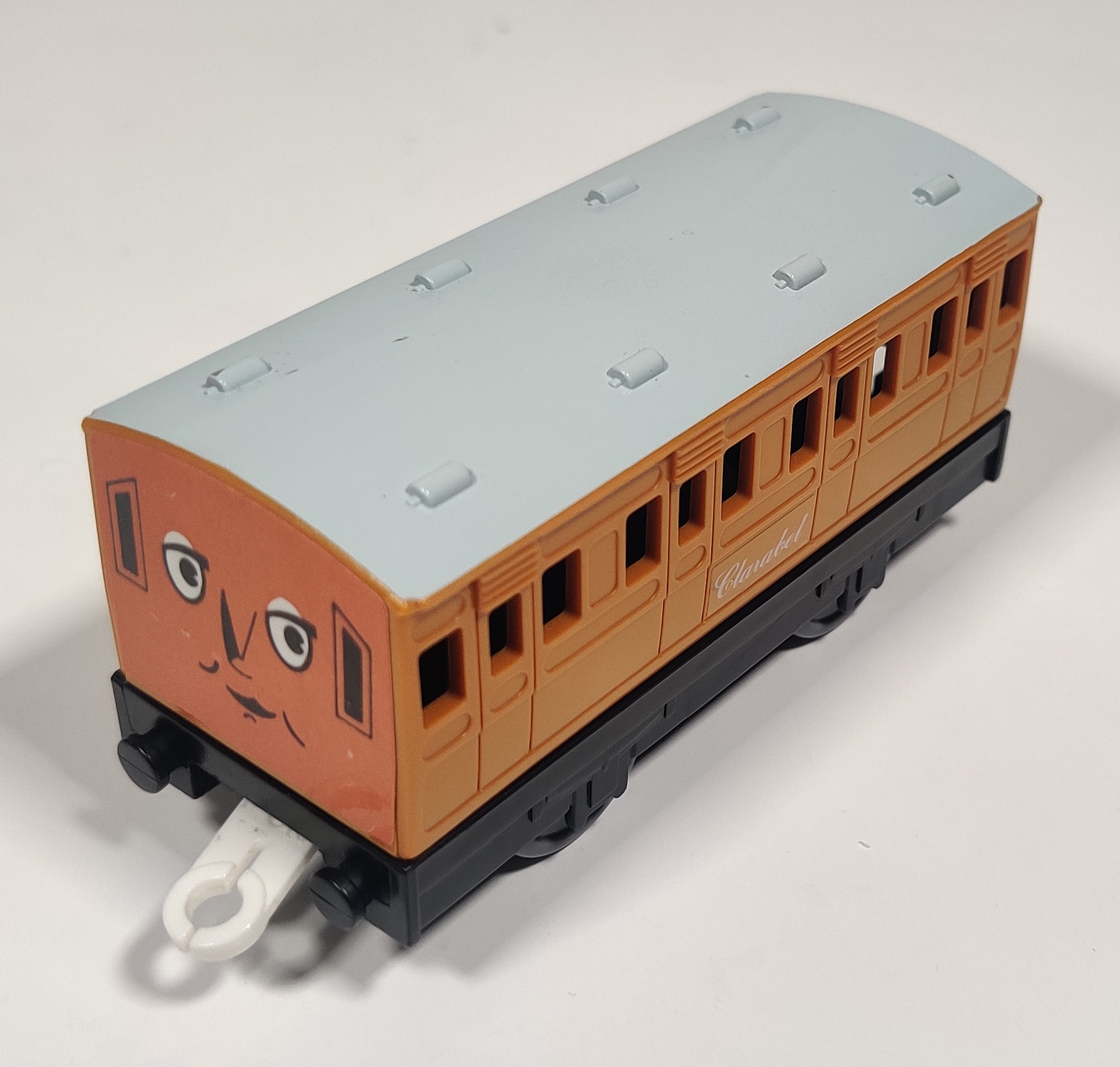
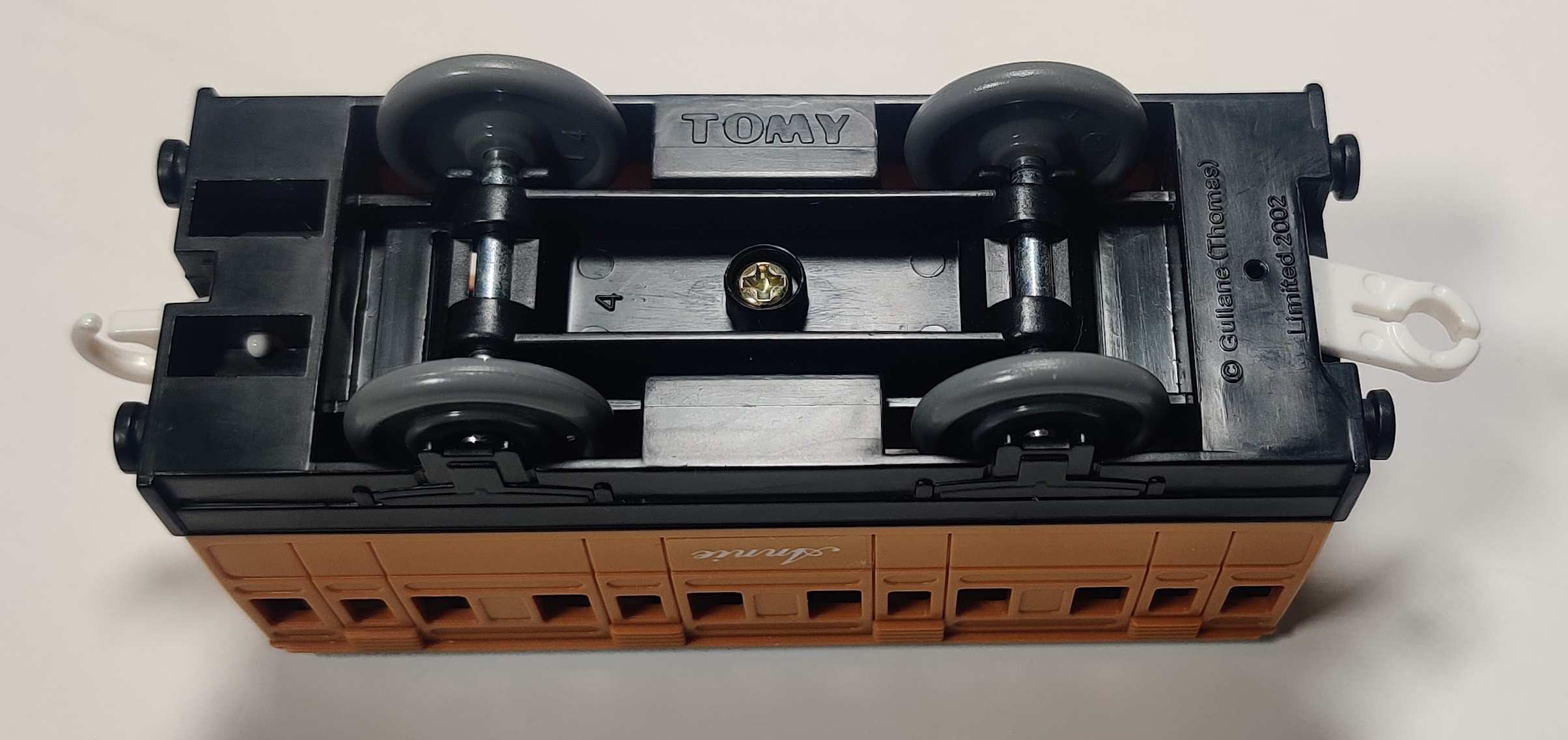
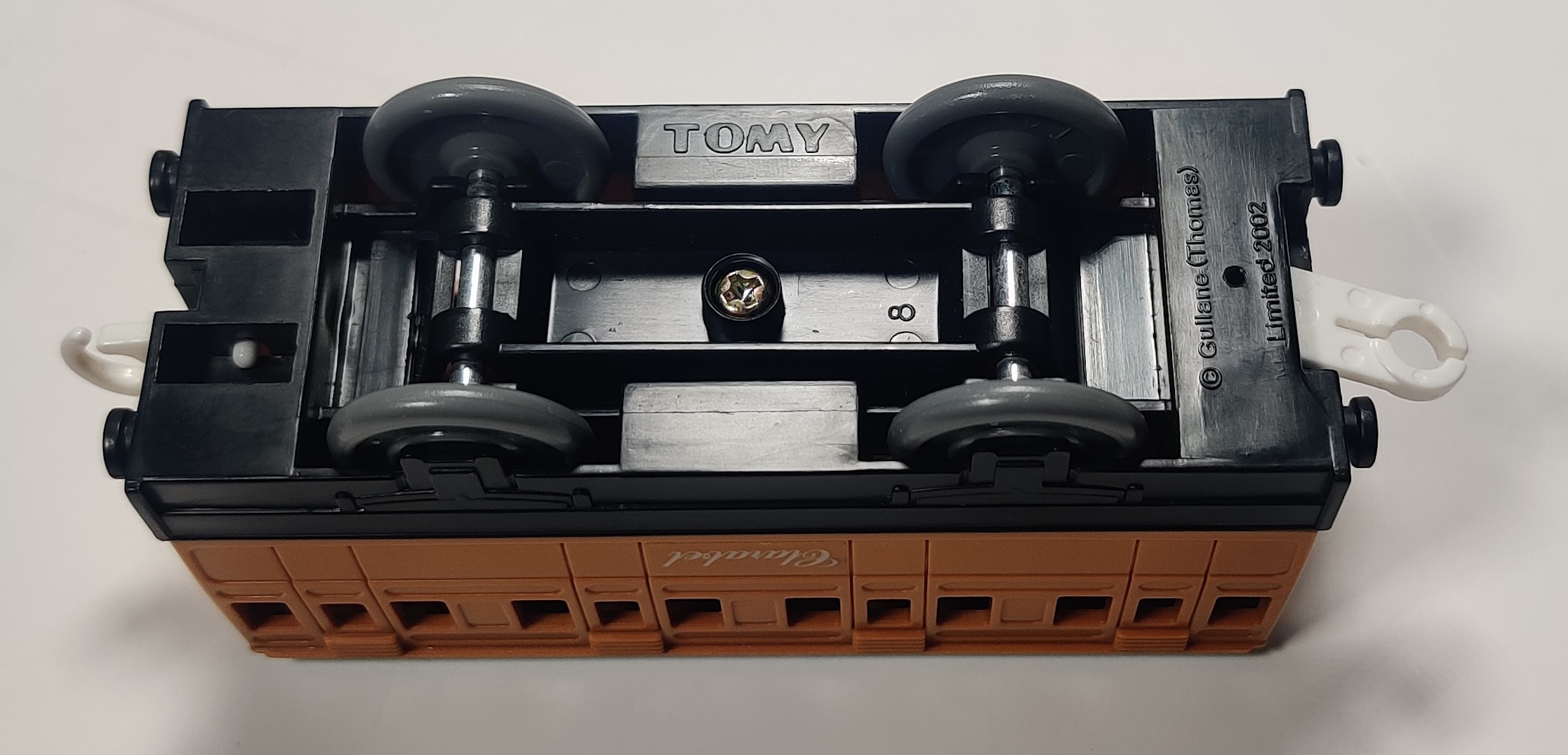
Annie and Clarabel also received updated chassis with the squared-off Tomy logo.
At this point the Plarail range and the export Tomica World/Motor Road and Rail releases diverged, with international Thomases using the 2002 updated chassis and a separately fitted plastic face but none of the other added details.
7440 Thomas (Motor Road & Rail (U.K.)/Motorized Road & Rail (U.S.)) (2003/2005)

In 2003 new updated-chassis plastic face Thomas with Annie and Clarabel were released in Europe in blue Thomas Motor Road & Rail packaging. In 2005 the three-pack release was sold in the United States at Toys R Us. The European release got a new box in 2005 used until the Tomy TrackMaster box in 2008. Into 2004 these Thomases would have had the earlier flat buffer style chassis while later examples would have used the later tooling variations shown below.
Thomas the Tank Engine Snow Shoveling Set (2003)
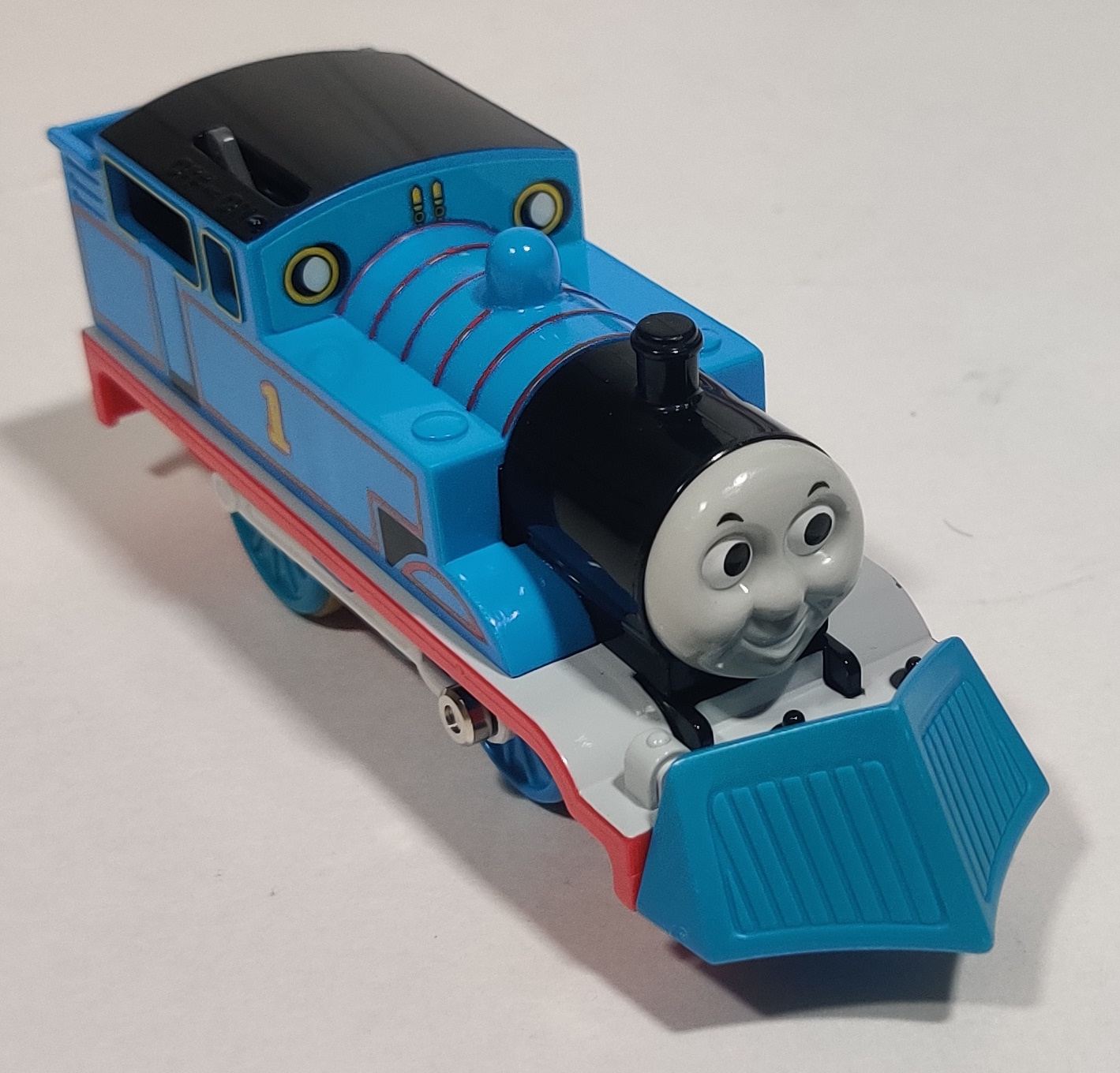
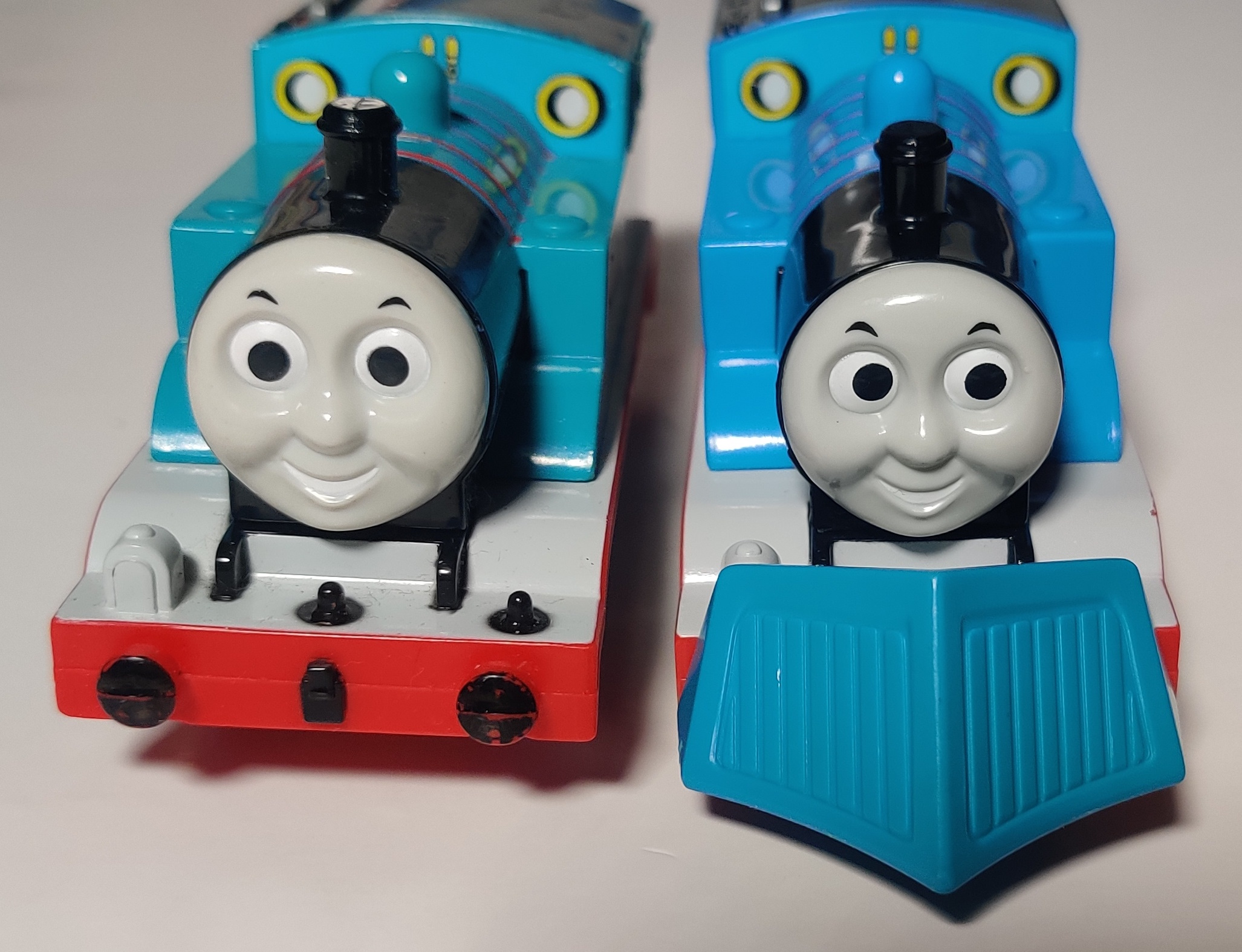
Produced in November 2003 and released in December, the first eye variation of the new "standard" Plarail Thomas was the looking-to-the-left Thomas included in the Thomas the Tank Engine Snow Shoveling Set. Thomas is looking more to the left and less downwards than the later circa-2010s face variations.
4830 Thomas (Motorized Road & Rail) (2004)
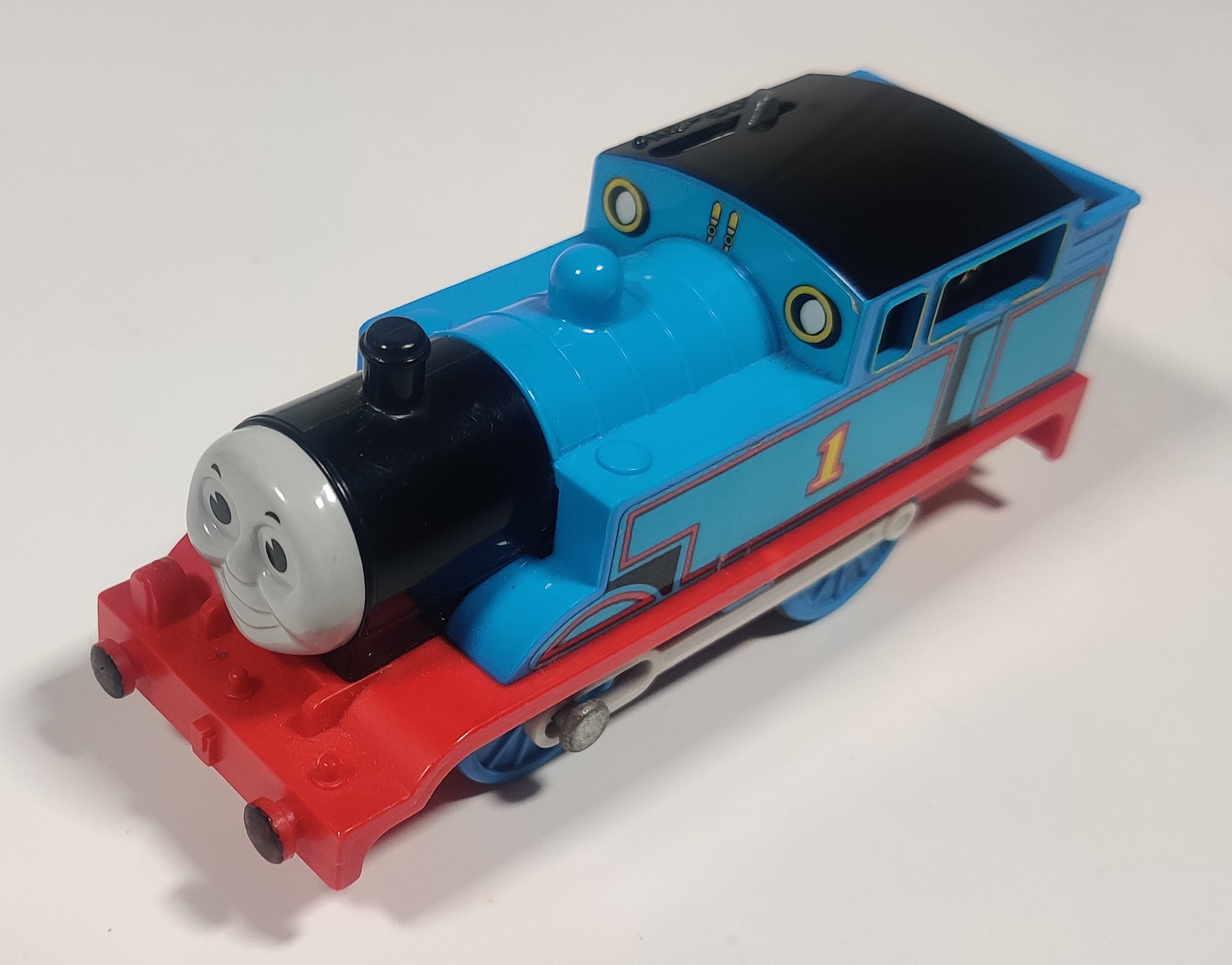
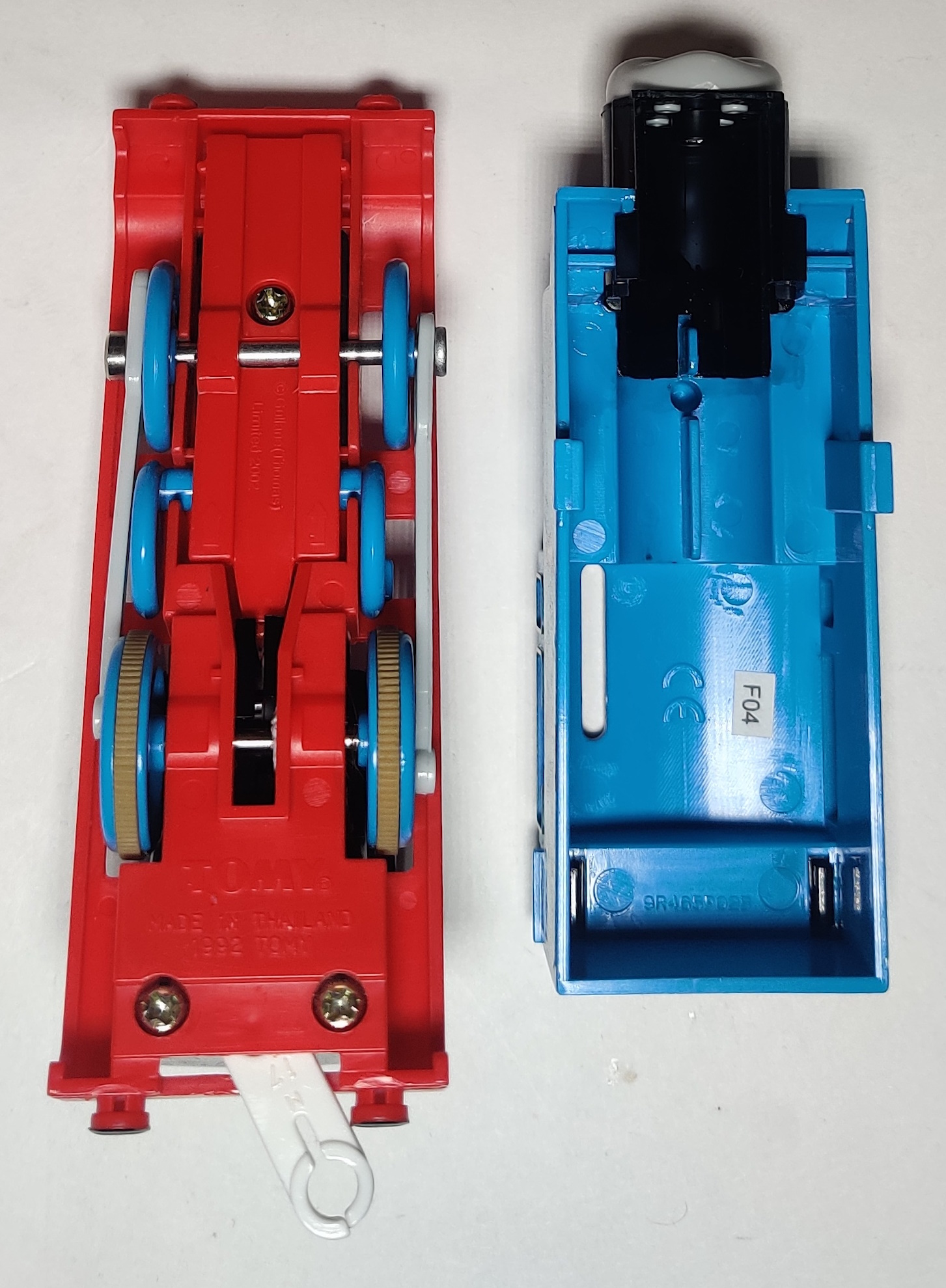
In 2004 Thomas was sold in the United States in individual plastic-box hangtag packaging. Earlier examples of these Thomases have the earlier flat buffer style chassis while later examples would have used the later tooling variations shown below.
4808 Thomas Value Pack (Motorized Road & Rail) (2004)
Also in 2004, the standard export Thomas was sold with Annie, Clarabel, and Toad the Brakevan in American clear hanging-box packaging.
Thomas the Tank Engine and Friends 60th Anniversary Metallic Thomas (2005)

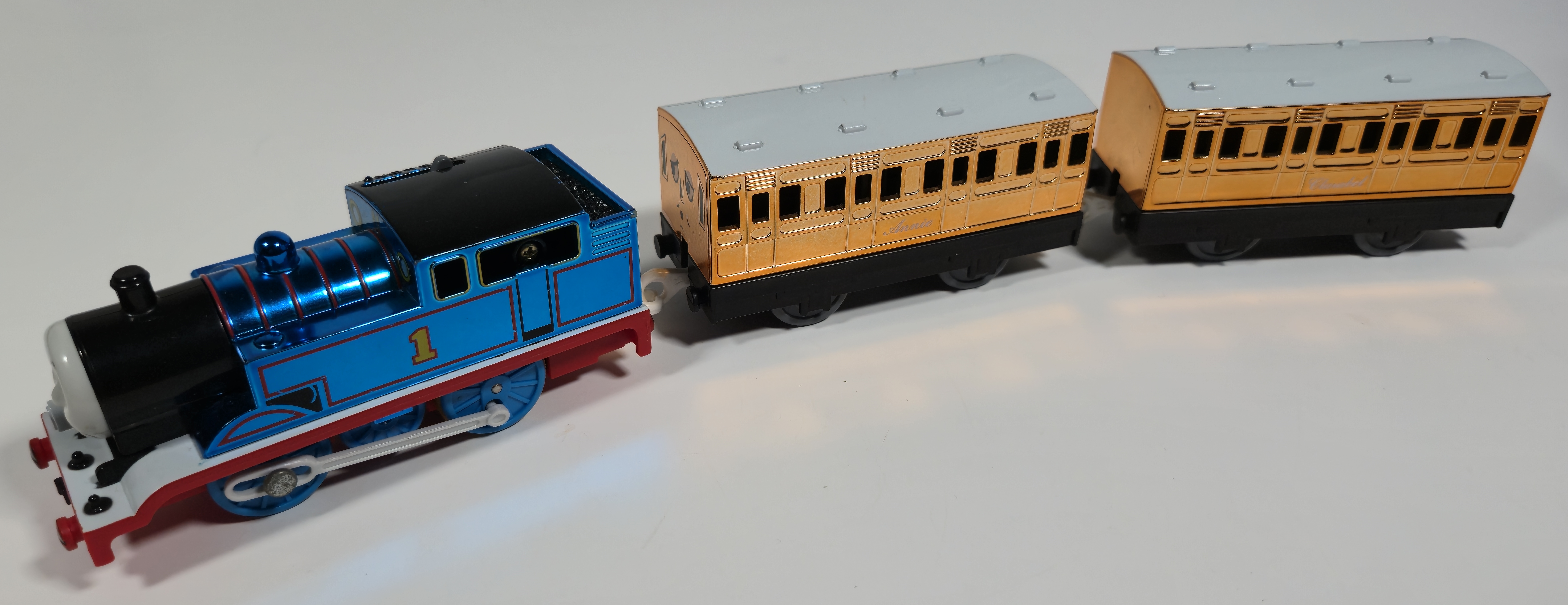
In January 2005 to celebrate 60 years of the Railway Series books that Thomas the Tank Engine and Friends is based on a special shiny blue Thomas and gold Annie and Clarabel was released in a cool unique commemorative box. A few other shiny blue Thomases were produced later, but these were first produced in December 2004. More information can be found on the Thomas the Tank Engine and Friends 60th Anniversary Metallic Thomas page.
Thomas (Rounded buffers, smaller gearbox) (2005)
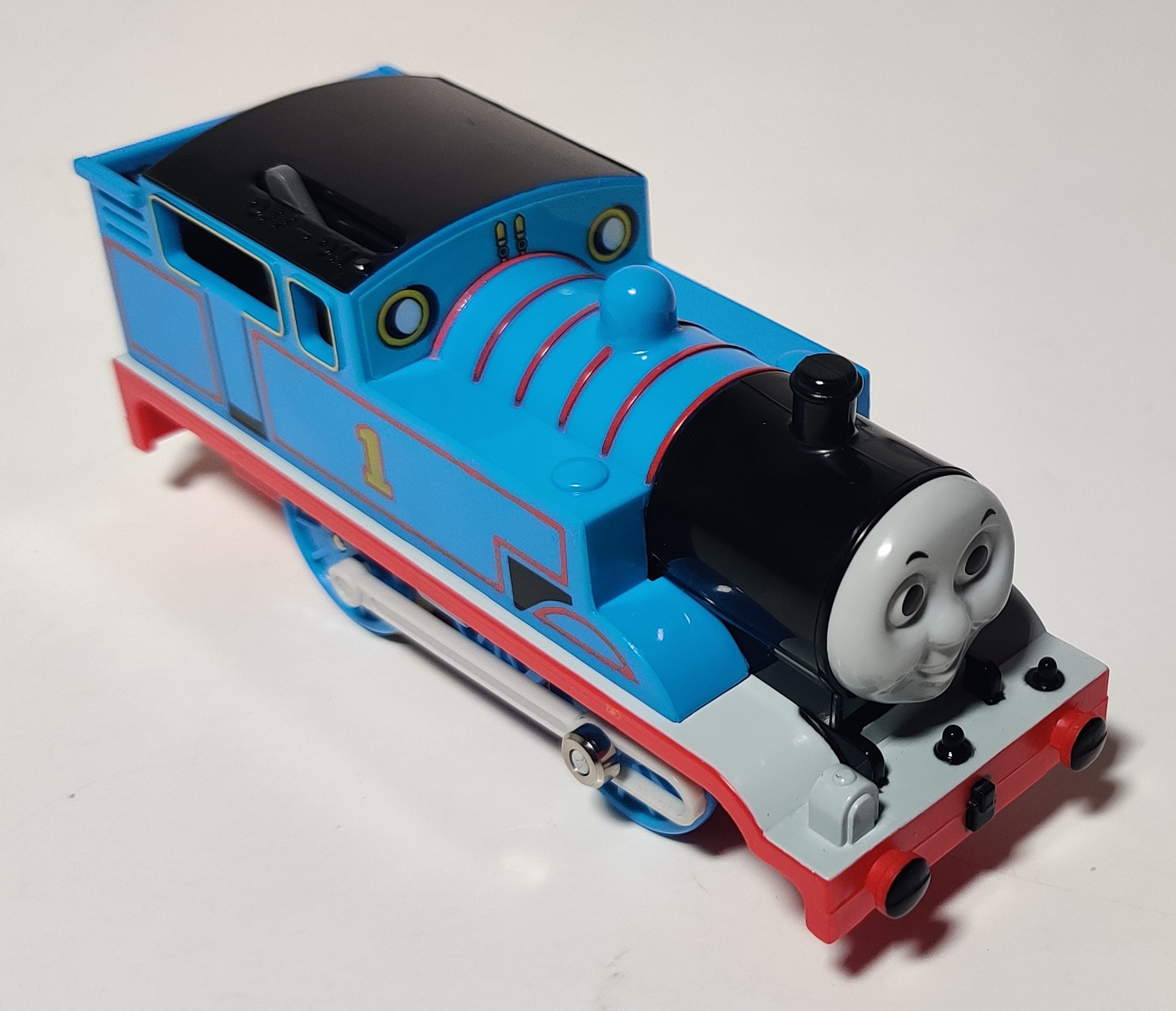
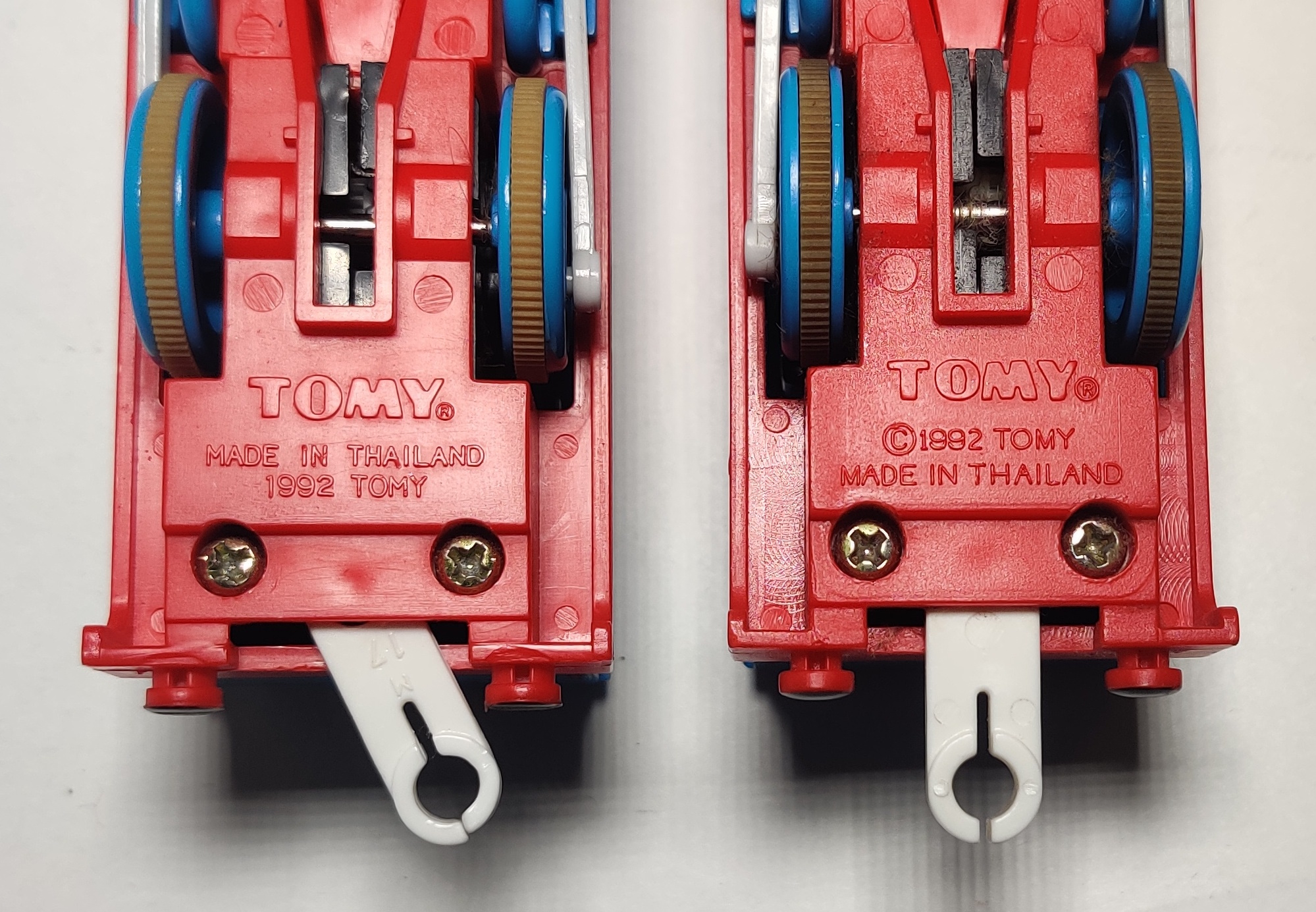
In 2005 a new Thomas chassis tooling entered use. This tooling has thicker rounded buffers and has the 1992 Tomy and Made in Thailand text lines the opposite way around.
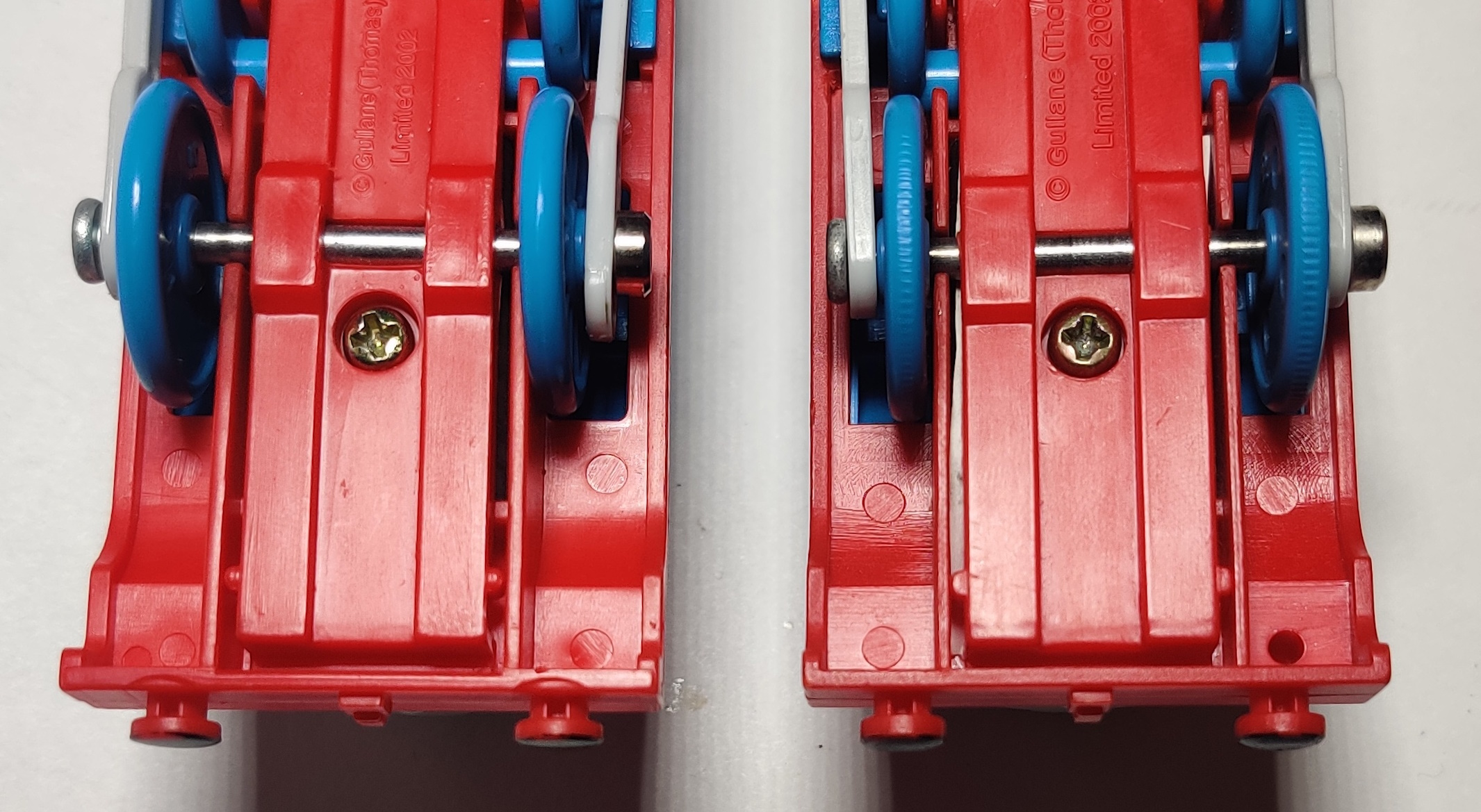
This tooling also has different tooling production marks and ejector pin locations as well as different locations for the Thomas license text on the front wheel holder. It seems that this chassis may have been introduced to production alongside the smaller version of the Thomas-type gearbox.
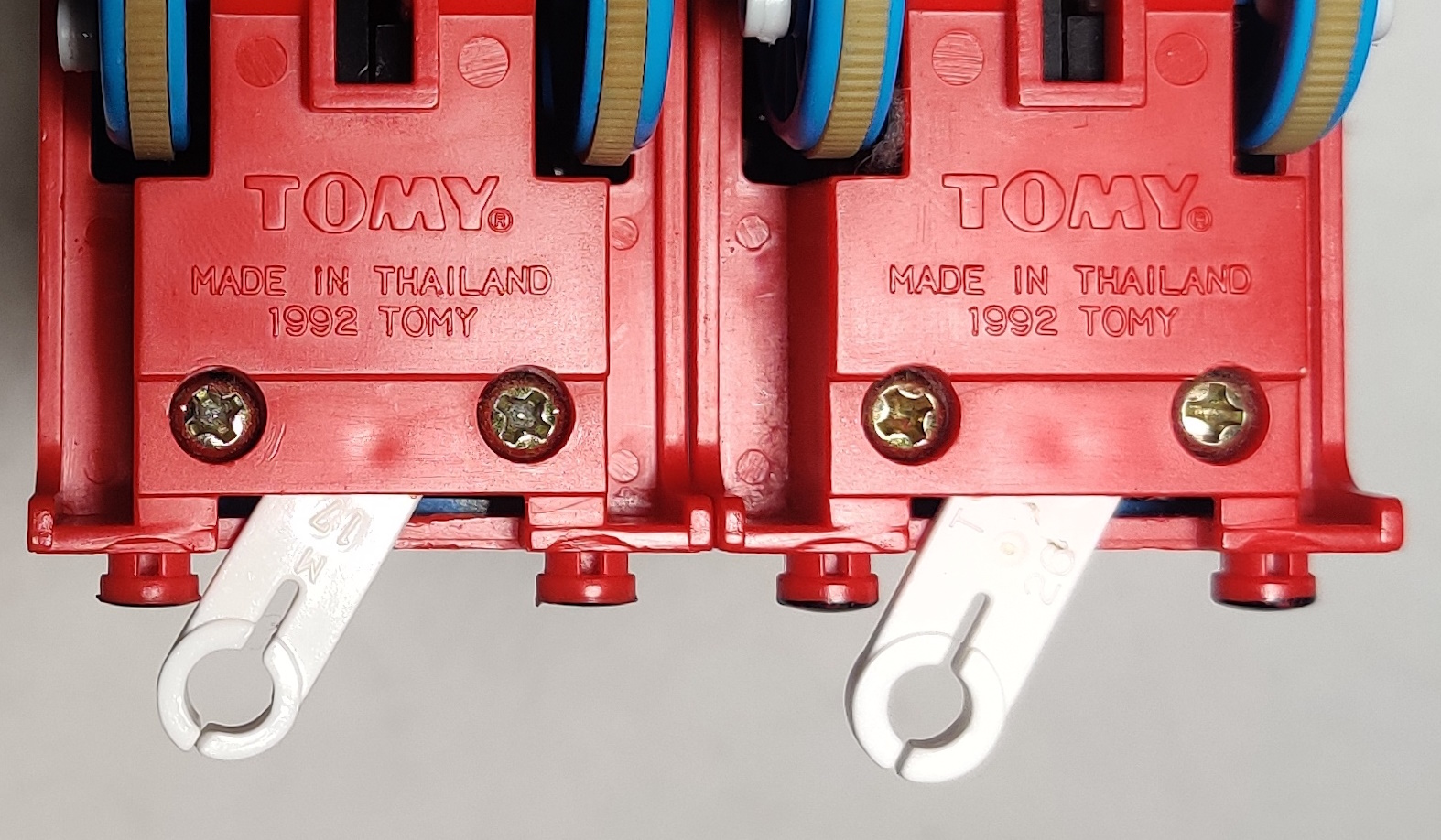
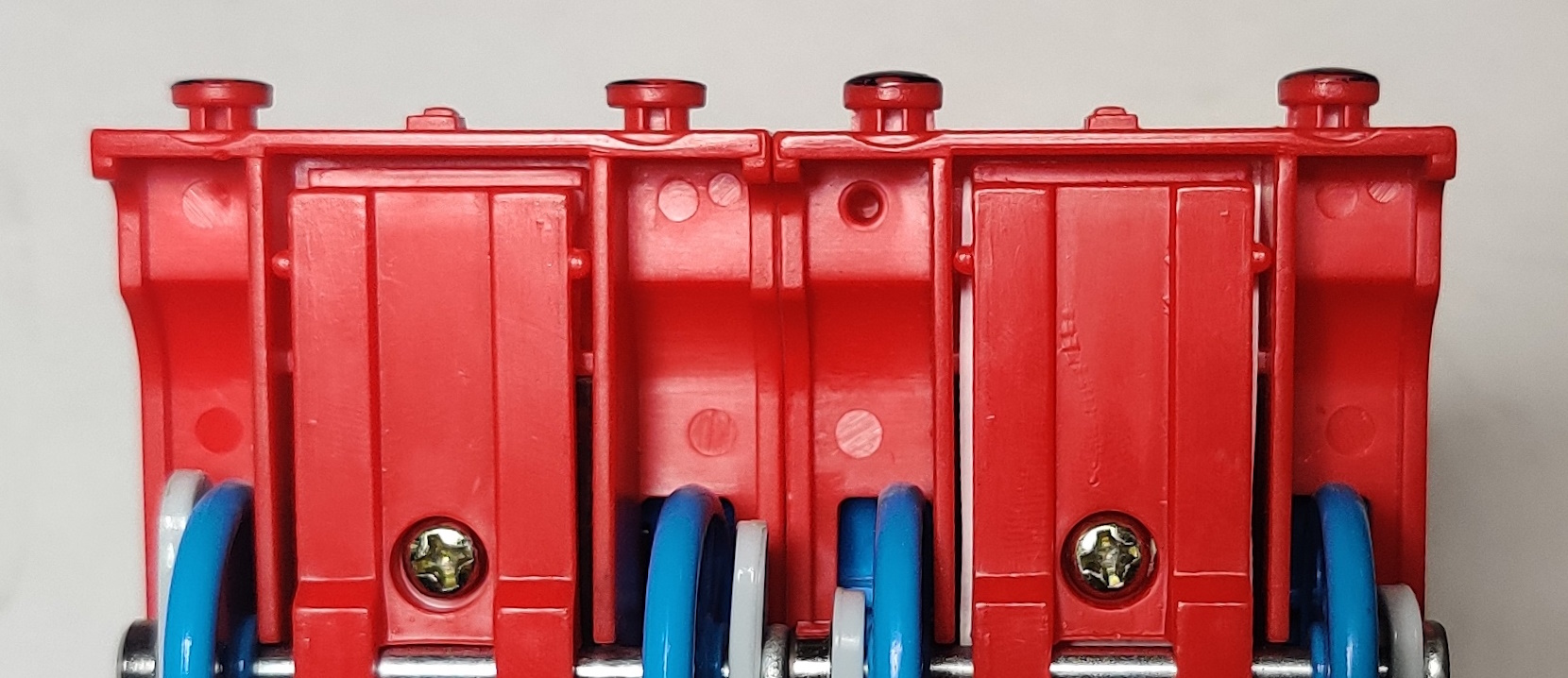
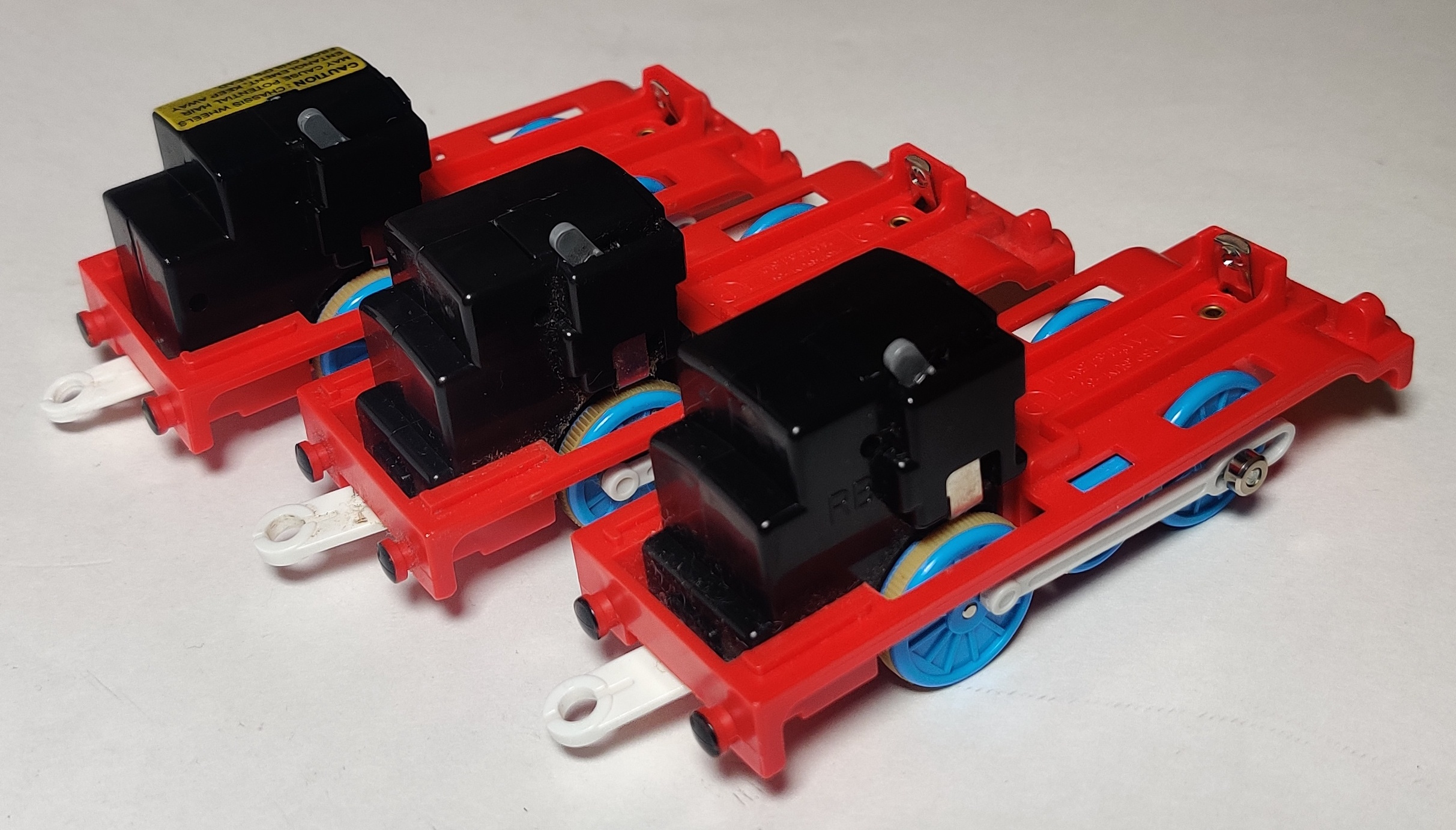
Also in 2005, the existing older type of chassis tooling was updated with thicker buffers and began using the smaller gearbox type. The hollow portion of the lamp was also restored. These changes in tooling were reflected in export Thomases as well.
4847 Thomas with Track (Motorized Road & Rail) (2005)
In 2005 in the United States export Thomas was sold with two half straight rails.
Thomas the Jet Engine (2005/2006)
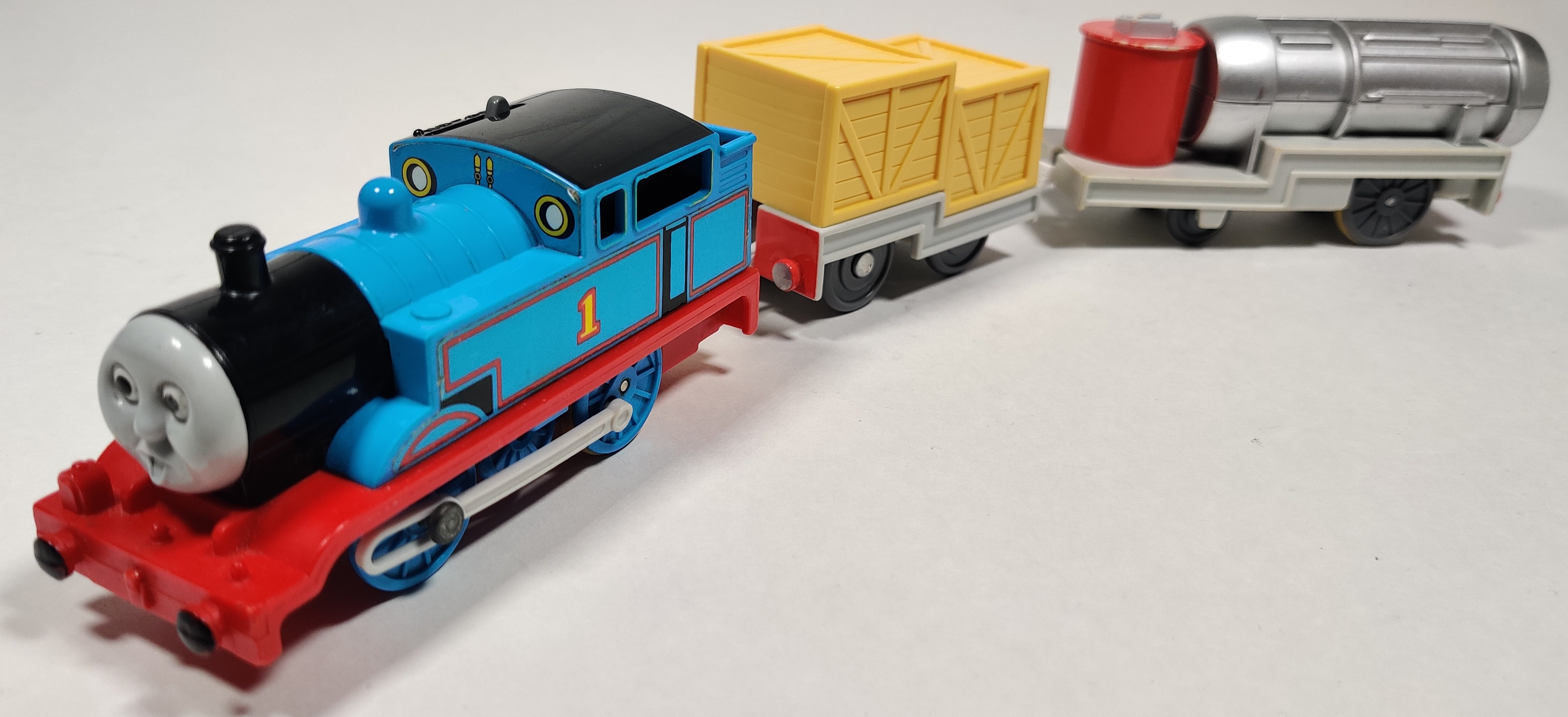
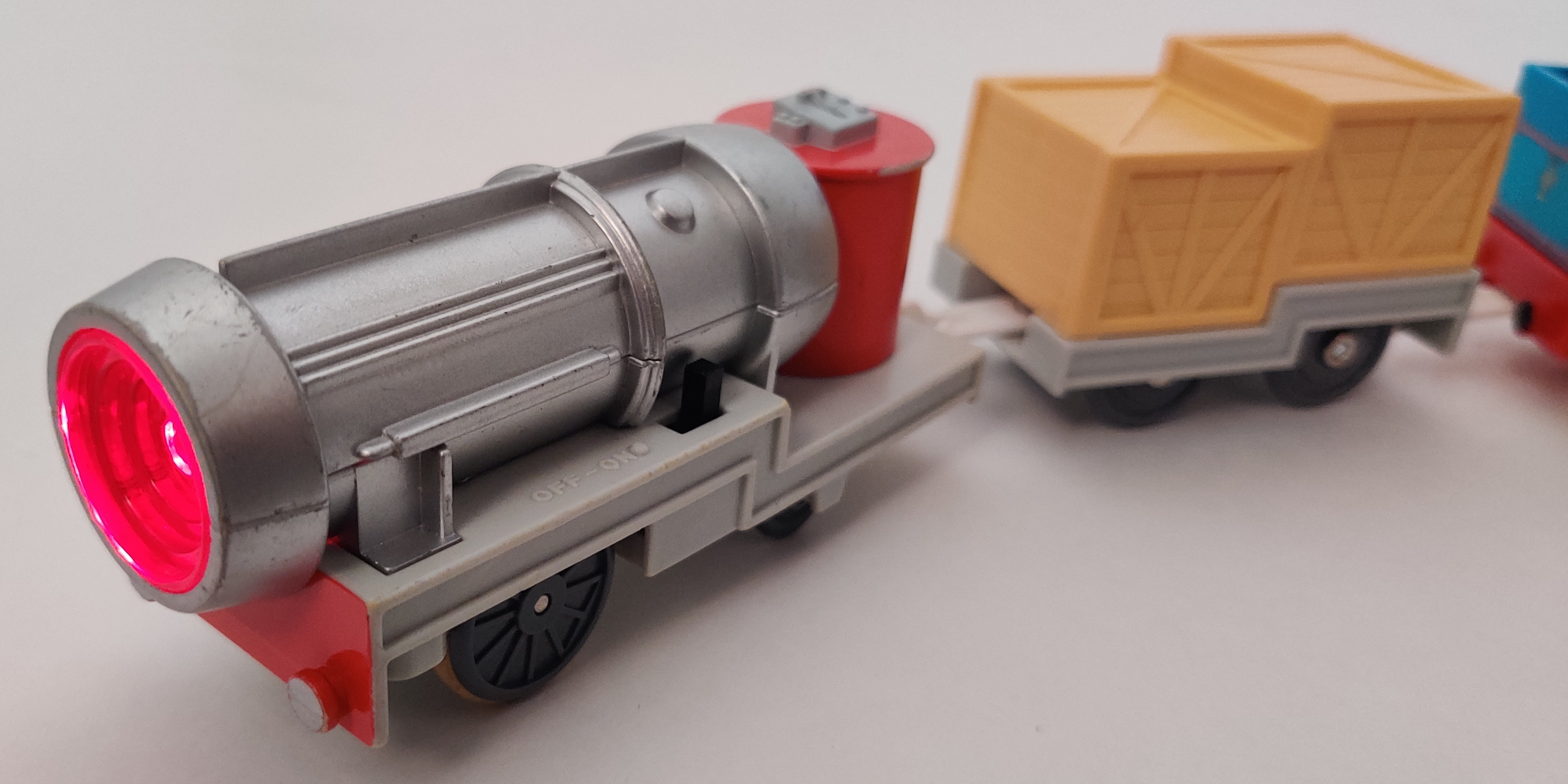
Starting in late 2005 both the European and American Motor Road & Rail ranges began selling a special three-pack based on the episode Thomas the Jet Engine with a DVD including the episode. The train included was a special Thomas with faster gearbox and shocked expression as well as a representation of the jet engine flatbed split across two cars with a light feature in the jet's tail.
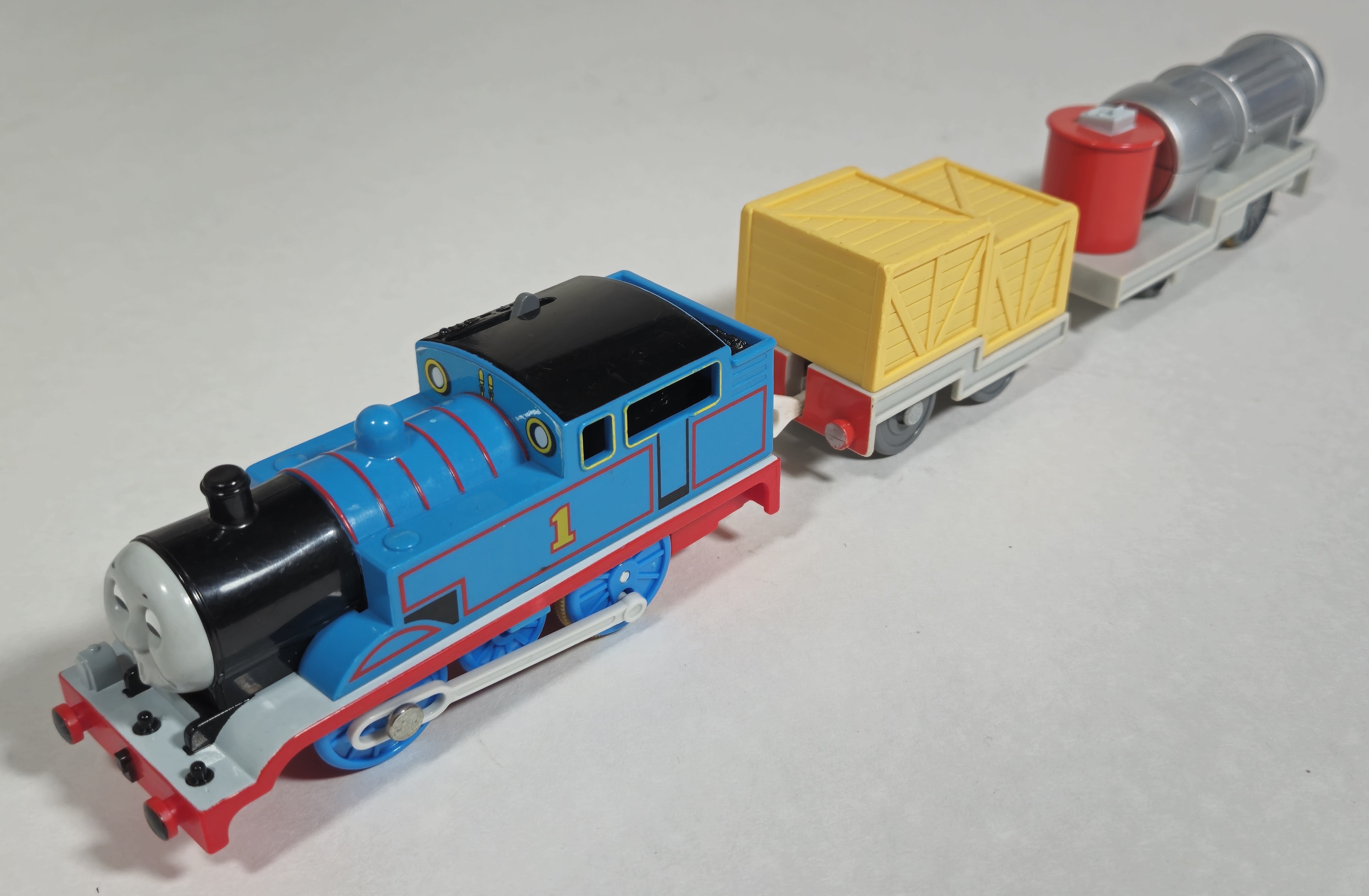
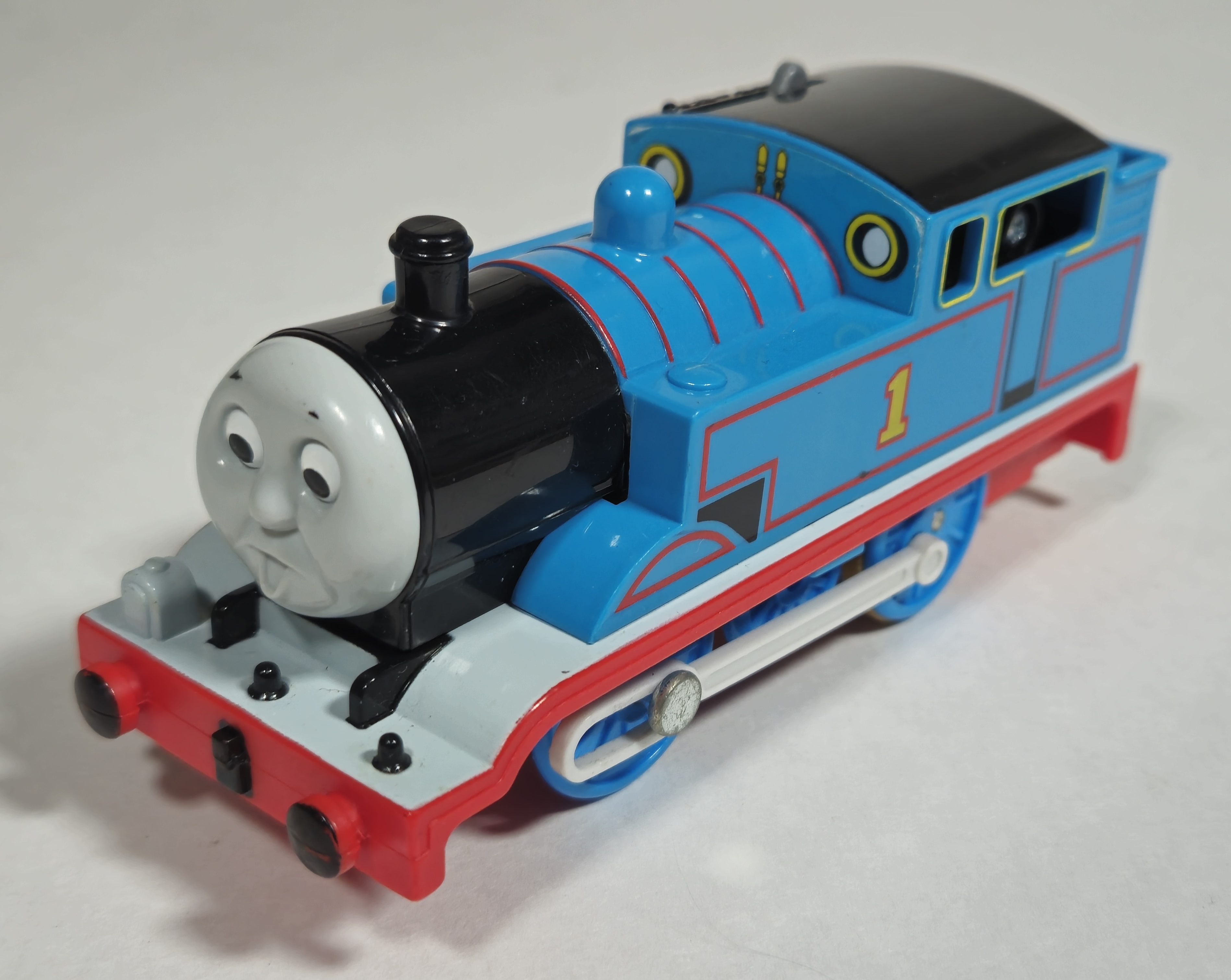
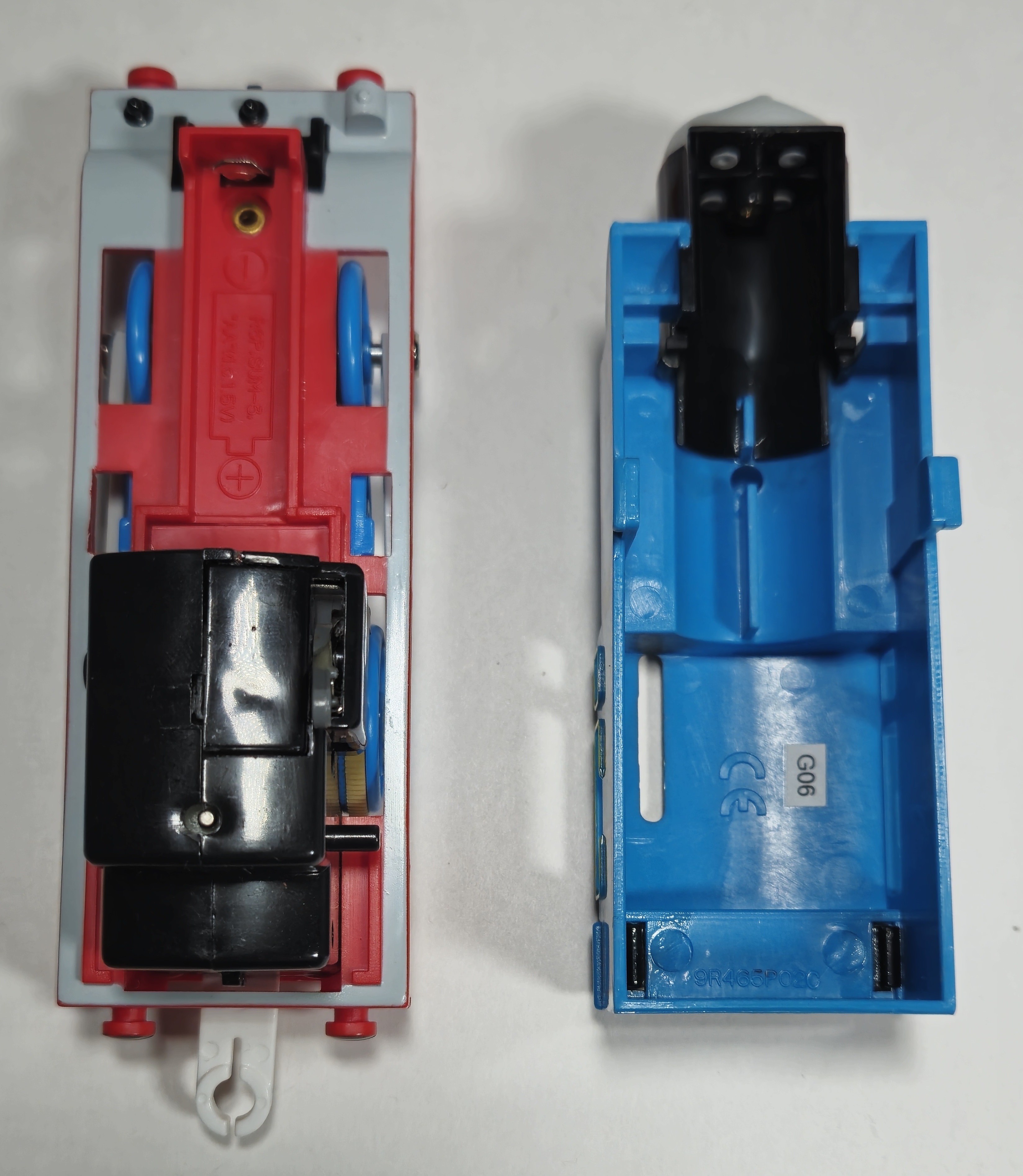
In May 2006 the pack went on sale in Japan as T-24 Thomas the Tank Engine and the Jet Engine. The higher-speed gearbox is built into what used to be the Talk 'n Action gearbox tooling. The eyes of this Thomas look down similar to the Doki Doki Mountain Thomases.
T-1 Plarail Thomas (Updated phone number) (2006)

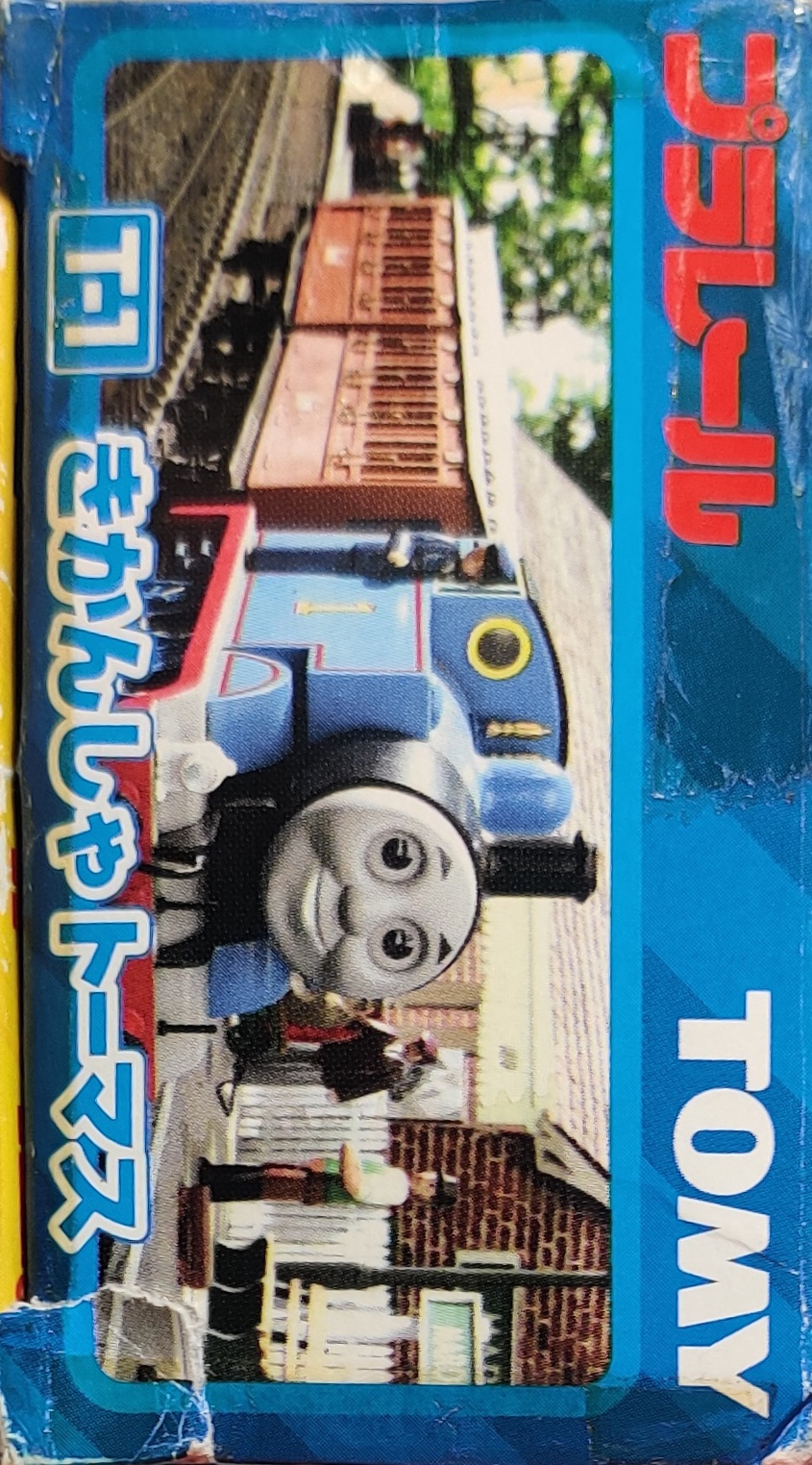

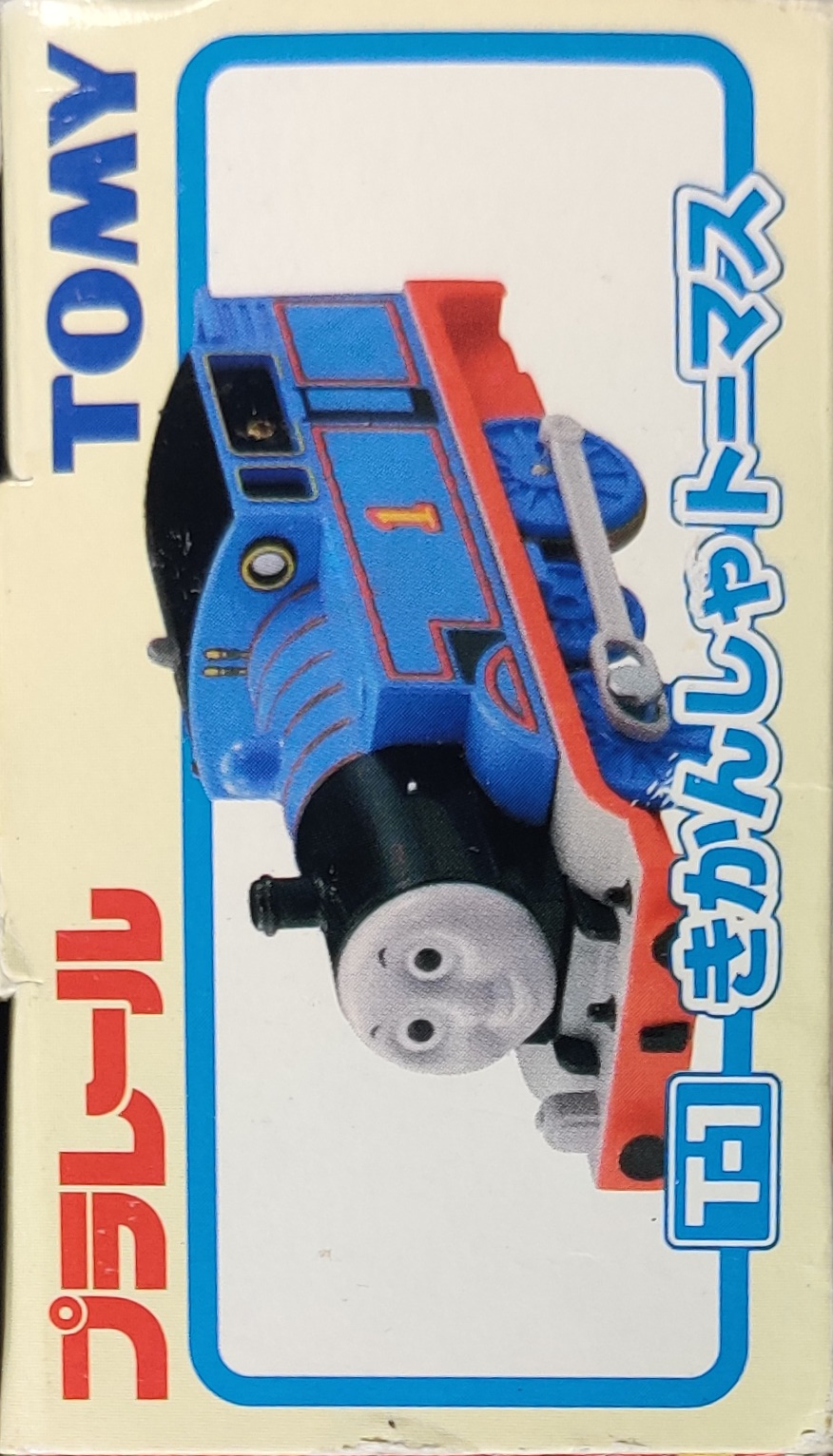


The earliest rereleased Thomas box I own is an earlier 2006 print run with a 2007-produced Thomas. Other than some differences in the phone numbers on the rear, most of this design is unchanged from the earlier 2000s releases. The first six engines who received the most updates in 2003 all had a panel showing the main engines on the rear of the box that other engines did not.
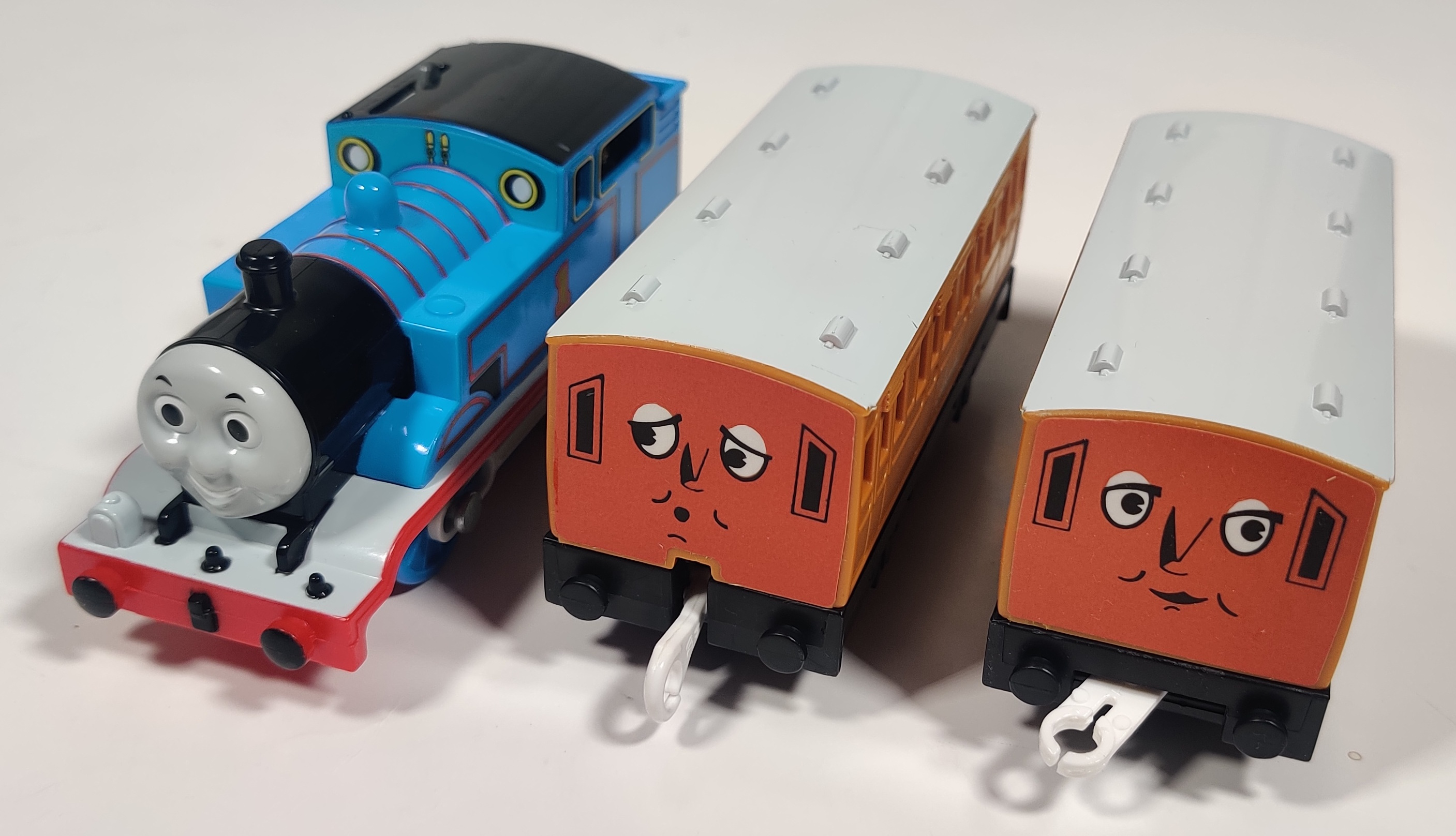
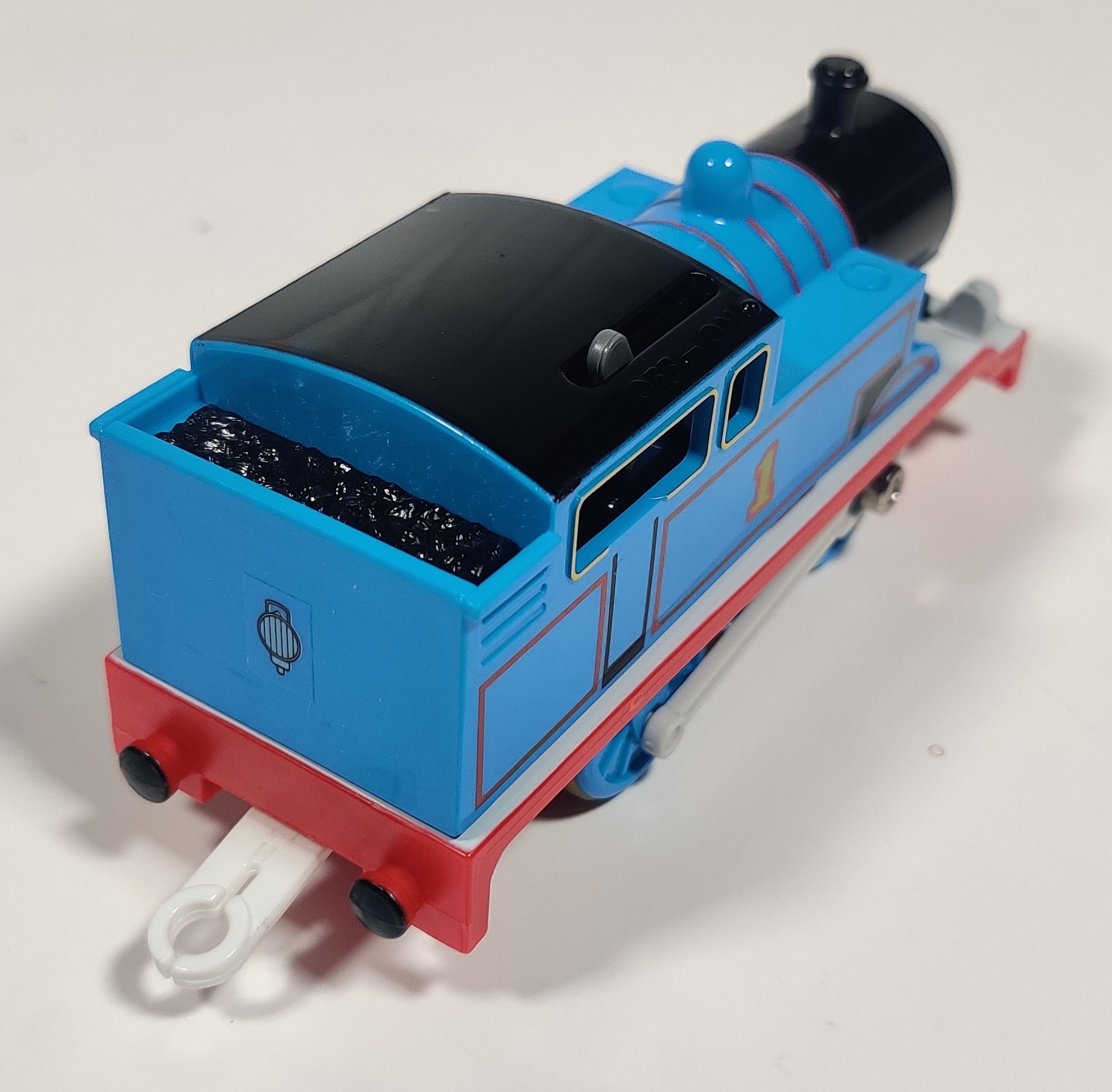
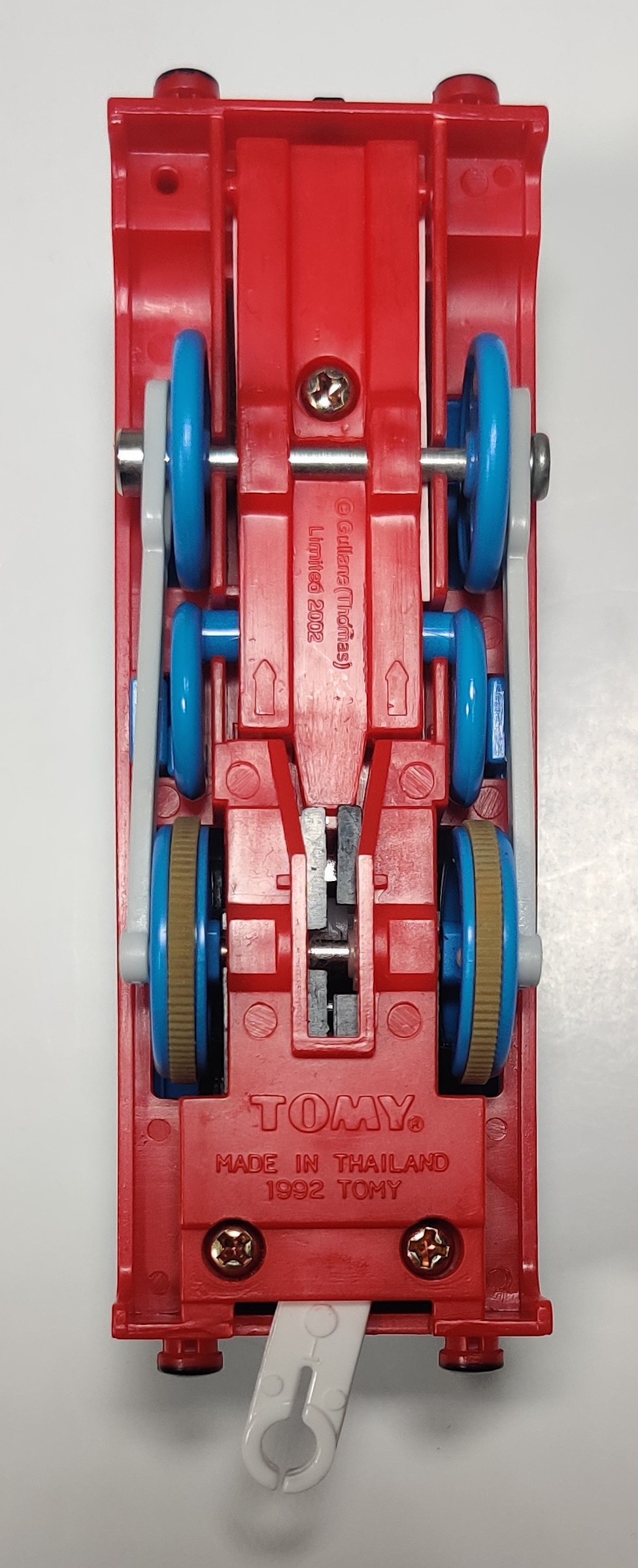
By this point, the rear sticker had been reduced in size to just fit the rear lamp. Lamp irons remained thick-rimmed into the early 2010s. This example comes from the updated rounded-buffer early 2000s tooling with the round marks on the bottom of the bufferbeams.
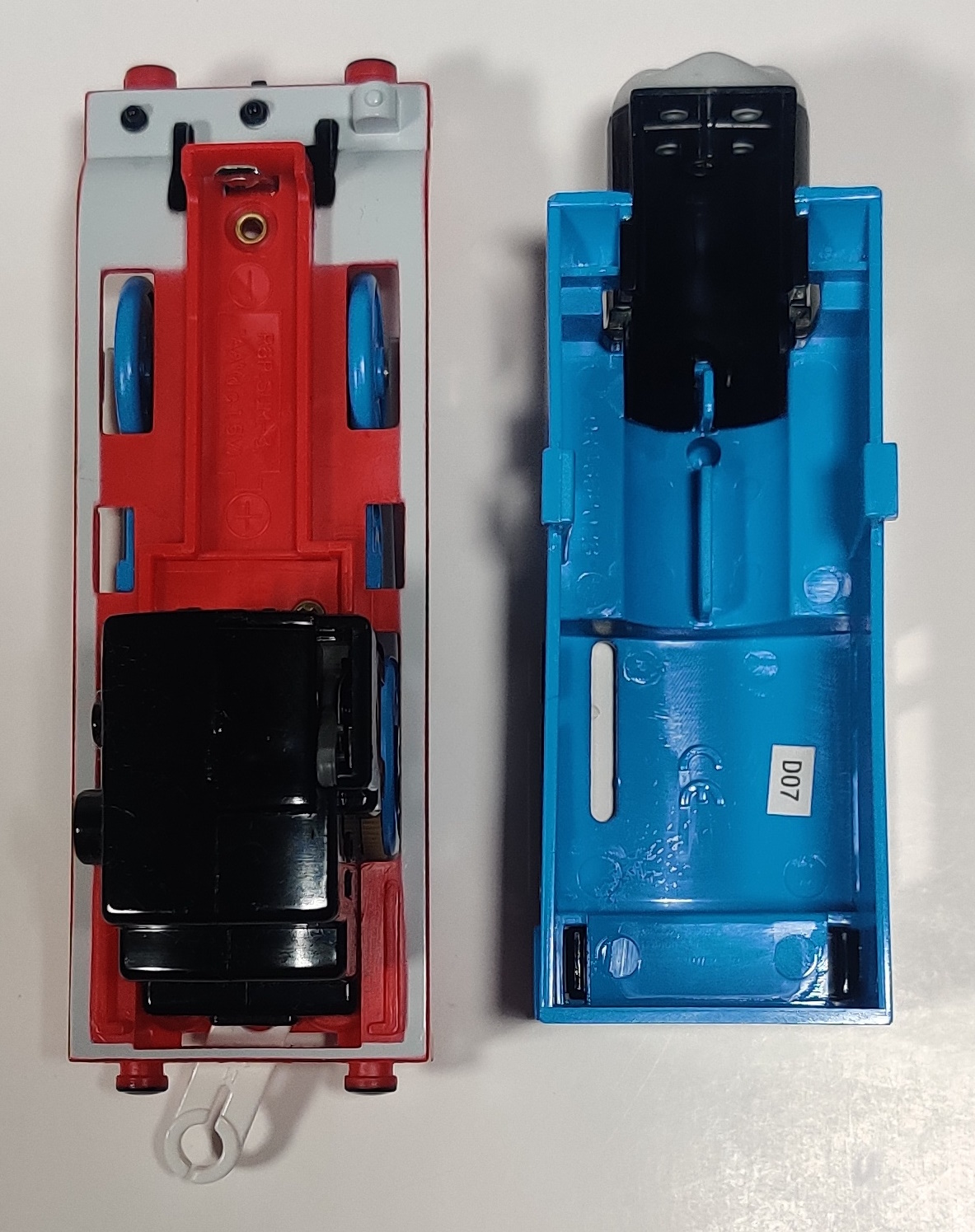
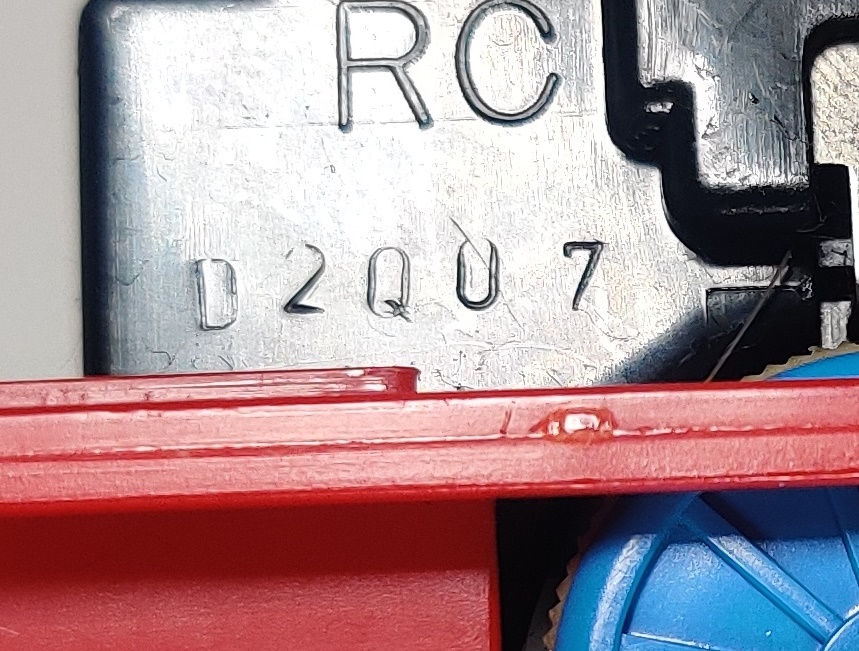
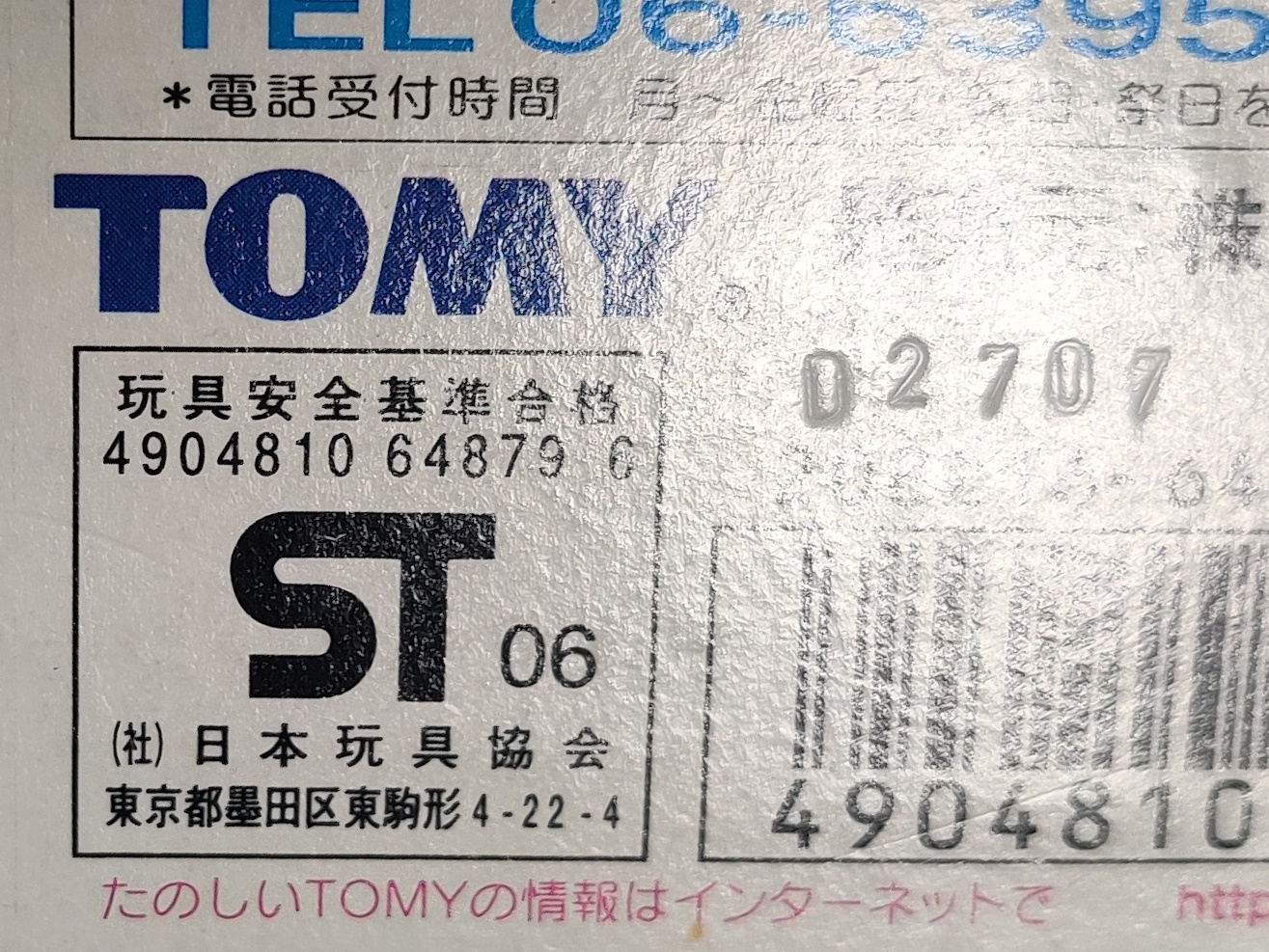
The Thomas production sticker, gearbox date stamp, and rear of the box are all marked as from March and April 2007.
T-1 Plarail Thomas (Post-merger box) (2006)






In 2006 Tomy and Takara merged to become Takara Tomy. In later 2006, new print run boxes were made that did not include the squared-off Tomy logo on the back. Although this logo was removed from the rear of boxes around this time, existing boxes continued to use just the Tomy logo on the front, with new characters getting the Takara Tomy logo instead.
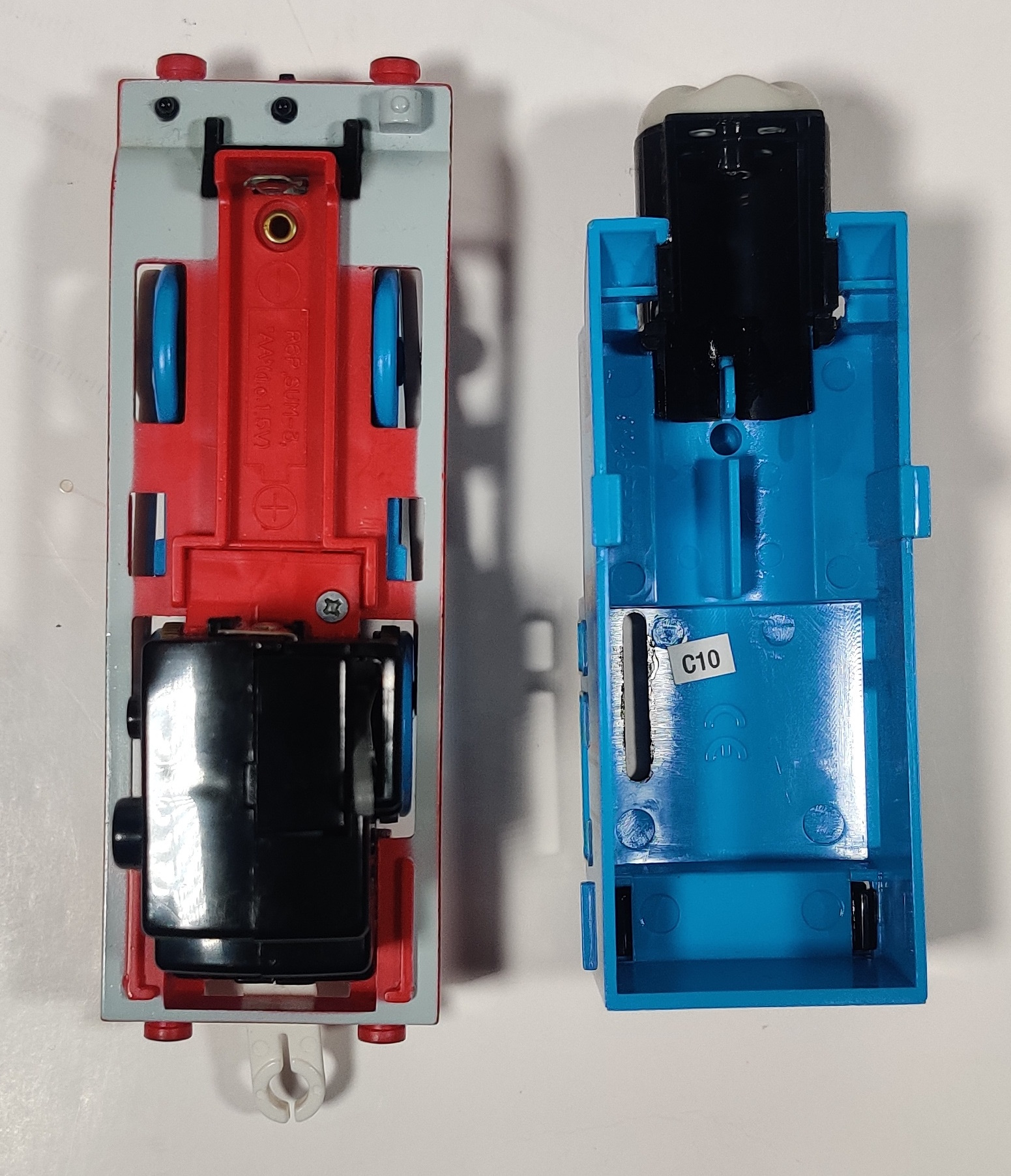
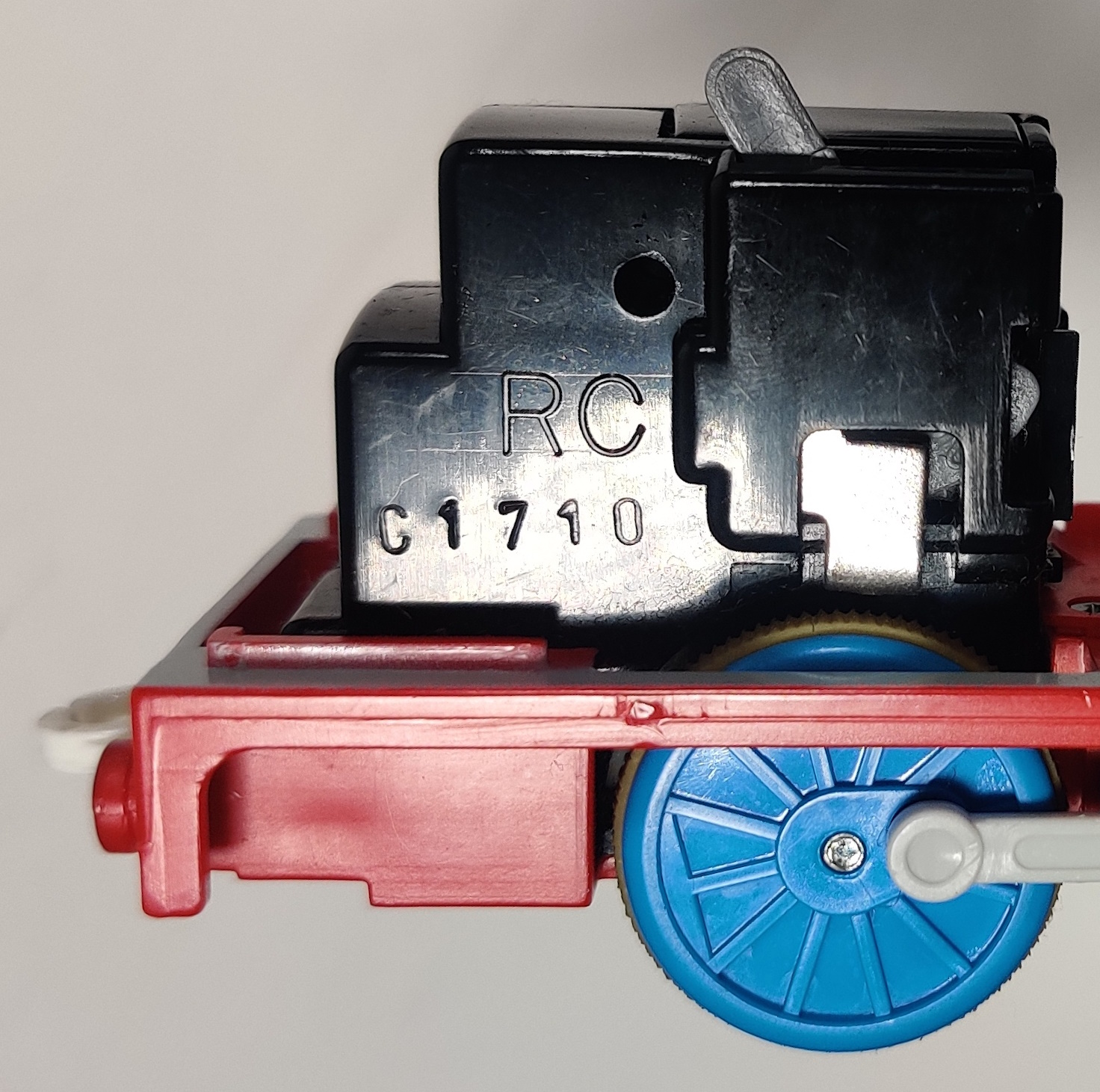
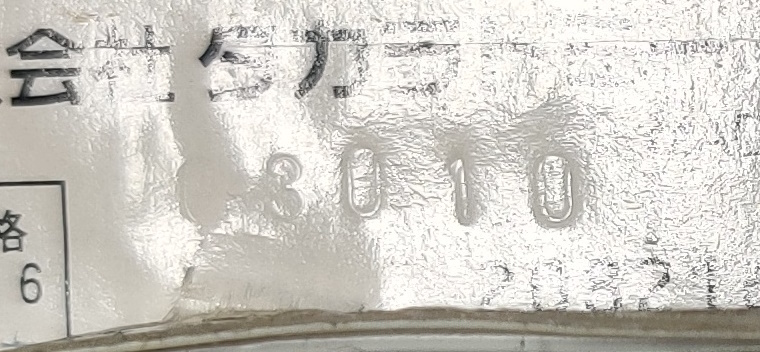
Even though these boxes were printed in 2006, older 2006 print boxes continued to be used at least into 2007 as shown above, with the example shown here not being packed with a Thomas and stamped with a manufacturing date until 2010.
Thomas the Tank Engine Doki Doki Mountain Set (2007)
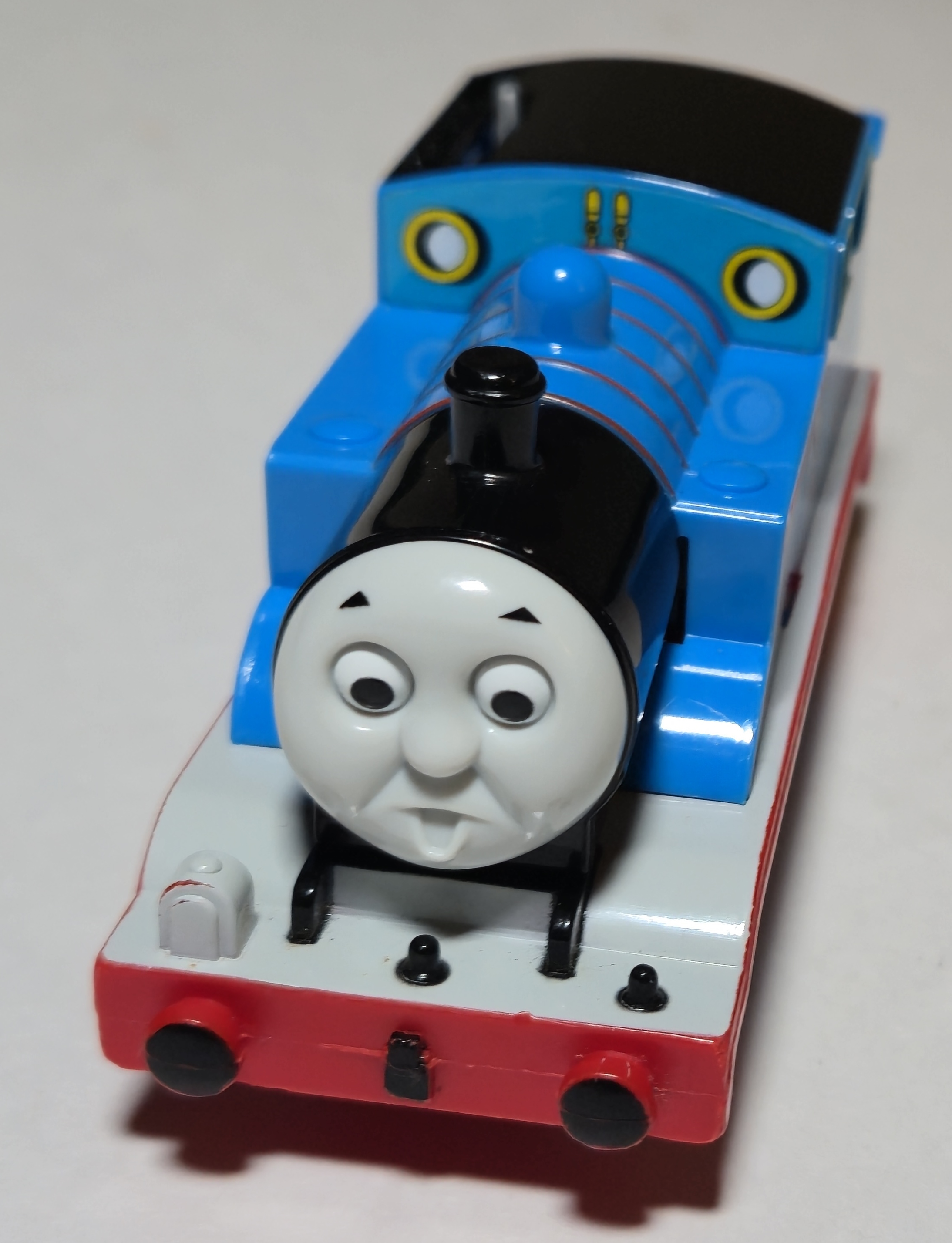
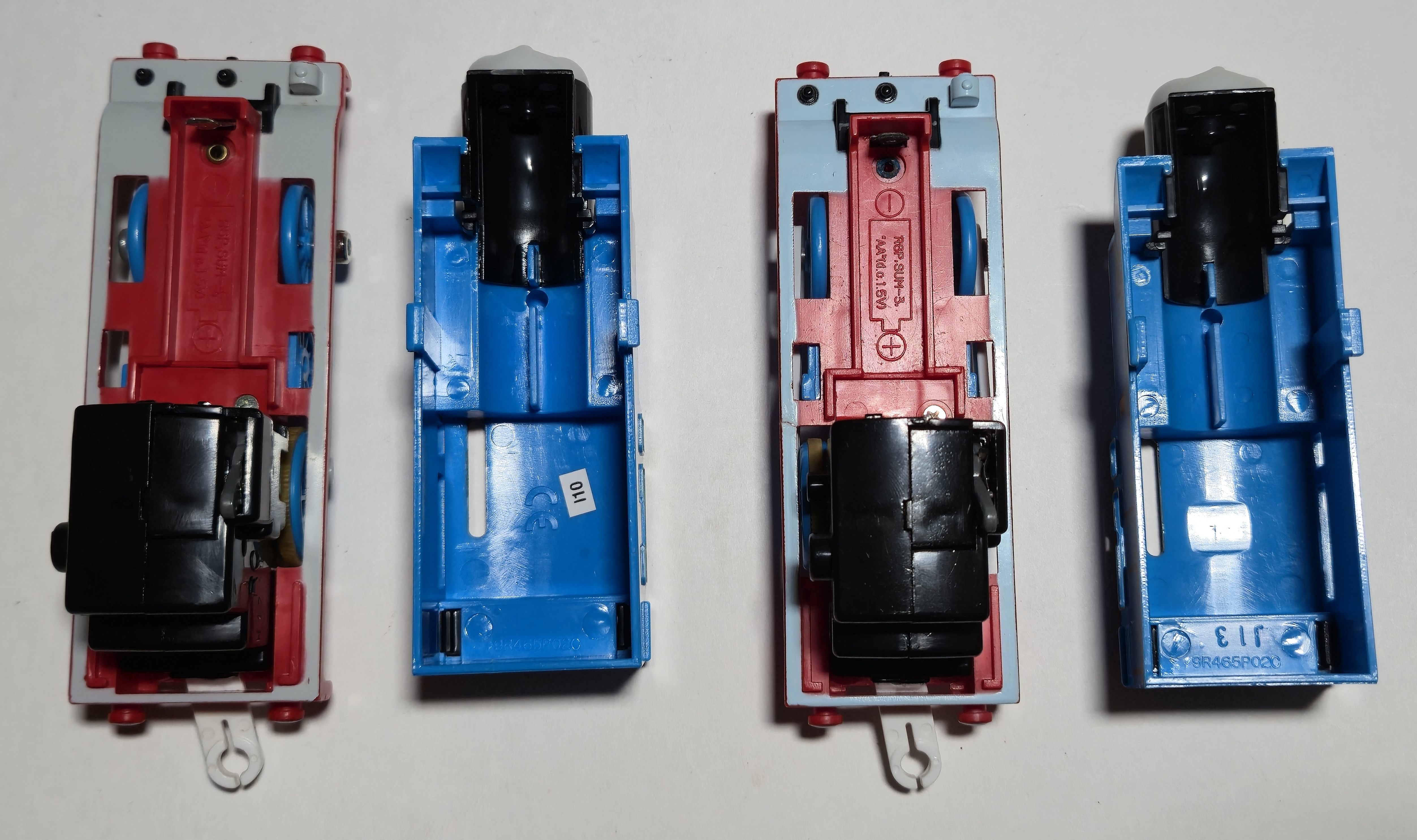
In July 2007 the Thomas the Tank Engine Doki Doki Mountain Set included a surprised-face Thomas with eyes looking down the slope of the large mountain included in the set. This Thomas is pretty similar to the Thomas the Tank Engine and the Jet Engine Thomas, with both being in production for several overlapping years and the Doki Doki Mountain set staying in production with this variation up to 2020, with the 2021 redesigned version of the set including a much less impressive mountain and CGI face surprised Thomas looking down. To the right, the October 2013 date code of a Doki Doki Mountain Thomas dating from the era of more bluish running board paint.
Export Thomases (Reinforced buffers) (2006-2008)
From the time in 2006 when the chassis tooling was updated through the end of export Thomas production in 2008 export Thomases were updated to use the new reinforced-buffer tooling.
TOMY TrackMaster Thomas (2008)
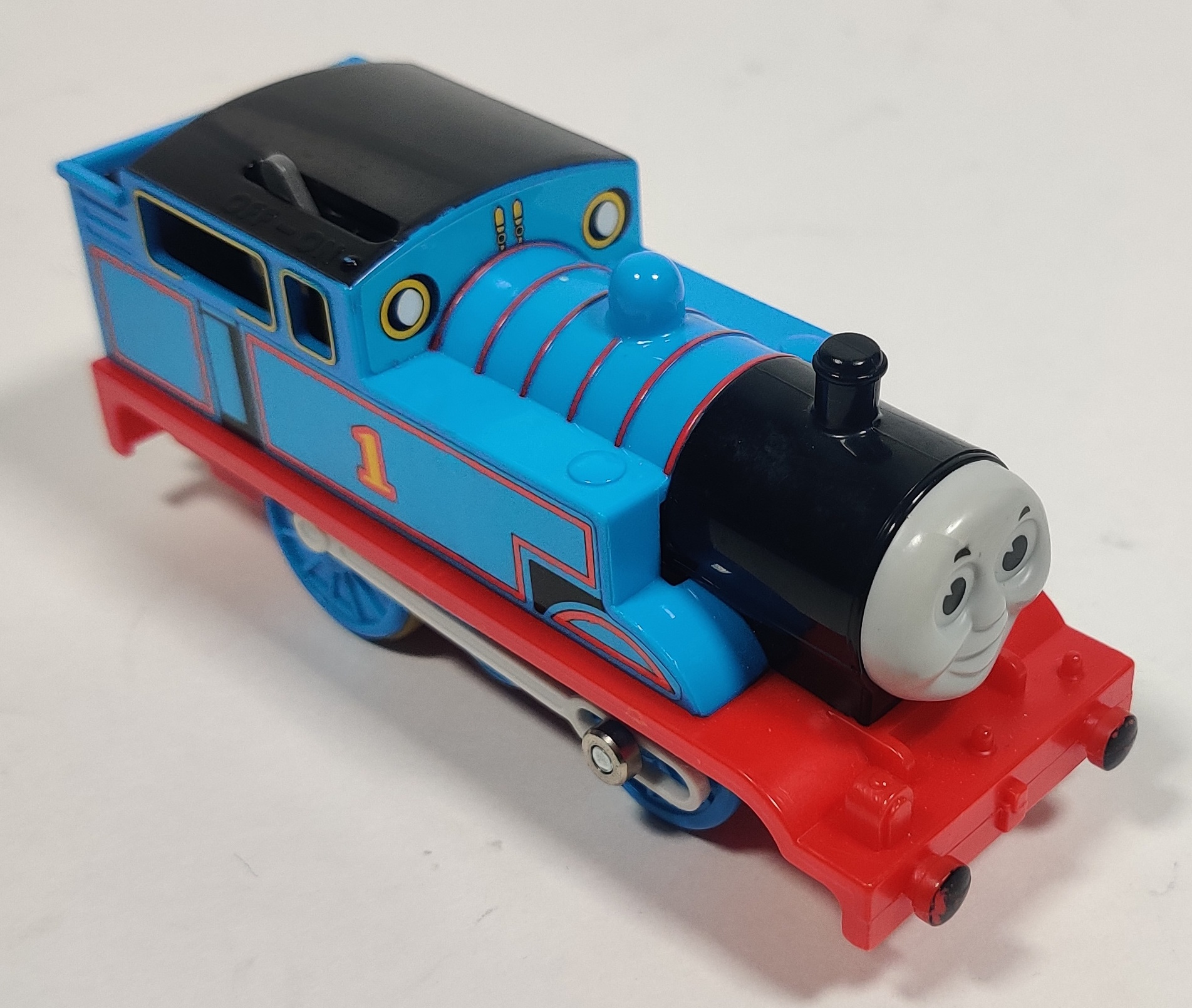
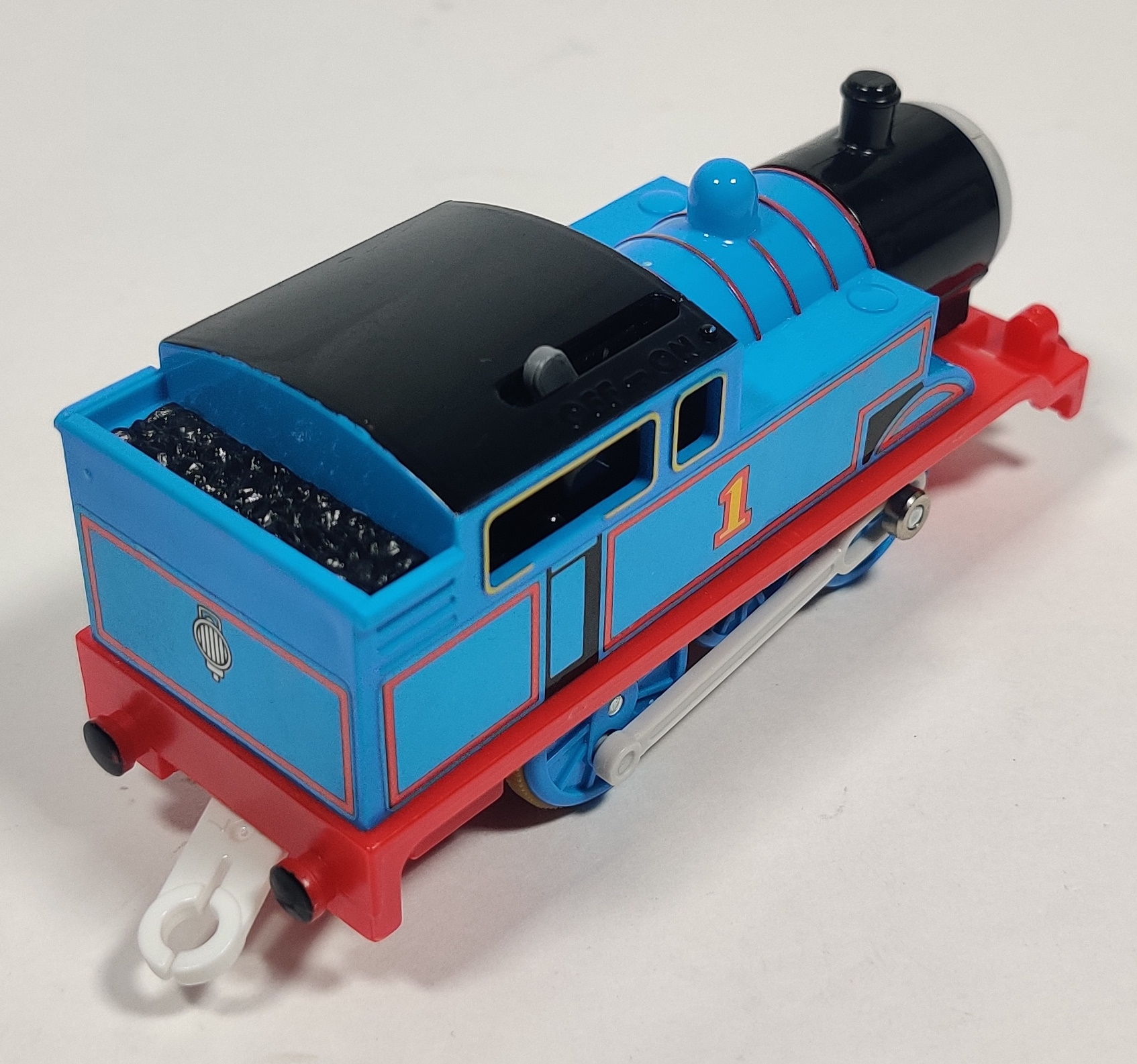
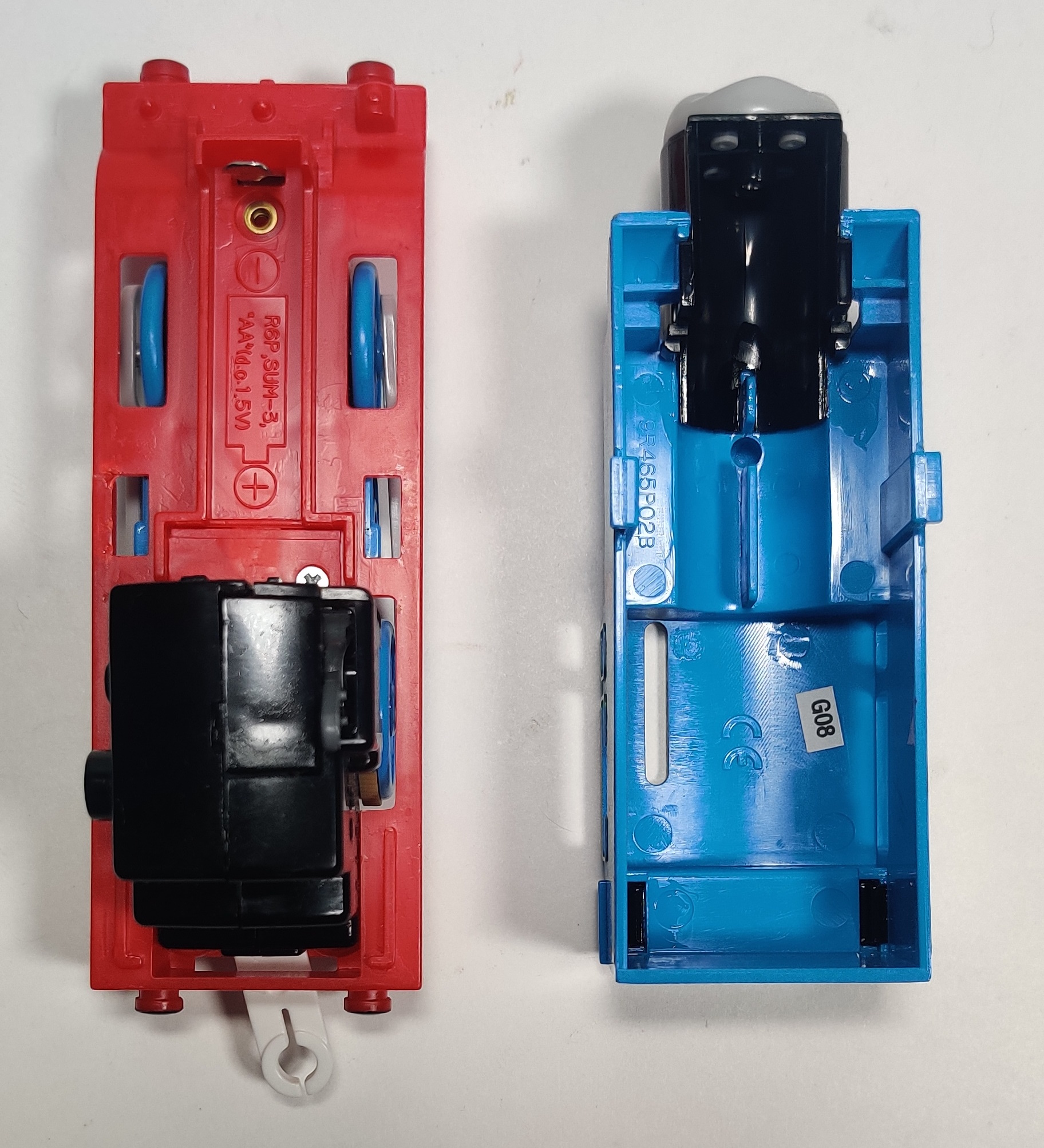
In 2008 for the U.K. Tomy-branded TrackMaster range some of the standard Tomy-made Thomases were produced with red boiler stripes.
Thomas the Tank Engine and Bertie's Competition Set (2008)
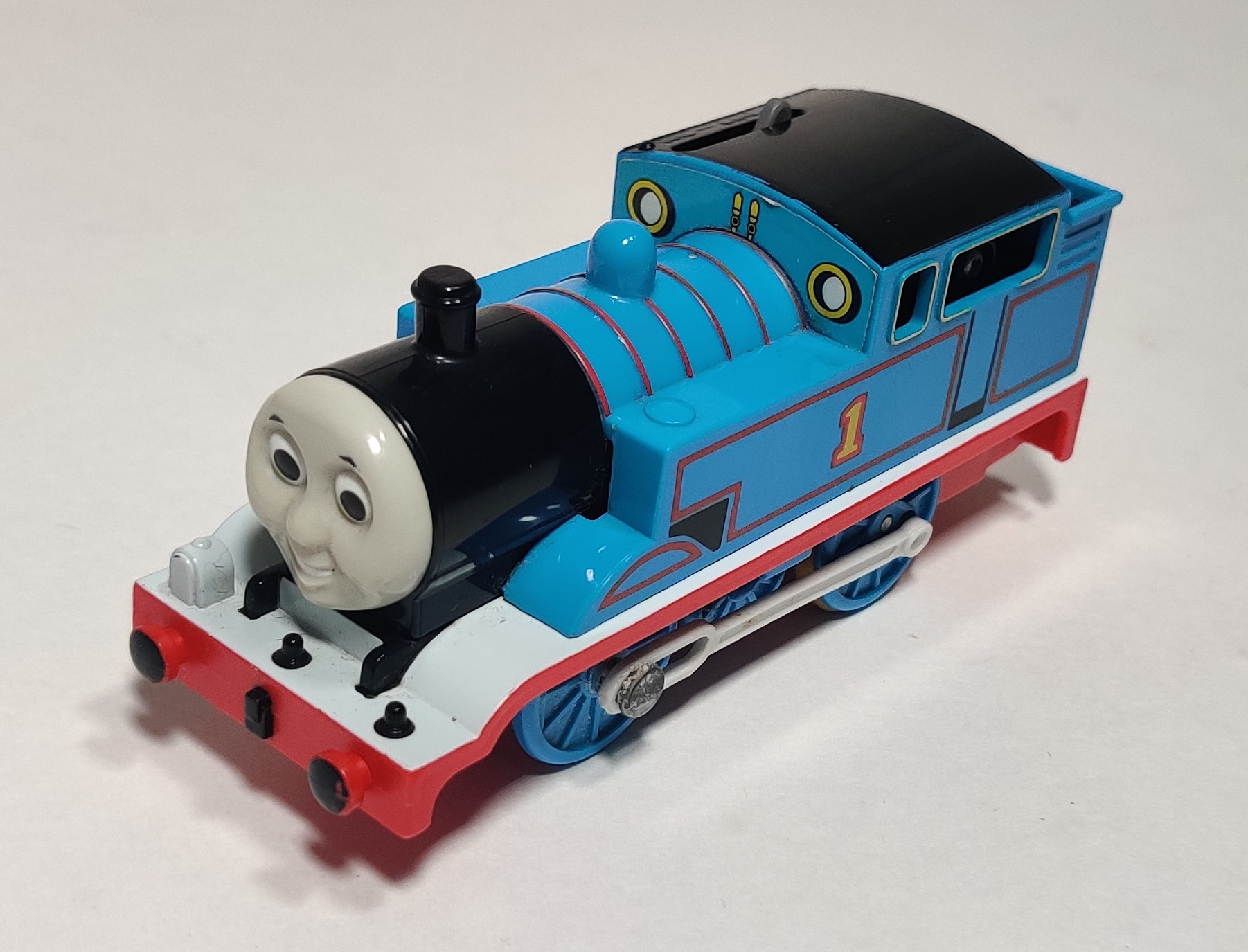
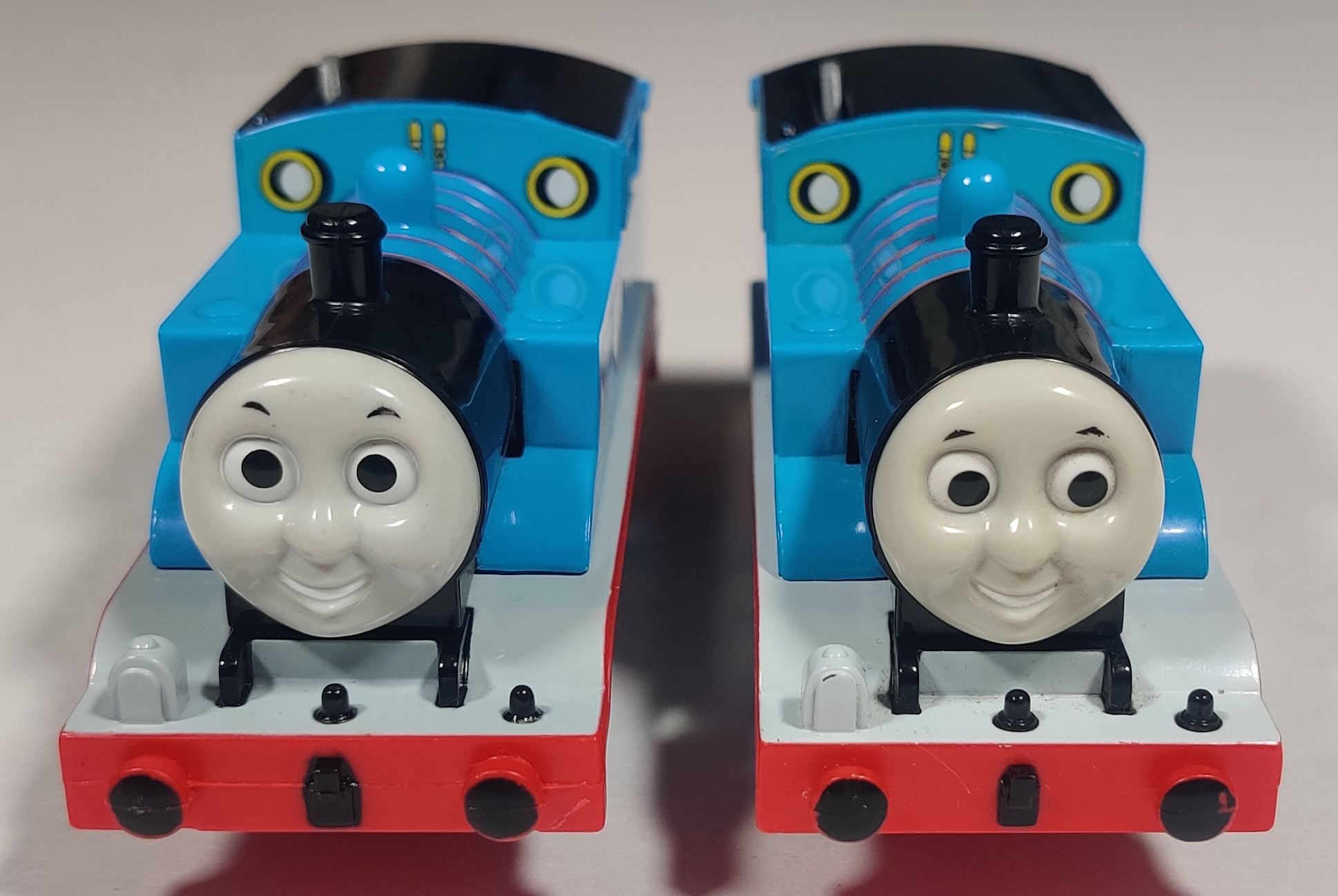
In July 2008 the Thomas the Tank Engine and Bertie's Competition Set included a Thomas looking down to the left, so that he can look over at Bertie while running on the set. This face is very similar to the one used in the Hiro set, with both looking more downcast than the earlier snow-shoveling set Thomas.
Thomas the Tank Engine and Jeremy's Airport (2008)
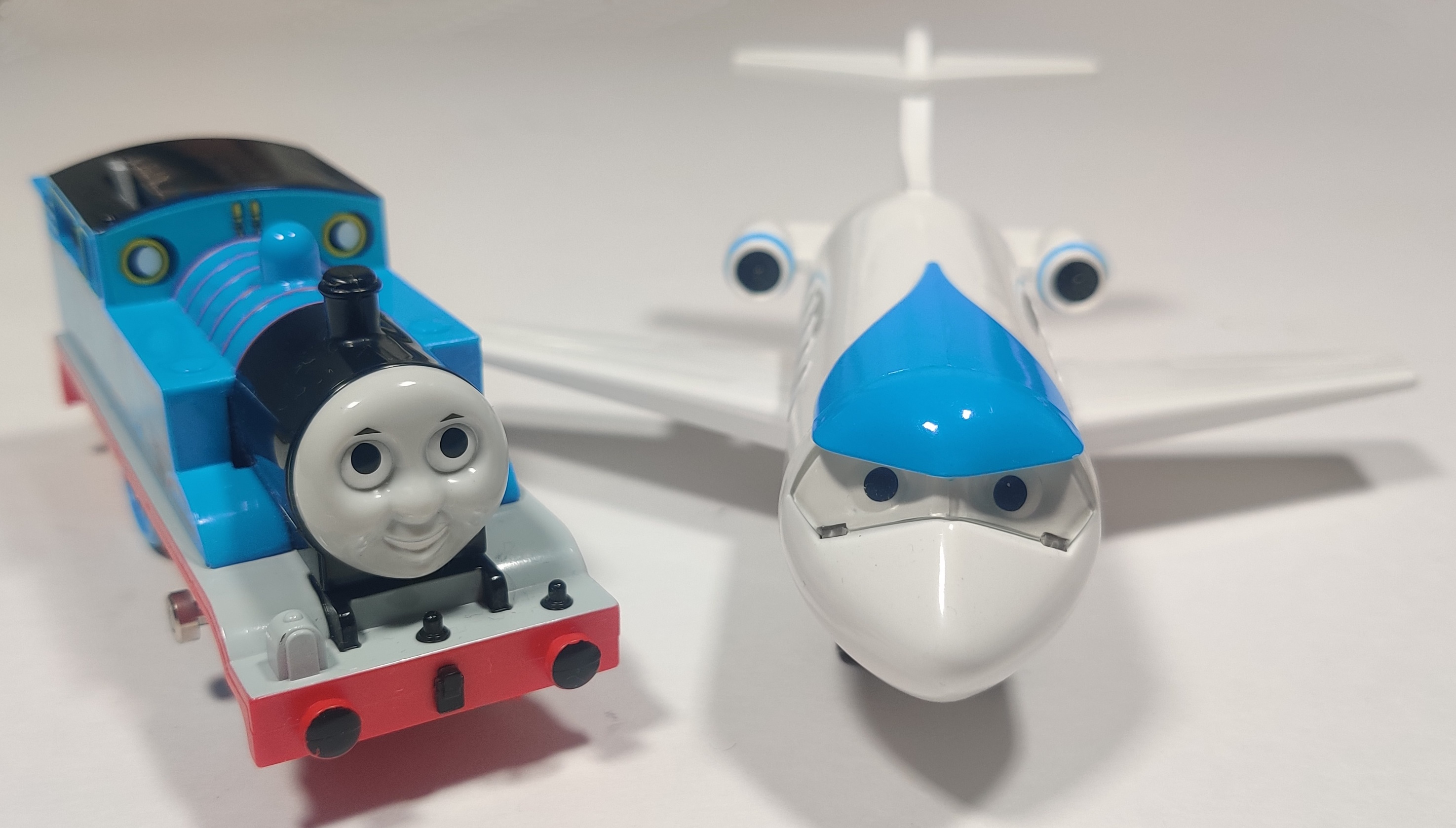
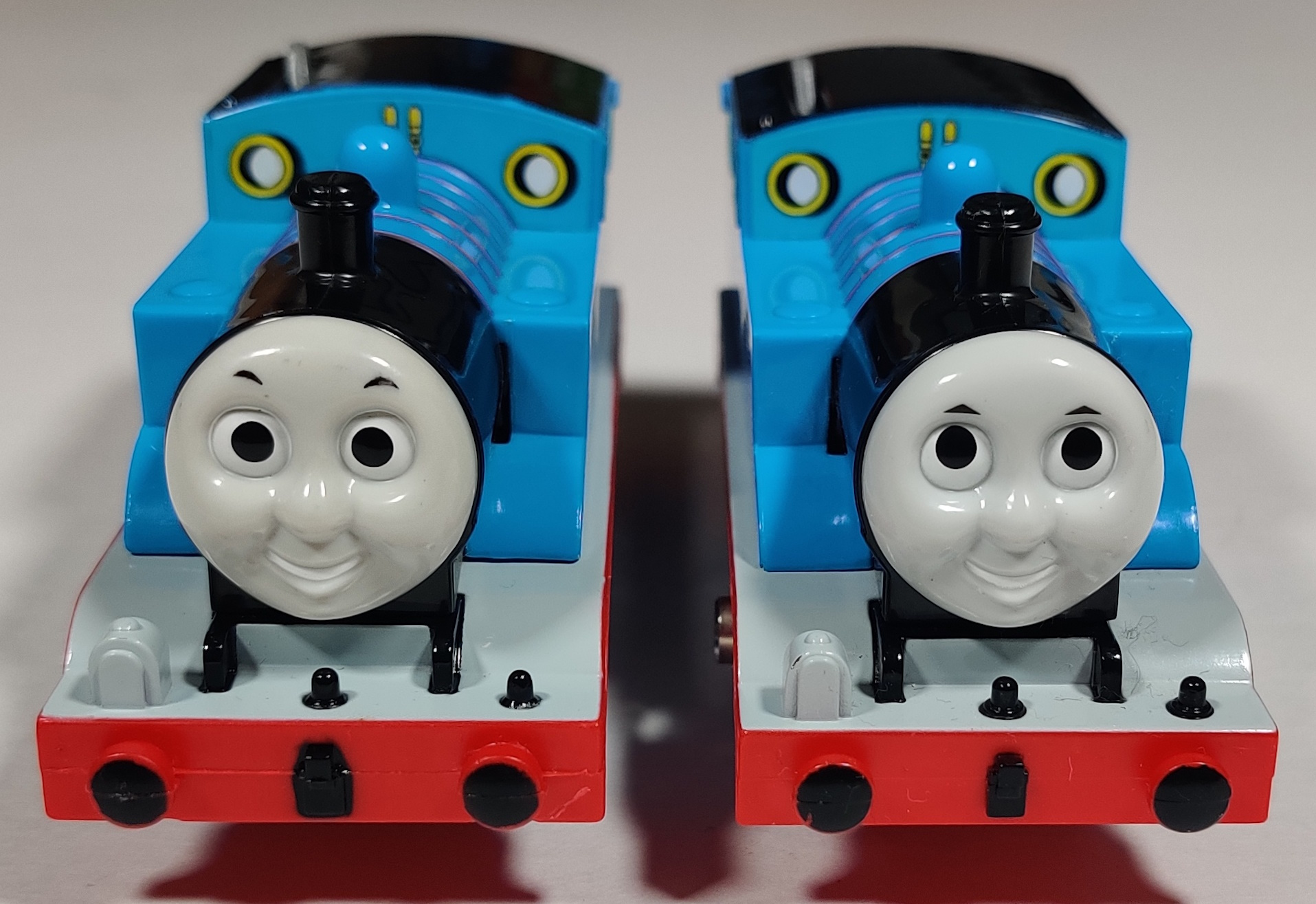
In October 2008 the Thomas the Tank Engine and Jeremy's Airport set was released with a Thomas with lower eyebrows and eyes looking up so he can watch Jeremy the jet "fly."
Thomas the Tank Engine Colorful Turn Rail Set/Thomas the Tank Engine Wobbly Suspension Bridge Set (2009)
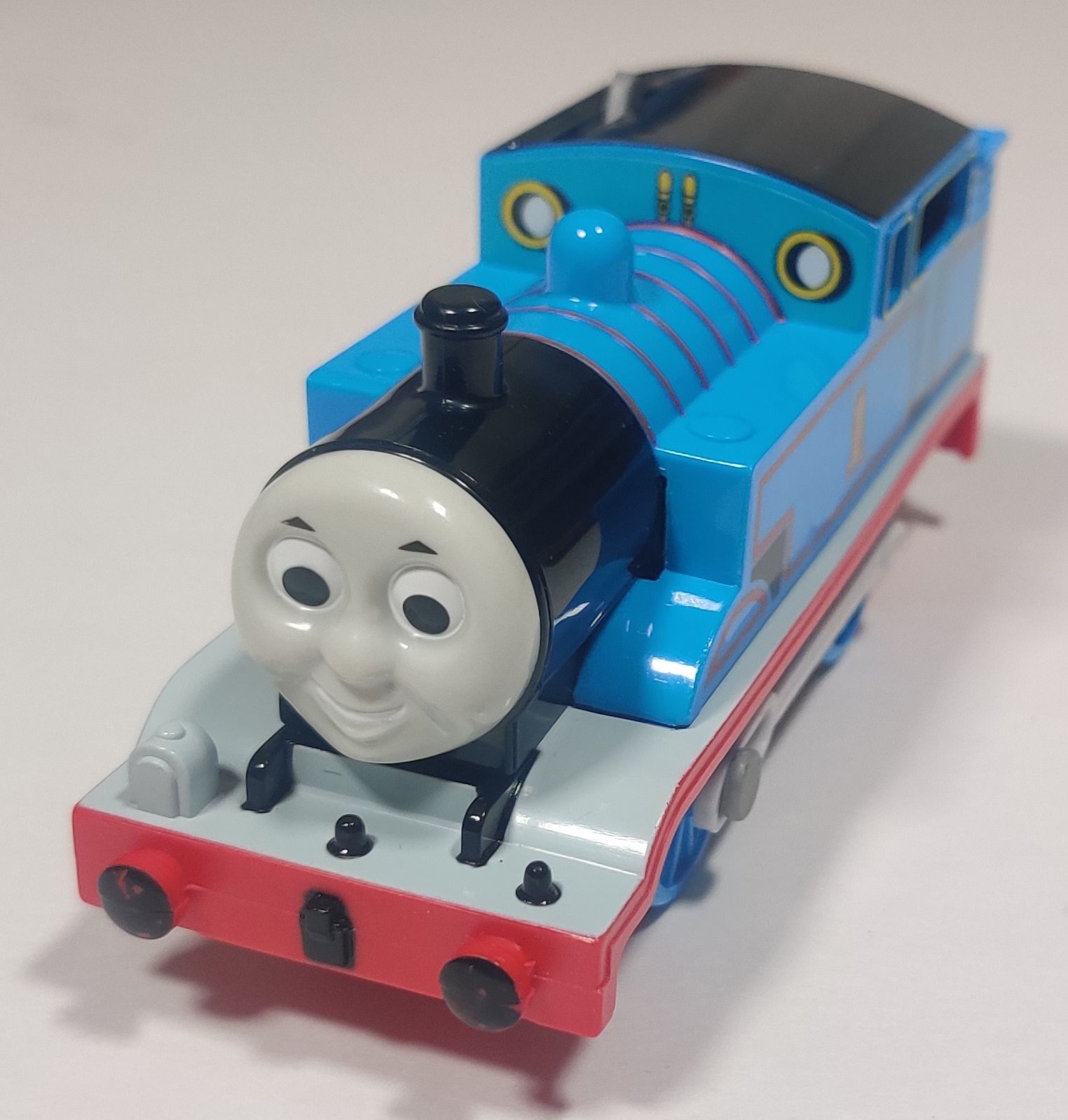
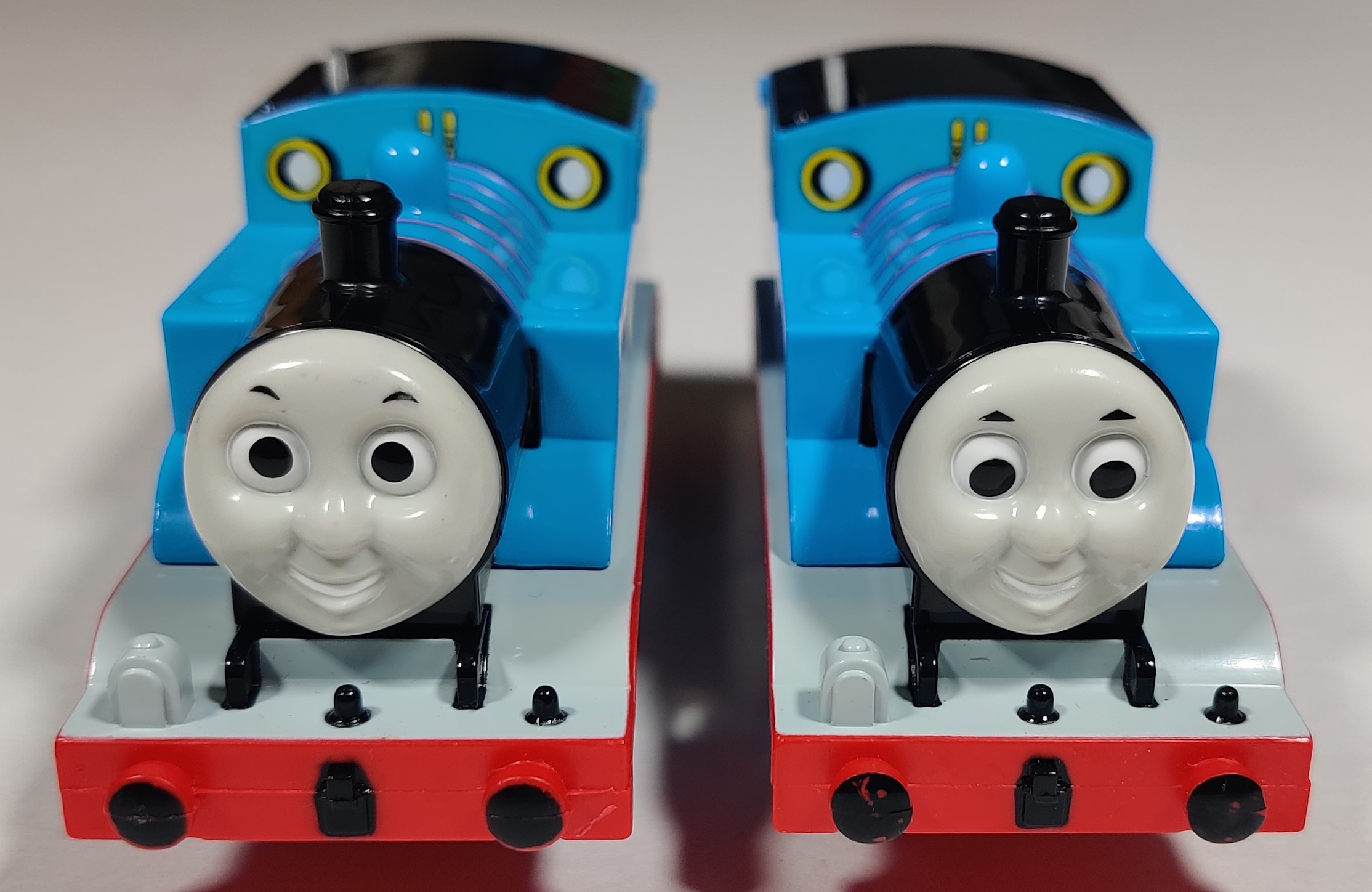
In April 2009 the Thomas the Tank Engine Colorful Turn Rail Set was released with a Thomas looking down towards the rails. This variation of Thomas stayed in production for many years as it was also included in the Thomas the Tank Engine Wobbly Suspension Bridge Set in July 2009, with this set staying in production until 2020 when an updated color variation of the set was released with a surprised CGI face Thomas, also looking downwards.
Departing From the Station! Hiro and Thomas the Tank Engine Set (2010)
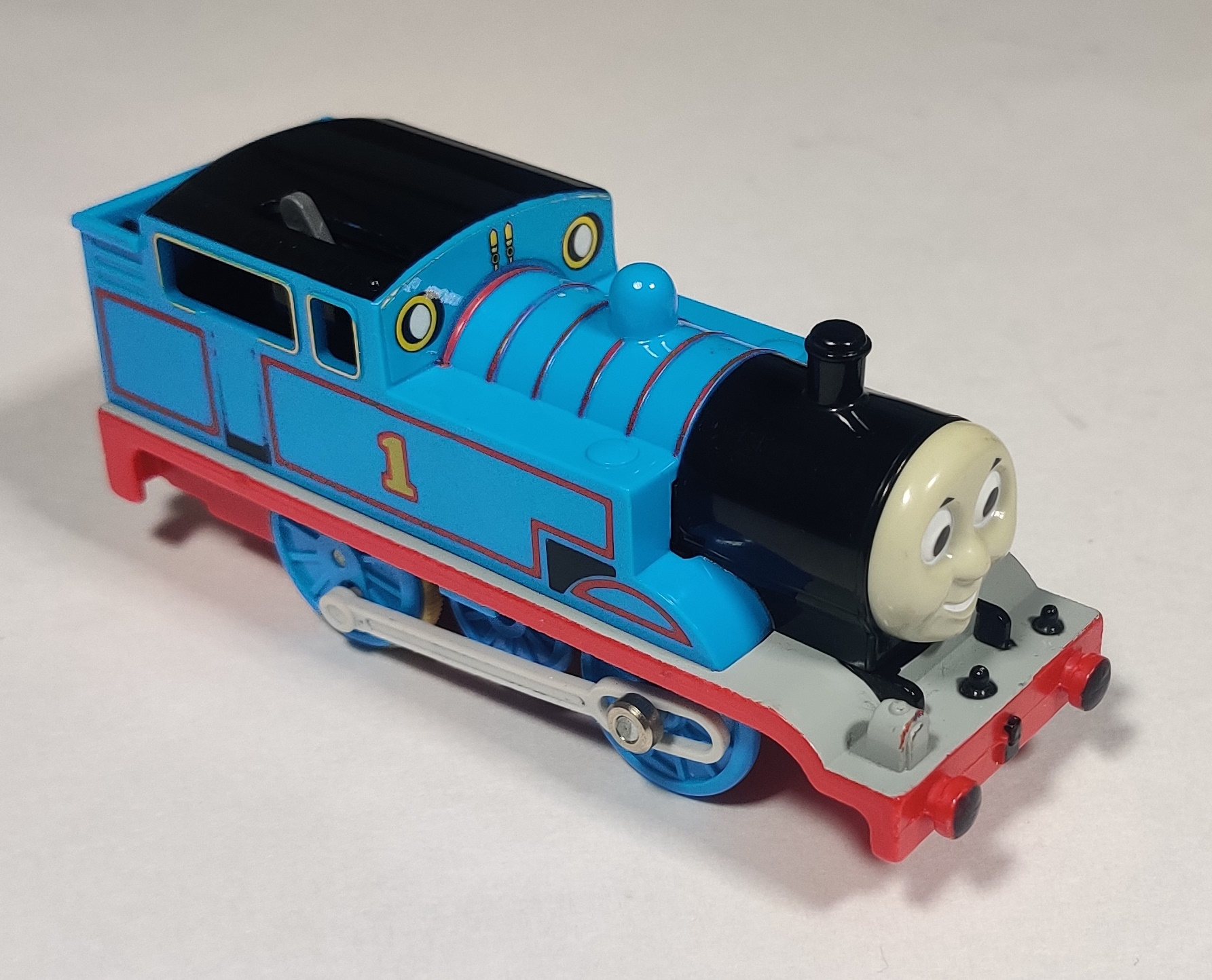
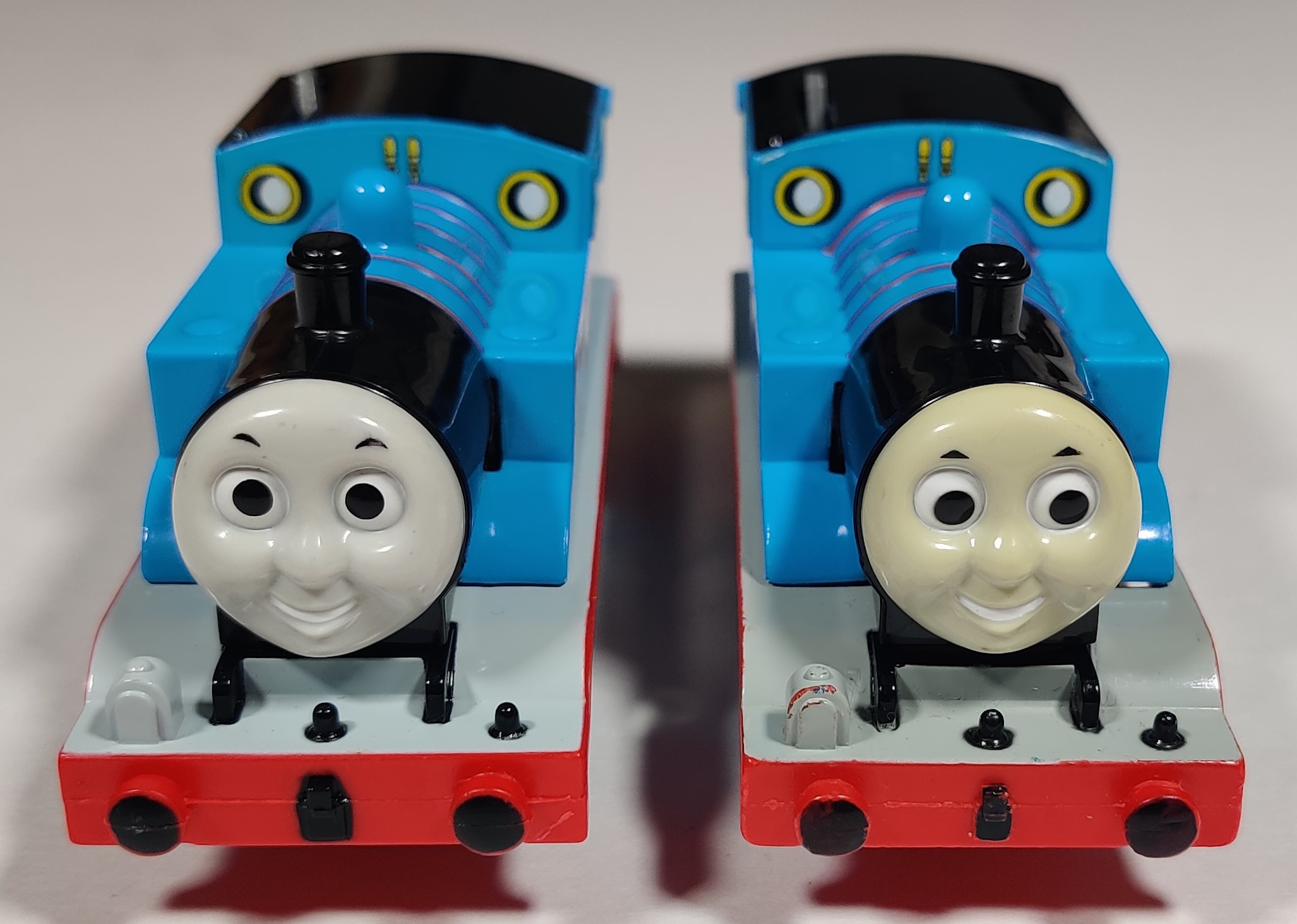
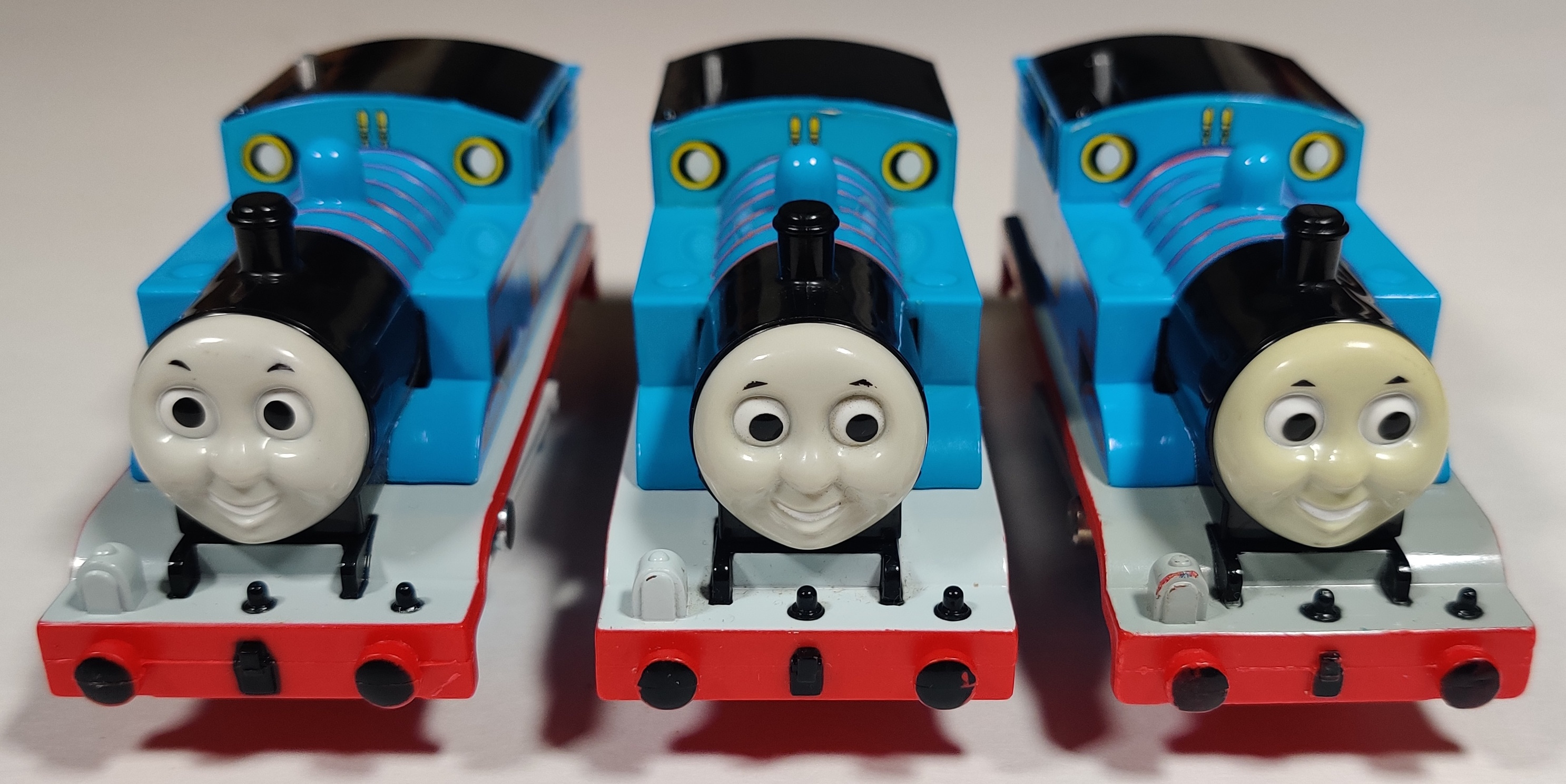
A variant very similar to the Thomas the Tank Engine and Bertie's Competition Set variation (shown in the middle on the rightmost photo) was used in the Departing From the Station! Hiro and Thomas the Tank Engine Set, with eyes looking down and to the left. These Thomases were produced circa March 2010 for the set and overlap in production period with the Wobbly Bridge Thomas shown above. My example's face is yellowed.
Thomas 65th Anniversary Birthday Parade Wagon Set (2010)
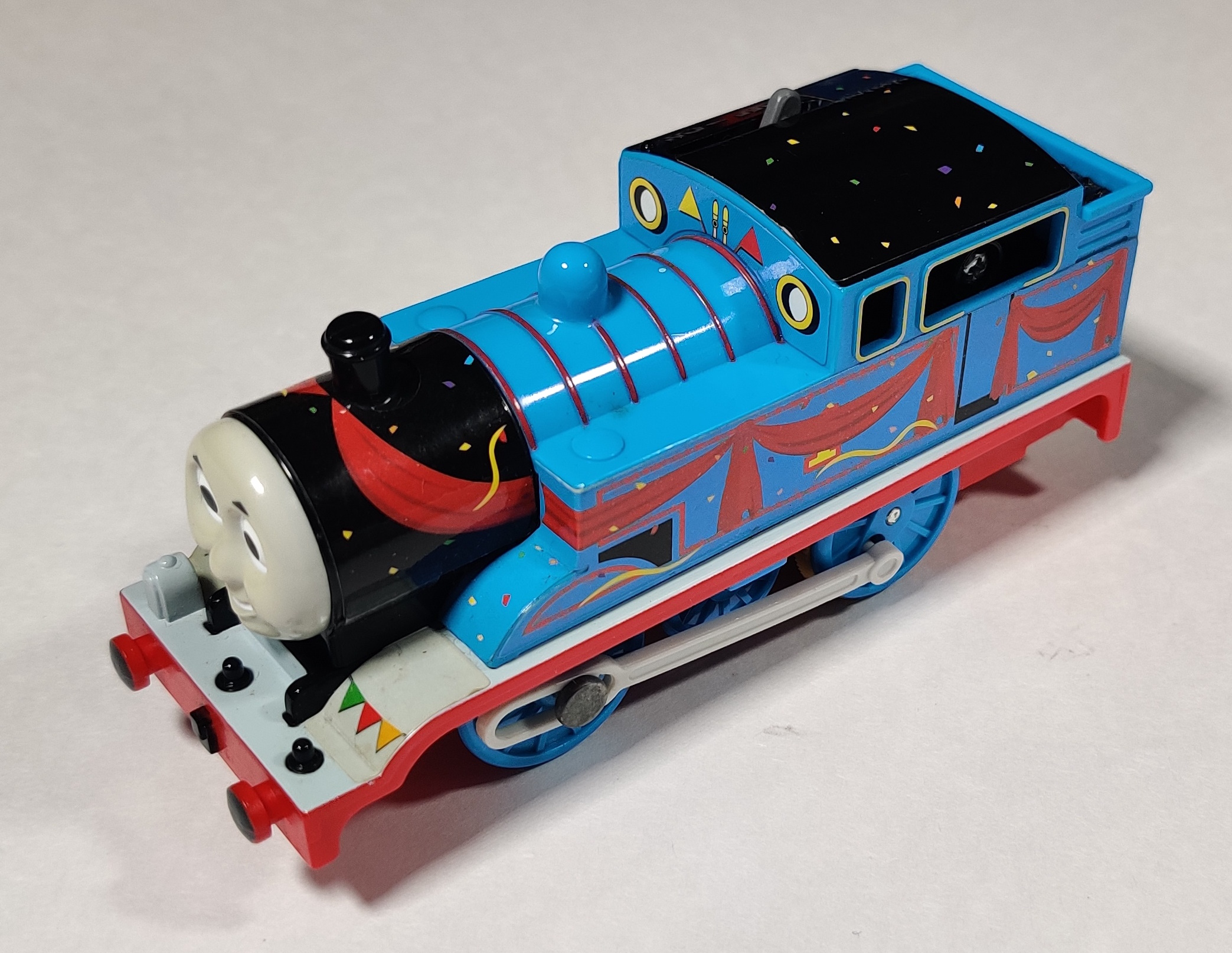
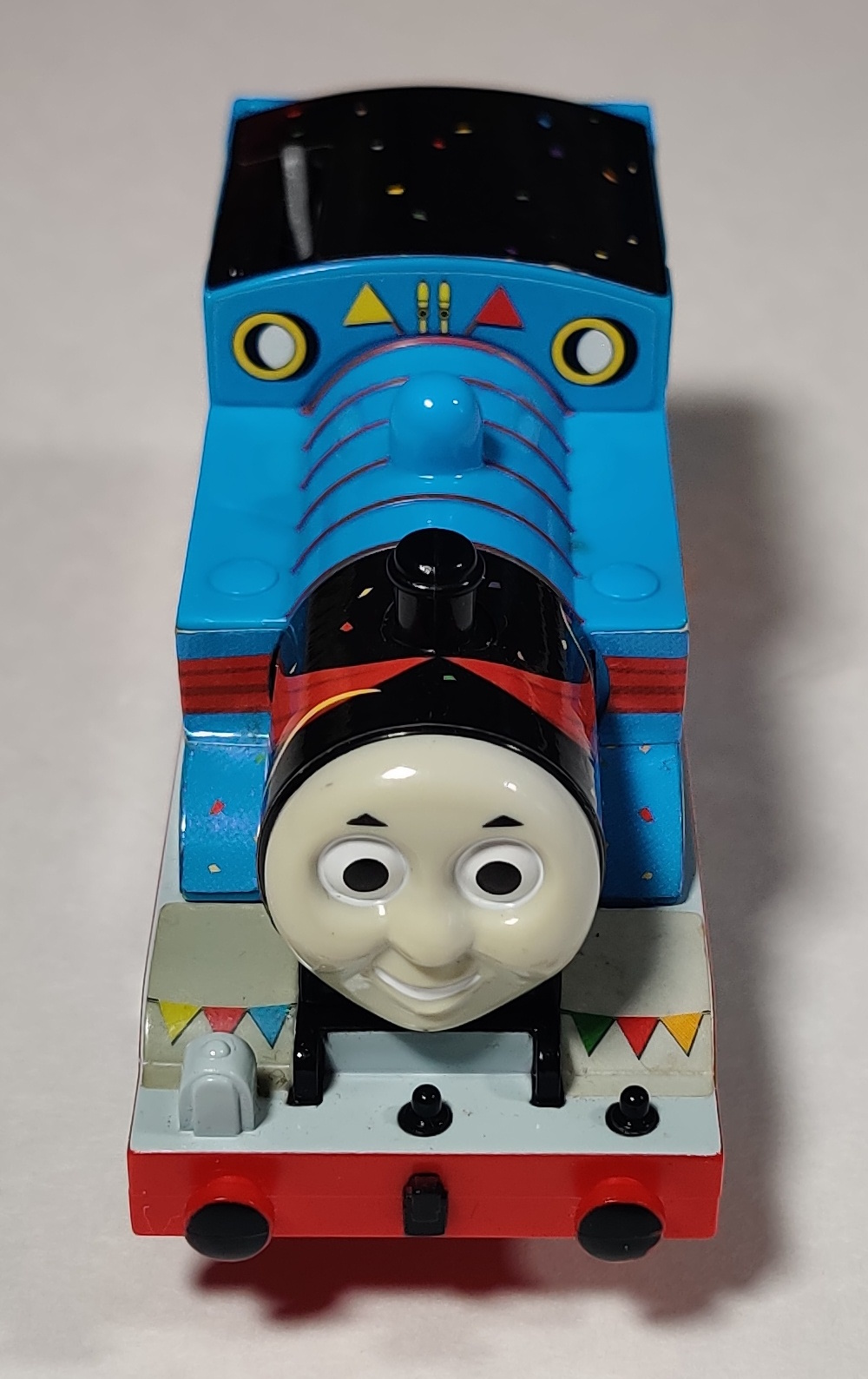
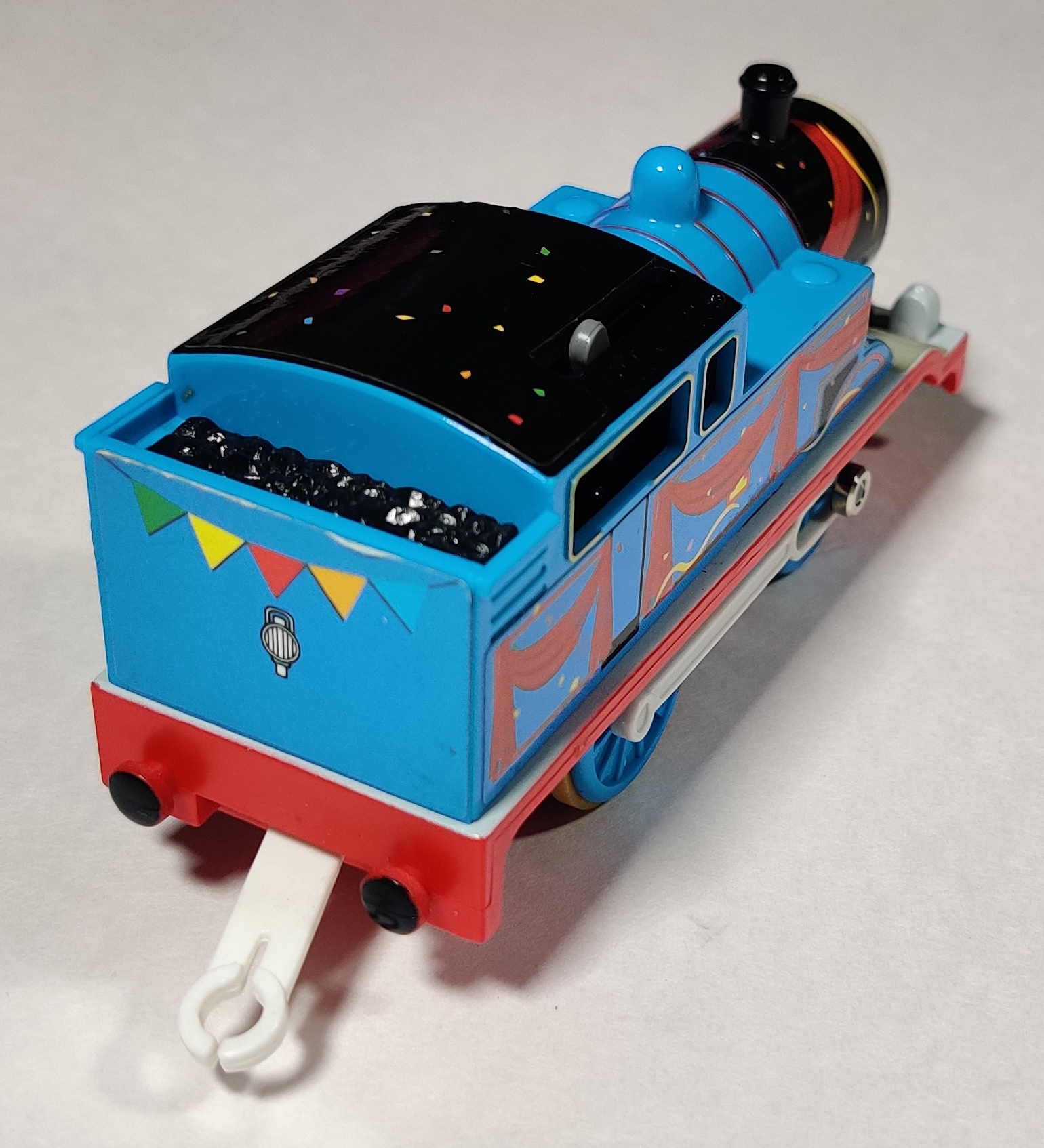
As part of the 65th anniversary of the Railway Series books, the Thomas 65th Anniversary Birthday Parade Wagon Set included a standard Thomas with banners and confetti stickers applied over it.
Thomas the Tank Engine Exciting Cruise Set (2010)
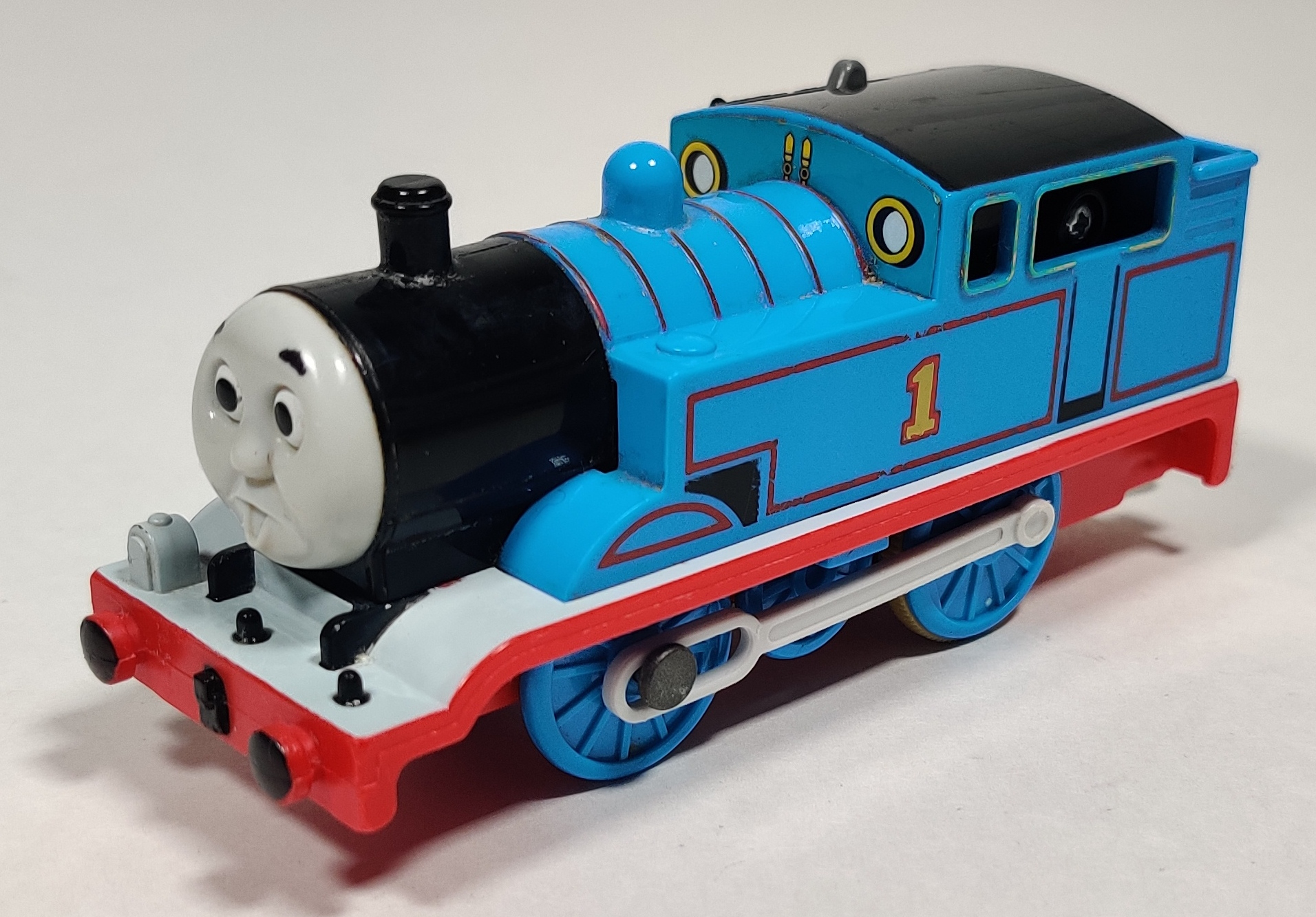
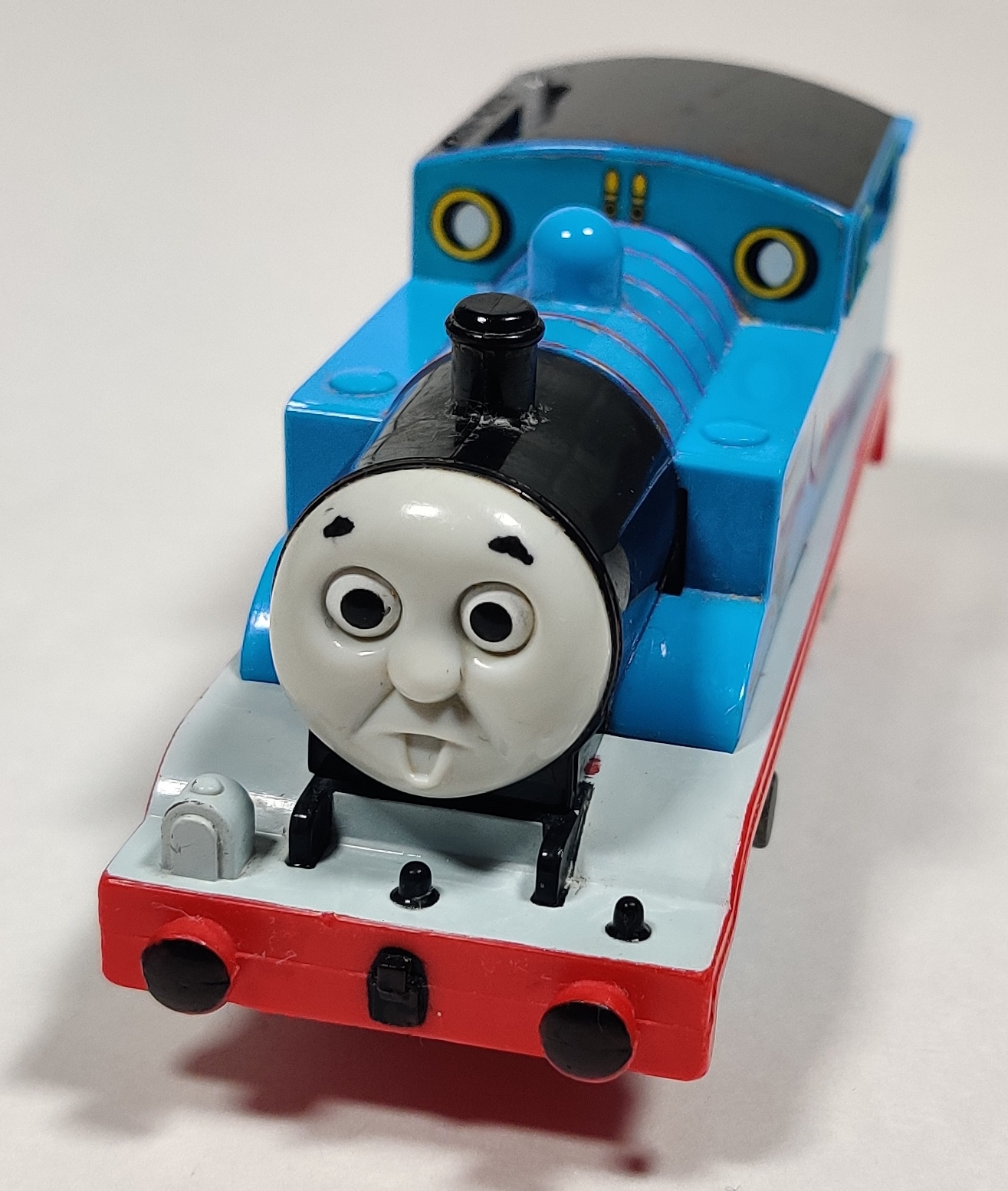
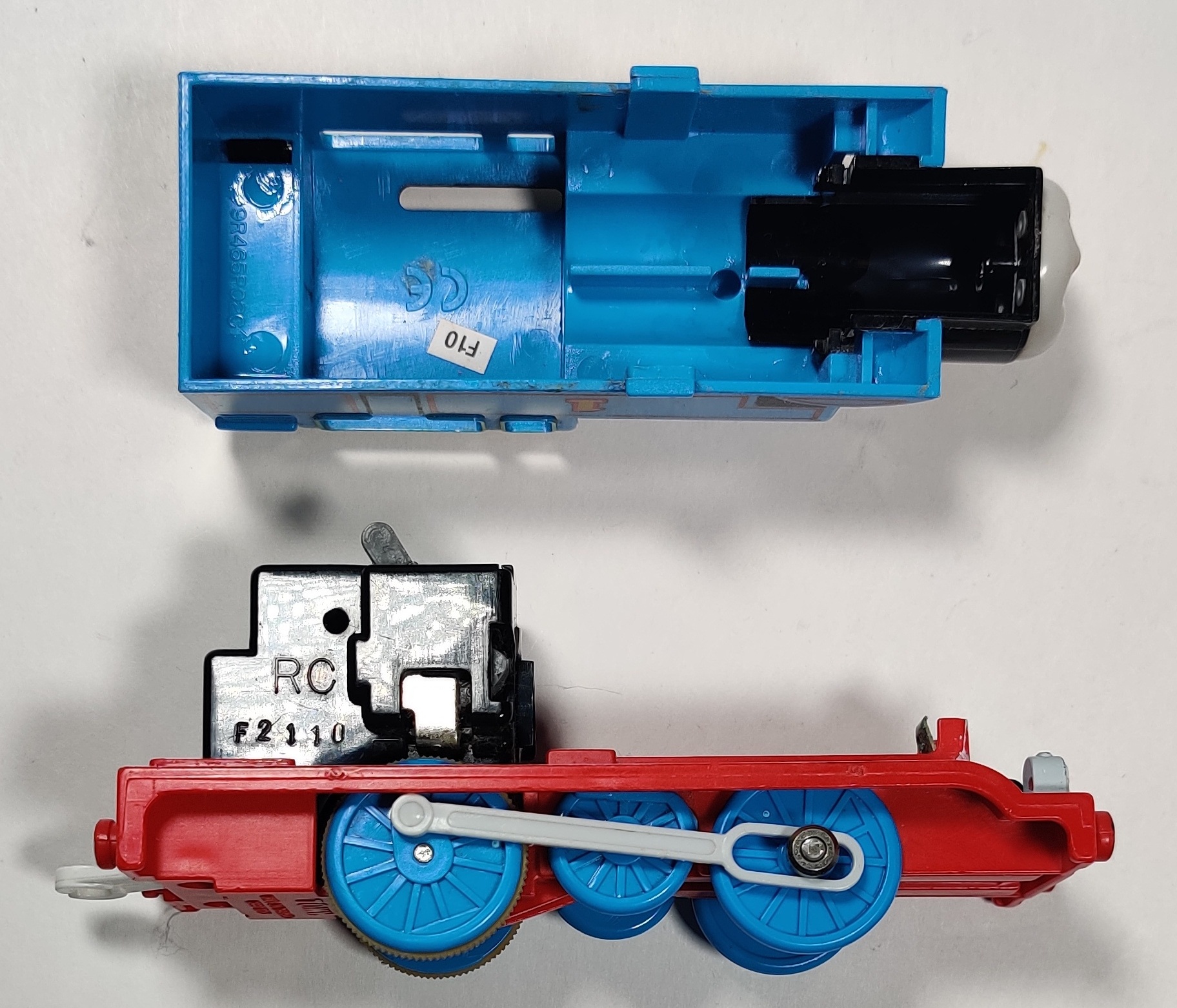
In July 2010 the Thomas the Tank Engine Exciting Cruise Set included a surprised-face Thomas that is looking straight ahead, as opposed to the Jet Engine and Doki Doki Mountain Thomases that look downwards.
Let's Run Together! Fire-Engine Flynn and Thomas Set (Vietnam production) (2012)
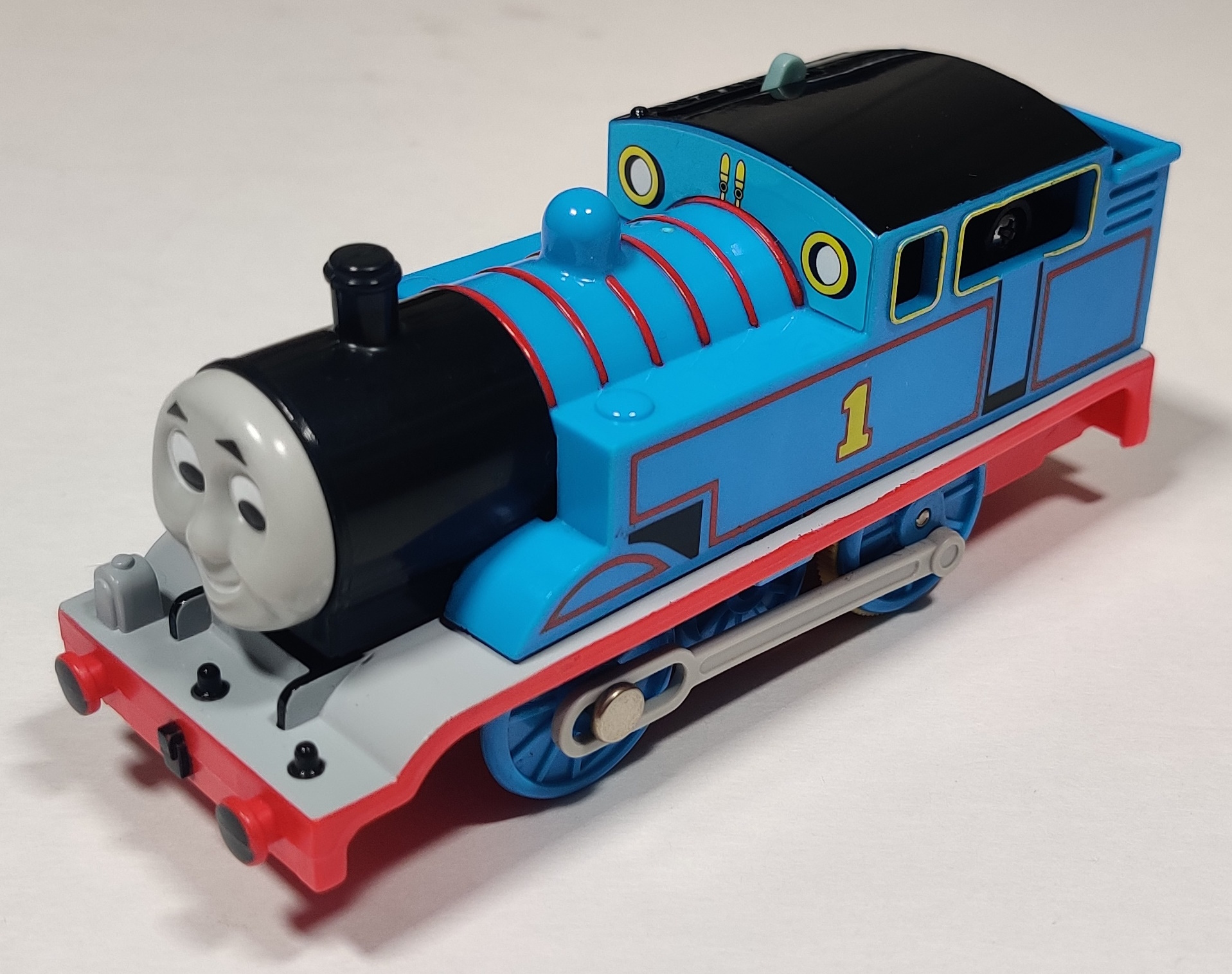
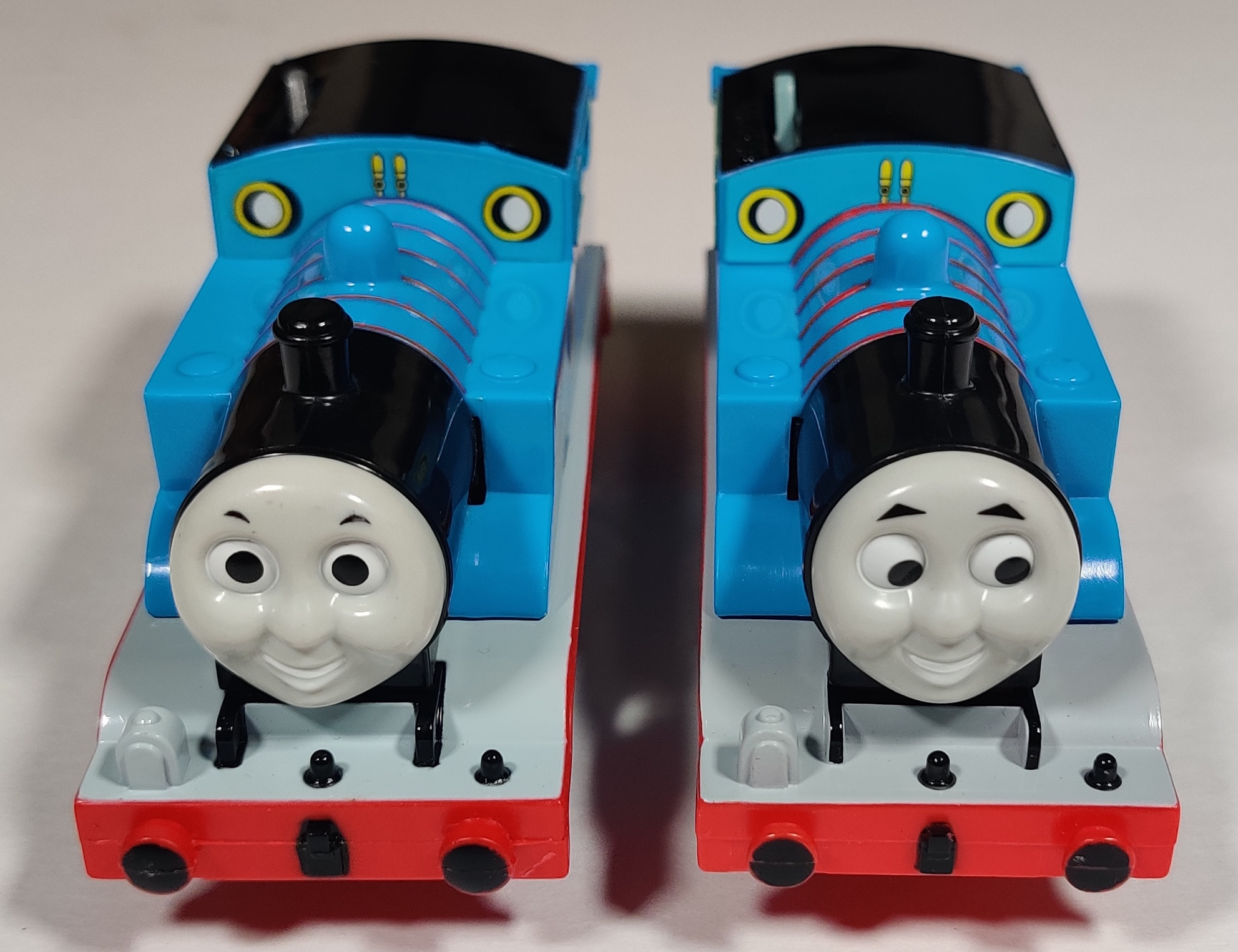
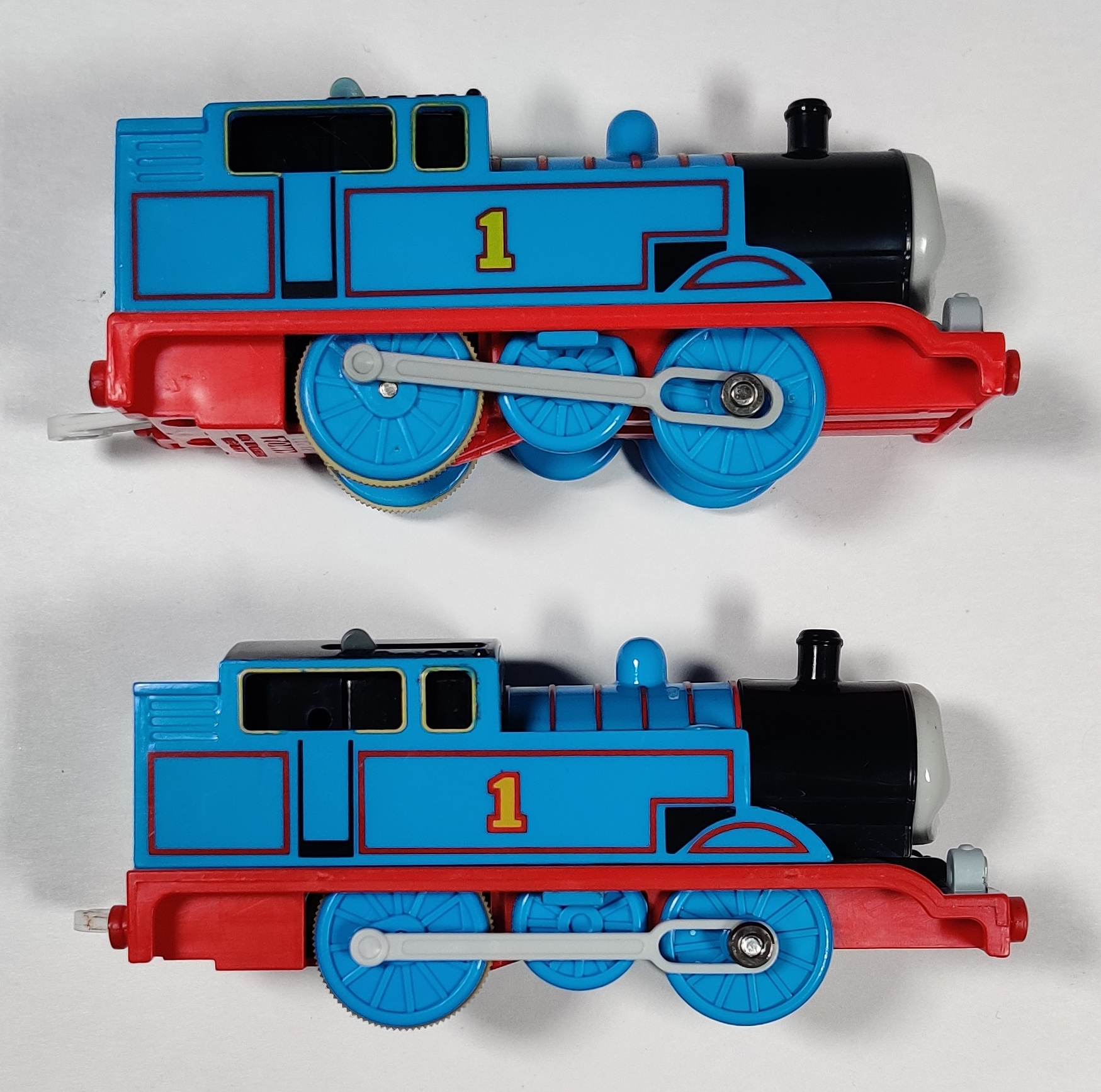
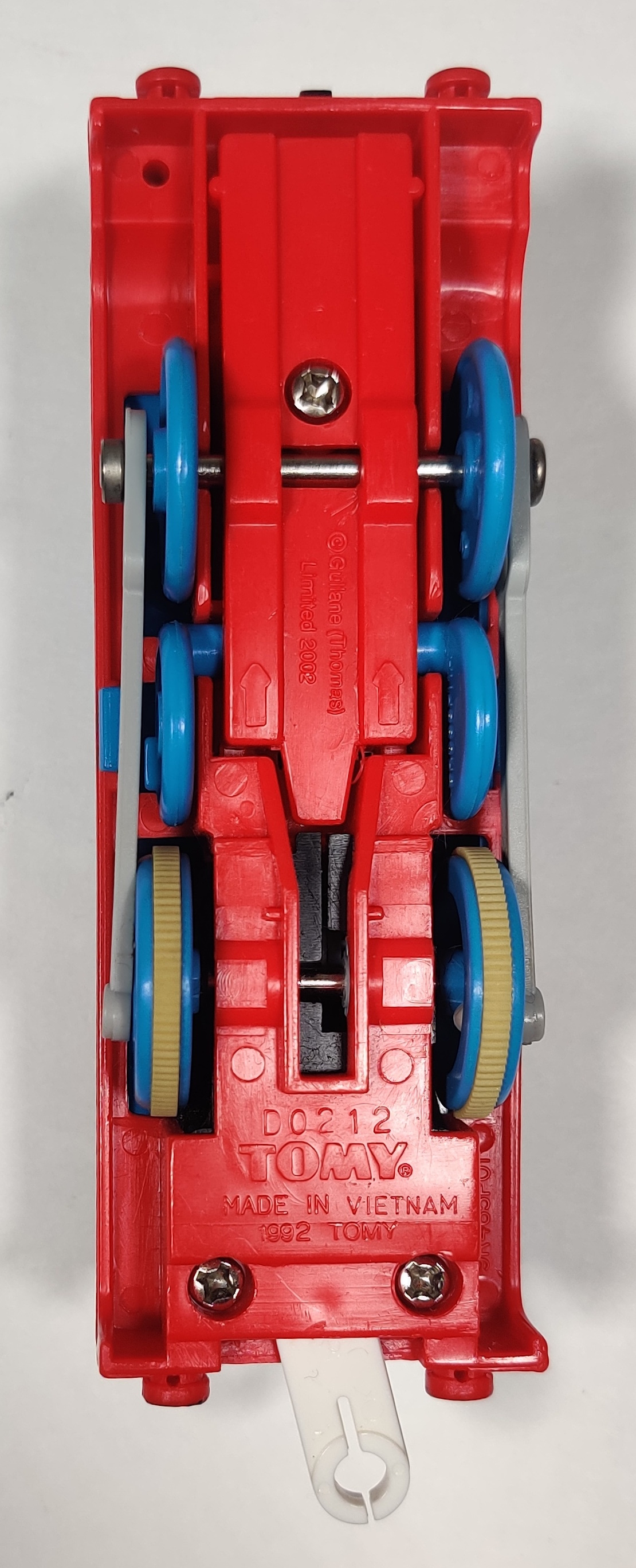
In 2012 for the Let's Run Together! Fire-Engine Flynn and Thomas Set some Thomases were produced in Vietnam along with the entire rest of the contents of the set. This seems to have been somewhat of a trial for producing Thomas Plarail and Plarail in general in Vietnam, something Tomy began to do increasingly in the 2010s. Some future Thomas-series releases were produced in Vietnam, although Thomas continued to be produced in Thailand. These Thomases are looking left and a little down and have larger eyebrows than previous types. Other production changes from the regular Thomas include different application of the painted on the boiler stripes, slightly different designs to the printed side details, and a lightish blue power switch instead of the usual grey as well as the Made in Vietnam markings.
TS-01 Plarail Thomas (2012)
In 2012 the Thomas-series Plarail train boxes were reformatted in new CGI packaging and the new "TS" numbering scheme. Thomas, of course, was number 01. Thomas' face would not be updated to a CGI-based tooling until the 2018 range refresh.
Thomas and Percy Knapford Station Set (2012)
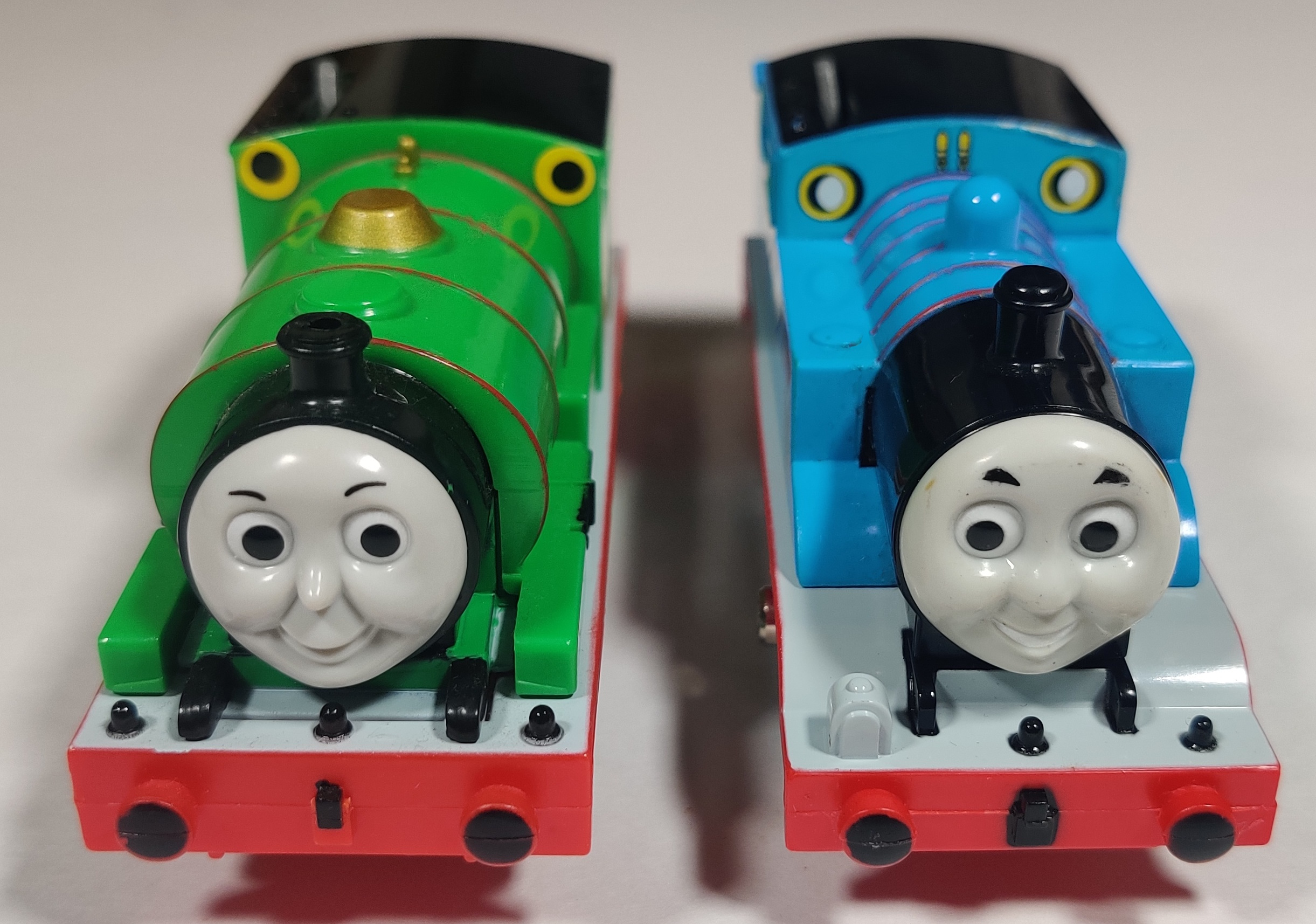
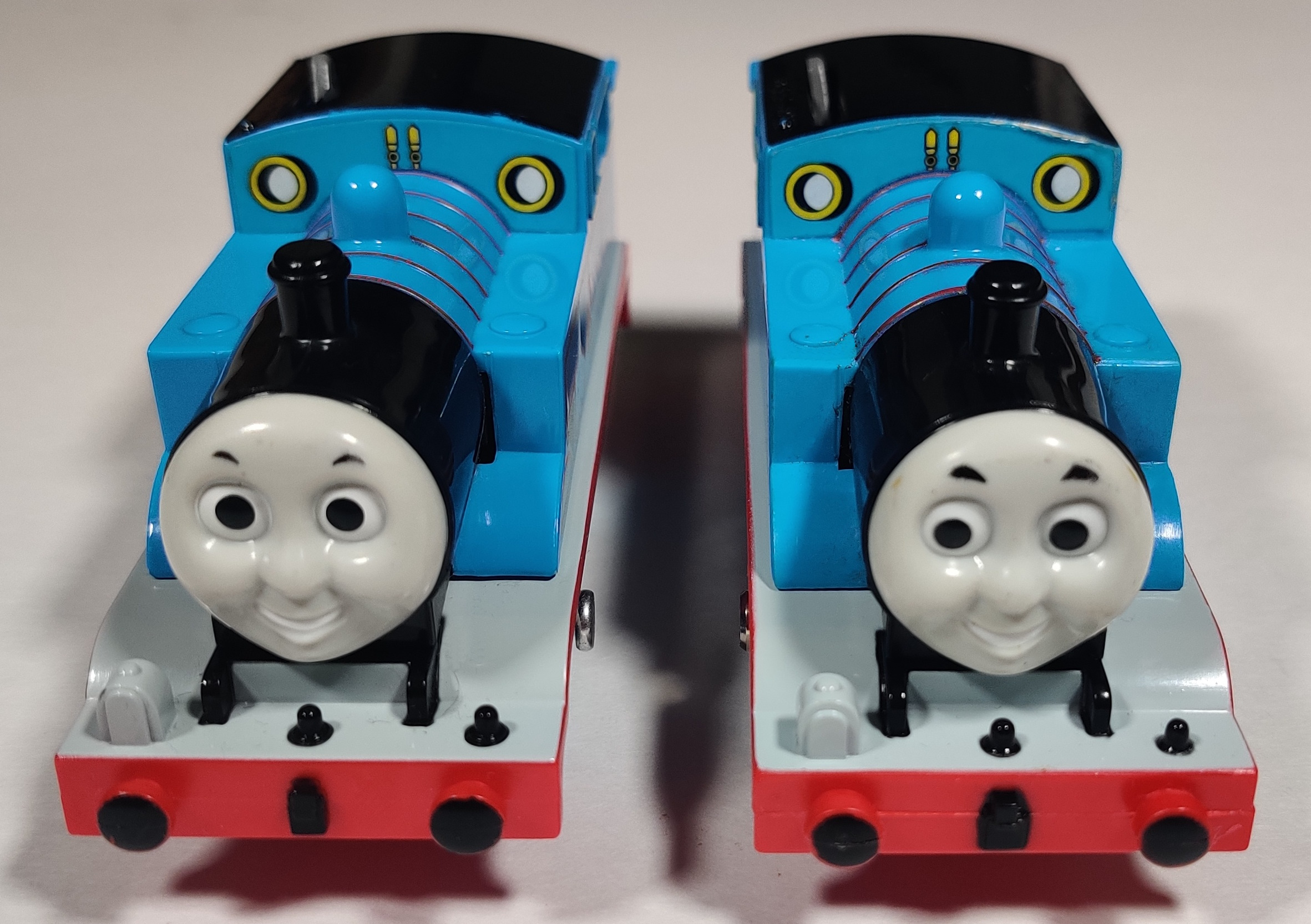
In later 2012 the Thomas and Percy Knapford Station Set included a Thomas looking to the right so that he and the Percy in the set can look at each other.
Thomas the Tank Engine Bumpy Pass Set (2013)
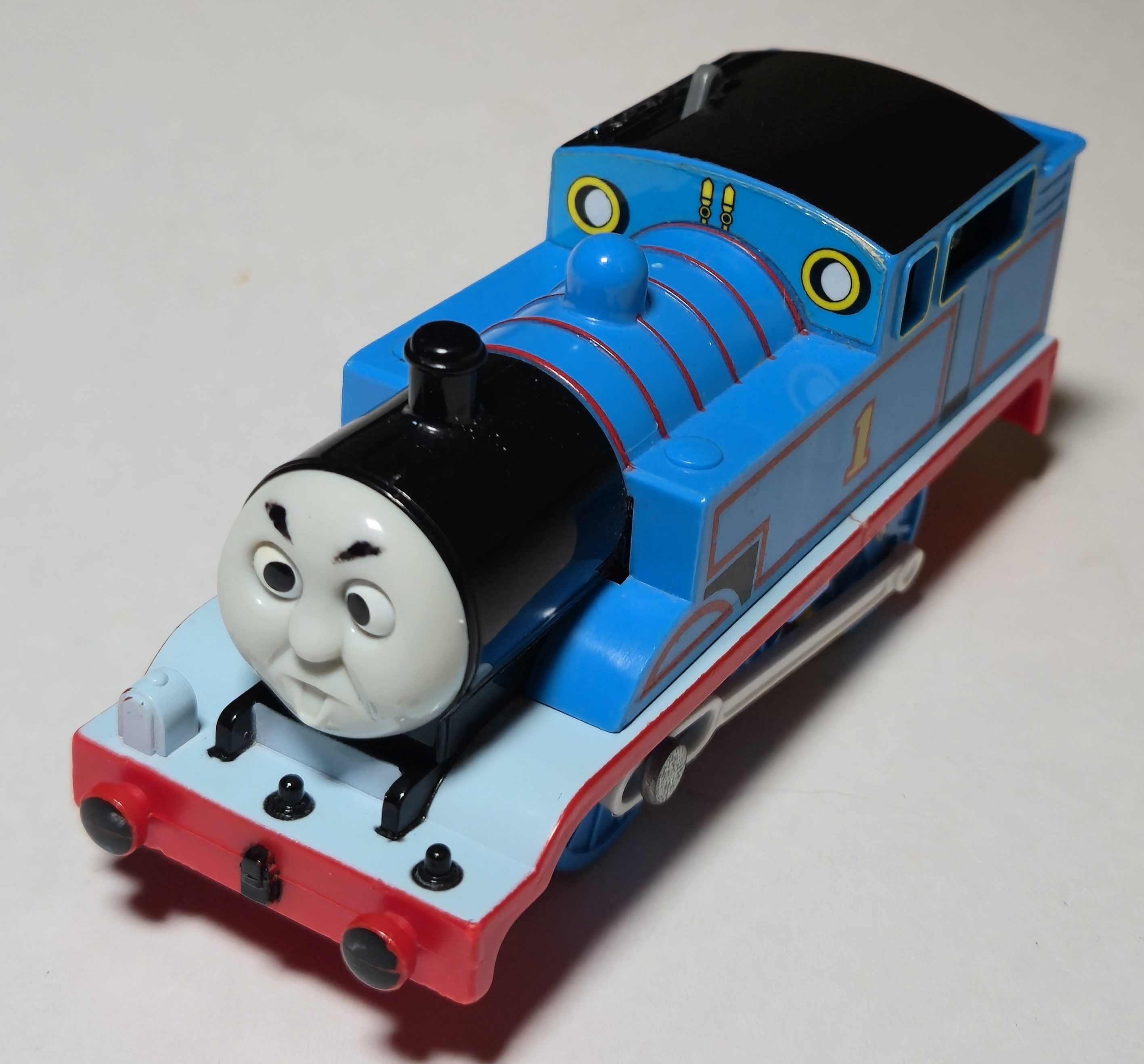
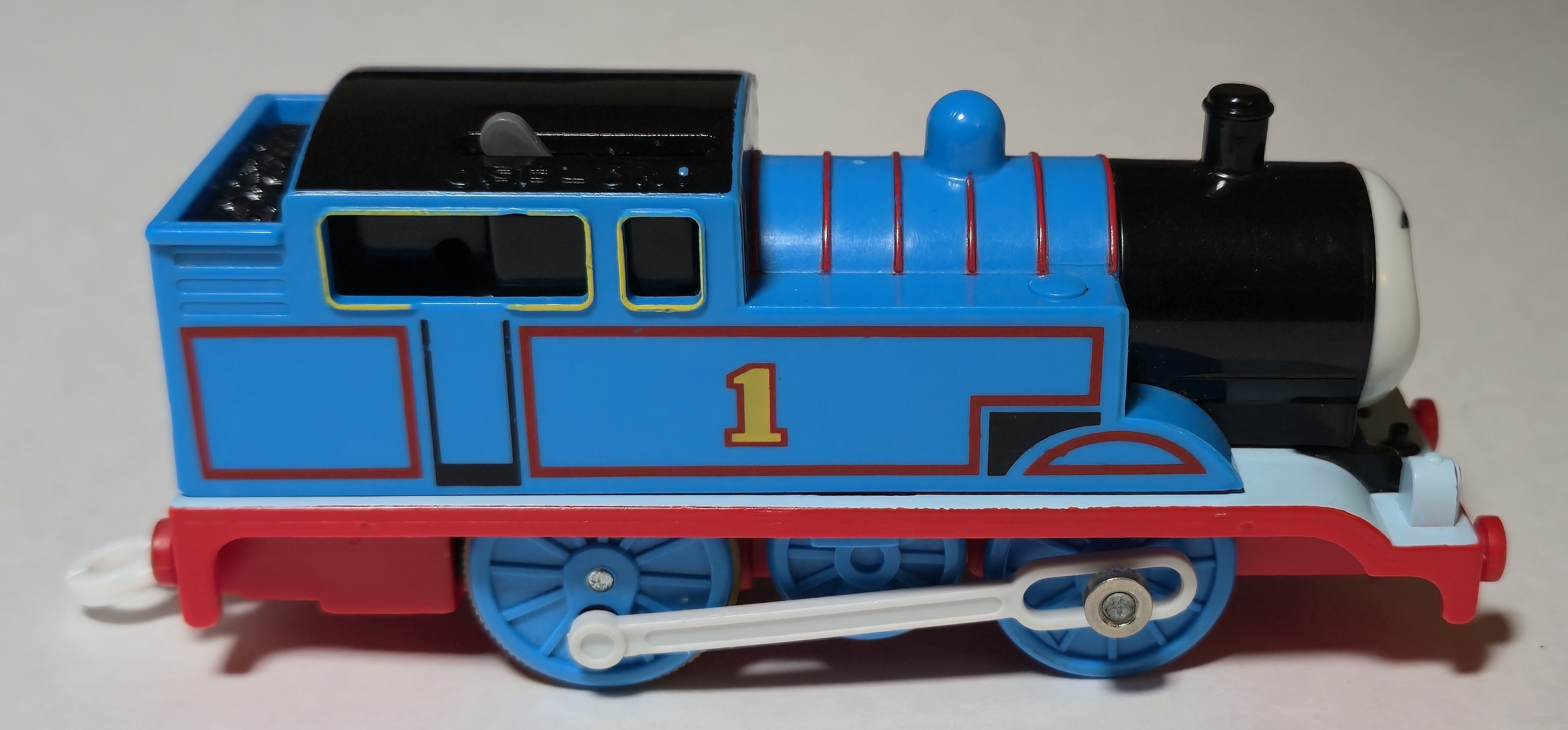
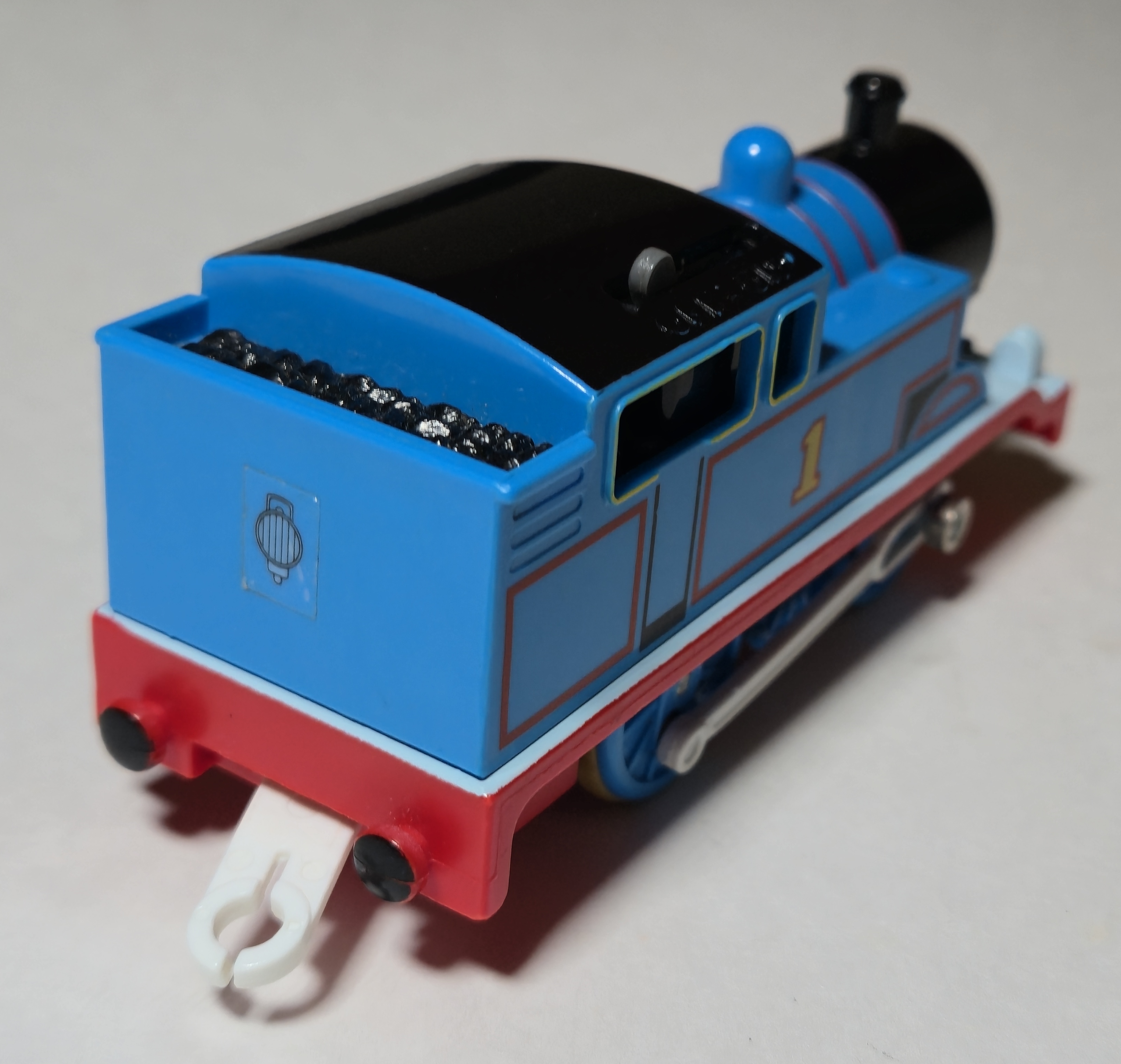
In August 2013 the Thomas the Tank Engine Bumpy Pass Set included the surprised-face Thomas tooling used several times before but with crossed eyes and thicker eyebrows. During this production era, the running board paint was noticeably more blue.
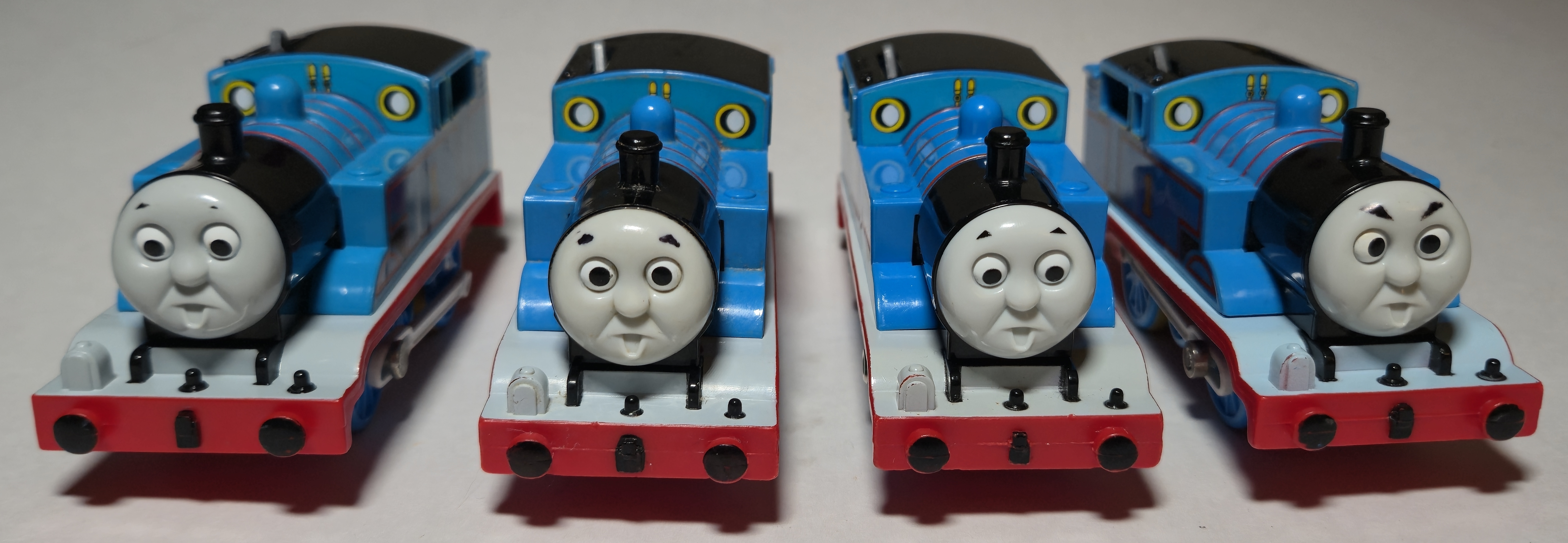
Here, from left to right in order of production, is a Jet Engine Thomas, an Exciting Cruse Set Thomas, a Doki Doki Mountain Set Thomas, and the Bumpy Pass Thomas.
TS-01 Plarail Thomas (2018)

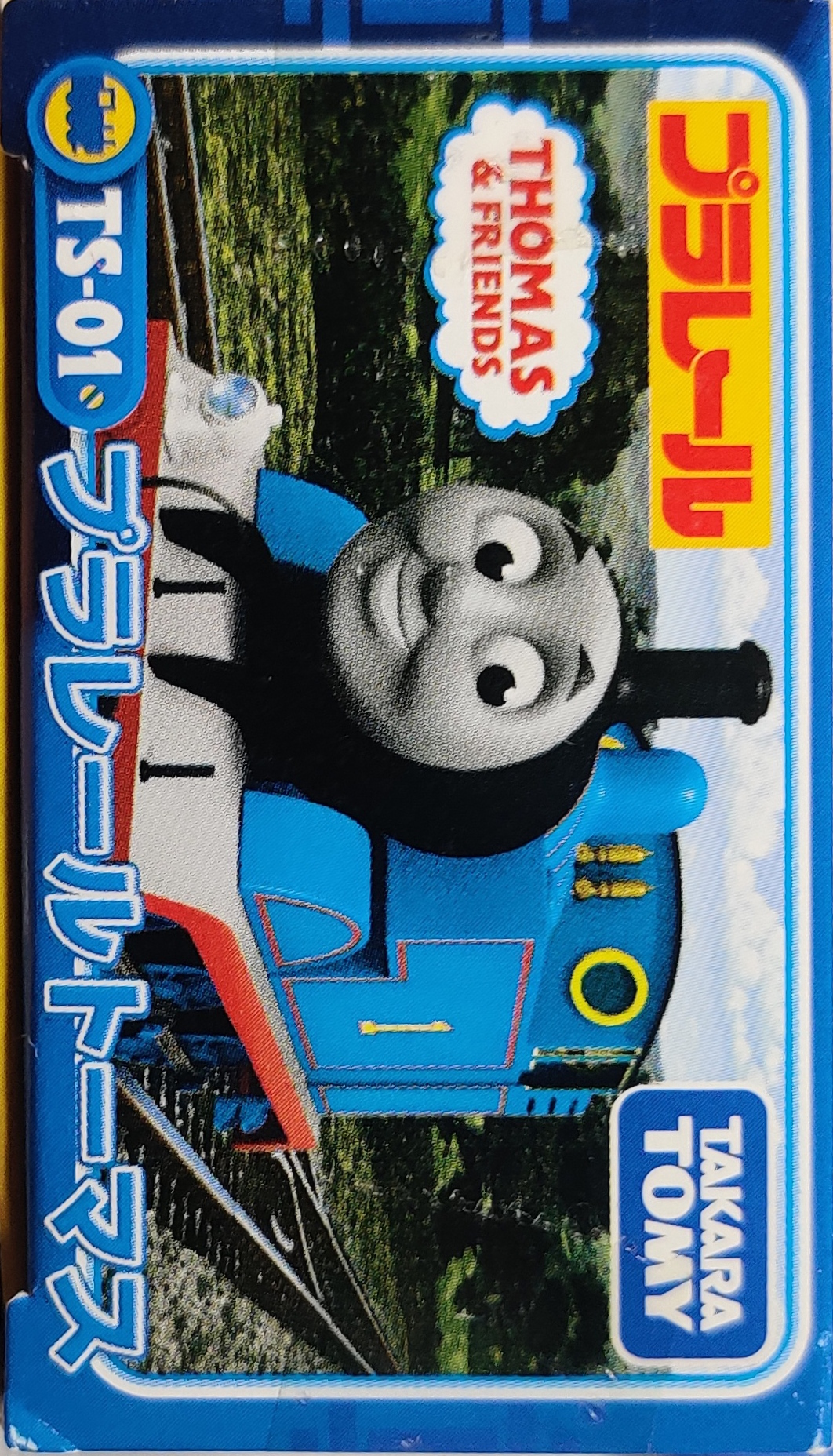

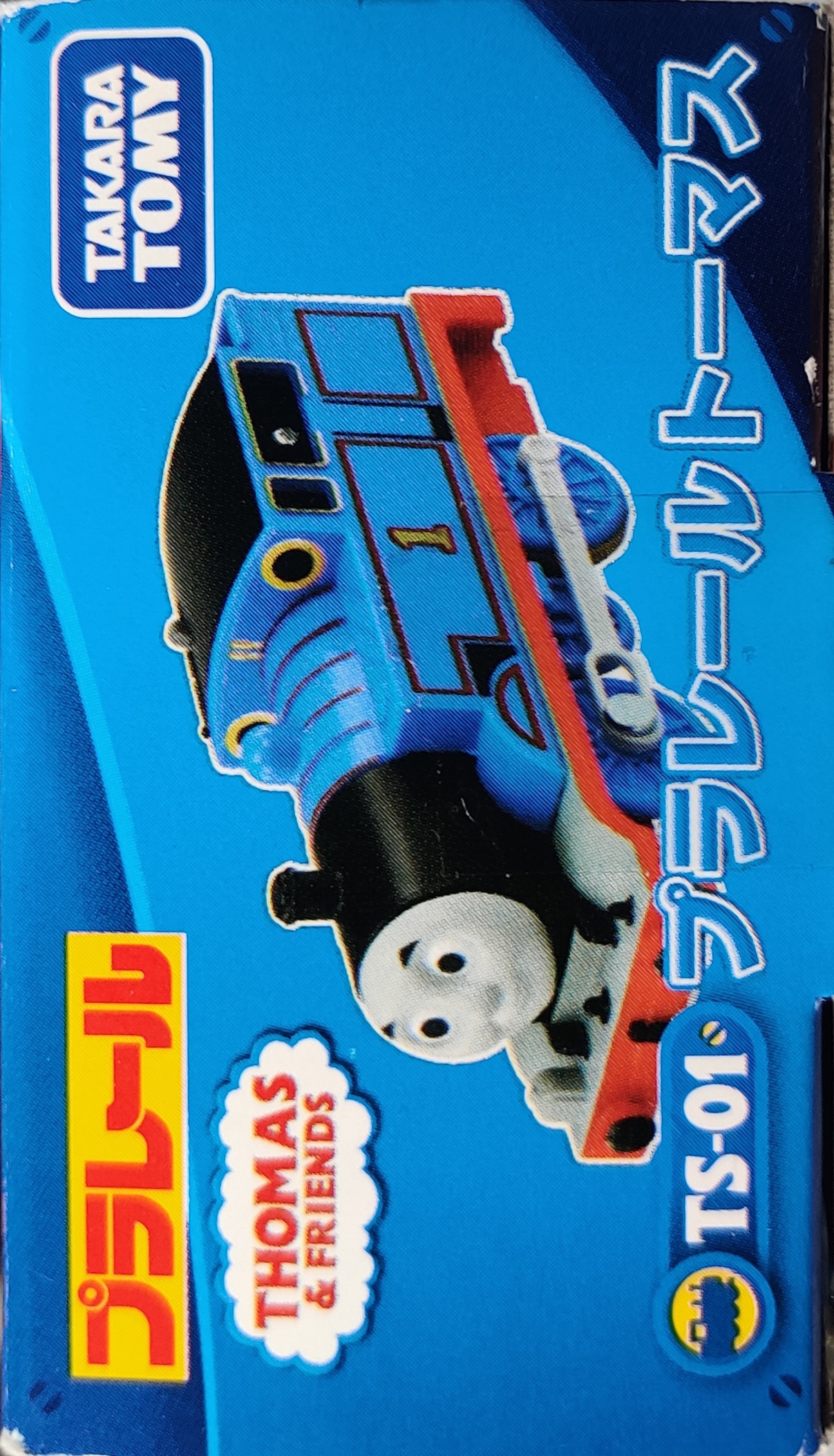


In 2018 Thomas and the other main characters that had not yet been updated for the CGI era of the television show were released in the new design of darker blue "late CGI era" boxes. These are the latest and probably the last box design and production style of the traditional Plarail style Thomas. The example shown here is from a 2020 print run and was packed with a Thomas manufactured in 2021.
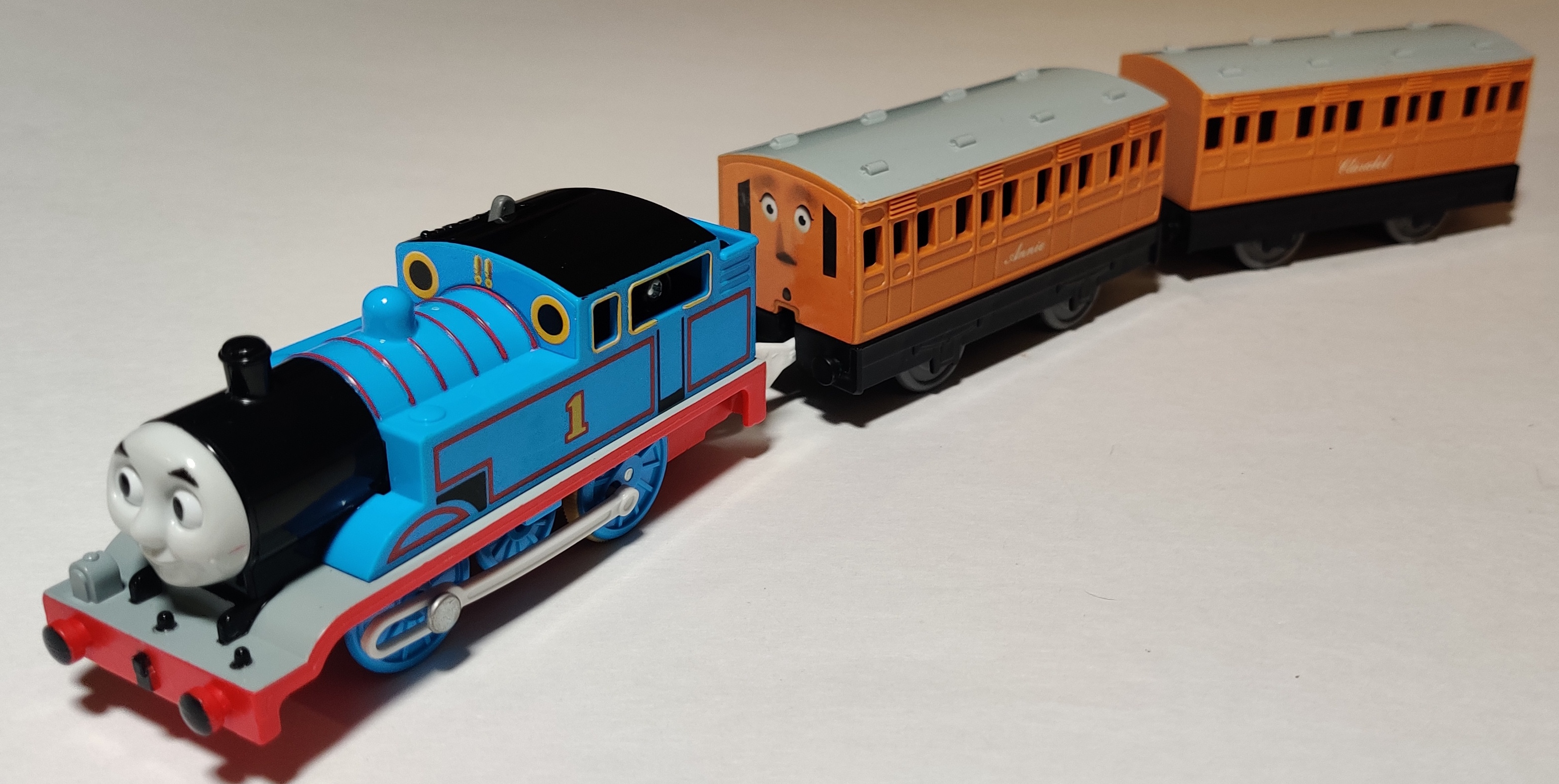
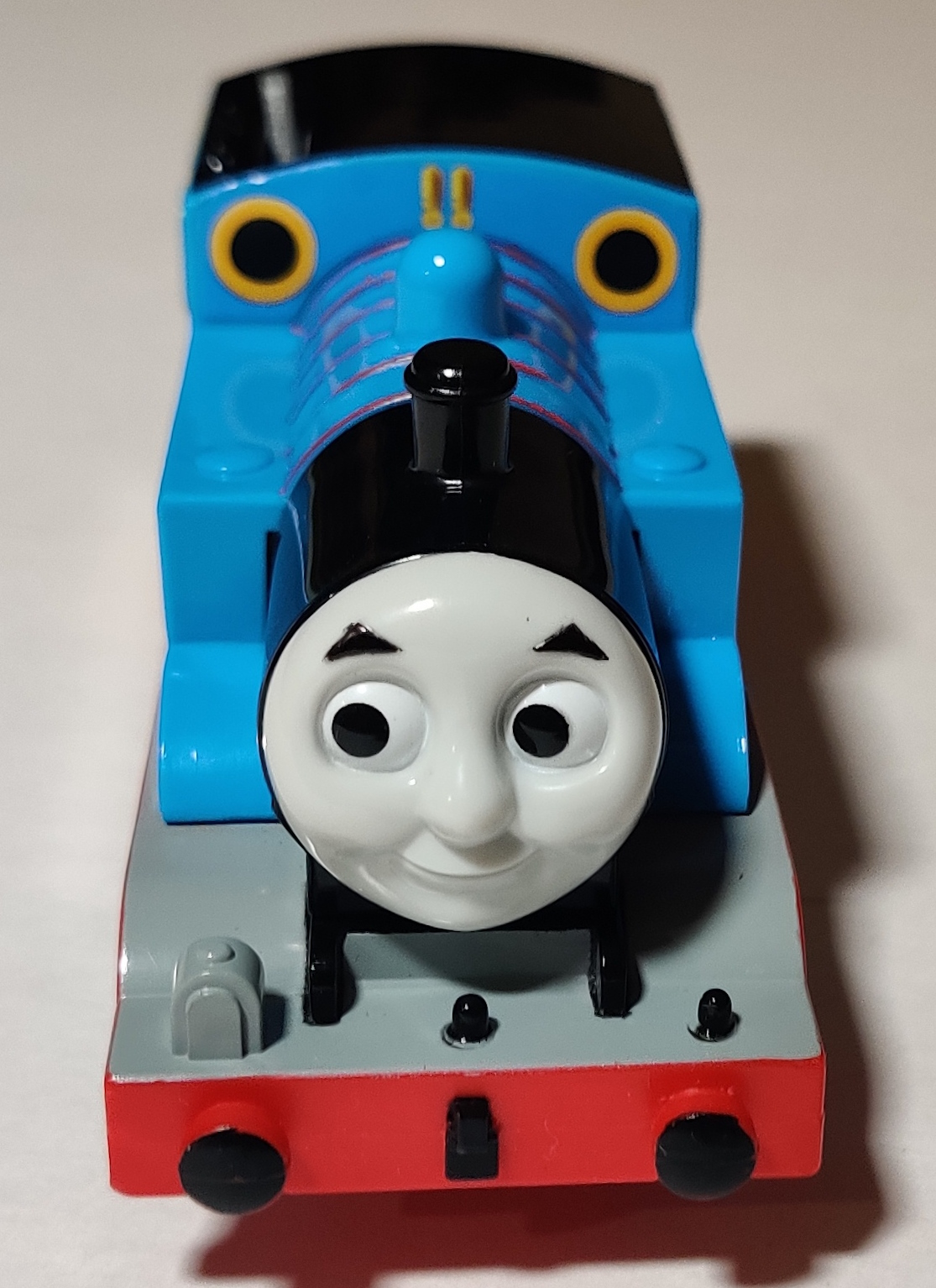
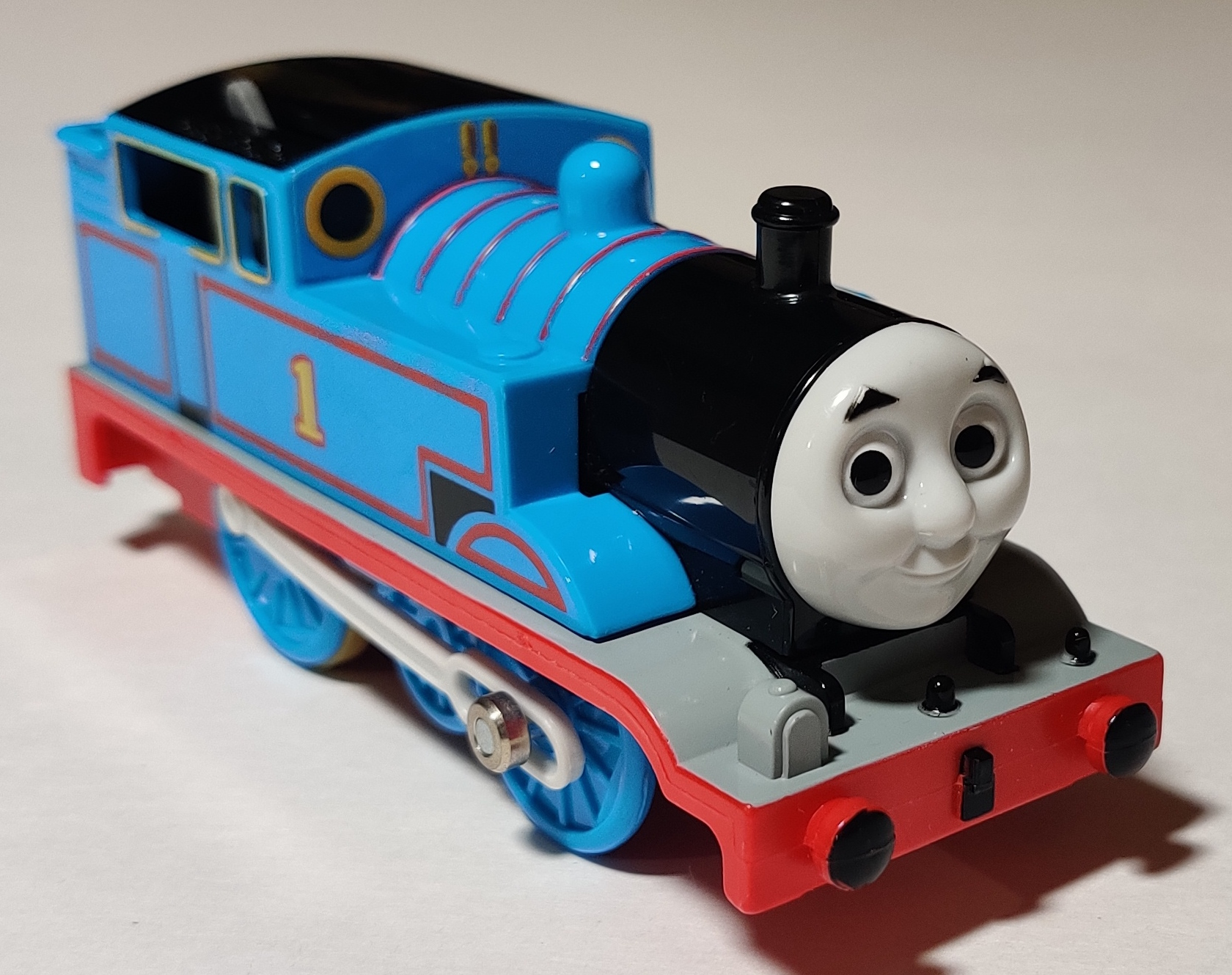
The grey used on the running boards and coach roofs is a darker shade than earlier production, and the sticker showing his front cab windows and whistle has been updated.
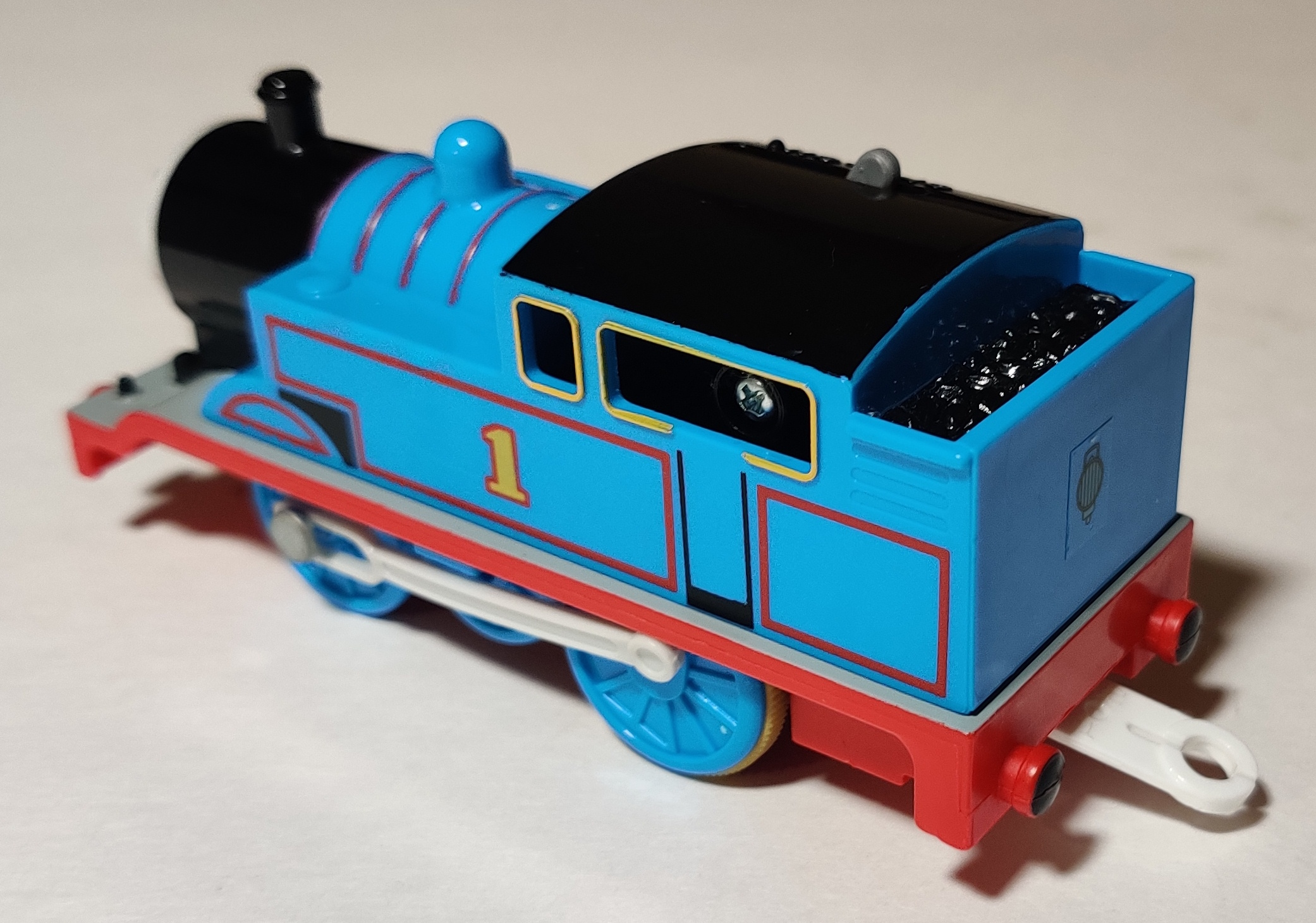
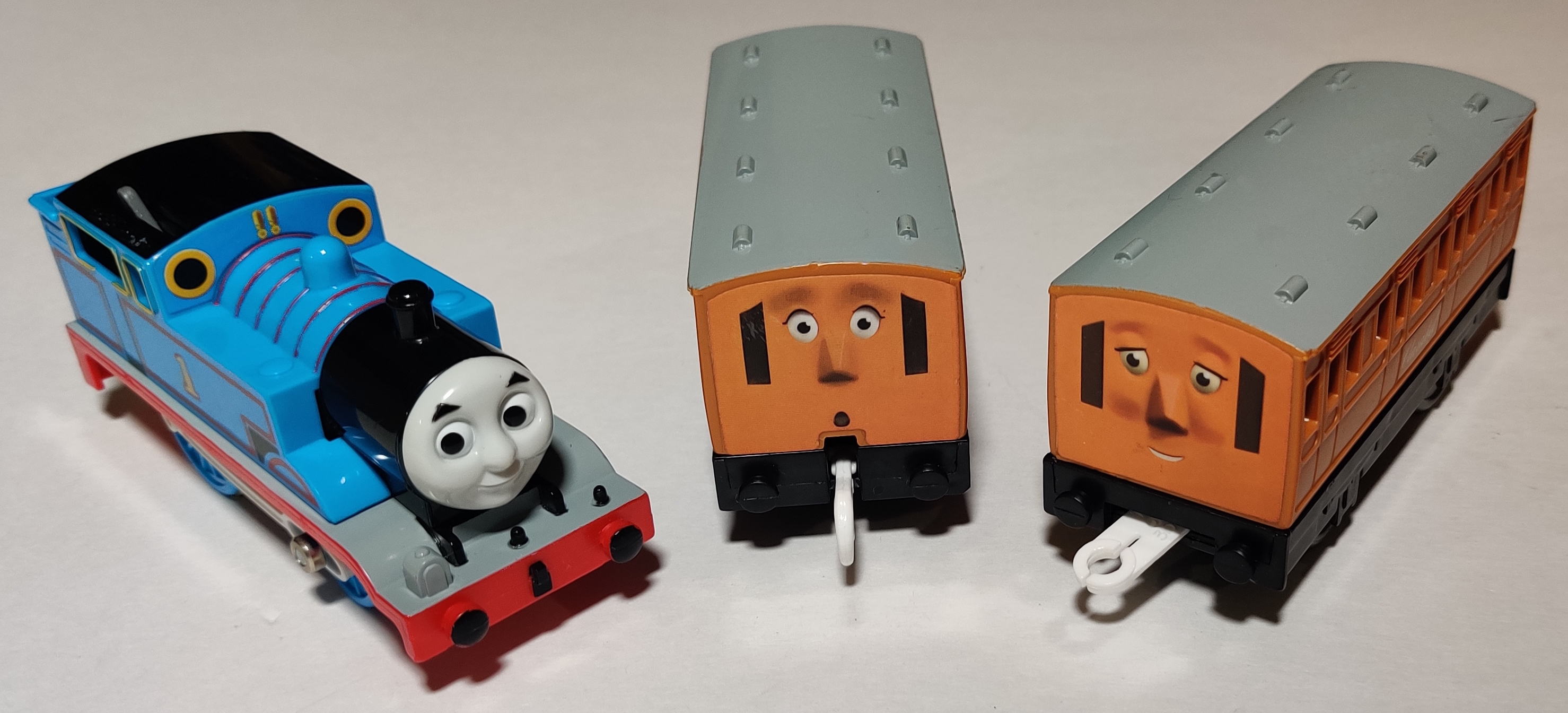
Annie and Clarabel also have new CGI-style face stickers. Thankfully, unlike some other CGI Annie and Clarabel toys that just give them the same smiling expression, you can clearly tell them apart, with their facial expressions still resembling their classic shocked look and smile.